Mitel Networks RFP47DRC DECT base station User Manual SIP DECT OM System Manual EN 8 0 2018 09 28
Mitel Networks DECT base station SIP DECT OM System Manual EN 8 0 2018 09 28
Contents
- 1. User Manual I
- 2. User Manual II
User Manual I

SIP-DECT OM System Manual
ADMINISTRATION GUIDE
Release 8.0

NOTICE
The information contained in this document is believed to be accurate in all respects but is not warranted
by Mitel Networks™ Corporation (MITEL®). The information is subject to change without notice and
should not be construed in any way as a commitment by Mitel or any of its affiliates or subsidiaries. Mitel
and its affiliates and subsidiaries assume no responsibility for any errors or omissions in this document.
Revisions of this document or new editions of it may be issued to incorporate such changes.
No part of this document can be reproduced or transmitted in any form or by any means - electronic or mechanical
- for any purpose without written permission from Mitel Networks Corporation.
TRADEMARKS
The trademarks, service marks, logos and graphics (collectively "Trademarks") appearing on Mitel's Internet sites
or in its publications are registered and unregistered trademarks of Mitel Networks Corporation (MNC) or its
subsidiaries (collectively "Mitel") or others. Use of the Trademarks is prohibited without the express consent from
Mitel. Please contact our legal department at legal@mitel.com for additional information. For a list of the worldwide
Mitel Networks Corporation registered trademarks, please refer to the website: http://www.mitel.com/trademarks.
Mitel’s Power Over Ethernet (PoE) Powered Device (PD) products are covered by one or more of the U.S. patents
(and any foreign patent counterparts thereto) identified at Mitel’s website: www.mitel.com/patents.
For more information on the PD patents that are licensed, please refer to www.cmspatents.com.
SIP-DECT OM System Manual
Administration Guide
Release 8.0 - September 2018
®,™ Trademark of Mitel Networks Corporation
© Copyright 2018 Mitel Networks Corporation
All rights reserved

iii
CONTENTS
1 Overview..........................................................................................................................................................10
1.1 The SIP-DECT Solution 10
1.2 About DECT Base Stations 11
1.2.1 DECT Base Station Families 11
1.2.2 OpenMobility Manager (OMM) Mode 16
1.3 About the OpenMobility Manager 16
1.3.1 OMM Tasks 16
1.3.2 SIP-DECT Special Features and Capabilities 17
1.3.3 OMM Capacities and Features 18
1.3.4 OMM Capacities and RFP Support 18
1.4 About DECT Phones 19
1.5 File naming conventions 19
1.6 Login and passwords 20
2 Enhanced Feature Overview .........................................................................................................................21
2.1 PC-based OMM installation 21
2.2 DECT XQ 21
2.3 Wideband (CAT-iq 1.0 / Mitel Hi-Q™ audio technology) 22
2.4 DECT enhanced security 22
2.5 VoIP encryption 23
2.6 Mixed DECT base station installations 23
2.7 Wireless LAN (WLAN) 23
2.7.1 802.11i: WPA2-Enterprise Pre-Authentication for fast Roaming 23
2.7.2 Channel Configuration Feedback for HT40 and tx Power 24
2.7.3 Channel Configuration Feedback for HT80 24
2.8 DECT base station synchronization 24
2.8.1 Clustering and paging areas 24
2.9 DECT base station Reset to Factory Settings 25
2.9.1 RFP4G reset to factory defaults 25
2.10 System redundancy 26
2.10.1 OMM standby 26
2.10.2 Backup SIP proxy/registrar 26
2.10.3 Configurable User Account for Standby Check 26
2.10.4 User data synchronization (MiVoice 5000 dual homing support) 26
2.10.5 Multi-OMM Manager for OMM-centralized management 27
2.11 Simplified licensing 27
2.12 Extended regulatory domain support 27
2.13 DECT phone functionality 28
2.13.1 DECT Phone Download over Air 28
2.13.2 Central DECT Phone Configuration Over Air (CoA) 29
2.13.3 OMM DECT phone provisioning 30
2.13.4 Mitel 600 DECT Phone Dial Editor Mode 30
2.13.5 Mitel 602 DECT Phone Customizable Boot Texts 30
2.13.6 OMM-Centralized call logs 30
2.13.7 User individual DECT Phone PIN Key Lock 30
2.14 Hot Desking 31
2.15 Conferencing 31
2.15.1 Conferencing audio notification 32
2.15.2 Centralized conferencing with MiVoice Business 32
2.15.3 N-WAY CONFERENCING 32
2.16 SIP over UDP/TCP/TLS 33
2.17 SIP multiport 33
2.18 UTF-8 encoding 34
2.19 Alphanumeric dialing 34
2.20 Voice mail number 35
2.21 Call handling 35
2.21.1 Diversion indication 35
2.21.2 Call completed elsewhere 36

iv
2.21.3 Semi-Attended Transfer 36
2.21.4 Third Line Handling for Mitel 142d and 600 DECT Phones 36
2.21.5 Call Transfer Enhancements for Mitel 142d DECT phones 37
2.22 Truncating SIP User Name in SIP URI 38
2.23 OM Locating application 38
2.24 Extended messaging 38
2.25 Video support 38
2.25.1 USB Video Devices 39
2.25.2 Terminal Video 39
2.26 User monitoring 40
2.27 Corporate directory integration 41
2.28 Integration into external management systems 41
2.29 System configuration tools 41
2.30 SIP enhancements 42
2.30.1 Globally Routable User-Agent URIs (GRUUs) 42
2.30.2 Session timer 42
2.30.3 SIP Contact matching 42
2.30.4 Configurable Call reject state codes 43
2.30.5 Call release timers 43
2.30.6 Incoming call timeout 43
2.30.7 Call reject on silent charging 43
2.30.8 route header 43
2.30.9 MWI SUBSCRIPTION period 43
2.31 Auto answer, intercom calls and audio settings 44
2.31.1 Intercom Calls 44
2.31.2 Auto answer audio settings 45
2.32 SIP-DECT XML terminal interface 45
2.32.1 Feature Access Codes Translation 45
2.32.2 Ring Tone Selection for (Alarm) Messages 46
2.33 Software Update Dispersion 46
3 Licensing .........................................................................................................................................................47
3.1 Licensing Model 47
3.1.1 System Licenses 47
3.1.2 About G.729 Channels 48
3.1.3 PARK Service 48
3.1.4 Upgrade License 49
3.1.5 Grace Period 49
3.1.6 License Violations and Restrictions 50
3.2 Uploading a License File 50
3.3 License Models 51
3.3.1 Small System (Unlicensed) 51
3.3.2 Medium or Large System 51
4 Getting Started................................................................................................................................................53
4.1 Base Station Startup Configuration 53
4.2 System Configuration 53
4.3 System Settings 54
4.4 Base Stations 54
4.5 SIP settings 55
4.6 DECT Phones 56
4.6.1 DECT Phone and SIP state verification 57
5 OMM Web Service...........................................................................................................................................59
5.1 Login 59
5.2 Logout 60
5.3 “Status” Menu 60
5.4 “System” Menu 61
5.4.1 “System Settings” Menu 61
5.4.2 ”Provisioning” Menu 68
5.4.3 ”SIP” Menu 71

v
5.4.4 “User administration” Menu 79
5.4.5 “Time zones” Menu 81
5.4.6 “SNMP” Menu 82
5.4.7 “DB management” Menu 83
5.4.8 “Event log” Menu 85
5.5 “Sites” Menu 86
5.5.1 Creating a New Site 86
5.5.2 Editing a Site 87
5.5.3 Deleting a Site 87
5.6 “Base Stations” Menu 87
5.6.1 Base Station States 89
5.6.2 OMM / RFP Software Version Check 90
5.6.3 Creating and Changing Base Stations 90
5.6.4 Capturing DECT Base Stations 92
5.6.5 Deleting DECT Base Stations 92
5.6.6 Find my SIP-DECT Base Station 92
5.7 “DECT Phones” Menu 94
5.7.1 Creating and Changing DECT Phones 95
5.7.2 Importing DECT phone Configuration Files 96
5.7.3 Subscribing DECT Phones 97
5.7.4 Deleting DECT phones 98
5.7.5 Searching the DECT phone List 99
5.7.6 Displaying User and DECT Phone Data 99
5.8 “WLAN” Menu 103
5.8.1 “WLAN profiles” Menu 103
5.8.2 “WLAN clients” Menu 108
5.9 “System features” Menu 108
5.9.1 “Digit treatment” Menu 109
5.9.2 “Directory” Menu 110
5.9.3 “Directory (comp. mode)” menu 112
5.9.4 “Feature Access Codes” Menu 113
5.9.5 ”XML Applications” Menu 115
5.10 “Licenses” Menu 117
5.11 “Info” Menu 117
6 OM Management Portal (OMP) ......................................................................................................................118
6.1 Login 118
6.2 Logout 119
6.3 OMP Main Window 119
6.4 “Status” Menu 120
6.4.1 Overview 121
6.4.2 DECT base stations 122
6.4.3 Users 123
6.4.4 Devices 124
6.4.5 Sites 125
6.4.6 Conference 126
6.4.7 Video Devices 126
6.5 “System” Menu 127
6.5.1 “Basic settings” Menu 127
6.5.2 “Advanced settings” Menu 130
6.5.3 “Statistics” Menu (Monitoring Mode Only) 138
6.5.4 “SIP” Menu 139
6.5.5 ”Provisioning” Menu 143
6.5.6 “User administration” Menu 145
6.5.7 “Data management” Menu 149
6.5.8 “Event Log” Menu 151
6.6 “Sites” Menu 153
6.7 “DECT Base Stations” Menu 154
6.7.1 “Device list” Menu 154
6.7.2 “Paging areas” Menu 160
6.7.3 “Capturing” Menu 161

vi
6.7.4 “Enrolment” Menu 162
6.7.5 “Export” Menu 162
6.7.6 “Sync view” Menu 163
6.7.7 “Statistics” Menu 164
6.7.8 “Quality” Menu 166
6.8 “WLAN” Menu 168
6.8.1 Profiles 168
6.9 “Video devices” Menu 172
6.9.1 Changing Video Devices 172
6.9.2 Viewing Video Device Details 173
6.9.3 Deleting Video Devices 173
6.9.4 Filtering Video Device Table 173
6.10 “DECT Phones” Menu 173
6.10.1 ”Overview” Menu 174
6.10.2 “Users” Menu 176
6.10.3 “Devices” Menu 176
6.10.4 Device Detail Panel 177
6.10.5 Creating DECT phone Datasets 184
6.10.6 Configuring DECT phone Datasets 185
6.10.7 Subscribing DECT phone Datasets 185
6.10.8 Deleting DECT phone Datasets 185
6.10.9 Selecting Columns 186
6.10.10 Filtering DECT phone Table 186
6.10.11 Changing the Relation Type 186
6.10.12 Enabling / Disabling DECT phone Event Log 187
6.10.13 User Monitoring 187
6.11 “Conference rooms” Menu 188
6.11.1 Creating Conference Rooms 188
6.11.2 Configuring Conference Rooms 189
6.11.3 Deleting Conference Rooms 189
6.11.4 Viewing Conference Room Details 190
6.12 “ALARM TRIGGERS” MENU “System features” Menu 190
6.12.1 “General settings” Menu 190
6.12.2 “Feature access codes” Menu 191
6.12.3 “Alarm triggers” Menu 191
6.12.4 “Digit treatment” Menu 193
6.12.5 “Directory” Menu 194
6.12.6 Easy migration from corporate Directory (comp. mode) to new corporate Directory structure 196
6.12.7 “Directory (comp. mode)” Menu 197
6.12.8 “XML applications” Menu 199
6.12.9 “CoA Profiles” Menu 203
6.13 “Licenses” Menu 204
6.14 “General” Menu 205
6.15 “Help” Menu 206
7 DECT Phone ....................................................................................................................................................208
7.1 Key lock with PIN 208
7.1.1 Maintain the PIN 208
7.1.2 Unlock a locked Mitel 600 DECT phone 208
7.1.3 Setup automatic key lock with PIN 210
8 Configuration and Administration ................................................................................................................211
8.1 IP Signaling and Media Stream 211
8.2 DECT Base Station Synchronization 213
8.2.1 Initial Synchronization Procedure 214
8.2.2 Checking the Synchronization of a Network 215
8.3 DECT Base Station Channel Capacity 215
8.4 Network Infrastructure Prerequisites 216
8.5 SIP-DECT Startup 216
8.5.1 TFTP and DHCP Server Requirements 217
8.5.2 Booting Steps 217

vii
8.5.3 Booter Startup 218
8.5.4 Application Startup 220
8.5.5 RFP LEDs 224
8.6 State Graph of the Start-up Phases 228
8.7 Local DECT Base Station Configuration (OM Configurator) 231
8.7.1 Selecting the Network Interface 232
8.7.2 Adding DECT Base Stations for configuration 232
8.7.3 Scanning for DECT Base Stations 232
8.7.4 Adding DECT Base Stations manually 233
8.7.5 Loading DECT Base Station data from File 233
8.7.6 Editing DECT Base Station configuration data 233
8.7.7 Applying Configuration Changes 236
8.7.8 Factory Reset 236
8.7.9 Saving and Loading a DECT Base Station List 236
8.7.10 Removing DECT Base Station Entries 237
8.7.11 Compatibility with Older SIP-DECT Releases 237
8.8 OMM Configuration and Resource Files 237
8.8.1 Configuration File URL 238
8.8.2 Specific Configuration URLs 240
8.8.3 ReLoad of Configuration and Resource files 240
8.8.4 AXI Commands in Configuration Files 241
8.8.5 User Configuration Files 243
8.8.6 Digest Authentication and Certificate Validation 245
8.8.7 DECT base station software Image from RFP OMM 246
8.8.8 Redirection and Configuration Service (RCS) 246
8.8.9 Customer Logo on OMM Web Service 247
8.9 DECT Base Station Configuration Files 247
8.9.2 Standard IP settings 248
8.9.3 Configuration file source 248
8.9.4 Parameter settings priority 249
8.9.5 Software update settings for 3rd generation DECT base stations 249
8.9.6 SOFTWARE UPDATE SETTINGS FOR 4th GENERATION DECT BASE STATIONS 249
8.9.7 Times when RFP configuration times are read 249
8.9.8 RFP configuration file update check 250
8.9.9 Handling of parameter changes 251
8.9.10 Configuration file syntax 251
8.10 Consolidated Certificate management 253
8.10.1 SIP over TLS certificates 253
8.10.2 OMM Certificate (Web service / AXI) 253
8.10.3 Provisioning certificates 253
8.10.4 Certificate validation 254
8.11 3rd and 4th Generation RFP Software Update 254
8.12 802.1Q Support 254
8.12.1 Boot Phase of IP RFPs (DHCP) 255
8.12.2 Boot Phase of IP RFPs (Local Configuration) 256
8.13 Installing OMM in Host Mode 256
8.13.1 System Requirements 256
8.13.2 Installing the OMM Software 256
8.13.3 Configuring the Start Parameters 257
8.13.4 Specific Commands – Troubleshooting 258
8.14 Updating the OMM 258
8.14.1 Updating a Single OMM Installation 259
8.14.2 Updating a Standby OMM Installation 259
8.15 OMM Standby 261
8.15.1 Configuring OMM Standby 261
8.15.2 Fail Over Situations 261
8.15.3 Failover Failure Situations 262
8.15.4 Specific standby situations 263
8.16 User data synchronization (MiVoice 5000 dual homing support) 264
8.16.1 Roaming 265
8.16.2 Setting up user data synchronization 266

viii
8.16.3 User data synchronization modes 267
8.17 Managing Account Data for System Access 269
8.17.1 Account Types 269
8.17.2 Potential Pitfalls 270
8.18 WLAN Configuration 270
8.18.1 WLAN configuration steps (RFP 42 WLAN / RFP 43 WLAN only) 270
8.18.2 WLAN configuration steps (RFP 48 WLAN) 271
8.18.3 Optimizing the WLAN 273
8.18.4 Securing the WLAN 275
8.19 SNMP Configuration 275
8.20 Backup SIP Proxy/Registrar 276
8.20.1 REGISTER Redirect 276
8.20.2 DNS SRV 277
8.20.3 Backup SIP Servers 278
8.20.4 Keep Alive Mechanism 280
8.20.5 Prioritized Registration 280
8.20.6 Monitoring the SIP Registration Status 281
8.20.7 Configurable User Account for Standby Check 281
8.20.8 OMM Standby Enhancement 281
8.21 Conferencing 282
8.21.1 Centralized Conferencing 283
8.21.2 Integrated Conference Server (ICS) 283
8.21.3 Configure conference rooms 285
8.22 Download Over Air 288
8.22.1 How “Download Over Air” Works 288
8.22.2 How to configure “Download Over Air” 289
8.23 Central DECT Phone Configuration Over Air (CoA) 291
8.23.1 Configuration files 291
8.23.2 Configuration file download to DECT phones 292
8.23.3 CoA Configuration using OMP 293
8.23.4 Configuration using usr_common.cfg/<user>/cfg Files 293
8.23.5 Variable lists 294
8.24 Extended DECT Phone Interface 299
8.25 OMM/DECT Phone Lock with Branding ID 301
8.25.1 Subscribing the DECT Phone 301
8.26 Device Placement 301
8.26.1 “Placement” View 301
8.26.2 “DECT Base Stations” View 302
8.26.3 “Image management” View 303
8.27 Monitoring with USB Video Devices 305
8.27.1 Configuration of a video user account 305
8.27.2 Configuration of USB video devices 306
8.27.3 Monitoring with USB video devices 306
8.28 Terminal Video 306
8.28.1 Technical Details 307
8.28.2 OMP Configuration Steps 307
8.28.3 Camera Selection via DECT phone Menu 307
8.29 User Monitoring 307
8.29.1 Overview 308
8.29.2 Status Attributes and Validation Mechanisms 309
8.29.3 Escalation 312
8.29.4 Alarm Triggers 312
8.29.5 OM Locating Application 313
8.29.6 Licensing and System Capacities 313
8.29.7 Configuration 313
8.29.8 Start and Failover 315
8.29.9 Supported DECT phones 316
8.29.10 Restrictions 317
8.30 SRTP 317
8.31 SIP over TLS 318
8.31.2 Certificates 319

ix
8.31.3 Private Key 320
8.31.4 TLS Transport Mode 320
8.31.5 Verification of Remote Certificates 321
8.31.6 Additional Security Considerations 321
8.32 DECT Enhanced Security 322
8.33 Migration of RFP SL35 IP from SIP-DECT Lite 3.1 to SIP-DECT 6.1 322
8.34 802.1x Certificate Based Authentication 323
8.34.1 802.1x Configuration 324
8.34.2 Prerequisites Referring to 802.1x Topology 325
8.34.3 802.1x Feature Description 325
8.35 802.1x Certificate Server Configuration 330
8.36 Initiate 802.1x by DHCP Options or OM_Configurator 331
8.36.1 DHCP Options 331
8.36.2 OM_Configurator 331
9 Maintenance ....................................................................................................................................................332
9.1 Site Survey Measurement Equipment 332
9.2 Checking the Mitel Handset Firmware Version 332
9.3 Diagnostic 332
9.3.1 Mitel DECT Phone Site Survey Mode 332
9.3.2 Mitel Handset Auto Call Test Mode 333
9.3.3 Mitel Handset Auto Answer Test Mode 333
9.3.4 Syslog 334
9.3.5 SSH user shell 335
9.3.6 Core File Capturing 339
9.3.7 DECT Monitor 340
10 Regulatory Compliance and Safety Information (4th Generation Dect Base Stations) ..........................344
11 Safety Information (3rd Generation Dect Base Stations) ............................................................................345
11.1 CE Marking 345
11.2 Communications Regulation Information 345
11.2.1 FCC Notices (U.S. Only) 345
11.3 Health and Safety 346
11.3.1 Exposure to Radio Frequency (RF) Signals: 346
11.3.2 Industry Canada (Canada only) 346
11.4 Informations réglementaires en matière de communications 346
11.4.1 Notes FCC (USA uniquement) 347
12 Appendix .........................................................................................................................................................348
12.1 Pre-Configuration File Rules 348
12.2 DECT phone Configuration File (OMM Database) 348
12.2.1 Supported Instructions 348
12.2.2 Data Section Fields 349
12.2.3 Example 350
12.3 RFP Configuration File / Central (OMM Database) 353
12.3.2 RFP Configuration File / Local (OM Configurator) 356
12.4 RFP Export File Format 360
12.5 CoA Configuration Parameters 362
12.5.1 Configuration of Variable Lists 362
12.5.2 Extended COA Examples 363
12.5.3 Example 1 363
12.5.4 Example 2 363
12.5.5 Example 3 367
12.5.6 Example 4 367
12.5.7 Example 5 369
12.5.8 Supported COA Parameters 370
12.6 Protocols and Ports 398
12.7 Abbreviations 400
12.8 Definitions 401
12.9 References 403

SIP-DECT OM System Manual
10
1 OVERVIEW
This document describes the installation / configuration, administration, and maintenance of the SIP-
DECT solutions. Please also see the documents listed in the References section (section 12.9) for
additional details on different aspects of the SIP-DECT system.
For a list of abbreviations and definitions, see the appropriate sections in the Safety Information.
1.1 THE SIP-DECT SOLUTION
The SIP-DECT solution includes the following main components:
SIP-DECT base stations that are distributed over an IP network and offer DECT,
WLAN, and IP interfaces
DECT phones (portable DECT devices)
OpenMobility Manager (OMM): Management and signaling software for the SIP-
DECT solution, which runs on one of the DECT base stations or on a dedicated
Linux server (for large installations). In addition, a standby OMM can be configured
to ensure OMM function in case of failure or loss of network connection.
A SIP Call Manager/IP PBX/Media Server platform (e.g. Asterisk)
001-omm-arch.psd/.
The IP PBX/media server/media gateway, OMM and the RFPs communicate through the IP
infrastructure. The RFPs and the DECT phones communicate over the air, where the DECT GAP
protocol or DECT GAP with proprietary enhancements is used.
The SIP-DECT solution supports seamless handover between RFPs which are in a group of
synchronized RFPs (cluster) and roaming between RFPs on remote sites.
Additional components include:
LDAP server to facilitate a central corporate directory
Provisioning server to provide RFP configuration or user data files
Data backup server to automatically backup an OMM database from the server
OM Locating server and clients to run the SIP-DECT locating solution
3rd party messaging or alarm server to integrate the SIP-DECT text messaging into
a unified messaging or alarm environment
Computer for administration and maintenance tools: Web browser, OM
Management Portal (OMP), DECT Monitor
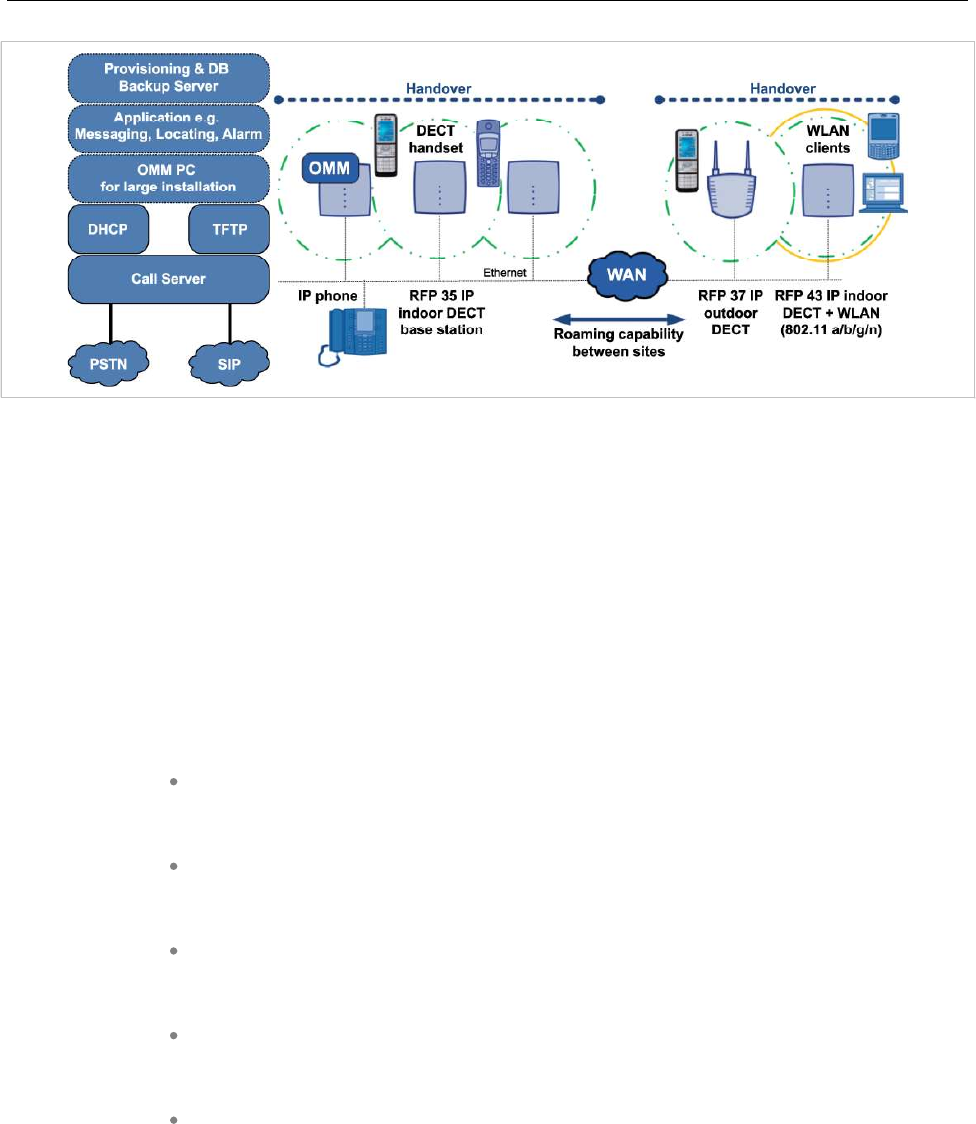
Overview
11
Figure 1 Architectural Overview of the SIP-DECT Infrastructure and Features
1.2 ABOUT DECT BASE STATIONS
DECT base stations are also referred to as Radio Fixed Parts (RFPs) in this document.
1.2.1 DECT BASE STATION FAMILIES
1.2.1.1RFP 4G DECT Base Station family
As of SIP-DECT 8.0, SIP-DECT supports the 4th base station generation (RFP 4G). This 4th RFP
generation comprises of:
RFP 44
DECT RFP as indoor model with 4 narrow band voice channels and internal
antennas.
RFP 45
DECT RFP as indoor model with 8 narrow band voice channels and internal
antennas.
RFP 47 (Indoor Unit)
DECT RFP as indoor model with 8 narrow band voice channels and 2 SMA
connectors for external directional antennas.
RFP 47 DRC (Outdoor Unit)
RFP 47 pre-installed with directional antennas and 3m cable in an outdoor
enclosure.
RFP 48
DECT RFP with 8 narrow band voice channels + WLAN Access Point as indoor
model with internal antennas for DECT and WLAN.
The hardware of all the RFPs complies with the different regulatory domains. There are no specific
hardware variants required to use specific frequency bands and field strengths. Transmit Power,
frequency band and carrier frequencies are controlled by software.
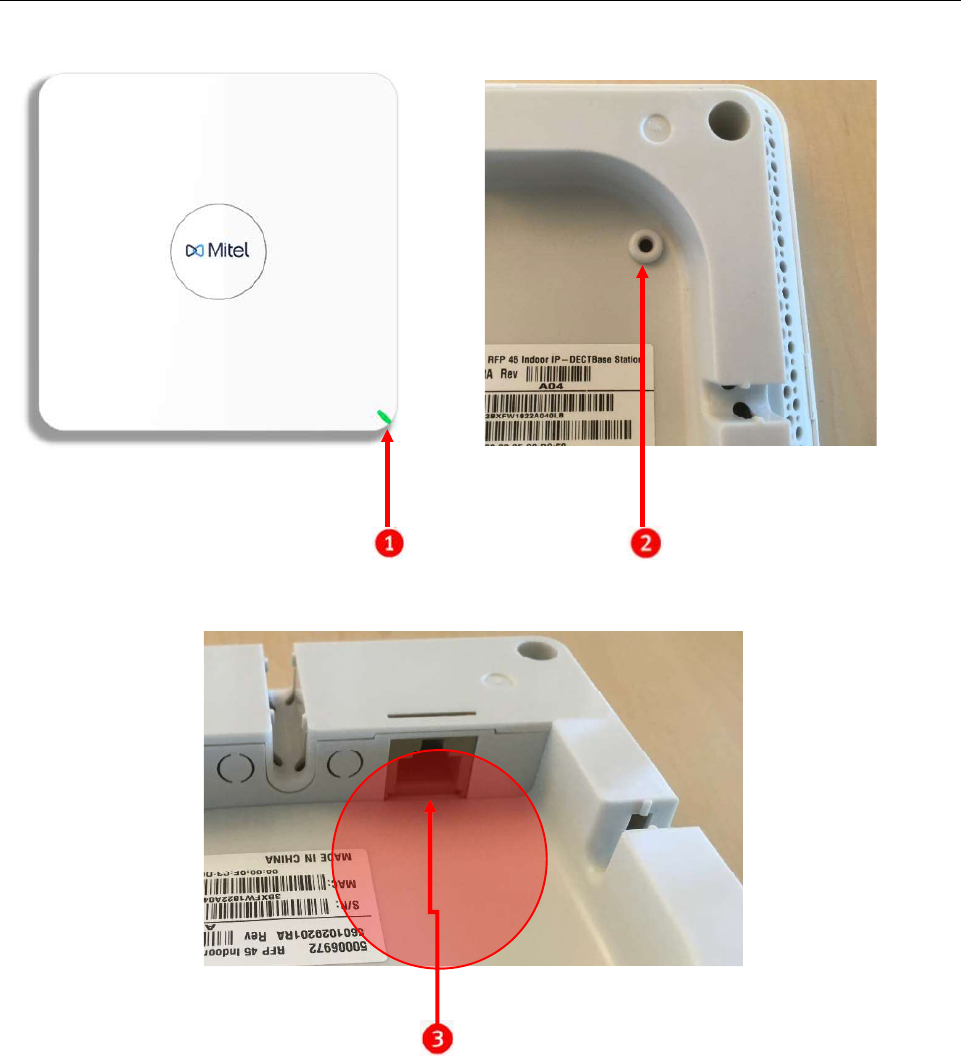
SIP-DECT OM System Manual
12
Configuration
Button
RJ45
Ethernet
Interface
(PoE)
1RFP 44/45/47/48 (1 LED)
2Configuration Button
3100Mbit/s Ethernet Interface, PoE (RFP 44, 45, 47)
41Gbit/s Ethernet Interface, PoE (RFP 48)

Overview
13
Differences compared to the previous 3rd RFP family (RFP 35, 36, 37 IP and RFP 43 WLAN) are:
RFP 48 supports 5GHz WLAN according to 802.11ac and 3x3 MIMO
Configuration button
- switch to SIP-DECT with Cloud-ID mode
- reset RFP to factory defaults
Separate outdoor enclosure available for outdoor usage
No external power supply (PoE only)
No USB interface
RFP 44/45/ support 100MBit/s Ethernet only, The RFP 48 supports 1 GBit/s
Boots from internal flash memory instead of net-boot (SIP-DECT software is already
on board)
Software update via TFTP, FTP(S), HTTP(S), SFTP supported
Hardware can support Secure SIP and SRTP (with SIP-DECT 5.0 or later)
Supports CAT-iq 1.0 level high definition voice for the Mitel 650 DECT phone
There are no differences regarding the SW update process compared with the 3rd RFP generation,
except a SW update through USB is not possible; because, the RFP 4G does not come with a USB
interface.
The RFP 47 RF output is provided through 50 ohm SMA–type connectors. These are electrically
compliant with old external antennas, although might not fit mechanically to some antenna cabling.
It is the responsibility of installers to propose connecting solutions according to the installations. For that,
a 50 ohm / 3Ghz coaxial adapter is required, which will link the RF output connectors of RFP47 to the
existing DECT antenna infrastructure.
1.2.1.2 RFP 3G DECT Base Station Types
Mitel offers four types of RFP 3G DECT base stations for the SIP-DECT solution:
RFP 35 IP
DECT RFP as indoor model
RFP 36 IP
DECT RFP as outdoor model with built-in dipole antennas
RFP 37 IP
DECT RFP as outdoor model with connectors for external directional antennas
RFP 37 DRC (Set)
DECT RFP, preinstalled with directional antennas and 3m cable in an outdoor
enclosure
RFP 43 WLAN
DECT RFP + WLAN Access Point as indoor model with internal antennas for DECT
and WLAN
As of SIP-DECT 6.0, there is no distinction between DECT base station soft brands (that is, L-RFPs and
non-L-RFPs). See section 3.3.2 for more information.
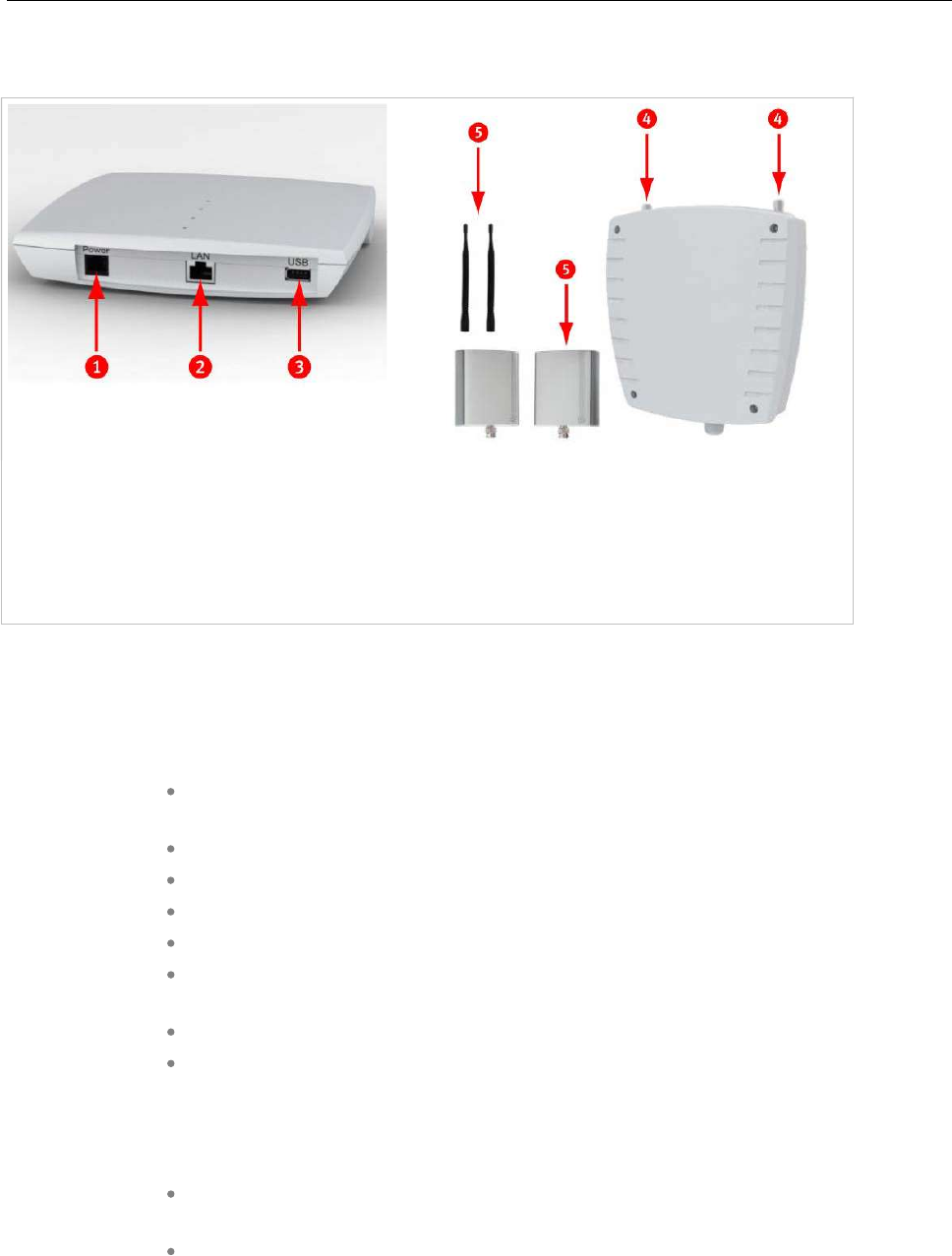
SIP-DECT OM System Manual
14
In general the RFP 35 / 36 / 37 IP have the same hardware platform and software capabilities. RFP 43
supports WLAN in addition to DECT.
1Power 48V DC (optional)
21GBit/s Ethernet (PoE)
3USB
4DECT antenna connector (RFP 37 IP)
5Antennas (RFP 37 IP)
The hardware of all the new RFPs complies with the different regulatory domains. There are no specific
hardware variants required to use specific frequency bands and field strengths. Transmit Power,
frequency band and carrier frequencies are controlled by software.
Other differences compared to the previous RFP family (RFP 32/34 IP and RFP 42 WLAN):
Boots from internal flash memory instead of net-boot (SIP-DECT software is already
on board)
Supports software update through TFTP, FTP(S), HTTP(S), SFTP
Supports 1GBit/s Ethernet
Supports CAT-iq 1.0 level high definition voice for the Mitel 650 DECT phone
Hardware can support Secure SIP and SRTP (with SIP-DECT 5.0 or later)
Uses an external 48V DC Power Supply (if no PoE available) which meets the latest
environmental requirements (RFP 37: PoE only)
RFP 43 WLAN supports the 802.11a/b/g/n standards
Indoor RFPs have a USB 2.0 interface to connect external hardware for future
applications (for example, Video Camera)
1.2.1.3Older RFP Types
Older RFP models supported by the SIP-DECT solution include:
RFP 32 IP
DECT RFP as indoor model
RFP 34 IP
DECT RFP as outdoor model
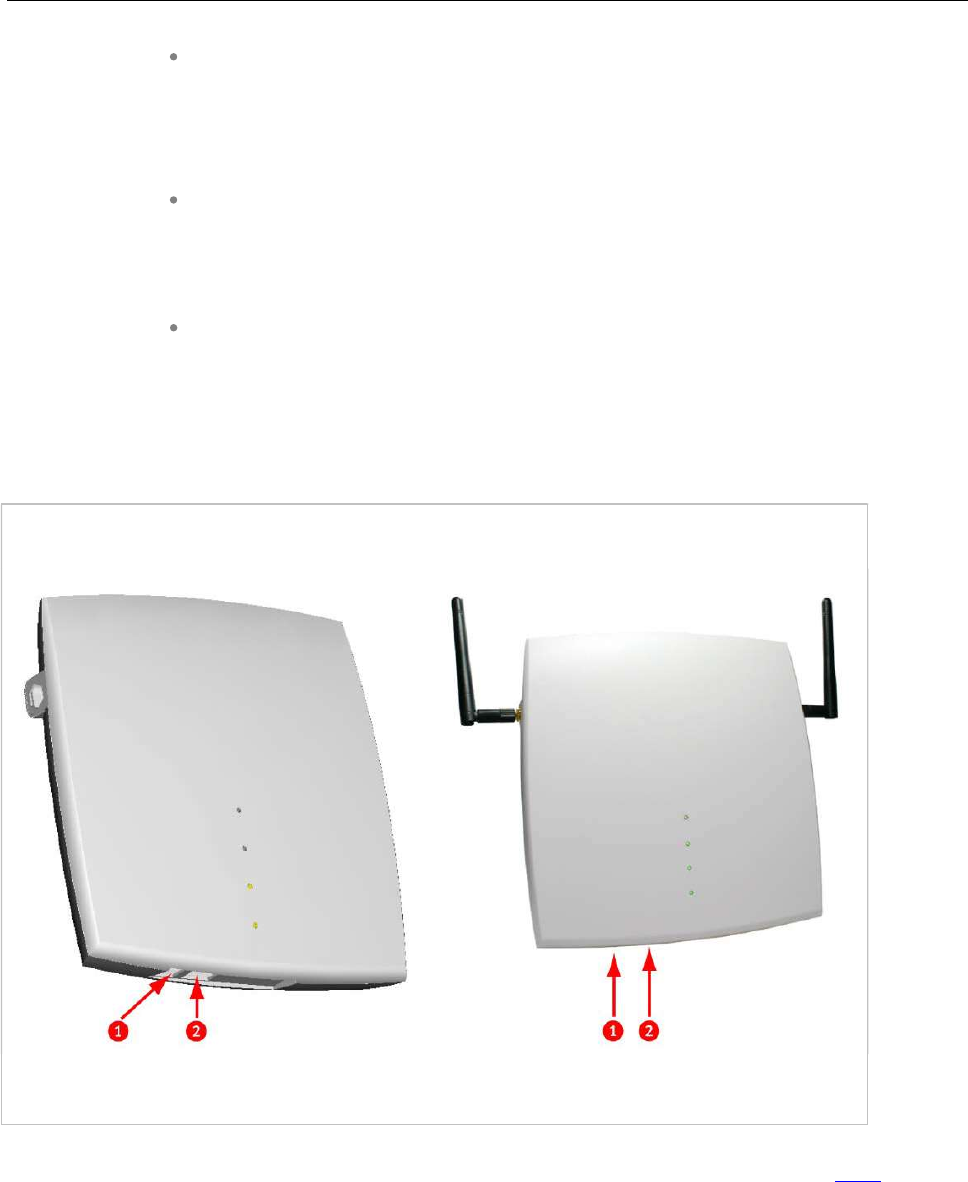
Overview
15
RFP 42 WLAN
DECT RFP + WLAN Access Point as indoor model
The RFP 32 and RFP 34 have the same hardware and software capabilities. Please note the regulatory
differences between North America and other areas of the world. These differences lead to different RFP
32/34 variants which use specific frequency bands and field strengths:
RFP 32 NA or RFP 34 NA (NA)
– Frequency Band 1920 to 1930 MHz
– 5 carrier frequencies
– Transmit Power 20 dBm
RFP 32 IP or RFP 34 IP (EMEA)
– Frequency Band 1880 to 1900 MHz
– 10 carrier frequencies
– Transmit Power 24 dBm
The RFP 42 WLAN is only available for the EMEA region.
RFP 32 IP / RFP 32 NA
RFP 34 IP / RFP 34 NA
RFP 42 WLAN
1Power jack (120 V/230 V AC adapter)
2Ethernet jack; Power supply in line with Power over Ethernet standard IEEE 802.3af
As of SIP-DECT 6.0, there is no distinction between RFP soft brands (i.e., L-RFPs and non-L-RFPs).
With SIP-DECT 5.0 and older releases, the “L” variants have built-in licenses. See section 3.3.2
(Licensing) for more information.
Note: The software package for previous RFPs has a tftp extension
e.g. “iprfp2G.tftp. With SIP-DECT 3.0 or higher, you need a 3G
RFP to run the Open Mobility Manager.

SIP-DECT OM System Manual
16
1.2.2 OPENMOBILITY MANAGER (OMM) MODE
If the OMM is not running on a dedicated Linux server, one RFP within a SIP-DECT installation must be
declared to operate as the OpenMobility Manager (OMM). The RFP acting as the OMM may also act as
a regular RFP if it is part of a DECT cluster.
In OMM mode, an RFP functions as a regular RFP. Additionally, it is responsible for SIP signaling
between the SIP-DECT system and the IP PBX/SIP server. Further on, it takes over the management
part of the SIP-DECT solution. You designate an RFP as the OMM by assigning an IP address to the
RFP within the DHCP scope (see section 8.5) or by setting the data via the OM Configurator (see
section 8.7). After an RFP is designated as the OMM, it starts the extra services on board (for example,
the web service that supports the management interface). All RFPs download the same firmware (for
their RFP type), but only one RFP (or two, in standby implementations) activates the OMM services.
Note: It is possible to deactivate the DECT part of an RFP. If the DECT
interface is deactivated, all resources (CPU and memory) are
available for the OMM.
This might be necessary, for example, in configurations where a
mix of OpenMobility Manager, G.729/Conferencing and WLAN is
provided by the same RFP.
1.3 ABOUT THE OPENMOBILITY MANAGER
The OpenMobility Manager (OMM) requires an RFP 35/36/37 IP resp. RFP 43 WLAN, or a dedicated
Linux server.
There is only one OpenMobility Manager (OMM) active in the system at a given time.
If the OMM runs on a DECT base station, a 100 Mbit/s network link is required.
If the OMM runs on a dedicated Linux server, a 1 GBit/s network link is required
(see also section 8.13.1).
In addition, a standby OMM can be configured to ensure the OMM function in case of failure or loss of
network connection. For more information on the standby OMM see section 8.15.
1.3.1 OMM TASKS
The OMM performs the following tasks:
Signaling gateway (SIP <-> DECT)
Media stream management
Managing sync-over-air functions between RFPs
Provides a Web service for system configuration
Provides additional services such as
– LDAP based central corporate directory
– OM Application XML interface (OM AXI) for OAM&P,
messaging, alerting service and locating
– Integrated Messaging and Alerting Service (OM IMA)
– Data backup and provisioning services
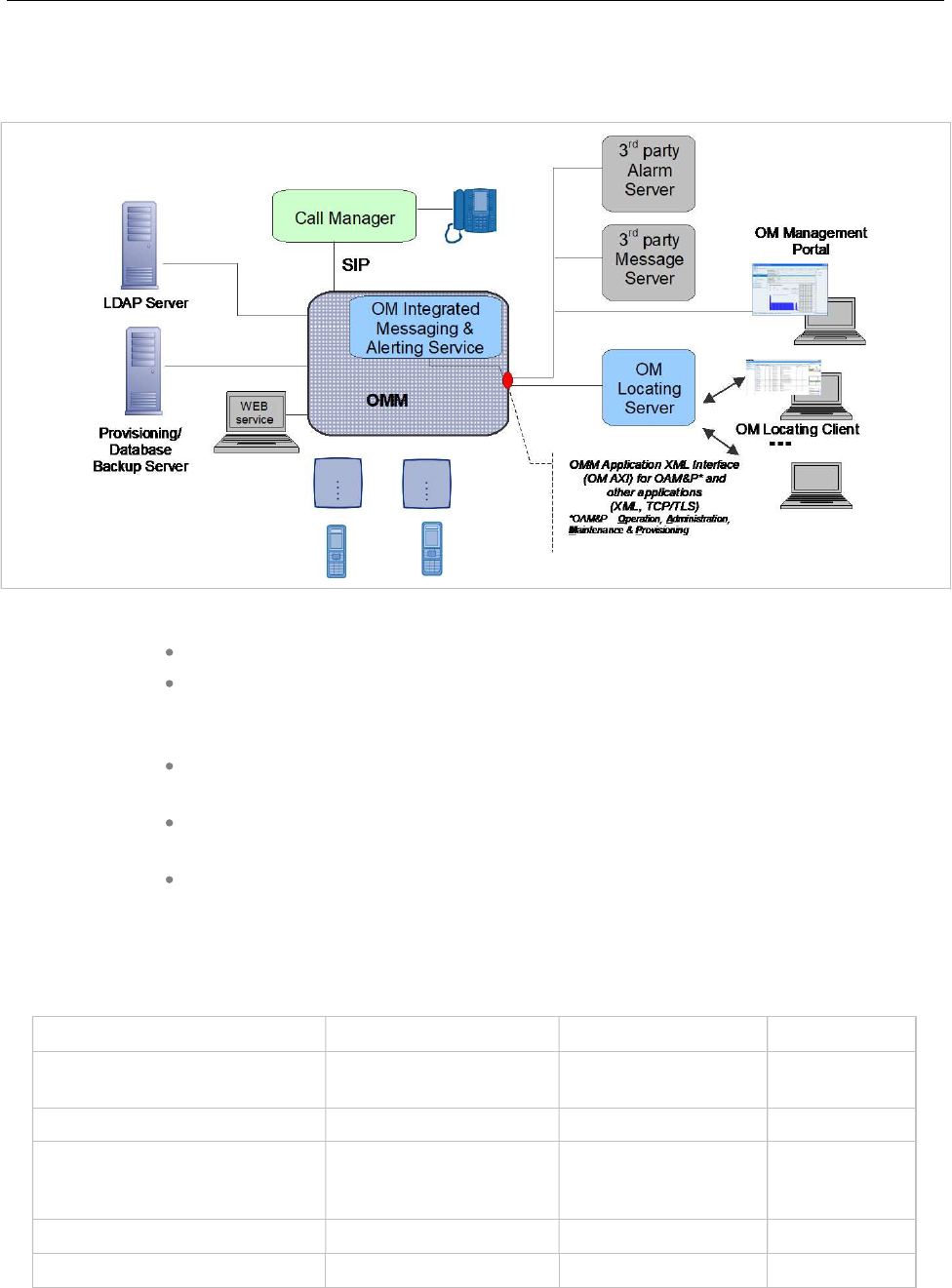
Overview
17
– SIP-DECT XML terminal interface. This interface adapts the “XML API
for SIP Phones“ to SIP–DECT phones. The Mitel 600 DECT phone family is
supported.
Additional information on the following functionality is available in separate documents.
Locating: See the SIP-DECT OM Locating Application Administration Guide.
Integrated Messaging and Alerting Service: See the SIP-DECT OM Integrated
Messaging and Alerting Application Guide and the SIP-DECT Mitel 600 Messaging
and Alerting Applications Guide.
User data provisioning: See the SIP-DECT OM Handset Sharing and Provisioning
Guide.
Administration and monitoring by third party applications: See the OM Application
XML Interface Specification.
SIP-DECT XML terminal interface: See the SIP-DECT XML Terminal Interface
Specification.
1.3.2 SIP-DECT SPECIAL FEATURES AND CAPABILITIES
Feature GAP 142d 600
Large DECT Systems (XXL) No connection handover
beyond 256 RFPs
yes yes
Messaging & Alerting no no yes
Initiate Alarm Trigger *, # feature access code
procedure,
no sensor alarm
*, # feature access
code procedure,
no sensor alarm
yes
Locating yes yes yes
DECT XQ no no yes

SIP-DECT OM System Manual
18
Feature GAP 142d 600
UTF-8 and alphanumeric dialing
support
no no yes
SIP-DECT XML terminal API no no yes
CAT-iq 1.0 / Hi-Q™ audio
technology
no no yes (650 only)
1.3.3 OMM CAPACITIES AND FEATURES
The following table summarizes OMM capabilities:
Feature Release 3.0 or later Release 6.0 or later
RFP OMM Linux server
OMM
RFP OMM Linux server
OMM
RFP 32/34/35/36/37/44/45/47 IP and
RFP 42/43/48 WLAN
256 12048 1256 14096 1
Handsets / users 512 4500 512/1024 310000
Message / Alarm receive yes / yes 1yes / yes 1yes / yes 1yes / yes 1
Message send yes yes yes yes
Locating yes 1yes 1yes 1yes 1
DECT XQ yes yes yes yes
UTF-8 and alphanumeric dialing support yes yes yes yes
SIP-DECT XML terminal API yes yes yes yes
CAT-iq 1.0 / Hi-Q™ audio technology yes 2yes 2yes 2yes 2
1The feature requires a license.
2The feature is available with the RFP 35/36/37/44/45/47 IP and RFP 43/48 WLAN and the Mitel 650
DECT phone (or other CAT-iq-capable devices). The feature is enabled per site and requires that the
RFPs are configured in the same site and cluster.
3Release 8.0 or later: If RFP 4G runs as OMM, 1024 users/handsets are supported.
1.3.4 OMM CAPACITIES AND RFP SUPPORT
The following table summarizes OMM and RFP support capabilities:
Feature As of SIP-DECT 6.0 As of SIP-DECT 8.0
RFP OMM Linux server
OMM
RFP OMM Linux server
OMM
RFP 32/34 IP and
RFP 42 WLAN
256 4096 256 4096
RFP 35/36/37 IP and
RFP 43 WLAN
256 4096 256 4096
RFP 44/45/47 IP and
RFP 48 WLAN
Not
applicable
Not
applicable
256 4096

Overview
19
Feature As of SIP-DECT 6.0 As of SIP-DECT 8.0
RFP OMM Linux server
OMM
RFP OMM Linux server
OMM
DECT phones / users 512 10000 1024 (RFP 4G
OMM)
512 (RFP 3G
OMM)
10000
1.4 ABOUT DECT PHONES
DECT Phones (formerly referred to as Portable Parts) are an integral part of the SIP-DECT solution.
Mitel provides the following DECT phones:
Mitel 142 DECT Phone
Mitel 600 DECT Phone series
– Mitel 612 DECT Phone
– Mitel 622 DECT Phone
– Mitel 632 DECT Phone
– Mitel 650 DECT Phone
Notes on the Mitel 600 DECT Phones
The Mitel 600 DECT phones support both the NA and EMEA regulatory requirements.
The latest Mitel 600 firmware release has the following characteristics:
New user interface e.g. new dial editor with alphanumerical and always en-bloc
dialing
Support of UTF-8 in over the air signaling with the OMM
Digit and alphanumeric dialing
Support of SIP-DECT XML terminal interface
Support of microSD card to save subscription data and the most important local
device data (not supported by Mitel 600 DECT phones)
Additional subscription options
Additional alarm melodies
Profile indication in idle display
For more details please see /31/and /32/.
In addition to the existing Mitel 600 DECT phone set, the new Mitel 650 DECT phone supports CAT-iq
1.0 and thus supports G.722 (wideband) voice connections. For the full experience of wideband audio,
the DECT phone hardware (e.g., speakers, microphone, and processor) has been improved.
The Mitel 600 DECT phone also supports DECT enhanced security.
1.5 FILE NAMING CONVENTIONS
The following table lists the file names for SIP-DECT software deliverables.

SIP-DECT OM System Manual
20
Software package As of SIP-DECT 7.1 As of SIP-DECT 8.0
Software image for RFP 32/34 IP / RFP 42 WLAN omm_ffsip.tftp iprfp2G.tftp
Software image for RFP 35/36/37 IP / RFP 43 WLAN iprfp3G.dnld iprfp3G.dnld
Software image for RFP 44/45/47 IP / RFP 48 WLAN Not applicable Iprfp4G.dnld
OMM software for Linux Red Hat server (self-
extracting executable)
SIP-DECT_<version>.bin SIP-DECT_<version>.bin
OMM software rpm SIP-DECT-OMM-
<version>.i686.rpm
SIP-DECT-OMM-
<version>.i686.rpm
DECT phone software rpm SIP-DECT-HANDSET-
<version>.i686.rpm
SIP-DECT-HANDSET-
<version>.i686.rpm
SIP-DECT OMM/MOM OVA SIP-DECT-<version>.ova SIP-DECT-<version>.ova
1.6 LOGIN AND PASSWORDS
The following table summarizes the default login and passwords for SIP-DECT system components.
Interface/Tool SIP-DECT OMM
SDC OMM
RFP 32/34 IP /
RFP 42 WLAN
RFP 35/36/37 IP / RFP 43 WLAN
RFP 44/45/47 IP / RFP 48 WLAN
Initial configuration
through OM Configurator
login / password
(no previous connection
with the OMM)
n/a No login required “omm” / “omm”
Initial OMM configuration
through Web or OMP
standard full-access
account
login / password
“omm” / “omm”
“omm” / “omm”
n/a n/a
OMM access through
Web or OMP
(after initial OMM
configuration)
Read-only or full-
access accounts as
configured
n/a n/a
Configuration through OM
Configurator after
connection with OMM
login / password
(system-wide set by
OMM)
n/a OMM standard full-
access account
login / password
OMM standard full-access account
login / password
ssh
(no previous connection
with the OMM)
n/a User shell:
“omm” / “omm”
Root shell:
“root” / “22222”
User shell:
“omm” / “omm”
Root shell:
“root” / “22222”
ssh
(with previous connection
with the OMM)
(system-wide set by
OMM)
n/a User shell:
OMM standard full-
access account
login / password
Root shell:
as configured
User shell:
OMM standard full-access account
login / password
Root shell:
as configured

Enhanced Feature Overview
21
2 ENHANCED FEATURE OVERVIEW
A SIP-DECT system can scale from a small system of five or less DECT base stations to a larger SIP-
DECT system that may include hundreds of DECT base stations. Some of the more advanced features
target larger DECT systems. You may browse the following list of features in order to get an overview
and to decide if it’s relevant for your requirements. You find in-depth explanations in the referenced
sections.
Please note: Be aware that the majority of the new enhanced features require the current
DECT phone firmware release. It is assumed that SIP-DECT installations are configured
to perform an automatic firmware update over the air.
2.1 PC-BASED OMM INSTALLATION
A very large number of DECT base stations or a large number of DECT phones may exceed the storage
capacity or processing power of the embedded DECT base station. For this reason, it is also possible to
operate the OMM on a standard PC under the Linux operating system (see section 8.13).
As of SIP-DECT 5.0, CentOS 6 and virtualized environments (VMware vSphere ESXI 5 and 6) are also
supported. SIP-DECT 6.1 is tested with CentOS 6.x.
As of SIP-DECT 7.1, CentOS 7 is required. An OVA-File is distributed together with the software for
usage within virtualized environments (VMware vSphere 6.5). The verification is executed with VMware
vSphere 6.0 and 6.5. For further information, see document /47/ SIP-DECT_LinuxServerInstallation.
2.2 DECT XQ
The DECT radio communication generally suffers from attenuation and radio wave reflection. In
particular, if a building’s walls and ceilings contain a higher portion of metal-based material or if larger
metal surfaces are present, the DECT XQ improves the radio communication between a DECT base
station and a Mitel 600 DECT phone at the expense of DECT channel capacity (see 8.3). Enable this
feature for some or all of your DECT base stations (see section 5.6.3, “DECT settings” or section 6.7.1.2,
“DECT tab”).
DECT XQ audio cannot be combined with Hi-Q audio within the same connection.
There are three operating modes related to audio quality available on the Mitel 650 DECT phone:
standard audio, Hi-Q audio and automatic.
In Hi-Q audio mode, a Mitel 650 DECT phone exclusively establishes wideband
connections and does not switch to narrowband later. A Mitel 650 in this mode
ignores the XQ capability of the RFP.
In standard audio mode, a Mitel 650 DECT phone exclusively establishes
narrowband connections and does not switch to wideband later. A Mitel 650 in this
mode will switch to DECT XQ and back as necessary.
In automatic mode, the connection establishment depends on whether the current
base provides DECT XQ or not. If DECT XQ is available, a narrowband connection
will be established. Otherwise, a wideband connection will be established.
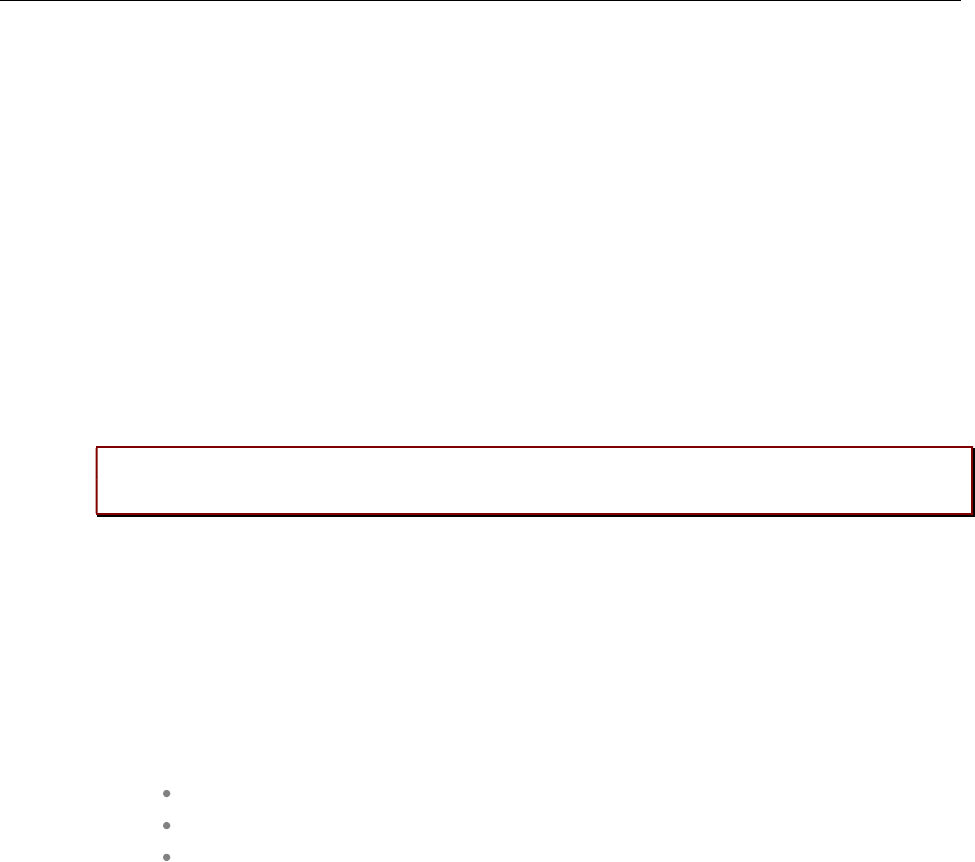
SIP-DECT OM System Manual
22
2.3 WIDEBAND (CAT-IQ 1.0 / MITEL HI-Q™ AUDIO TECHNOLOGY)
In conjunction with the RFP 35/36/37/44/45/47 IP and RFP 43/48 WLAN, the Mitel 650 DECT phone can
act as a Mitel Hi-Q audio terminal. This feature is realized using wideband speech according to CAT-iq.
Each Hi-Q connection uses twice the capacity on the DECT air interface, as compared to conventional
narrowband. Therefore, four Hi-Q connections can be established via one RFP, instead of eight
narrowband calls.
Mitel Hi-Q audio technology must be enabled or disabled per site (see section 5.5). This functionality
must be homogeneously available among synchronous RFPs (members of the same cluster). Each site
with enabled Hi-Q audio must exclusively contain new RFP 35/36/37/44/45/47 IP or RFP 43/48 WLAN.
Typically one site is identical with one cluster, i.e. all RFPs belonging to a specific site belong to a
specific cluster. However a site can have more than one cluster. The OMM allows configuration of a
cluster that contains multiple sites. Such configuration could annul the rule that Hi-Q audio must be
homogeneously available among synchronous RFPs.
Please note: It is strongly recommended not to setup systems with multiple sites within one
cluster.
2.4 DECT ENHANCED SECURITY
In response to market concerns, the DECT standard has introduced improvements to security. Many
security features, which were specified in the DECT standard (respectively GAP) were left optional for
the DECT phones. These mechanisms became mandatory with CAT-iq. Almost all of this functionality
was present and used within SIP-DECT right from the start.
Furthermore, some new features have been added to GAP:
Encryption of all calls (not only voice calls)
Re-keying during a call
Early encryption
Each feature provides an additional security guarantee and is therefore an integral part of the SIP-DECT
solution.
The feature set can be enabled or disabled per site, because enhanced security is available with 3rd or
4th generation RFPs. Roaming between sites where enhanced security is enabled and disabled
respectively should be avoided.
With SIP-DECT 5.0 and later, when DECT enhanced security is enabled, every connection is encrypted
– not only voice calls, but also service calls (e.g. list access) or messaging.
Additionally, the cipher key used for encryption during an ongoing call is changed every 60 seconds.
Finally, every connection is encrypted immediately upon establishment to protect the early stages of the
signaling such as dialing or CLIP information.
DECT enhanced security is only supported with Mitel 602 DECT phones. Older terminals (e.g. 6x0d or
142d) or GAP phones still operate as normal, but do not support the new security mechanisms.

Enhanced Feature Overview
23
2.5 VOIP ENCRYPTION
To allow secured call connections over unsecured IP infrastructures (e.g. internet), SIP-DECT supports
SRTP to encrypt the RTP voice streams and TLS to encrypt the SIP signaling.
These security mechanisms, together with a secured iPBX infrastructure, allow protected call services
and ensure:
Authentication
Integrity
Confidentiality
Privacy
When a Mitel 600 DECT phone user is involved in a SRTP call, a key icon in the call display indicates
that the media path to the next hop is ciphered.
The key icon is only displayed when the connection uses SIP over TLS, SRTP (for 3G RFPs only) and
DECT encryption together for a secure key exchange and a secure media transport.
2.6 MIXED DECT BASE STATION INSTALLATIONS
In sites (or whole systems) with Hi-Q audio disabled, any combination of RFP 32/34 IP / RFP 42 WLAN
and RFP 35/36/37 IP / RFP 43/48 WLAN is allowed. Note, however, that some security features are not
supported for all DECT base stations (that is, SRTP and enhanced security are supported on 3rd and 4th
generation RFPs only).
RFP SL35 IP support
SIP-DECT supports the RFP SL35 IP after applying the unlock file and the standard SIP-DECT software
to the DECT base station.
Before the standard SIP-DECT software can be installed on the RFP SL35 IP, the unlock.xml file must
be available for the DECT base station on the USB. After applying the unlock.xml file the DECT base
station accepts the standard SIP-DECT software.
In terms of licensing, the OMM manages the RFP SL35 IP with the unlock file and the standard SIP-
DECT software like an RFP 35 IP.
For a detailed description see section 8.30.
2.7 WIRELESS LAN (WLAN)
If you have a number of WLAN DECT base stations (RFP 42/43/48 WLAN), the SIP-DECT system also
provides access to your company LAN through Wireless LAN. The RFP 43/48 WLAN support 802.11n.
The RFP 48 WLAN also supports 802.11ac. The WLAN configuration of a group of WLAN RFPs is
managed by WLAN profiles (see section 5.8).
2.7.1 802.11I: WPA2-ENTERPRISE PRE-AUTHENTICATION FOR FAST ROAMING
WLAN stations (e.g. laptop) which decide to roam to another WLAN access point (AP) must perform the
full authentication process with the new AP. In 802.1x (RADIUS) networks this can take a long time
resulting in network dropouts during the roam.

SIP-DECT OM System Manual
24
The AP share authentication information with other APs, so the station can authenticate faster (pre-auth)
when roaming to a new AP. This method reduces network dropouts significantly.
The RFP 43 and RFP 48 automatically enables pre-authentication for WPA-Enterprise enabled WLANs.
The RFP 42 does not support this feature.
2.7.2 CHANNEL CONFIGURATION FEEDBACK FOR HT40 AND TX POWER
The HT40 channel configuration in 802.11n enabled networks may not always become active because of
other access points that use channels that would overlap. In this case, the RFP 43 and RFP 48 fall back
to HT20.
From SIP-DECT 5.0 on, the effective channel configuration and the transmit power are reported to the
OpenMobility Manager.
You can view these parameters in the OMM Web service and the OMP (DECT base stations >Device
list -> Show details –WLAN tab) and change the channel to a frequency without overlapping APs.
2.7.3 CHANNEL CONFIGURATION FEEDBACK FOR HT80
HT80 includes the HT40/HT20 bandwidth setting. A channel with a bandwidth of 80 MHz occupies 4
WLAN channels with a bandwidth of 20 MHz. If the WLAN profile options HT80/ HT40 MHz have been
activated, the necessary center channel will be automatically selected in the corresponding areas by
configuration itself.
HT80 is independent from 256 QAM / 3x3 MIMO. The ac standard is the first WLAN standard with 256
QAM modulation and the bandwidth HT80. The n standard supports 3x3 MIMO too, but the RFP43 has
only 2 antennas (for 2x2 MIMO) and the RFP48 has 3 antennas.
2.8 DECT BASE STATION SYNCHRONIZATION
To ensure a seamless communication experience, the SIP-DECT system switches an ongoing DECT
phone call from one DECT base station to another if the radio communication quality drops below a
certain threshold. The seamless handover is possible only if the participating DECT base stations are
synchronized. DECT base station synchronization is performed via radio communication between DECT
base stations, which in turn requires a decent radio coverage planning (see section 8.2).
2.8.1 CLUSTERING AND PAGING AREAS
Your SIP-DECT system may include different locations, where the distances between the locations
prevent the RFPs from performing the over-the-air synchronization. In this case, you must split your
network into clusters (or “synchronization domains”). You assign DECT base stations to cluster numbers
for this purpose (see section 5.6.3 “DECT settings” or section 6.7.1.2, “DECT tab”). Note that overlap
between different clusters on one campus or site must be avoided.
If your SIP-DECT system consists of a very large number of DECT base stations, you should configure
the paging area size to optimize the signaling necessary for paging a DECT phone in throughout the
SIP-DECT system (see 6.7.2).
A separate cluster number is also required for a remote site (e.g., for a single DECT base station
servicing an office abroad). Also, if the VPN network connection to the isolated site’s DECT base station
cannot transport DHCP, you may use static IP address configuration for the single DECT base station
(see section 8.7.6).
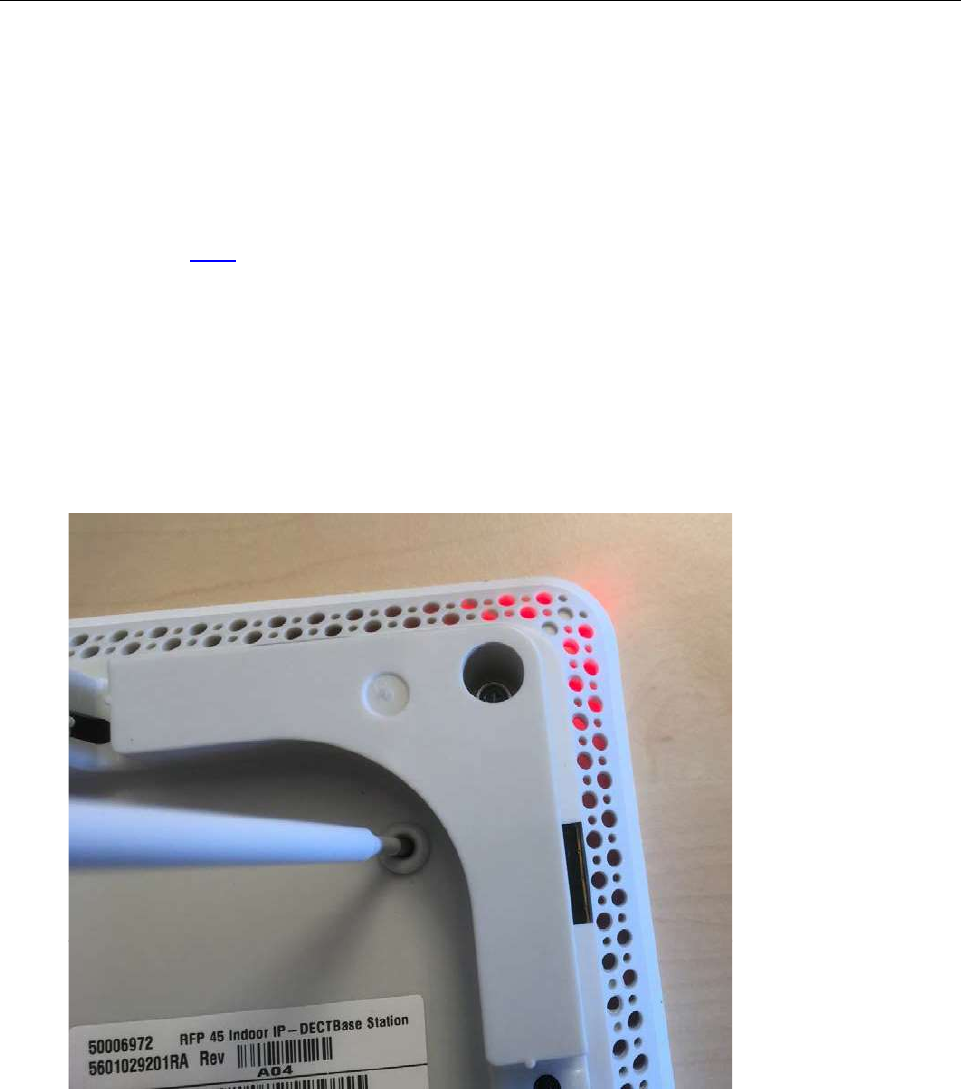
Enhanced Feature Overview
25
2.9 DECT BASE STATION RESET TO FACTORY SETTINGS
A DECT base station can be reset to factory settings using a USB flash drive with a file on it named
“factoryReset”. When the USB flash drive is plugged into the DECT base station, the DECT base station
is reset to factory settings automatically. The file is automatically removed from the USB flash drive
during this process.
You can also reset the base station to default settings using the OM Configurator or the OMM Web
service (see section 8.7.8).
2.9.1 RFP4G RESET TO FACTORY DEFAULTS
To reset to factory defaults, do the following:
1. Use the configuration button to reset the RFP to factory defaults. After the reset to factory
defaults, the RFP operates in the standard SIP-DECT mode.
2. Press the Configuration button to start the configuration process. The LED starts flashing green
which indicates that the button is pressed.
3. Keep the button pressed until it starts flashing red (10 sec < t< 15 sec).
4. Release the button while the LED is flashing red to reset the RFP to factory defaults.
5. The RFP performs a reset to factory defaults and reboots. After reboot the RFP is started in the
standard SIP-DECT mode.
Note: If the button is pressed until it is flashing green, then the button has no effect.

SIP-DECT OM System Manual
26
2.10 SYSTEM REDUNDANCY
The SIP-DECT solution offers a number of features to support system robustness and redundancy.
2.10.1 OMM STANDBY
The OMM is the central management entity in a SIP-DECT system and therefore constitutes a single
point of failure. It is possible to automatically transfer the OMM function to a second DECT base station
in case of failure or loss of network connection (see section 8.15).
In an OMM standby implementation, it could happen in rare cases that both OMMs become temporarily
active. In such a situation, all SIP-DECT users are SIP registered from to the configured PBX both
OMMs. This can cause problems if the PBX accepts only one registration per user (non-forking proxy).
To prevent this scenario, SIP-DECT has a mechanism to detect situations with two active OMMs. When
such a situation is detected, the remaining active OMM will SIP re-register all users to the PBX.
This mechanism can be enabled/disabled through the “SIP reRegister after 2 active OMM failover”
parameter in the OMP System -> SIP-> Supplementary Services menu (see section 5.4.3.6)
2.10.2 BACKUP SIP PROXY/REGISTRAR
To increase the operational availability of the system in critical environments like hospitals, the OMM
offers a new failover mechanism for the SIP server. Therefore, in addition to the primary proxy, outbound
proxy and registrar server, it is possible to configure two additional levels of backup servers named
“secondary” and “tertiary” servers (see section 8.20.3).
In addition, a keep-alive mechanism implemented in the OMM allows the automatic failover to
secondary/tertiary servers or automatic coming back to primary servers (see section 8.20.4).
2.10.3 CONFIGURABLE USER ACCOUNT FOR STANDBY CHECK
The “Standby OMM” feature of SIP-DECT allows configuration of the user account to be used to check
the availability of the iPBX. An availability check starts automatically in fail over situations.
The OMM starts a SIP registration for a specific DECT phone user and sends an OPTIONS request to
the configured SIP proxy. If there is an answer, the SIP proxy/registrar is considered reachable and the
standby OMM becomes active.
With previous SIP-DECT releases, the OMM used the user account with the lowest phone number for
the check procedure. To select a specific user account for this purpose, enable the “Used for visibility
checks” flag in the user settings (see section 6.10.4.2).
Please note: The “Used for visibility checks” flag can only be set for one user. The number
for visibility checks is shown under OMP Status -> Users -> Number menu. If the flag is
not set for a specific user, the OMM uses the user account with the lowest phone number.
2.10.4 USER DATA SYNCHRONIZATION (MIVOICE 5000 DUAL HOMING SUPPORT)
With SIP-DECT 6.1 and later, SIP-DECT supports MiVoice 5000 dual homing, to ensure that SIP-DECT
telephony services survive if the network connection to the OMM goes down. Dual homing is achieved
through user data synchronization across all OMMs in the system. Every peripheral OMM propagates
changes in user, device, Configuration over Air (CoA) profiles or SARI configuration to a central OMM.

Enhanced Feature Overview
27
Every OMM in the installation (including the central OMM) can use a standby OMM. AXI is used to
distribute configuration changes between the central and peripheral OMMs.
For more information on this feature, see section 8.16.
2.10.5 MULTI-OMM MANAGER FOR OMM-CENTRALIZED MANAGEMENT
With SIP-DECT 7.0 and later, SIP-DECT supports centralized management through the Multi-OMM
Manager (MOM).
The Multi-OMM Manager (MOM) is a server application that provides centralized provisioning and
user/device data synchronization across multiple SIP-DECT sites within a SIP-DECT system.
Additionally, the MOM supports system-wide messaging.
Instead of deploying one OMM with DECT base stations installed at different sites, or deploying DECT
base stations and a dedicated OMM at each site, you can create a multi-site SIP-DECT system with
local survivability and centralized management capabilities. You deploy OMMs and DECT base stations
as a standalone system at each site, but manage the entire SIP-DECT system through the MOM
interface.
For more information on this feature, see the Multi-OMM Manager Configuration and Administration
Guide.
2.11 SIMPLIFIED LICENSING
With SIP-DECT 6.0 or later, the licensing model is simplified. The system no longer distinguishes
between different DECT base station “soft-brands”, and some licenses are deprecated. See section
3.3.2 for more information.
Please note: New license files are not compatible with SIP-DECT 4.0 (or older) systems.
2.12 EXTENDED REGULATORY DOMAIN SUPPORT
SIP-DECT 6.1 enables operation of the SIP-DECT solution in more countries. The SIP-DECT system
can be operated in all countries that allow operation of DECT devices with frequency bands and transmit
power settings supported by the current SIP DECT phones and base stations. In most cases, this
requires different frequency channel and transmit power settings.
This feature is intended mainly for installations on cruise liners, where the SIP-DECT system requires a
switch of regulatory domain depending on the actual location of the ship. Such systems are planned and
installed based on a site survey with 100mW transmit power. The lower transmit power value is used at
all times, independent from the regulatory domain.
A new regulatory domain, 1910-1927MHz_250mW, has been added for South America. You can
configure this regulatory domain via the OMP (System -> Basic settings -> DECT tab); see section
6.5.1.2 for configuration details.
In addition, a new parameter is introduced to limit the DECT base station transmit power to 100mW,
independent of the active regulatory domain. The active transmit power is sent to the DECT phone when
it registers its location with the OMM. The DECT phone adjusts its transmit power to the value received
from the OMM.

SIP-DECT OM System Manual
28
2.13 DECT PHONE FUNCTIONALITY
2.13.1 DECT PHONE DOWNLOAD OVER AIR
The Mitel 600 series DECT Phones can download and upgrade their firmware via DECT over the air.
As of SIP-DECT 6.0, the DECT base station software images (iprfp3G.dnld and iprfp4G.dnld) contains
the Mitel 600 DECT phone software. The 3rd generation RFPs can house the SIP-DECT 8.0 OMM as in
previous releases. The OMM supports the 2nd, 3rd and 4th generation RFPs. If the DECT base station
houses the OMM, the OMM uses this software to update the DECT phones. The DECT base station
OMM no longer automatically attempts to load a DECT phone software image from a DECT base station
software URL when provided via DHCP or local configuration.
For specific maintenance purposes only, SIP-DECT allows configuration of a URL via the OMM Web
service or OMP to use an alternative DECT phone software image (see section 5.4.1.8). The Mitel 600
DECT phone firmware packages are delivered in the “600.dnld” file for the OMM running on a DECT base
station.
For large installations using a Linux Server-hosted OMM, a DECT base station software images
(iprfp3G.dnld and iprfp4G.dnld) without Mitel 600 DECT phone software is available to reduce network
traffic in update scenarios.
The DECT phone firmware packages are included in the OMM installation package for Red Hat
Enterprise Linux (RHEL) and CentOS for the Linux server version of the OMM.
Please note: An DECT base station upgrade from SIP-DECT 3.0 to 6.0 or later is not
supported due to the extended DECT base station software image. The 3.0 software does
not accept the extended software image.
For large installations using a Linux Server OMM, the DECT base station software images
(iprfp3G.dnld and iprfp4G.dnld) without Mitel 600 DECT phone software can be used. This
software image supports a direct RFP upgrade from SIP-DECT 3.0 to 6.1.
2.13.1.1 4th Generation RFP houses the OMM
The 4th generation RFPs come with more hardware resources in terms of CPU speed and memory. It is
recommended to operate the OMM on a 4G RFP.
Please note: If you move the OMM and you want to keep the existing dynamic user phone
relation which is stored in the OMM DB backup file, then activate the option Preserve
user device relation at DB restore in the new OMM. The new OMM restores the relation
between the user and the DECT phone during DB import.
If this option is not set, then all dynamic user gets logged out from their DECT phones
when importing the OMM DB into the new OMM.
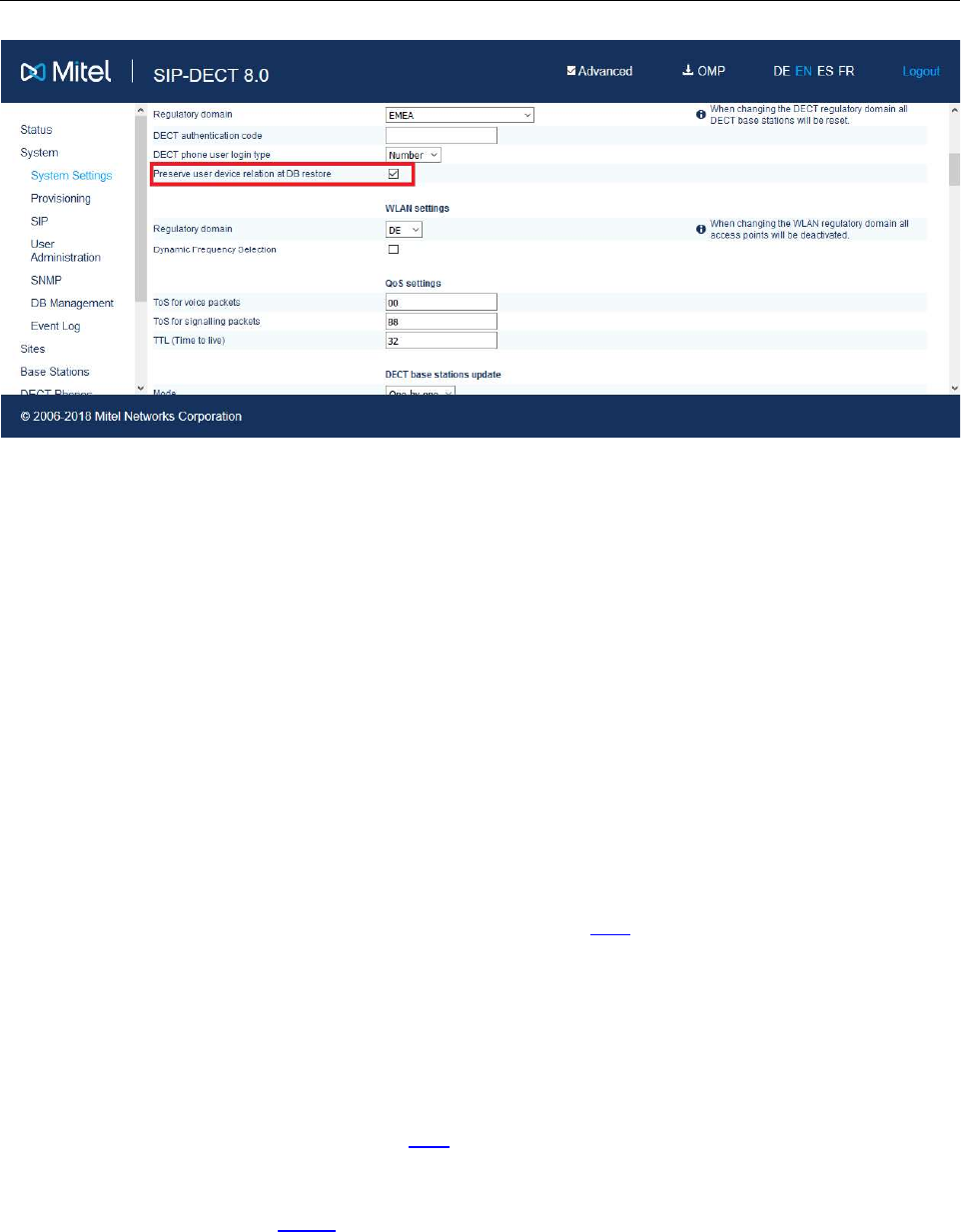
Enhanced Feature Overview
29
If the OMM is operated on 4G RFP, then 1024 DECT users and phones are supported. (512 DECT users
and phones if the OMM is operated on a 3G RFP).
The 4G RFP comes with the configuration button, which allows to switch to the SIP-DECT with Cloud-ID
(SDC) mode. As of SIP-DECT 8.0, a 4G RFP is required to run an SDC OMM.
2.13.2 CENTRAL DECT PHONE CONFIGURATION OVER AIR (COA)
SIP-DECT 6.0 and later supports centralized DECT phone configuration over the air (CoA) for Mitel 602
DECT phones. DECT phone CoA is useful for deployment of special configuration to a single DECT
phone or a large number of DECT phones. No local access to the DECT phone is required.
DECT phone CoA is implemented by providing additional configuration information to the well-known
configuration files or providing profiles via OMP. Configuration can be changed at the device level
(DECT subscription) or the user level (based on login).
Configuration of all DECT phones with a predefined default profile is also supported. Up to 20 possible
DECT phone profiles make it easy to adapt to different usage scenarios for heterogeneous user groups
(e.g., nurses and doctors in hospital environments). See section 8.23 for more information on this
feature.
2.13.2.1 CoA enhancements
The Mitel 602 DECT phone 6.1 firmware (bundled with SIP-DECT release 6.1) includes new features
which are configurable via Configuration over Air (CoA).
New configuration commands allow you to overwrite local key programming on the Mitel 602 DECT
phones. SIP-DECT 6.1 also supports configuration of the new XML application hooks introduced for the
XML terminal interface via CoA (see section 2.32).
In addition, the Mitel 602 DECT phone 6.1 firmware introduces variable lists. A variable list includes
a number of items, each of which corresponds to an action to be performed on the DECT phone. For
more information, see section 8.23.5.

SIP-DECT OM System Manual
30
2.13.3 OMM DECT PHONE PROVISIONING
While some users in the SIP-DECT system use a dedicated DECT phone, it is also possible to operate
shared DECT phones. The SIP-DECT solution provides an enhanced DECT phone sharing and
provisioning concept that enables the management of a large number of DECT phones and provides a
flexible subscription model.
The SIP-DECT system allows logging into and out of different DECT phones with a personalized user
account, import of user data from an external provisioning server, automatic subscription of new DECT
phones, and control of subscription-specific system functions from DECT phones.
See the SIP-DECT DECT Phone Sharing and Provisioning Guide for details on this feature.
2.13.4 MITEL 600 DECT PHONE DIAL EDITOR MODE
It is assumed that most customers use digits only in their dialing plan, and that it is more convenient if
dial editors support only the digits 0 to 9, * and #. The Dial editor supports digits only flag (on the
OMP (System -> Advanced settings -> DECT Phones tab) enables this mode. In this mode, the * has
the meaning of a digit to be merely dialed, even if it short-pressed.
If the mode is not set to digits only, the short pressed * will change the editor mode to alphanumeric.
2.13.5 MITEL 602 DECT PHONE CUSTOMIZABLE BOOT TEXTS
By default, the text shown on the Mitel 600 DECT phone at start up is Mitel-specific (branded in the
firmware). Customers can also define their own text (on the OMP (System -> Advanced settings ->
DECT Phones tab).
2.13.6 OMM-CENTRALIZED CALL LOGS
SIP-DECT 7.0 introduces support for OMM-centralized call logs for SIP-DECT systems using the Mitel
MX-ONE call server.
The OMM-centralized call log features the OMM manager caller and redial list entries pushed by the MX-
ONE call server for all DECT phones in the system. When this feature is enabled, DECT phone users
can access the OMM-centralized call log on their DECT phones using the existing XML hooks for caller
list and redial list.
The OMM also handles the “missed call” notifications for the DECT phone. If the number of missed calls
changes, the OMM sends the information to the DECT phone.
The OMM sorts the call log entries according to the most recent entry. Call log entries from the same day
are listed with the time stamp and older entries are listed with the date stamp.
For information on how to enable OMM-centralized call logs, see section 5.9.5.2 (Modifying an XML
Hook via the OMM web service) or section 6.12.8.2 (Modifying an XML Hook via the OMP).
2.13.7 USER INDIVIDUAL DECT PHONE PIN KEY LOCK
2.13.7.1 OMM Key Lock with PIN Management

Enhanced Feature Overview
31
The Mitel 600d DECT phone family Mitel 612d, 622d, 632d, 650c offers a new PIN management to
protect the DECT Phone. As of SIP-DECT 8.0 and the DECT phone SW 7.2, the key lock PIN is
managed by the OMM to improve the shift worker support and the roaming between OMMs in a MOM
setup.
If the DECT phone is subscribed to a SIP-DECT system, the local DECT phone key lock PIN settings are
suppressed and the OMM managed PIN is used. Although PIN key lock settings may be suppressed the
user can change his PIN.
The key lock with PIN can be managed through Web, OMP, OMM configuration files and by the user
through the DECT phone UI in System menu/Administration/Key lock.
Note that this is not possible for external users, that is, users who are provisioned through user.cfg
file. If user data are provisioned through user.cfg files, then the provisioning platform is the data
master and there is no option to update data towards the provisioning platform when changed in the SIP-
DECT system. Therefore, data changes in the SIP-DECT system are prevented.
For information on how to activate the feature, see section 6.10.4.12 “Key lock” tab.
2.13.7.2 Resetting DECT Phone PIN
If a user has forgotten his PIN to unlock the DECT phone, the administrator can setup a new PIN
through OMP, if the phone is reachable by the system; see section 6.10.4.12 “Key lock” tab.
If the DECT phone is not reachable by the system, the phone may be master-reset by a procedure
described in the Mitel 600 DECT Phone User Guide.
2.14 HOT DESKING
With SIP-DECT 6.2 and later, hot desking functionality, as provided by the MiVoice Business platform, is
supported.
Users with hot desking permissions are configured in the OMM system without a bound device, and the
hot desking capability flag set to enabled.
The hot desking capability allows a user to use the same extension on multiple devices. For example, a
user who has a hot desk extension can log into the DECT phone and be automatically logged out of the
desk phone (and vice versa).
The user can initiate a log out from the DECT phone via the Administration menu on the device.
2.15 CONFERENCING
To improve the integration with different SIP servers, SIP-DECT includes support for centralized and
internal three-way conferencing.
The centralized conferencing feature is based on RFC 4579 and supports the use of external third party
conference servers (e.g. Broadsoft or Sylantro servers), which are RFC 4579-compliant.
SIP-DECT also includes an integrated conference server implementation based on RFC 4579. The
integrated conference server offers three-way conferencing to SIP-DECT users who are hosted on SIP
servers without their own conference solution.
The centralized as well as the integrated conferencing feature allows users to:
merge two active calls together into a conference call
transfer another party into the conference when on an active conference call

SIP-DECT OM System Manual
32
disconnect from an active conference call while allowing the other participants to
remain connected
Regardless whether the centralized or the integrated conferencing is used, conferences can be initiated
from the Mitel 600 and Mitel 142d DECT phones.
For a detailed description of conferencing functionality, see section 8.21.
2.15.1 CONFERENCING AUDIO NOTIFICATION
The SIP-DECT Integrated Conference Server (ICS) notifies all conference participants when someone is
joining or leaving the conference. The notification is a specific tone for joining and a specific tone for
leaving the conference.
2.15.2 CENTRALIZED CONFERENCING WITH MIVOICE BUSINESS
SIP-DECT 6.1 introduces support for centralized conferences hosted by the MiVoice Business platform.
The SIP signaling implemented by the MiVoice Business platform require that the SIP-DECT
implementation initiate a conference via blind transfer. The conference mode (External – blind transfer)
can be configured globally for all SIP-DECT users (via the OMP System -> SIP -> Conference tab) or
configured individually for SIP-DECT users (via the OMP DECT Phones -> Users -> Conference tab).
SIP-DECT 6.1 also introduces a new Feature Access Code. The new “Blind transfer” Feature Access
Code allows a user to initiate a SIP blind transfer from the Mitel 600 DECT phone. You can configure the
FAC via the OMM web service (see section 5.9.4) or the OMP (see section 6.12.2).
Please note: Overlap sending is not supported for FAC. The blind transfer FAC and the
following transfer target number must be entered en-bloc. The blind transfer FAC cannot
be triggered manually from the dial editor.
To support the integration of SIP-DECT with the MiVoice Business platform, SIP-DECT 6.1 extends the
XML terminal interface for the Mitel 600 DECT phone to include new predefined XML application hooks.
These additional functions can be applied to the DECT phone's programmable keys or accessed from a
menu.
You must configure the appropriate hooks in the OM via the OMM Web service or OMP (System
Features -> XML Applications) to make the applications avialable on the Mitel 600 DECT phones.
2.15.3 N-WAY CONFERENCING
SIP-DECT introduces off release 7.1 support of n-way conferencing in conjunction with third party
conference servers which are compliant with RFC4579 (for example, Broadsoft).
This functionality allows to easily extend an already established 3-way conference by adding further
participants.
The creator of the conference has to execute the following steps to accomplish this:
make an inquiry call to the next participant.
if the called party accepts the call, then enter the options menu.
select entry "conference".
the called party is added to the conference.

Enhanced Feature Overview
33
2.16 SIP OVER UDP/TCP/TLS
In addition to UDP, SIP-DECT also supports TCP and TLS as transport protocols for SIP signaling. The
OMM provides the following transport protocol modes:
UDP: All SIP messages are sent/received via UDP
TCP: All SIP messages are sent/received via TCP
UDP/TCP: All outgoing connections are always set up via TCP, but incoming SIP
messages are also accepted when sent over UDP
TLS: All SIP messages are sent/received via TLS connections
Persistent TLS: All SIP messages are sent/received over TLS connections. The
OMM tries to keep the connection to the SIP server open permanently.
2.17 SIP MULTIPORT
Some call server platforms (e.g. Cisco CUCM) and internet telephony provider environments (SBCs) do
not accept SIP registration from different users who have the same IP address and port, but require a
unique source signaling port for every SIP extension. By default, the OMM uses one source port for all
extensions, but does allow the configuration of individual local signaling ports for users and conference
rooms.
The port range is set per protocol (i.e., UDP/TCP and TLS), and must not overlap with other ports in use.
The following parameters can be configured or read per user (see section 6.10.4) and conference room:
Fixed port: Port used explicitly for SIP signaling. If set to 0, an automatically
calculated port is used for this user or conference room. The default is 0.
Calculated port: A read-only parameter whose calculation is based on the internal
user or conference room ID and a configurable port range, in a way that all users or
conference rooms are spread over the range.
The calculation is based on the following rules:
UserPortCount = UserPortRangeStart - UserPortRangeEnd + 1
UserPort = ((UserID – 1) % UserPortCount) + UserPortRangeStart
ConfRoomPortCount = ConfRoomPortRangeStart - ConfRoomPortRangeEnd + 1
ConfRoomPort = (ConfRoomID % ConfRoomPortCount) + ConfRoomPortRangeStart
The “Calculated port” is first updated with the SIP registration of the user or conference room.
Depending on the “Register Traffic Shaping” settings and the number of users/conference rooms, the
update may take some time.
The port ranges used for the port calculation can be configured globally for all SIP DECT users and
conference rooms via the OMP (see section 6.5.4.1).
Please note: To provide each user and/or conference room with a unique port using the
port calculation, the port range must be greater than or equal to the number of users or
conference rooms.

SIP-DECT OM System Manual
34
Configuration Rules for Port Ranges
Please note the following configuration rules for configuration of the UDP/TCP and TLS port ranges:
Port ranges for users and conference rooms may not overlap.
A port range configured outside the defaults (5060, 5061, 4060, 4061) can be within
the range 17000 – 32767.
Port ranges may not overlap with the ports of other OMM services. See section 12.6
for a list of all protocols and ports.
If the OMM is running on a DECT base station, the ranges may not include ports
used by other DECT base station protocols. See section 10.4 for a list of all ports
and protocols.
The port range for conference rooms is limited to 100 ports.
The port range for users is limited to the following:
RFP OMM: Maximum 512 ports (1024 ports if OMM runs on RFP 4G).
Linux Server OMM: Maximum 10,000 ports.
2.18 UTF-8 ENCODING
The UTF-8 support allows the display of a wider range of language specific characters (e.g., umlauts)
and facilitates localization for different markets. The OMM and the Mitel 600 DECT phone family support
UTF-8 for text messaging.
In addition, the OMM and the Mitel 600 DECT phones support an extended character set for
User parameters (configurable via WEB, OMP or external user configuration files)
– System name
– User name
– Number
SIP “display names” und SIP “user id’s” of incoming and outgoing calls
Call logs
LDAP directory access
XML terminal interface objects
For third-party GAP DECT phones, Mitel DECT 142 / Mitel 142d or Mitel 600 with older firmware
releases, the UTF-8 character set is not supported. If possible, the OMM maps UTF-8 character to
LATIN-1.
Please note: The available set of characters is defined by the DECT phone. Please see
/31/. User configuration files must be encoded in UTF-8.
2.19 ALPHANUMERIC DIALING
SIP-DECT supports the dialing of alphanumeric characters. This allows a user to dial names (e.g.
“Heinrich.Mueller”) as well as digits.

Enhanced Feature Overview
35
If SIP URI dialing such as “name@domain” is used, you must use an (outbound) proxy that supports the
interpretation of SIP user names, including domain names.
Please note: The “Digit treatment” feature handles dialed digit strings only. It cannot be
applied with UTF-8/alphanumeric dialing.
2.20 VOICE MAIL NUMBER
You can configure a system-wide voice mail number. This number is used by the Mitel 600 DECT phone
family if a voice box call is initiated. The system-wide voice mail number can be overruled by a user-
specific voice mail number. If there is no voice mail number configured or another type of DECT phone is
used, the voice mail number must be configured locally on the DECT phone.
Please note: The voice mail number is supported by the external user data configuration
files. The parameter UD_VoiceMailNumber can be set in the user_common.cfg and/or
“user.cfg” or “LoginID.cfg” e.g. “UD_VoiceMailNumber=222”. For details, see the SIP-
DECT DECT Phone Sharing and Provisioning Guide.
2.21 CALL HANDLING
SIP-DECT supports a number of features for enhanced call handling.
2.21.1 DIVERSION INDICATION
The OMM supports the displaying of diversion indications for Mitel 142d and Mitel 600 DECT phones
based on the SIP Diversion Header defined in RFC 5806. This feature is only available with iPBXs
generating such Diversion Headers.
When an outgoing call from a Mitel 142d / Mitel 600 phone is being diverted to another destination (i.e.
via call forward), the phone displays the Caller ID (phone number and/or caller name) of the new
destination and the reason for the call diversion (if delivered from IPBX). Similarly, at the new
destination, the Caller ID of the original call destination is displayed.
Example:
1Tim calls Mark at 5142.
2Mark’s phone is busy and diverts the incoming call to Roger at 5141.
3Tim’s phone displays the extensions where the call is being diverted to and the reason for diverting
the call.
4Roger’s phone starts ringing and displays the name and number of the phone the incoming call (Tim)
and the original called destination (5142).
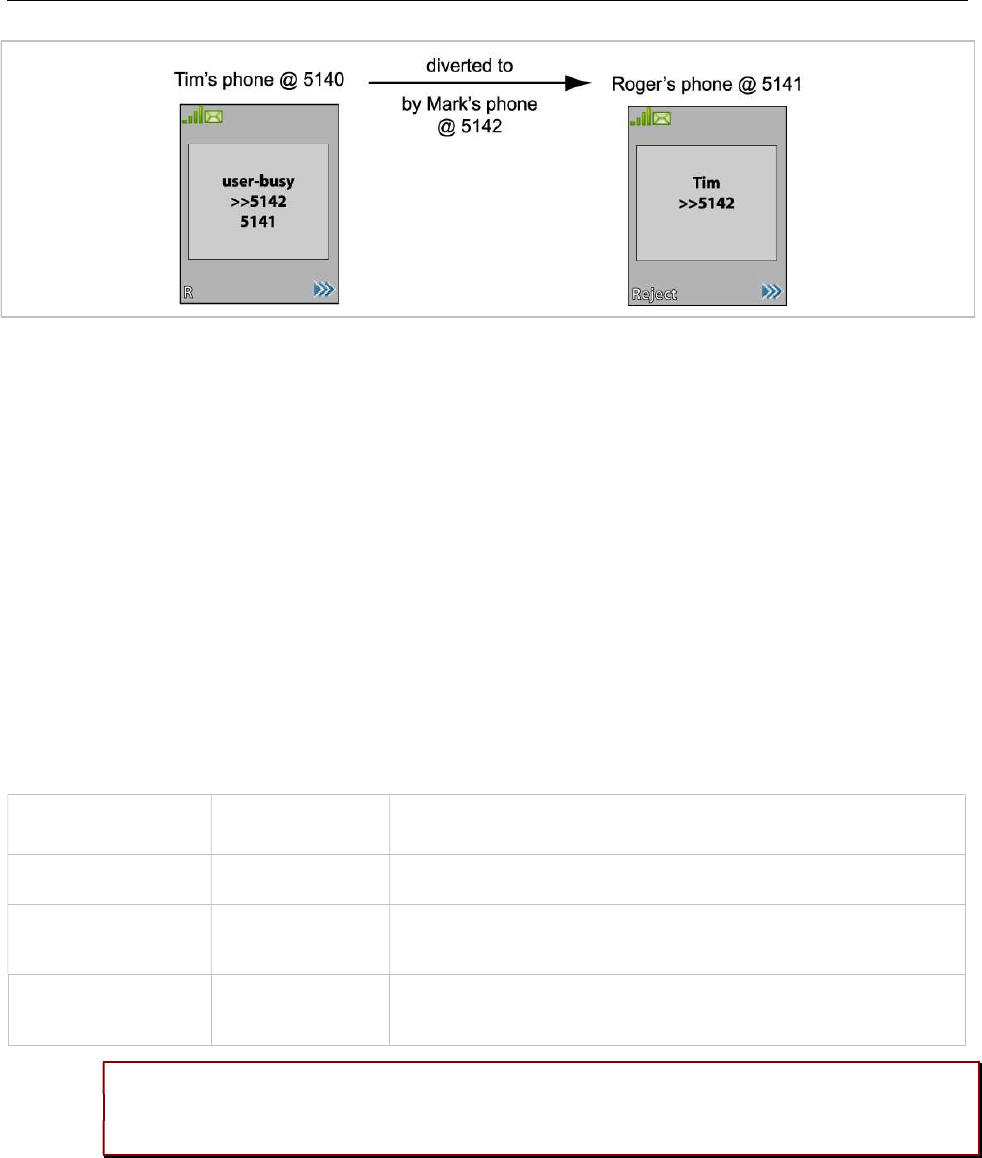
SIP-DECT OM System Manual
36
2.21.2 CALL COMPLETED ELSEWHERE
SIP-DECT supports the SIP “Reason” header field defined in RFC 3326.
When SIP-DECT receives a CANCEL request including a “Reason” header field with “cause=200”, the
incoming call will be marked as accepted in the local incoming call logs of the Mitel 600 and Mitel 142d
phones.
2.21.3 SEMI-ATTENDED TRANSFER
The SIP message sequence for a “Semi-Attended Transfer” allows the transferor to start the transfer
while the target phone is still ringing.
SIP-DECT supports different behaviors for semi-attended transfers. This can be configured on the OMP
SIP -> Advanced settings tab (see section 6.5.4.2).
The supported modes are:
Semi-attended
transfer mode
Refer-to with
replaces
Behavior
Blind No The semi-attended transfer is handled as a blind transfer. The phone
sends CANCEL before REFER for semi-attended transfer.
Blind Yes The semi-attended transfer is handled as a blind transfer. The phone
sends REFER with Replaces for semi-attended transfer and no CANCEL.
This behavior is not SIP compliant but necessary for some iPBX platforms.
Attended - The semi-attended transfer is handled as an attended transfer. Both lines
of the transferor remain active until the transfer succeeds. This behavior is
compliant to RFC 5589.
Please note: The mode “Semi-attended transfer mode: Blind” with “Refer-to with replaces:
yes” is not SIP compliant and should only be used on iPBX platforms that require that
signaling.
2.21.4 THIRD LINE HANDLING FOR MITEL 142D AND 600 DECT PHONES
In earlier implementations of SIP-DECT user call control, a waiting call forces the user to react to that
call (accept or reject), before he can use other supplementary services like call transfer, conference or
inquiry call options.
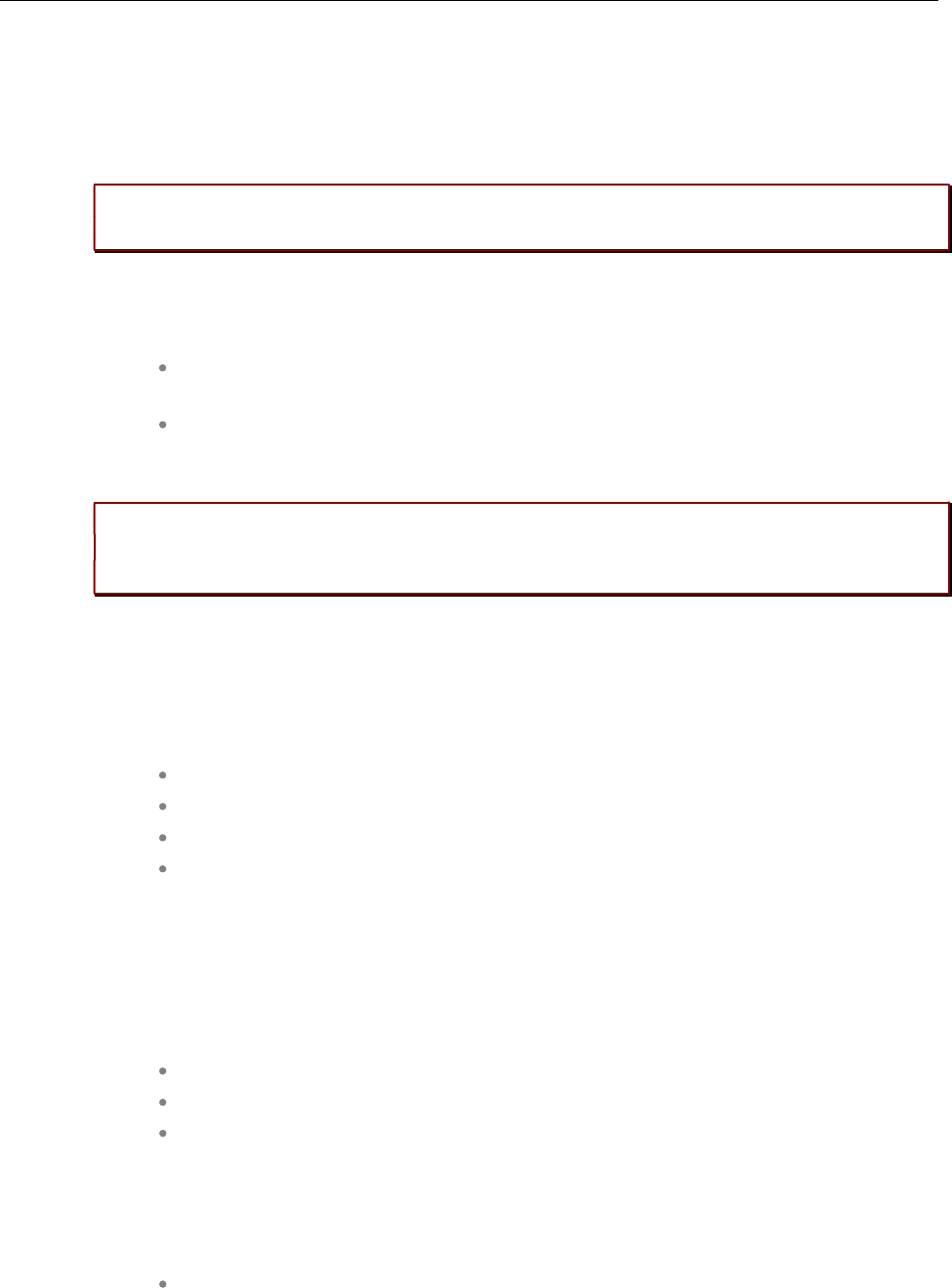
Enhanced Feature Overview
37
In the new implementation, a third line is reserved for call waiting purposes. The waiting call is kept in the
background, even if the receiving user decides to finish supplementary services first (see rule at the end
of this subsection). It is also kept, if two lines are already used for brokering (in the former
implementation, the incoming call was answered with busy state). After one of those lines is released,
the waiting call can be accessed by the known means (by R-key or the referring menu options).
Please note: The Third Line Handling is available for Mitel 142d and Mitel 600 DECT
phones, but not for third party GAP phones.
Third Line Handling follows the existing MMI philosophy of the DECT phones. If the user wants to
continue supplementary services when a call comes in:
R-Key will accept the incoming call. All supplementary services will involve that
incoming call directly or indirectly.
Selecting “Transfer” or “Brokering” offers the possibility to keep the waiting call and
continue supplementary services with the former line only. The waiting call is not
involved but can be accepted later.
Please note: The Third Line Handling feature offers the option to receive a further incoming
call only. A user cannot open a third line as the active part (e.g. to open a further third line
for an inquiry call in a brokering situation, where two lines are already involved).
2.21.5 CALL TRANSFER ENHANCEMENTS FOR MITEL 142D DECT PHONES
The blind transfer has been slightly simplified. The second confirmation after selection of the transfer
targets number by the “start” button is removed. So the steps are reduced to:
Press I-Key within a basic call
Select “Transfer”
Select editor or phonebooks
Edit or select destination and press “OK”
In earlier OMM releases (SIP-DECT 4.0 and earlier), call transfer had to be initiated via menu. Pressing
the hook key led to the release of the active line and a callback menu popped up.
The OMM now allows the use of the hook key for call transfer, as it is already known from Mitel 600
DECT phones. To enable this feature, the administrator must enable the ”Call Transfer by Hook” feature
in the OMP System -> SIP -> Supplementary Services menu.
To initiate a transfer via the hook key, do the following:
initiate an inquiry call and dial
wait for completed connection (optional)
press the hook key
You can still initiate a transfer via the menu.
If the “transfer by hook” capability is set, the release of the active line in brokering state must be done via
the menu option “Release”:
Press I-Key within an inquiry call or brokering state

SIP-DECT OM System Manual
38
Select “Release”
2.22 TRUNCATING SIP USER NAME IN SIP URI
If user name info in SIP to-/from-/contact headers or p-asserted-identity is extended by a suffix, which is
separated by a semicolon, this suffix is truncated before the username is printed to call displays or DECT
phone internal call logs.
Example: If the DECT phone receives
Contact: "Dominique B.” sip:5405;openSipsTestproxy@testlab.mitel.randd.com
only 5405 will be extracted as user name to be printed. The display name “Dominique B.” will also be
shown, but the extension “openSipsTestproxy” will be removed.
To enable this feature, the administrator must set the ”Truncate Caller Identification” parameter in the
OMP System -> SIP -> Supplementary Services menu.
2.23 OM LOCATING APPLICATION
You can set up a system to locate and track DECT phones in your DECT system. This includes a
separate Web user interface, which for example can be operated by service personnel to locate a DECT
phone that has triggered an alarm. See the OpenMobility Locating Application User Guide for details
(see /27/).
The OM Locating application can display small maps showing the placement of a DECT base station. In
earlier SIP-DECT releases, these graphic maps had to be generated manually by using a graphic editing
program.
The OM Management Portal (OMP) can be used to generate the graphic map images needed by the OM
Locating application.
Images showing the floor plan of the buildings belonging to the OM system can be imported into the
OMP. In a next step the RFPs of the SIP-DECT system can be placed on these images with drag and
drop. Finally for each of the RFPs, the graphic map images will be generated in the format and size as
required by the OM Locating application.
The process and the OMP functionality for this feature are described in detail in section 8.26.
2.24 EXTENDED MESSAGING
You can set up an extended messaging and alarms system (e.g. to provide automated reactions on
alarms triggered by DECT phones or on alert messages). The extended messaging system may also
provide message-based services, and may also be integrated with external computer systems. See the
OpenMobility Integrated Messaging & Alerting User Guide for details.
2.25 VIDEO SUPPORT
The SIP-DECT solution supports snapshot images and video streaming via USB video devices
connected to DECT base stations.
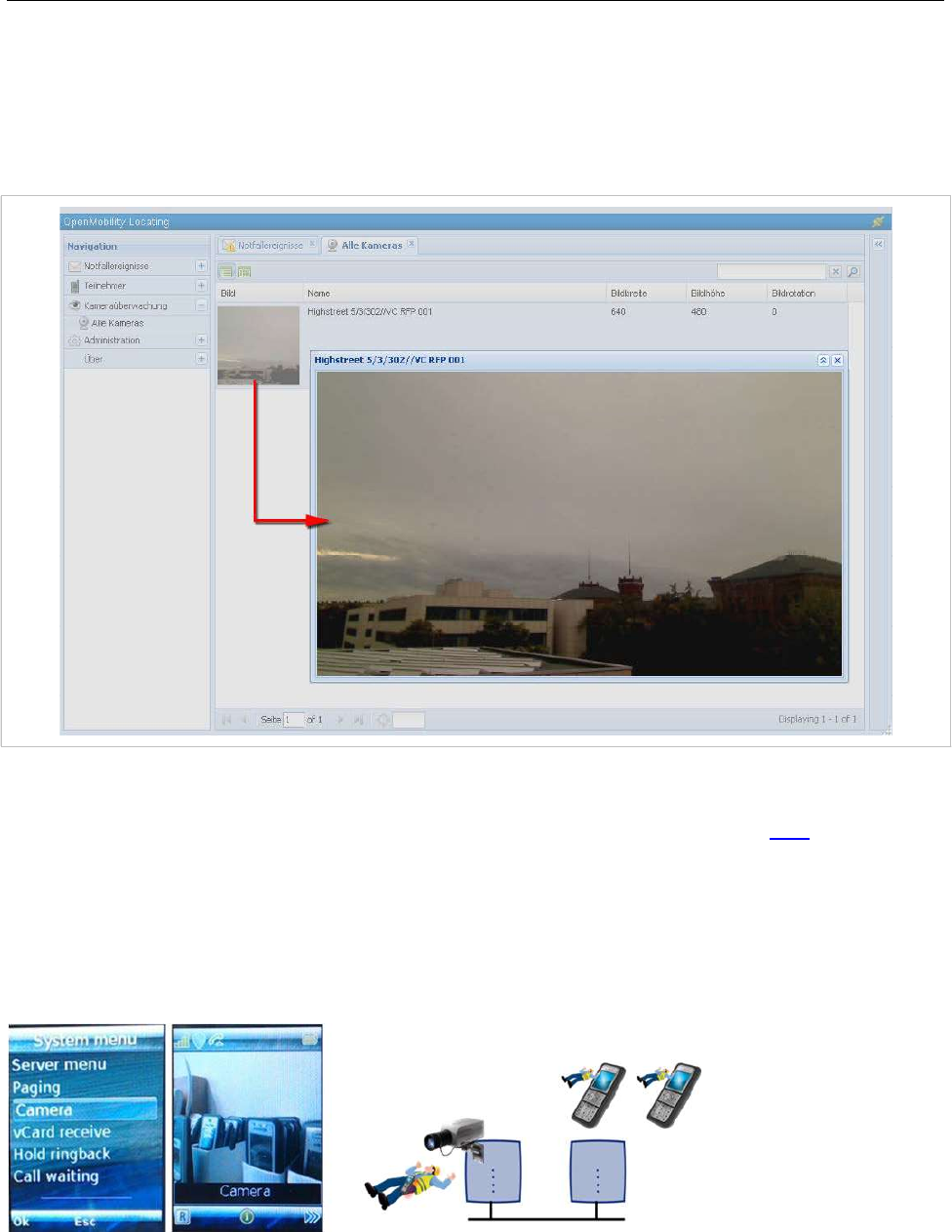
Enhanced Feature Overview
39
2.25.1 USB VIDEO DEVICES
You can configure and use USB video devices that are fully supported by the UVC video class device
driver. The USB video device is connected to the USB port of a SIP-DECT RFP 35. In conjunction with
the “Surveillance” feature of the OM Locating application, the USB video devices generate snapshot
images and video streams.
One USB camera (only the types Logitech HD Webcam C615 or Logitech HD Pro Webcam C920) can
directly be connected to a SIP-DECT RFP 35/43. Such cameras are used as well with the OM Locating
Application as with the Terminal Video feature. For a detailed description see section 8.27.
2.25.2 TERMINAL VIDEO
With SIP-DECT 5.0 and later, the Mitel 602 DECT phones support video streams from cameras
connected to SIP-DECT base stations RFP 35/43. When a user has the video stream permission, he can
choose in the system menu from a list of cameras to connect.
Video Streaming is only available when the DECT phone is connected to a 3rd or 4th generation RFP and
the permission is set for the site and the DECT phone.

SIP-DECT OM System Manual
40
Video streams are treated like a call by the DECT phone, and require two (of eight) air channels on the
RFP for each stream. The DECT phone can also perform handover between DECT base stations with
an active video connection.
A video connection is automatically terminated by the system in case that any related capability (e.g.
video stream permission) is changed.
The maximum number of simultaneous terminal video streams per camera is restricted to 10.
Connection and configuration of cameras is similar to the steps for the locating application. Special steps
necessary for terminal video are:
Enable all sites that have the technical capability (only 3rd or 4th generation RFPs)
via OMP for terminal video.
Enable the additional service “Video stream permission” via OMP (DECT Phones ->
Users) for those users who are allowed to use this feature.
Please note: It is strongly recommended to set the radio fixed parts attributes building, floor
and room, if you configure a huge system with a large number of cameras. This will ease
the selection of cameras on the DECT phone menu.
A video camera must be configured in OMP before it can be offered to applications and the Mitel 602
DECT phones.
The selection of the menu “Cameras” is offered in the Mitel 602 DECT phone “System menu” (e.g. long
press on Menu >>>), if
at least one camera is plugged and activated by the enable flag
the DECT phone user has the permission to select cameras
the DECT phone is located within a site, which allows terminal video
Navigation within the camera menu will be done by OK (and ESC) keys. To establish a video stream,
press “hook off” if the name of your camera is selected.
If the number of cameras exceeds the visible lines of the DECT phones display, the presentation is
arranged hierarchically. In this case, at least one sublevel must be selected before camera names are
offered. The hierarchy of the referenced DECT base station (site, building, etc) is inherited for that
purpose.
The destination of a video call is added to the DECT phone internal redial list.
Please note: Audio calls or any system service activities are not possible during an
established video link. Any kind of auto callback (initiated by a message or pushed by
XML notification to direct dial) is not supported for video calls.
2.26 USER MONITORING
The OMM monitors the status of the user’s DECT phone to verify the user’s availability to receive calls or
messages. By default, passive and active user monitoring is disabled.
In addition to the standard request, response and notification messages, the OMM generates alarm
triggers if a user becomes unavailable. The alarm triggers can be consumed by the OM IMA, the OM
Locating application, or another application using OM AXI. If a user becomes available again, the OMM
sends an additional alarm trigger to indicate the change in status.

Enhanced Feature Overview
41
User status information is available via OM AXI and OMP.
For a detailed description of the “User monitoring” feature, see section 8.29.
2.27 CORPORATE DIRECTORY INTEGRATION
The SIP-DECT solution supports integration of up to five directory servers. The configured directories
are displayed in a list on the Mitel 600 DECT phone when the user invokes the central directory function,
and search by name to retrieve phone or mobile numbers (as well as email addresses for SIP-DECT
messaging applications). Note that users can only access one directory at a time.
SIP-DECT supports LDAP and XML directories, and as of SIP-DECT 6.2, Broadsoft XSI-based
directories are also supported. XML-based directory services can be implemented using the XML
terminal interface.
The SIP user name and SIP authentication credentials can be used for directory access, or can be
specified separately. If different from the SIP user name and authentication credentials, the user name
and credentials must be explicitly configured for each user.
For configuration information see section 6.12.5.
2.28 INTEGRATION INTO EXTERNAL MANAGEMENT SYSTEMS
You can use the following features to integrate the SIP-DECT system into external management
systems:
Each DECT base station may run an SNMP agent that can be queried by SNMP
management software (see 8.19).
To further integrate into external configuration management systems, the DECT
system’s configuration is available my means of ASCII-based configuration files.
You can configure automatic import of configuration files from an external server.
For more information, see section 8.8.
The OM AXI software application interface can also be used for integration into
external systems. See the OM Application XML Interface (OM AXI) specification,
see /31/.
2.29 SYSTEM CONFIGURATION TOOLS
You can configure and maintain the SIP-DECT system with two different applications:
the Web-based OMM Web service (see section 5)
the Java-based OM Management Portal (OMP, see section 6)
Both applications support the essential configuration and administration settings required for smaller
SIP-DECT systems. However, for larger SIP-DECT systems using enhanced features, some settings are
only available in the OMP application.
The following table lists the features and settings that are available in each configuration tool:
Feature Web OMP

SIP-DECT OM System Manual
42
SNMP configuration Yes Yes
DB management: User data import No Yes
Configuration and start of a system dump Yes Yes
Download system dump to PC No Yes
Event information display (Event log) Yes Yes
WLAN profile configuration Yes Yes
Dynamic DECT phone subscriptions (OpenMobility provisioning) No Yes
Locating settings for DECT phone No Yes
Paging areas No Yes
Alarm Triggers No Yes
DECT base station sync. View No Yes
DECT base station statistics No Yes
DECT base station data export No Yes
Capturing unconfigured DECT base stations Yes Yes
Configuration of XML applications (SIP-DECT XML terminal interface) Yes Yes
Configuration of SIP backup servers No Yes
User monitoring No Yes
2.30 SIP ENHANCEMENTS
With SIP-DECT 6.0 and later, the SIP-DECT solution provides several enhancements to the SIP protocol
implementation.
2.30.1 GLOBALLY ROUTABLE USER-AGENT URIS (GRUUS)
Globally Routable User-Agent URIs (GRUUs) provide a way for anyone on the Internet to route a call to
a specific instance of a SIP User-Agent. IP-DECT provides GRUU support according to RFC 5627.
A “sip.instance” is added to all non-GRUU contacts. You can enable or disable this support via OMP or
Web service (System -> SIP -> Basic Settings).
2.30.2 SESSION TIMER
SIP-DECT supports RFC4028 “Session Timers in the Session Initiation Protocol (SIP)” to keep call
sessions alive and to determine whether established call sessions are still alive.
You can configure the session refresh period via OMP or Web service (System -> SIP -> Advanced
Settings).
2.30.3 SIP CONTACT MATCHING
In special Network Address Translation (NAT) environments, the Contact URI in a SIP response to a
REGISTER request may not match the URI originally sent out.

Enhanced Feature Overview
43
In such cases, SIP-DECT offers the “SIP contact matching” configuration parameter. You can enable this
parameter via OMP or Web service (System -> SIP -> Advanced Settings).
2.30.4 CONFIGURABLE CALL REJECT STATE CODES
The SIP status codes for user-rejected calls and device-unreachable calls are configurable via OMP and
Web service (System -> SIP -> Advanced Settings).
2.30.5 CALL RELEASE TIMERS
SIP-DECT 6.0 or later allows changing certain system default timers. These timers determine the DECT
phone call behavior when calls are released by the B party.
You can configure the ”Call release timeout”, ”Hold call release timeout”, and ”Failed call release
timeout” parameters via OMP or Web service (System -> SIP -> Supplementary Services).
2.30.6 INCOMING CALL TIMEOUT
Incoming calls are automatically rejected when the user does not answer the call within 180 seconds.
This time period is too short for special customer use cases.
You can configure this interval through the “Incoming call timeout” parameter through OMP or Web
service (System>SIP>Advanced Settings).
2.30.7 CALL REJECT ON SILENT CHARGING
If the following 2 conditions are fulfilled, all Mitel 600 DECT phones reject incoming calls:
If the flag “Call reject on silent charging” is set.
If the phones are in charging mode and “silent charging” is activated in the phone.
If the flag is set by OMP or WEB service. The parameter is grouped under
System>SIP>Supplementary Services.
2.30.8 ROUTE HEADER
In some special environments, SIP outbound proxies do not support SIP Route header.
For such cases, SIP-DECT offers the Remove route configuration parameter. If this parameter is
enabled, SIP Route headers are not added to SIP messages sent to outbound proxies.
You can enable this parameter through OMP or through Web service (System>SIP>Advanced
Settings>General).
2.30.9 MWI SUBSCRIPTION PERIOD
SIP-DECT supports MWI subscription based on /21/. The configuration parameter Explicit MWI
subscription period enables configuring the requested duration in seconds, which is the interval at
which SIP-DECT re-subscribes to MWI before the MWI subscription times out. You can enable this
parameter through OMP or through Web service (System>SIP>Advanced Settings>General).

SIP-DECT OM System Manual
44
2.31 AUTO ANSWER, INTERCOM CALLS AND AUDIO SETTINGS
Certain call features force the DECT phone to call a specified SIP user automatically and, as an option,
to establish a speech path immediately without any intervention by the DECT phone user.
SIP-DECT allows control of the following audio settings on the DECT phone to prevent unauthorized
parties from hearing the call:
Speech path can be initially set to be muted
A warning tone may be generated
SIP-DECT also supports intercom calls. This means that the originating party can force the called party’s
phone to establish a speech path immediately. Control of the same audio settings applies.
2.31.1 INTERCOM CALLS
A DECT phone can be forced to answer an incoming SIP call automatically if certain information is
included in the SIP header. A DECT phone user can also initiate an intercom call, which automatically
triggers the destination to talk.
Intercom calls can interrupt active calls (“barge in”). If it is an established basic call, the active call is put
on hold. In more complex call situations, a “barge in” always supercedes existing active calls, unless the
active call is a “SOS” call.
The call is identified as an intercom call if the SIP INVITE header includes:
a “Call-Info” header containing “answer-after=0”
an “Alert-Info” header containing “info=alert-autoanswer”
Please note: This feature is only available for Mitel 600 DECT Phones, version 4.0 or
higher.
2.31.1.1 Barge-in of incoming intercom call
If a “barge in” action on an existing call is necessary, note the following rules about the treatment of
existing active calls:
If the user is in a basic call (one line already active) or is brokering (two lines are
used), the active line is placed on hold and kept in the background. No line is
released.
Incoming ringing calls which are not yet connected are converted to waiting calls.
If a third line is open due to a waiting call, that call is released and the line is
replaced by the intercom call.
Outgoing calls that have not yet been answered and are in a dialing state, are
released.
If a call is on hold by the B party, the call is released. An on-hold by the B party is
difficult to maintain while another line has an active audio stream.
Normally, the user should be able to resume the interrupted calls again when the intercom call is
finished. However, the calls may fail if several maintained lines collide with call exceptions (e.g., a failed
call transfer that was maintained in the background).
Please note: Barge-in is rejected if the DECT phone is part of a SOS/alarm call.

Enhanced Feature Overview
45
2.31.1.2 Outgoing intercom calls
A DECT phone can initiate an intercom call. The user must dial the configured access code, followed by
the destination’s user id / number.
If a DECT phone generates an intercom call, an Alert-Info header is added to the SIP INVITE:
the “Alert-Info” header contains “<http://x>info=alert-autoanswer”
2.31.2 AUTO ANSWER AUDIO SETTINGS
You can configure global auto-answer settings through the OMM Web service or the OMP. Global
settings are valid for all DECT phone users in the system, except users who have individual settings.
Incoming call settings:
Auto answer allowed (default: true)
Microphone mute (default: true)
Warning tone (default: true). A short ringtone is played if there are no active calls. If
there is an active call in a “barge in” situation, the ringing will be in-band.
Allow barge in (default: true)
Outgoing call setting:
Dial prefix (default: string is empty). Empty string means that an intercom call cannot
be initiated by a DECT phone.
2.31.2.1 User-specific incoming call setting
You can set user-specific settings via OMP, but not the OMM Web Service. Default values for all
parameters are inherited from global settings.
2.32 SIP-DECT XML TERMINAL INTERFACE
The SIP-DECT XML terminal interface allows external applications to provide content for the user on the
DECT phones display and much more. The interface is derived from the XML API for Mitel SIP Phones
and coexists with the OM AXI features e.g. text messaging.
Partners can get access to the interface specification /37/ by registering for the A2P2 program.
To call a certain URI, there are a number of hooks available for the Mitel 600 DECT phones which can
be put on a programmable key or can be called from a menu. You can activate the predefined XML
hooks via the OMM Web service (see section 5.9.5) or the OMP (see section 6.12.8).
You can also activate the XML hooks through the Configuration over Air (CoA) feature, see section 8.23
for more information.
Please note: From SIP-DECT release 3.1 on, behavior for XML objects has been added or
changed (see SIP-DECT XML terminal interface specifications for more details).
2.32.1 FEATURE ACCESS CODES TRANSLATION
Many PBXs allow the control of PBX supplementary services by dialing specific numbers called feature
access codes (FAC). SIP-DECT supports the “Feature Access Codes Translation” XML application to
avoid conflicts between SIP-DECT feature access codes or digit treatment rules and PBX feature access
codes. If “Feature Access Codes Translation” is activated, SIP-DECT users can chose “FAC” menu on
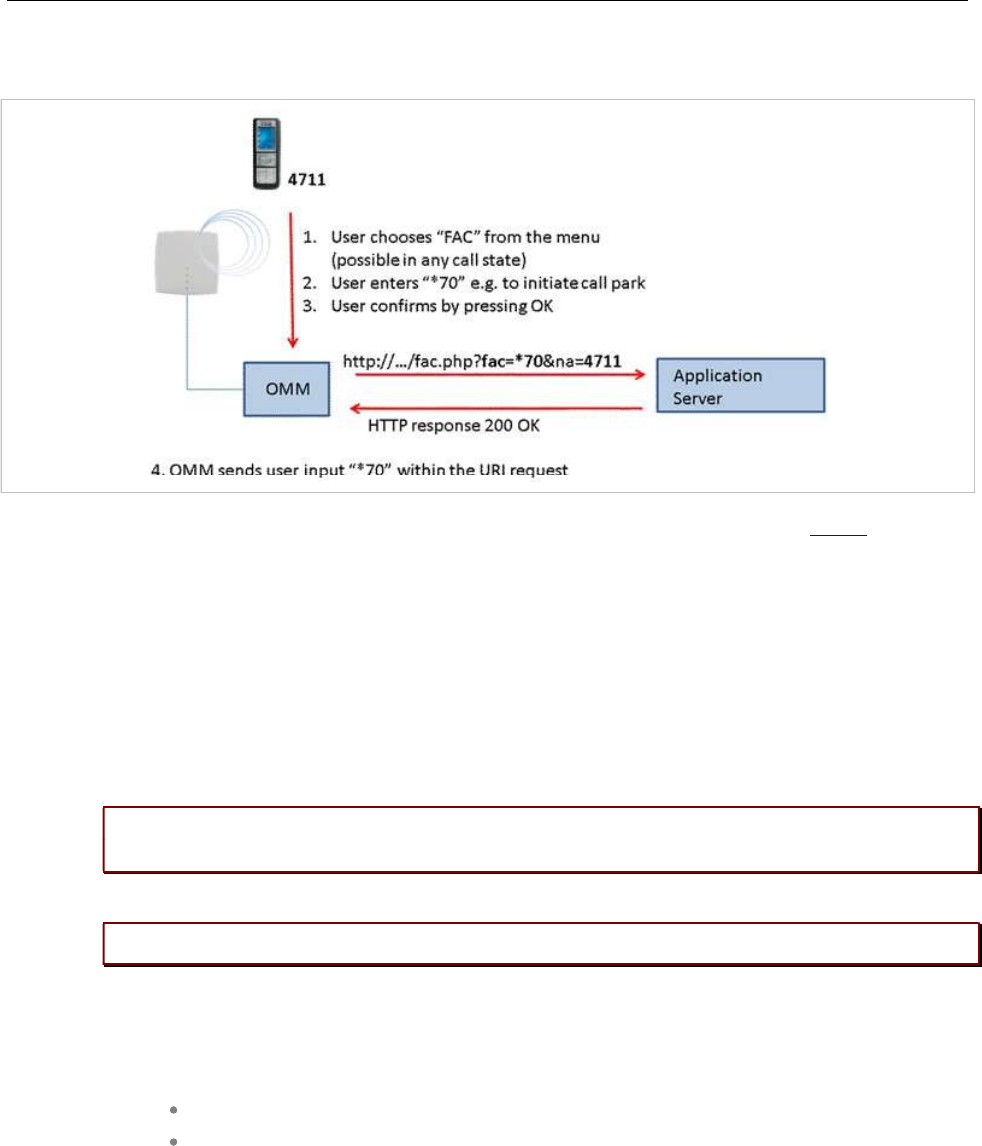
SIP-DECT OM System Manual
46
the Mitel 600 or Mitel 142d DECT phones in any call state and enter the feature code en-bloc. The input
is sent to the PBX (Application server) within a URI request.
This feature can be configured using OMP on the XML applications page (see section 6.12.8).
2.32.2 RING TONE SELECTION FOR (ALARM) MESSAGES
This feature extends the capability to set ringer tones to provide an acoustic signal to the receiver of a
message and is related to messaging configuration and management function described in the OM
Application XML Interface Specification.
In previous SIP-DECT releases, the “melody” field offered ten tones, selected by an identifier. In the
current release, the “explicitToneSelection” field allows the user to select a tone, which does not have to
belong to the set of “melody” tones, by the name string. If both are set, the explicitToneSelection value
takes precedence.
IMPORTANT : Depending on the DECT phone, not all strings may work. The string
value is not checked for correctness. Invalid or unknown string values are ignored.
Please note: The OM Message & Alerting License is required to use these features.
2.33 SOFTWARE UPDATE DISPERSION
SIP-DECT supports following 2 features to control and manage the update process in SIP-DECT
system:
Time-controlled Daily automatic reload of configuration and firmware files
Time-controlled RFP software update
A new configuration parameter Maximum delay allows a randomly spread over the given delay, when a
reload or an update starts. The additional new configuration parameter Autonomous SW update
check by OMM allows to disable the default behaviour of the RFP-OMMs to check for a new software
image, whenever a RFP re-configuration (DHCP renew, OM Configurator, ipdect.cfg, <MAC>.cfg)
happens.
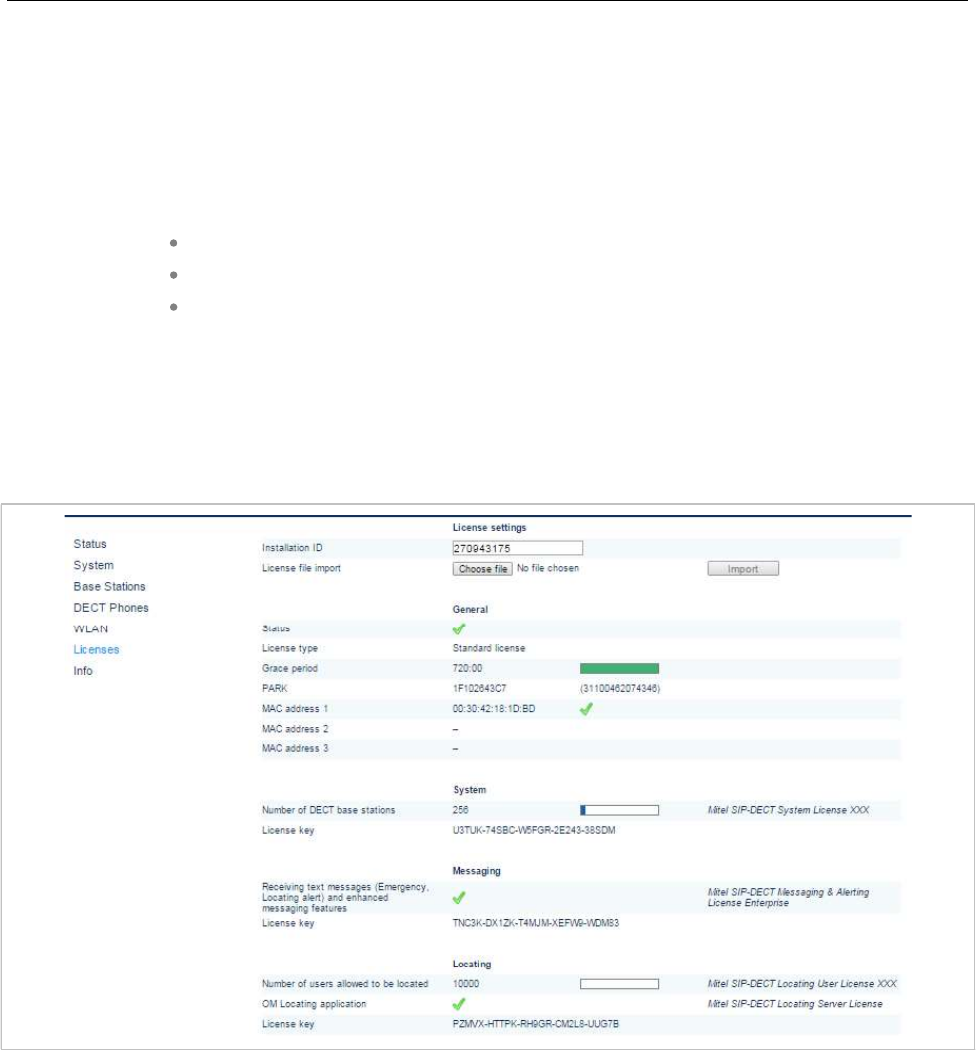
Licensing
47
3 LICENSING
3.1 LICENSING MODEL
Licenses are required based on the SIP-DECT system size and feature set. Licensed features include:
the number of configured DECT base stations
the Messaging application
the Locating application
For information on the messaging and locating applications see the appropriate documents listed in the
References section (section 10.8).
Note: A license to upgrade the SIP-DECT software to a SIP-DECT 6.0
or later is no longer required.
The License settings page in the OMM Web Service provides a summary of the SIP-DECT licenses
installed.
3.1.1 SYSTEM LICENSES
To properly address small, medium and large installations, the SIP-DECT offering is split into the
following categories, according to system size.
Note: As of SIP-DECT 6.0, no distinction is made between DECT base
station brands. License and feature rules apply equally to all
DECT base station types (standard RFP, L-RFP). Only the DECT
base station hardware determines available functionality.

SIP-DECT OM System Manual
48
Small systems – 1 .. 5 DECT base stations
No license required
Telephony and basic messaging only
No locating or enhanced messaging functionality
PARK code for up to 256 DECT base stations required for operation (provided by
the online PARK service)
Note: Existing SIP-DECT systems with up to five L-RFPs are
automatically migrated to the integrated license model. Larger
systems still require a valid license file.
Medium systems – up to 256 DECT base stations (minimum 3 DECT base stations)
OM System License required for the number of DECT base stations (10, 20, 50,
100, etc)
Licenses for Messaging and Locating can be added
PARK code for 256 DECT base stations included in license file
Large systems – up to 4,096 DECT base stations
OM System License required for the number of DECT base stations
OpenMobility Manager (core software) resides on one or two Linux-based PCs
Licenses for Enhanced Messaging and Locating can be added
PARK code for 4096 DECT base stations included
Note: With SIP-DECT Release 6.0 or later, there is no longer a
demonstration mode for the OMM.
3.1.2 ABOUT G.729 CHANNELS
With SIP-DECT Release 6.0 or later, the number of G.729 channels is no longer limited to a specific
fixed number or license. The number of G.729 channels depends only on the resources available (i.e.,
DECT base station capacity and number of base stations).
3.1.3 PARK SERVICE
A Portable Access Rights Key (PARK) is required to operate a SIP-DECT system with up to five DECT
base stations. (For systems with more than five DECT base stations, the generated license file contains
the PARK code). With SIP-DECT 6.0 or later, the PARK code is provided via a centralized Web service;
you do not need to enter the code manually (as in earlier SIP-DECT releases). A PARK for up to 256
DECT base stations is available upon request from the OMM Web service.
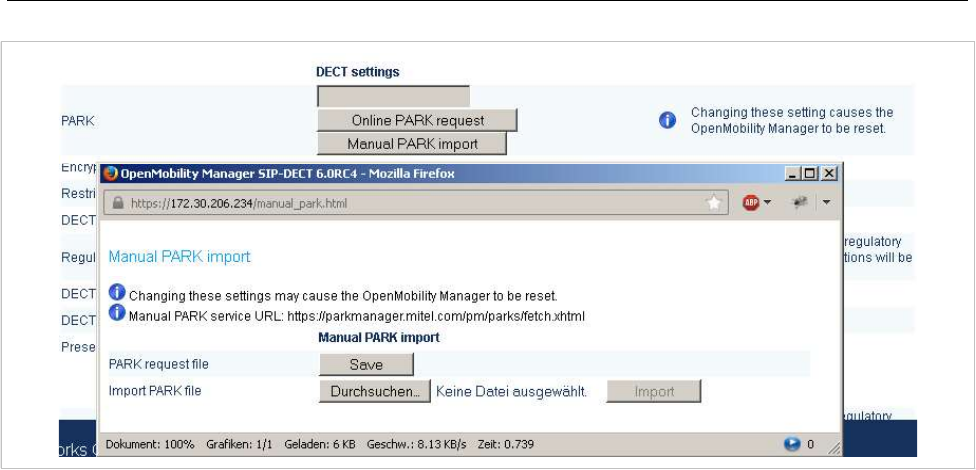
Licensing
49
You must have an internet connection to access the online PARK service. If no internet connection is
available, you can download a PARK request file from the OMM (PARK service URL is
https://parkmanager.mitel.com/pm/parks/fetch.xhtml) and upload it to the PARK server from a computer
that is connected to the Internet. You can then import the file into the OMM.
If you have a valid license file that includes a PARK, this mechanism is not necessary.
3.1.4 UPGRADE LICENSE
With SIP-DECT Release 6.0 or later, you do not require a license to upgrade to a newer release.
Older systems with an OM Activation License for L-RFPs (3..20 RFP-L) require a license upgrade, which
is available from the License server at no cost. Note that you must already have three MAC addresses
registered on the license server for the license upgrade.
3.1.5 GRACE PERIOD
The OMM identifies medium and large systems using the unique PARK as well as the MAC addresses of
up to three DECT base stations (called validation RFPs here).
Three DECT base stations guarantee redundancy when a hardware or network error occurs. An odd
number of DECT base stations prevents system duplication by splitting the system into two separate
parts.
When the first validation DECT base station is disconnected, the OMM generates a warning and displays
the message on the Status page of the OM Web service (see also section 5.3).
If the second validation DECT base station is disconnected, the OMM treats it as a license violation, and
starts the timer on a 30-day grace period. When the timer expires, the OMM restricts all licensed
features.
When the validation DECT base stations are reconnected to the OMM, the grace period is incremented
until it reaches its maximum of 30 days.
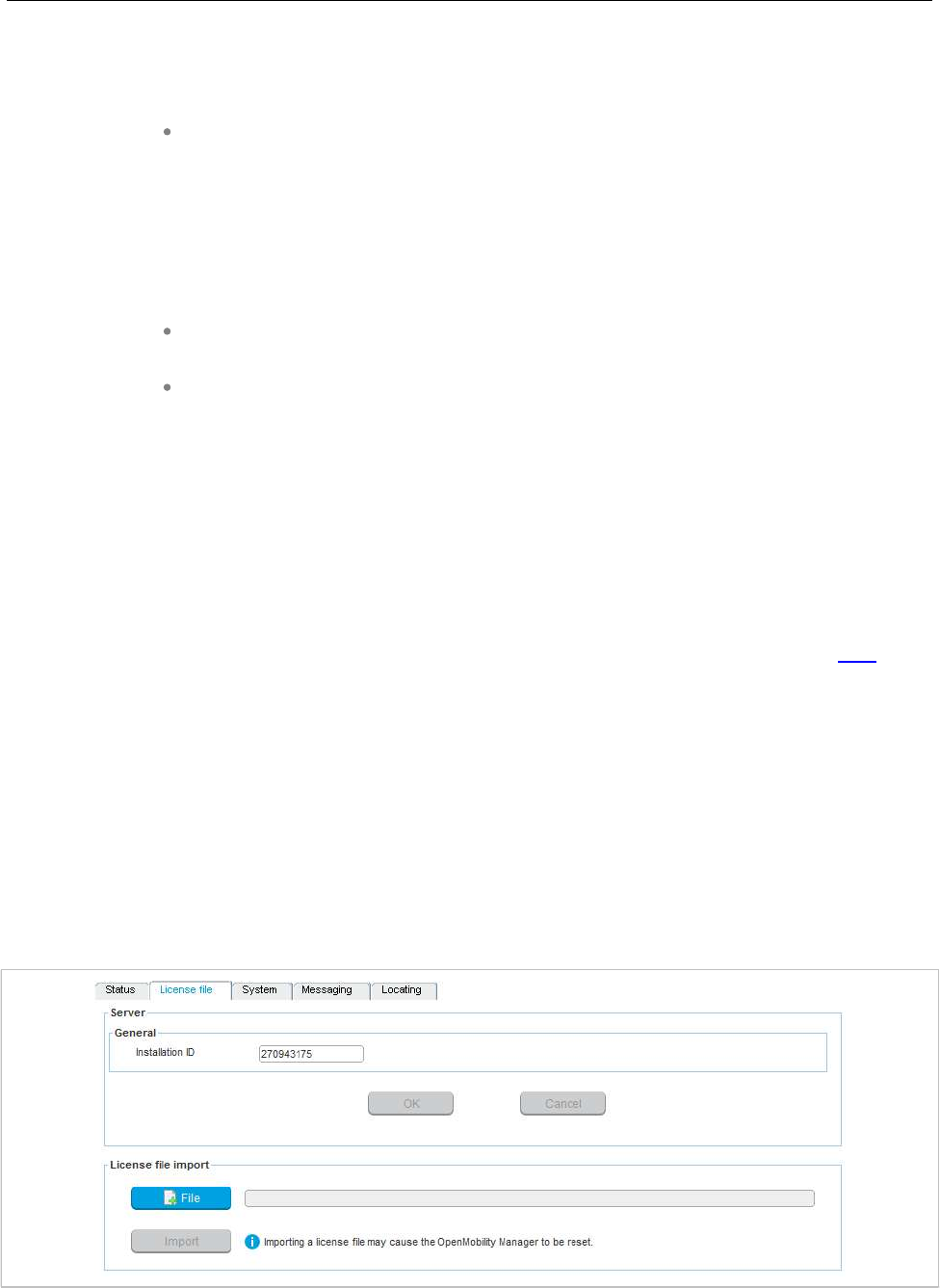
SIP-DECT OM System Manual
50
3.1.6 LICENSE VIOLATIONS AND RESTRICTIONS
A license can be violated in three ways:
The number of configured items exceeds the number of licensed items. In this case
the associated feature is restricted:
– the audio stream of calls is dropped after 30 seconds when the number of
connected DECT base stations exceeds the licensed number
– the messaging application limits the type of messages to “info”, “low”, “normal”
and “high”
– the locating feature is stopped
For SIP-DECT 5.0 (or older) systems, the software version in the license file does
not match the software version running on the OMM.
The OMM has no connection to at least two of the validation DECT base stations
and the grace period has expired.
The restrictions above are in place until at least two validation DECT base stations are reconnected to
the OMM.
3.2 UPLOADING A LICENSE FILE
A license file must be generated on the Mitel license server. The license confirmation provided when you
order your system contains detailed information on how to generate the license file. The file can be
uploaded into the OMM either via Web service (see section 5.10) or via the OMP (see section 6.13).
A license file contains a PARK for system identification. If the newly imported PARK differs from the
current PARK, the OMM performs a restart. In this case, all existing DECT phone subscriptions will be
deleted.
Note: The file can be opened with a text editor to view the license or
activation parameter.
The license file includes an installation ID. This ID prevents the administrator from loading the wrong
license file with a different PARK (resulting in all DECT phones being unsubscribed). The download page
for the license file displays the installation ID. If no Installation ID is configured (value 0, which is the
default), the ID is automatically set while loading the license file. If the ID does not fit to the license file,
the license file import will fail. The installation ID does not change when you load a new license file from
the license server, unless the PARK has changed.

Licensing
51
The SIP-DECT license file format prepares the system for receiving licenses from Mitel PBXs or to act as
a license key server for other Mitel products in future releases.
Please note: New license files (as of SIP-DECT 5.0) are not compatible with previous
versions of SIP-DECT systems (SIP –DECT 2.1 – 4.0).
3.3 LICENSE MODELS
3.3.1 SMALL SYSTEM (UNLICENSED)
When changing the PARK on the System settings page of the OM Web service, the OMM uses the
built-in license resp. the standard license for a small system.
The built-in license for small system features:
up to five DECT base stations
– standard telephony
– sending messages from DECT phones for all users
– no locating
Messaging features are generally restricted to type “Info”, “Low”, “Normal” and
“High” for all users (no “Emergency” and no “Locating Alert”).
When there are more than five DECT base stations configured, only the first five base stations stay in
the configuration database. All other base stations are dropped silently.
3.3.2 MEDIUM OR LARGE SYSTEM
When the PARK is set through the upload of a license file, the OMM enters the licensed state. In this
state the OMM uses the following license features coded into the license file.
System license (Medium):
– Three and up to 256 base stations
System license (Large):
– Three and up to 4096 base stations
– Software version of the OMM allowed to be executed
– Messaging license:
– Whether clients are allowed to receive alarm messages or have enhanced
messaging options
Locating license:
– Number of locatable DECT phones
– Whether the locating application is allowed to execute
When you generate a license file from the license server, you must enter the MAC address of three base
stations. These three validation base stations are used to operate the grace period as described in
section 3.1.5.
When obtaining the license file from the license server, it is possible to use the PARK used for a small or
medium system installation. This prevents the need to re-subscribe all DECT phones.

SIP-DECT OM System Manual
52
Note: As of SIP-DECT 6.0, the PARK can no longer be changed
manually on the System settings page of the OM Web service.

Getting Started
53
4 GETTING STARTED
The following example describes the steps required for a minimal SIP-DECT configuration.
4.1 BASE STATION STARTUP CONFIGURATION
Start up information for each DECT base station needs to be provided by DHCP or OM Configurator.
To use DHCP, specific vendor options must be configured in the DHCP Server for SIP-DECT (see
section 8.5.4.1).
In this example, the OM Configurator is used to provide a static IP Configuration to the RFPs.
1Connect the DECT base station(s) to your LAN and power up the units.
2Open the OM Configurator and select your network interface via the General -> Options menu.
3Click Scan to find the base stations connected to your LAN (enter user name and password: “omm” /
”omm” for initial configuration until start-up)
4Select a base station entry and double-click for configuration.
5Enter the configuration parameters for the base station. For configuration details, see section 8.7.
6Click OK when you have entered configuration parameters.
7Click Send Configuration to apply the configuration to the DECT base station.
8To configure the next unit, select another base station entry from the table, set the appropriate
parameters (and confirm with OK), and click Send Configuration.
Note: The OM Configurator requires the Java Runtime Environment
version 1.7 or higher.
4.2 SYSTEM CONFIGURATION
As soon as the OMM starts up, open a browser and connect (https://<IP_address>). Login with the user:
omm and password: omm for the initial configuration.
The OMM forces you to change the login, which then also applies to the OM Configurator.
The OMM Web service provides basic parameters to setup the system, which is sufficient for this
example scenario. To configure the OMM in detail, use the OM Management Portal (OMP). This
application requires a current Java 1.7 to run and supports detailed OMM configuration and monitoring.
The OMM Web service provides a link to run the OMP application via Java Web start.
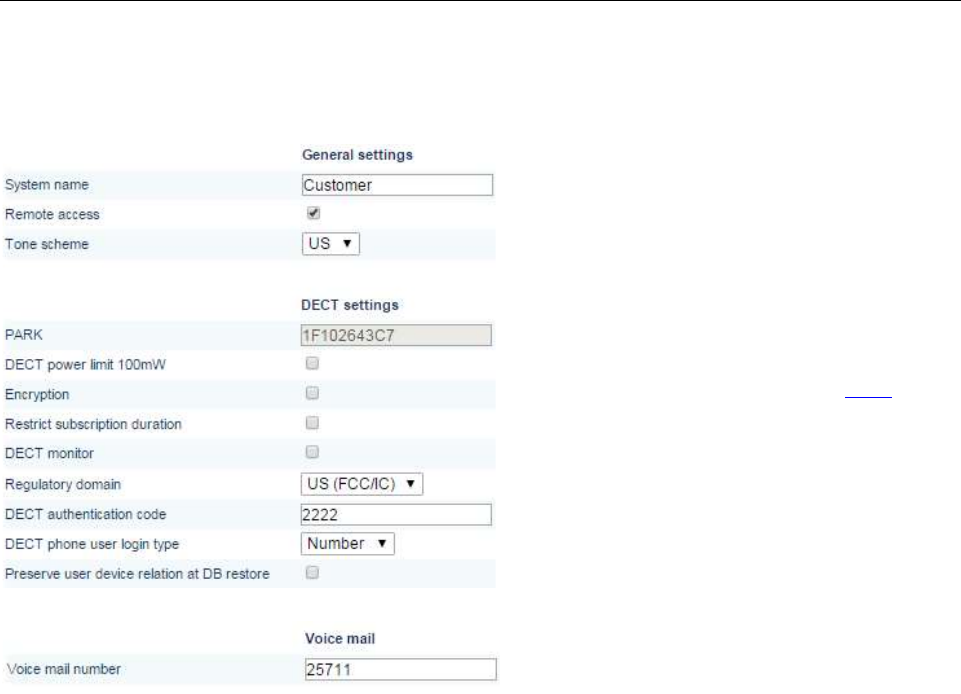
SIP-DECT OM System Manual
54
4.3 SYSTEM SETTINGS
The OMM System settings menu provides the basic settings to operate the SIP-DECT system.
System name: Customer Name
Remote access: Allow SSH access
Tone Scheme: Scheme to simulate call
control tones (country-dependent).
PARK: The system needs a PARK code to
operate. Use the Online PARK service to
obtain a PARK code (see section 3.1.3) (five
or more RFP systems).
Regulatory domain: DECT regulatory
domain applicable to your local region.
DECT authentication code: Define as
template for the subscription of new DECT
phones.
Voice mail number: Your system voicemail
number. A Mitel 600 phone will then offer the
voice box in the Handset menu.
4.4 BASE STATIONS
Configure all base stations (formerly referred to as Radio Fixed Parts) from the Base Stations menu
(including the OMM DECT base stations).
When you click on the Start button below the “Capturing unconfigured DECT base stations” caption, the
OMM lists all DECT base stations trying to connect.
Click on New to configure a new base station.
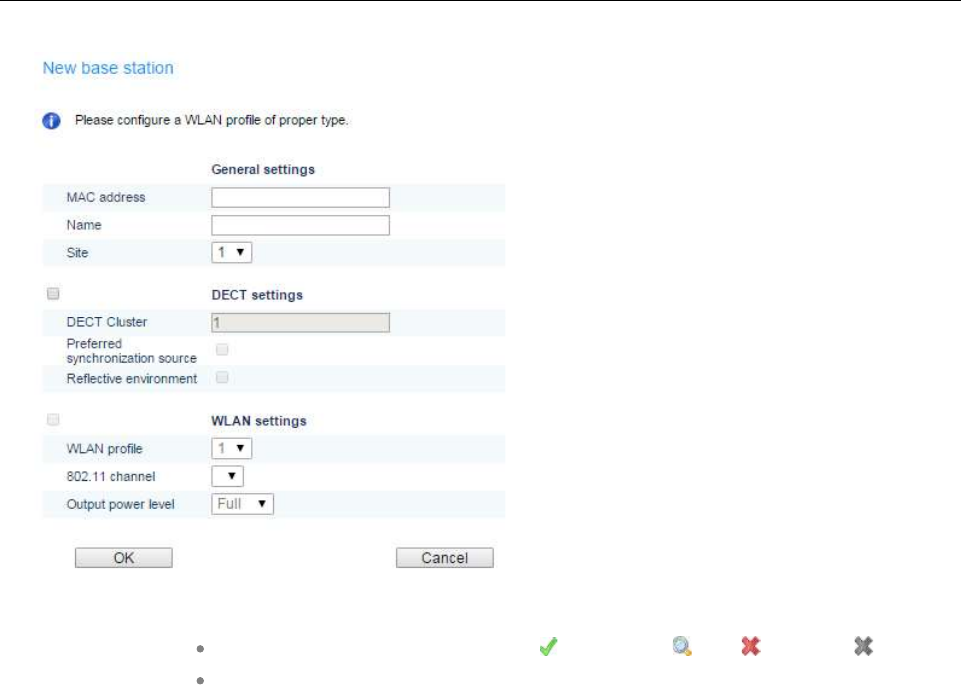
Getting Started
55
The base station configuration requires:
- base station MAC address
- Name e.g. location
- Site (default: 1)
- DECT active
- DECT cluster (default: 1)
The Status for each DECT base station is shown in the Base Stations section.
Active: DECT Radio State (Active , Searching , Off , disabled / - )
Connected: DECT base station is connected to the OMM, DECT base station
must be configured first.
4.5 SIP SETTINGS
Configure the SIP connection to the call server that the OMM must connect to in the OMM System ->
SIP menu. Make sure the Advanced checkbox in the top bar is enabled.
The SIP user account (SIP-ID, Auth, and password) configuration is part of the DECT Phones
configuration.
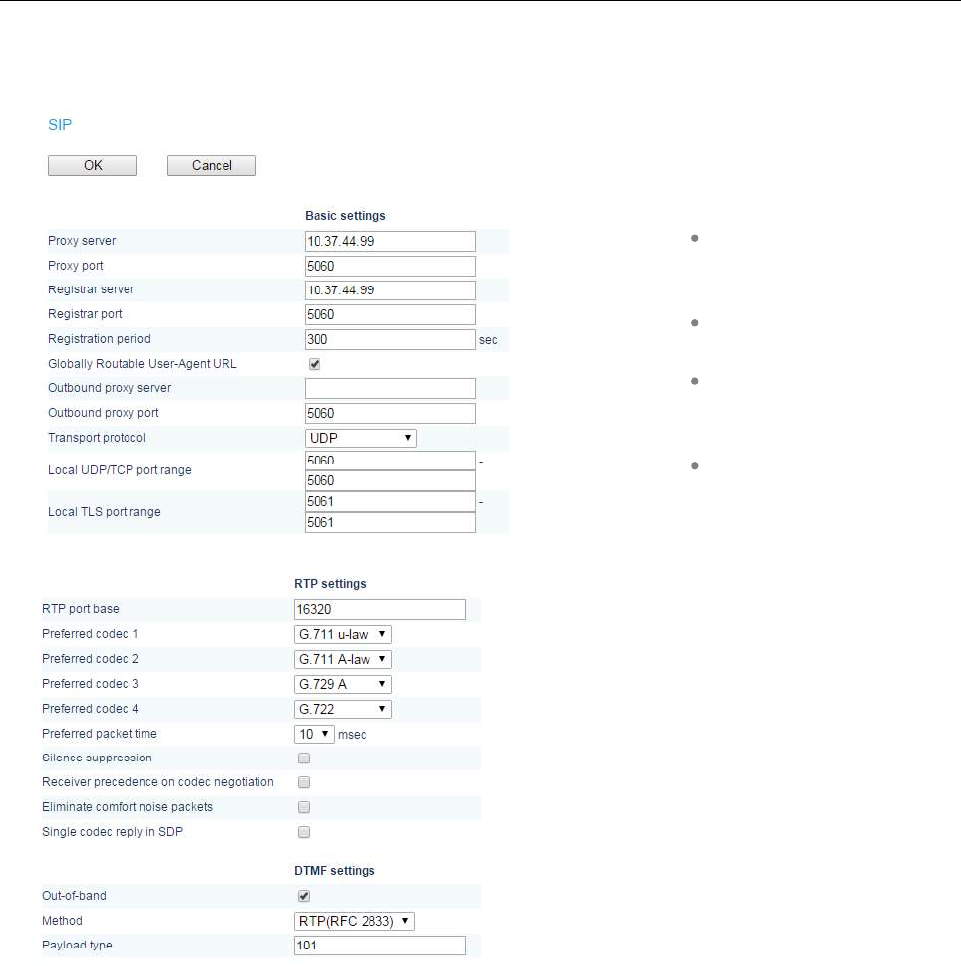
SIP-DECT OM System Manual
56
The default SIP signaling port for SIP-DECT is 5060 / UDP. Change if this is required by the SIP Server.
Enter values for the following:
Proxy Server:
PBX IP or DNS
Name
Proxy Port:
5060
Registration
Server: PBX IP
or DNS Name
Registration
Port: 5060
Use the default RTP settings unless
your installation requires a different
configuration.
Use the default DTMF settings
unless your installation requires a
different configuration.
4.6 DECT PHONES
SIP-DECT allows multiple configuration and provisioning methods for DECT phones. In this example we
use fixed DECT phones. A SIP-extension must be configured for each DECT phone (user) on the SIP
call server.
To add a new DECT phone, go to the DECT Phones menu (ensure the Advanced option in the top bar
is enabled) and click New.
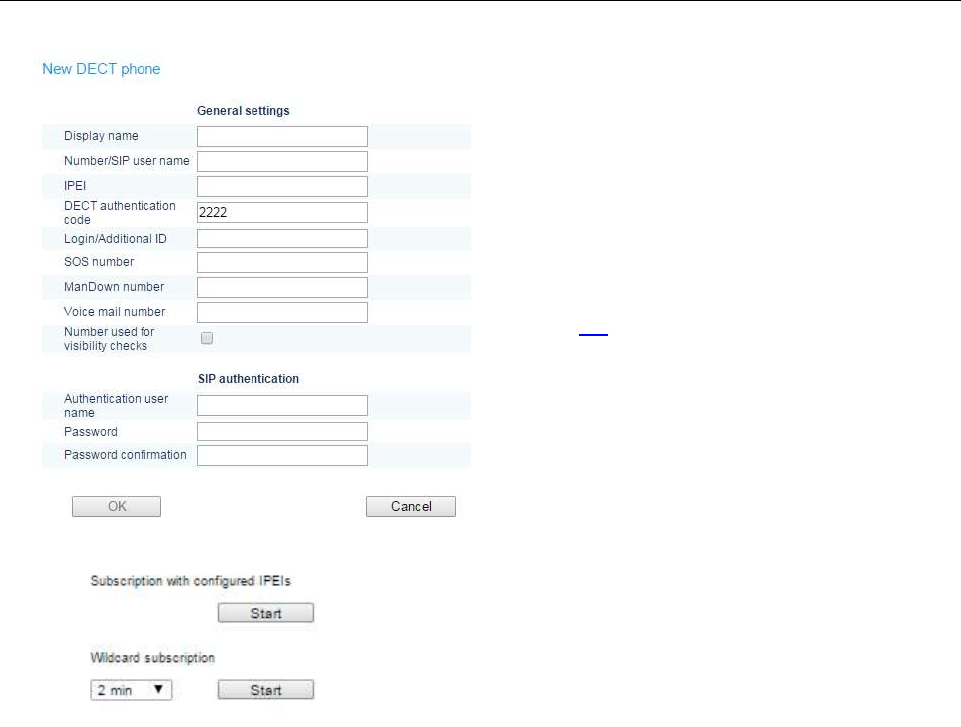
Getting Started
57
Enter values for the following:
Display name: Extension Name
Number/SIP user name: SIP-ID e.g. terminal
phone number
IPEI: Handset hardware identifier (optional)
DECT authentication code: Code for Handset
subscription. If this field is left empty, the system-
wide DECT authentication code is used (see
section 4.3).
Authentication user name: SIP user name
Password: SIP Extension password
To subscribe new DECT phones, subscriptions
must be permitted by the OMM.
Use Wildcard subscription if no IPEI is set.
To subscribe new Mitel 600 DECT phones, open the DECT phone System >Subscriptions menu.
Select New system and enter the Authentication code provided in your System Settings (e.g. 123456).
The DECT phone prompts you to enter a PARK or to proceed with the subscription without a PARK.
Set the PARK if several DECT systems are around, otherwise the DECT phone tries to subscribe to the
first available DECT system.
4.6.1 DECT PHONE AND SIP STATE VERIFICATION
You can check the DECT phone state and SIP registration status from the DECT Phones page.
Click on the magnifying glass icon beside the entry for the DECT phone you just created to view details
on the SIP registration status.
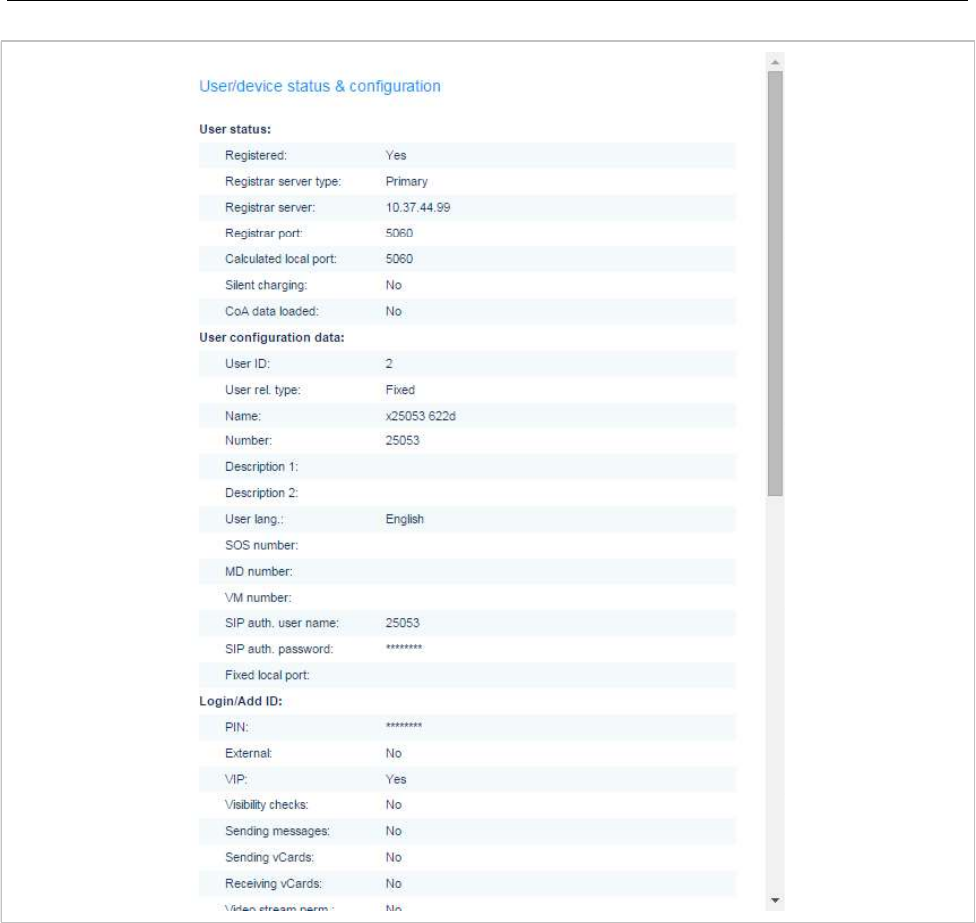
SIP-DECT OM System Manual
58
Switch the DECT phone off / on to force SIP user registrations.
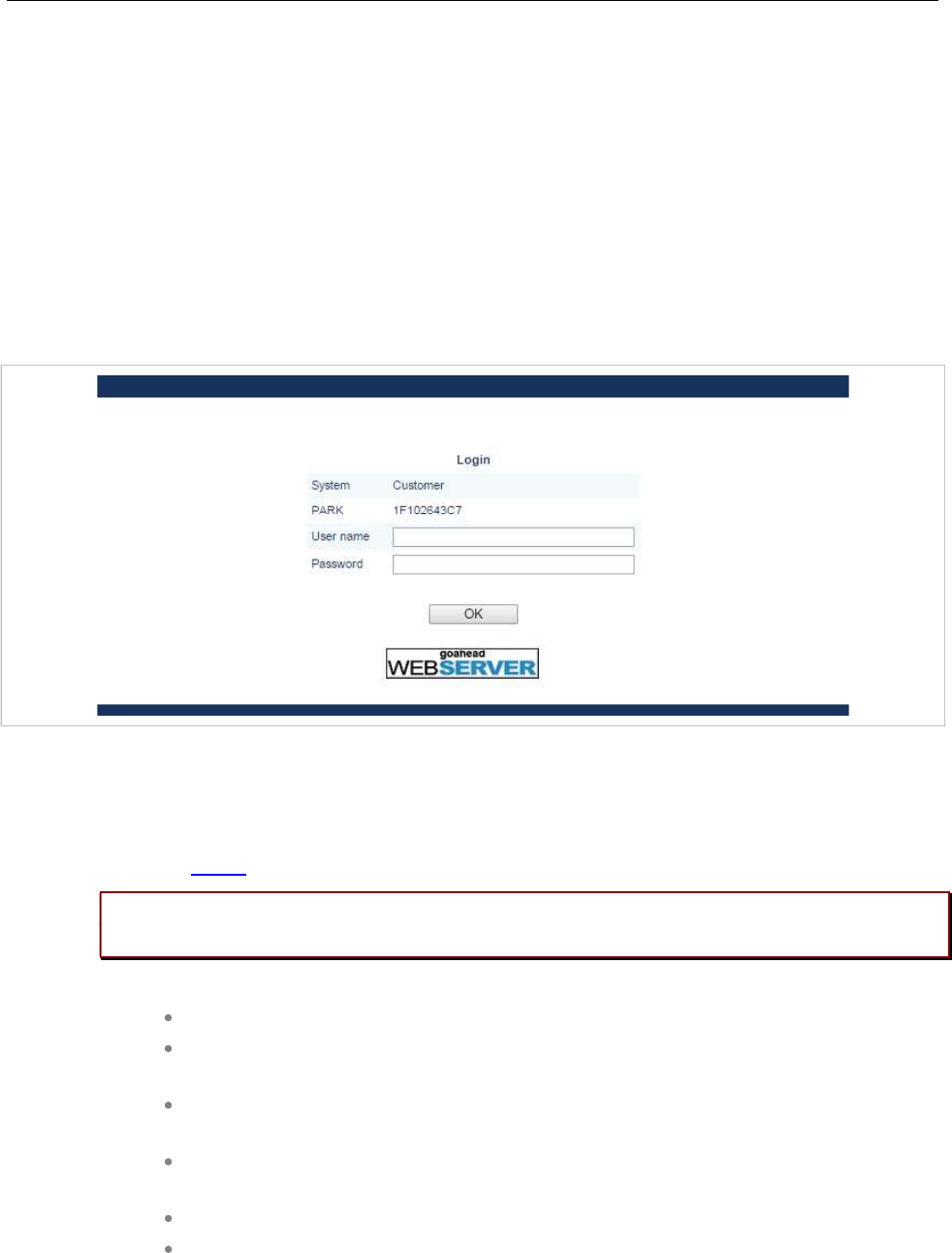
OMM Web Service
59
5 OMM WEB SERVICE
The OMM acts as an HTTP/HTTPS server. The HTTP server binds to port 80 and HTTPS binds to port
443 by default. A HTTP request on port 80 will be redirected to HTTPS on port 443.
5.1 LOGIN
The OMM allows more than one user at a time to configure the system. A user must authenticate with a
user name and a password. Both strings are case-sensitive.
With initial installation, or after discarding all settings, the OMM Web service is accessible via a default
built-in user account with user “omm” and password “omm”.
With the first login to a new SIP-DECT software version, the user must accept the End User License
Agreement (EULA) (see section 5.11).
If the default built-in user account is active, the administrator must change the default account data
(passwords) of the “Full access” and “root” account. The meaning of the different account types is
described in section 8.17.1.
Please note: The OMM forces a change to the default account data. As long as the
passwords are unchanged, the OMM will not allow any other configuration.
After login in, the following menus are available (with the Advanced option enabled in the top bar):
Status menu: Displays the system status (see section 5.3).
System menu: Allows configuration of general SIP-DECT system parameters (see
section 5.4).
Sites menu: Allows grouping of DECT base stations into different sites (see section
5.5).
Base Stations menu: Allows configuration and administration of the attached base
stations (see section 5.6).
DECT Phones menu: Allows administration of the DECT phones (see section 5.7).
WLAN menu: Allows configuration of WLAN parameters (see section 5.8).
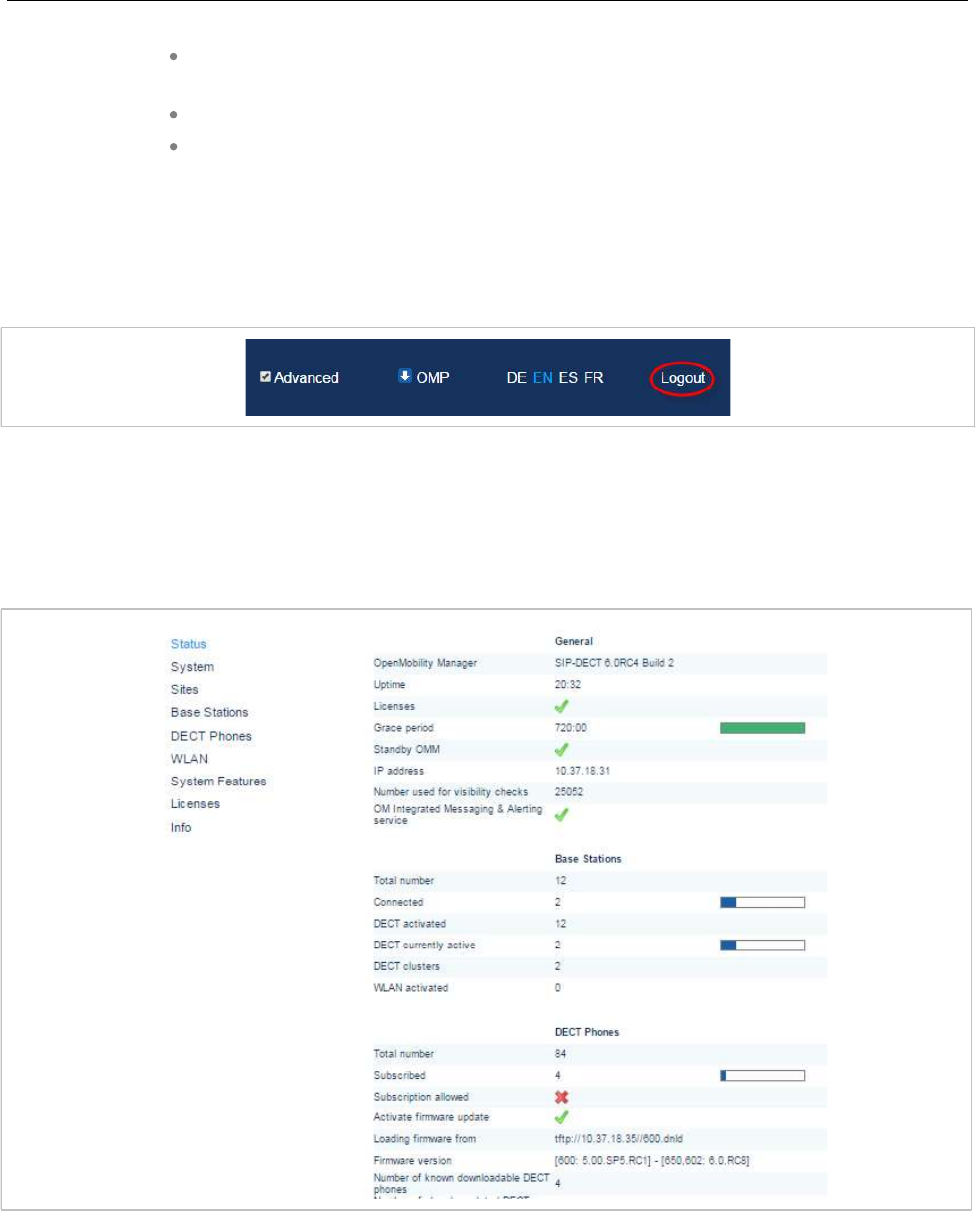
SIP-DECT OM System Manual
60
System Features menu: Allows administration of system features like digit
treatment and directory (see section 5.9).
Licenses menu: Allows administration of licenses (see section 5.10).
Info menu: Displays the End User License Agreement (EULA) (see section 5.11).
5.2 LOGOUT
If no user action takes place, the OMM automatically logs the user out after 5 minutes. To log out from
the system, click the Logout button on the upper right of the OM Web service screen.
5.3 “STATUS” MENU
The Status page provides information on the SIP-DECT system status. In case of system errors, system
warning messages are also displayed on this page.
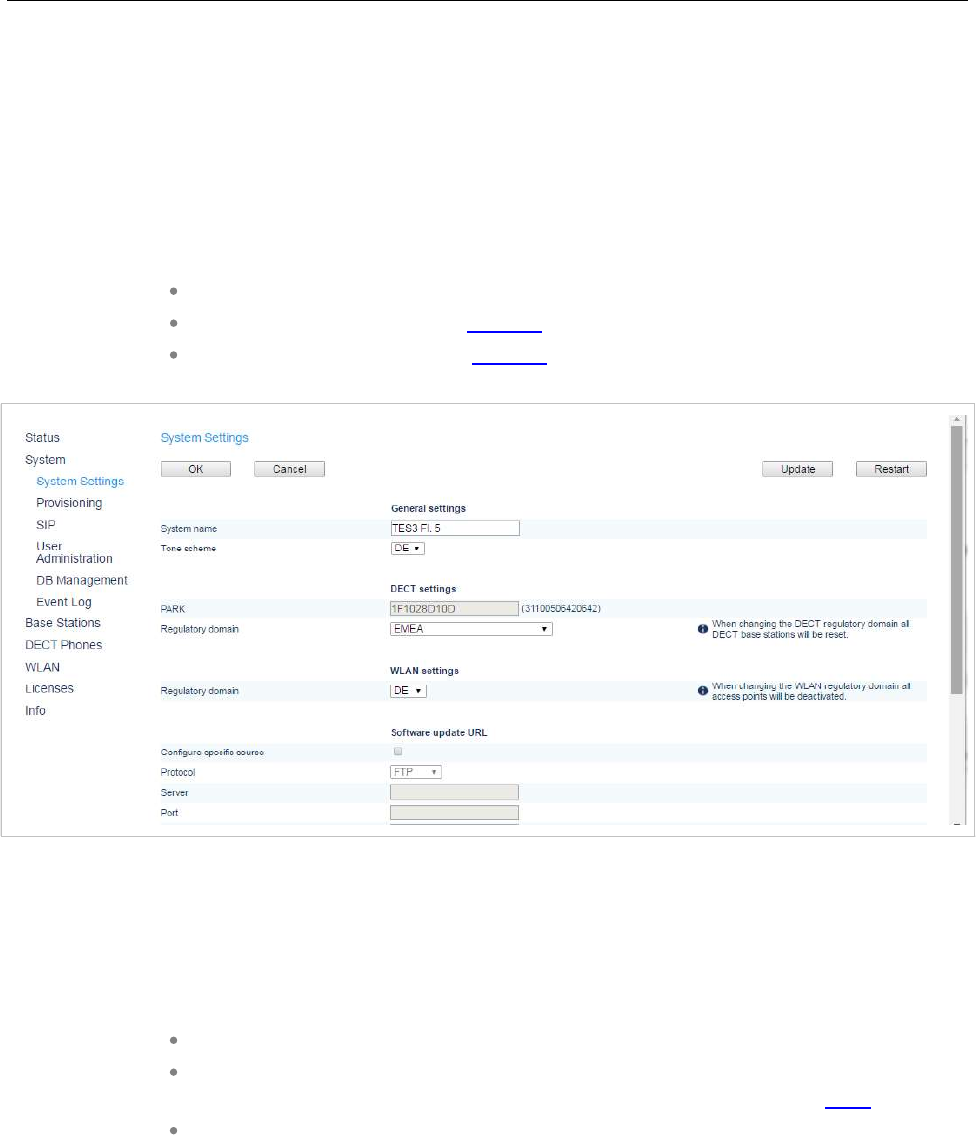
OMM Web Service
61
5.4 “SYSTEM” MENU
The System menu comprises general parameters to configure and administer the system parameters of
the SIP-DECT solution.
5.4.1 “SYSTEM SETTINGS” MENU
The System settings cover global settings for the OpenMobility Manager. You can perform the following
tasks from the System Settings menu:
configure global settings (see the following sub-sections)
restart the OMM (see section 5.4.1.17)
update the OMM (see section 5.4.1.18)
The following sections describe the parameters that can be set.
Note: The following information describes all parameters visible when
the Advanced option (in the top bar) is enabled.
5.4.1.1General settings
System Name: Enter the system name.
Remote Access: Switches on/off the SSH access to all DECT base stations of the
DECT system. For more information on the SSH access see section 9.3.5.
Tone scheme: Select the country in which the OMM resides. This enables country
specific tones (busy tone, dial tone, etc).

SIP-DECT OM System Manual
62
5.4.1.2DECT settings
PARK: This setting depends on the licensing mode. Small systems: Enter the PARK
code obtained from the PARK service (see section 3.1.3). License file: Shows the
PARK included in the license file.
DECT power limit 100mW: Limits the DECT base station transmit power to 100mW,
independent of the selected regulatory domain. Enable for SIP-DECT installations
that are mobile (e.g., on cruise liners that travel between countries). See section
2.12 for more information on this feature.
Encryption: Activate this option if you want to enable DECT encryption for the
whole system.
Please note: Make sure that all deployed third party DECT phones support DECT
encryption. If not, encryption can be disabled per DECT phone (see 6.10.4).
Restrict subscription duration: Activate this option if you want to restrict the
duration for DECT phone subscriptions to 2 minutes after subscription activation.
This option is not useful in case that you want to subscribe more than one DECT
phone at a time or together with auto-create on subscription. It should be activated
exclusively in case that there is a special need.
DECT monitor: For monitoring the DECT system behavior of the OpenMobility
Manager, the separate DECT monitor application exists. This tool needs an access
to the OpenMobility Manager which is disabled by default and can be enabled here.
Because of security, the DECT monitor flag is not stored permanently in the internal
flash memory of the OMM/DECT base station. After a reset, the DECT monitor flag
is ever disabled.
Regulatory domain: Specifies where the IP DECT is used. Supported regulatory
domains are:
– EMEA
– US (FCC/IC)
– Brazil
– Taiwan
– South America (Radio 1910-1927Mhz 250mW)
Note that 3rd and 4th generation DECT base stations support different DECT frequencies. These
devices can operate in different regulatory domains provided that the Regulatory domain setting is
configured accordingly.
For older 2nd generation DECT base stations, there are different DECT base station models to meet
different regulatory domain demands. To setup a North American FCC compliant DECT base station,
the value must be set to US (FCC/IC). In a North American US (FCC/IC) deployment, ETSI compliant
DECT base stations are made inactive and cannot be activated if the regulatory domain is set to
US (FCC/IC). The reverse is also true.
WARNING: Note that selecting the incorrect regulatory domain may result in a violation of
applicable laws in your country.
Note: Whenever you modify the regulatory domain, a warning is
displayed. You must confirm it first to apply the changed setting.

OMM Web Service
63
DECT authentication code: The authentication code is used during initial DECT
phone subscription as a security option. A code entered here provides a system-
wide DECT authentication code for each DECT phone subscription. Alternatively, a
DECT phone-specific authentication code can be set (see section 5.7.1).
DECT phone user login type: Specifies the system-wide variant for DECT phone
login method. Two kinds of login types are supported: the user can either be
determined by the telephone number (Number) or by the unique user login ID
(Login ID). Both elements are part of each user data set.
Note: Changing this setting forces an automatic logout of all logged in
DECT phones.
In case, the OMM works within a system along with MOM or
UDS, this will happen in all OMMs of this system.
Preserve user device relation at DB restore: Enables the preservation of the user
– DECT phone association with an OMM database restore. This option is only
applicable for database snapshots from SIP-DECT 6.0 or later.
Note: If you want to restore the association, enable this option
BEFORE uploading a database for an OMM restore. The current
OMM value is used, not the setting in the database being
uploaded.
5.4.1.3 WLAN settings
This setting applies to RFP 42/43/48 WLAN base stations.
Regulatory domain: Select the regulatory domain of the WLAN network. This
setting depends on the country and is prescribed by the laws of that country. Only
the setting prescribed for that country must be used. For more information on the
WLAN settings see the sections 5.8 and 8.18.
WARNING: Please note that selecting the incorrect regulatory domain may result in a violation
of applicable law in your country!
Note: Whenever you modify the regulatory domain, a warning is
displayed. You must confirm it first to apply the changed setting.
Please note: If you upgrade a system to release 3.0 or higher, you must configure the
appropriate regulatory domain.
5.4.1.4DECT base stations update
Mode: DECT base station update mode – “One by one” (every single DECT base
stations is updated separately) or “All at once” (all DECT base stations are updated
in one step).

SIP-DECT OM System Manual
64
Trigger: When this option is selected, the DECT base station update is time-
controlled.
Time: Time for time controlled updates.
5.4.1.5 Maximum delay
This parameter specifies the maximum time (in minutes) and the OMM waits past the schedule time
before starting the update process.
5.4.1.6 Calculated time of delay
The calculated time for scheduled update (24h time format). This parameter is read-only and is
calculated by the OMM based on given “Time of Day” and “Maximum Delay”.
5.4.1.7OMP web start
Configure specific source: Enables the specific URL to an external file server for
retrieving the OMP jar file.
Protocol: Specifies the protocol used to retrieve the OMP file.
Server: Specifies the IP address or name of the external file server.
Port: Specifies the port of the external file server.
Path: Specifies the location of the OMP jar file on the external file server.
5.4.1.8 DECT phone’s firmware update
With SIP-DECT 6.0 or later, the DECT base station software images (iprfp3G.dnld and iprfp4G.dnld)
contains the Mitel 600 DECT phone software. For specific maintenance purposes only, you can configure
a URL to use an alternative DECT phone software image. The Mitel 600 DECT phone firmware packages
are delivered in the “600.dnld” file for the OMM running on a DECT base station.
Activate firmware update: Enables or disables the “Download over Air” feature.
The OMM provides a DECT phone firmware update over the air when this feature is
activated. For more information on, see section 8.22.
Configure specific source: Enables the specific URL to an external file server for
retrieving the DECT phone firmware file.
Protocol: Specifies the protocol used to retrieve the firmware file from the external
server.
Server: Specifies the IP address or name of the external file server.
Port: Specifies the port of the external file server.
User name: Specifies the user name to authenticate on the external file server.
Password: Specifies the password to authenticate on the external file server.
Password confirmation: Confirms the password to authenticate on the external file
server.
Path: Specifies the location of the firmware file on the external file server.

OMM Web Service
65
Use common certificate configuration: Enables the use of the system-wide
certificate validation settings for this URL, as configured on the System ->
Provisioning -> Certificates page (see section 5.4.2).
5.4.1.9 Voice mail
Voice mail number: Specifies a system-wide voice mail number. This number is
used by the Mitel 600 DECT phone family if the voice box is called.
5.4.1.10 OM Integrated Messaging & Alerting service
The OpenMobility Manager provides an integrated message and alarm service. The Internal message
routing (DECT phone <> DECT phone) can be activated/deactivated. For a detailed description, see
/28/.
Internal message routing (phone <> phone): Enables or disables internal
messaging between DECT phones.
Configure specific destination: Enables the specific URL to an external file server
for retrieving the IMA configuration file.
Protocol: Specifies the protocol used to retrieve the IMA configuration file from the
external server.
Server: Specifies the IP address or name of the external file server.
Port: Specifies the port of the external file server.
User name: Specifies the user name to authenticate on the external file server.
Password: Specifies the password to authenticate on the external file server.
Password confirmation: Confirms the password to authenticate on the external file
server.
Path & filename: Specifies the location and file name of the IMA configuration file
on the external file server.
Use common certificate configuration: Enables the use of the system-wide
certificate validation settings for this URL, as configured on the System ->
Provisioning -> Certificates page (see section 5.4.2).
5.4.1.11 Syslog
The OMM and the DECT base stations are capable of propagating syslog messages.
Active: Enables or disables collection of syslog messages.
IP address: Address of the host that should collect the syslog messages.
Port: Port of the host that should collect the syslog messages.
Forward OMM Messages to syslog: (Visible only on a PC-hosted OMM system)
Enables/disables forwarding of syslog messages from the PC-hosted OMM.

SIP-DECT OM System Manual
66
5.4.1.12 Software update URL
With SIP-DECT 6.0 or later, DECT base stations in small SIP-DECT systems (~10 RFPs) can obtain
their software image from the DECT base station hosting the OMM, if they have no valid URL from which
to load their software (see section 8.9.3 for information on URL syntax). If the OMM is running on a
DECT base station, the OMM DECT base station delivers the software to the connected DECT base
stations.
The new software image for the OMM DECT base station can be provided as an iprfp3G.dnld and
iprfp4G.dnld file on an external file server. You configure the URL for the software image in this section.
Configure specific source: Enables the specific URL for downloading the
iprfp3G.dnld file (as opposed to the ConfigURL, which points to an external file
server for all configuration and resource files).
Protocol: Specifies the protocol used to fetch the software image file.
Port: Specifies the port of the external file server.
Server: Specifies the IP address or name of the external file server.
User name: Specifies the user name to authenticate on the external file server.
Password: Specifies the password to authenticate on the external file server.
Password confirmation: Confirms the password to authenticate on the external file
server.
Path: Specifies the location of the software image file on the external file server.
Use common certificate configuration: Enables the use of the system-wide
certificate validation settings for this URL, as configured on the System ->
Provisioning -> Certificates page (see section 5.4.2).
5.4.1.13 System dump
A system dump is a file that holds information about the OpenMobility Manager and all connected DECT
base stations. With the Remote System Dump feature, a system dump is transferred to a remote server.
You can configure a specific destination, otherwise the system ConfigURL is used. The system dump is
generated manually by pressing the Dump button or automatically at the specified time.
Please ensure that the fileserver used allows writing or creation of system dumps.
Trigger: Enables the automatic generation of a system dump time every day at the
time specified in the Time field.
Time: The time of day the system automatically generates a system dump file (only
activated if the Trigger checkbox is enabled).
Dump: Immediately triggers the generation of a system dump file.
Configure specific source: Enables the specific URL for transferring the system
dump file (as opposed to the ConfigURL, which points to an external file server for
all configuration and resource files).
Protocol: Specifies the protocol used to transfer the system dump file.
Port: Specifies the port of the external file server.
Server: Specifies the IP address or name of the external file server.
User name: Specifies the user name to authenticate on the external file server.

OMM Web Service
67
Password: Specifies the password to authenticate on the external file server.
Password confirmation: Confirms the password to authenticate on the external file
server.
Path: Specifies where the system dump file is stored on the external file server.
Use common certificate configuration: Enables the use of the system-wide
certificate validation settings for this URL, as configured on the System ->
Provisioning -> Certificates page (see section 5.4.2).
5.4.1.14 Core dump URL
Fatal software problems may result in memory dumps, in core files. The DECT base station can transfer
the core files to a remote fileserver. With SIP-DECT 6.0 or later, you can configure a specific URL to an
external file server where core dump files should be transferred and stored. The Core dump URL is used
by each DECT base station connected to the OMM.
Without a configured Core dump URL, whether and where core files are transferred is dependent on
specific DECT base station settings. Without any special configuration, the files are transferred to the
server that is used to retrieve the system software (i.e., the directory of the boot image).
Configure specific destination: Enables the specific URL to an external file server
for transferring and storing core files.
Protocol: Specifies the protocol used to transfer the core files.
Server: Specifies the IP address or name of the external file server.
Port: Specifies the port of the external file server.
Path: Specifies the location of the core files on the external file server.
5.4.1.15 Net parameters
To allow the prioritization of Voice Packets and/or Signaling Packets (SIP) inside the used network the IP
parameter ToS (Type of Service) should be configured.
ToS for voice packets: Determines the type of service (ToS resp. DiffServ) byte of
the IP packet header for all packets that transport RTP voice streams.
ToS for signalling packets: Determines the type of service (ToS resp. DiffServ)
byte of the IP packet header for all packets related to VoIP signaling.
TTL (Time to live): Determines the maximum hop count for all IP packets.
5.4.1.16 Date and time
If OMM DECT base stations start an SNTP client, the date and time of the configured time zone is
synchronized with the Mitel DECT 142 / Mitel 142d and Mitel 600 DECT phones. The date and time will
be provided by the OMM to these DECT phones if they initiate a DECT location registration. The rules
for a time zone can be configured in the Time zones menu (see section 5.4.5).
NTP server: The NTP servers used for time synchronization.

SIP-DECT OM System Manual
68
Time zone: Specifies the time zone in which the OMM is operating. This feature is
exclusively available on the OMM DECT base station. On PC-OMM configurations,
the PC time and time zone is used.
5.4.1.17 Restarting the OMM
You can restart the OMM by clicking on the Restart button in the top right corner of the System
Settings page.
1Click on the Restart button.
The Restart dialog window opens.
2In the Restart dialog window, set the following options:
Discard OMM DB and configuration files: Specifies whether OMM database and
configuration data is removed from the DECT base station, including the data
retrieved from RCS. Local IP configuration remains unaffected. This parameter is
only available on an OMM DECT base station.
Reset OMM RFP(s) to factory defaults: Specifies whether all data is removed from
the DECT BASE STATION including the OMM database, configuration files and
local IP configuration.
Note: Both options also affect the standby OMM.
3Click OK.
A Restart web page opens and displays a progress bar. The login page is loaded automatically if the
OMM is reachable again.
5.4.1.18 Updating the OMM
An Update button is available on the System settings web page. Pressing the Update button forces the
DECT base stations to check for new software and initiates the software update. For more details about
updating the OMM, see the section 8.14.
5.4.2 ”PROVISIONING” MENU
SIP-DECT supports provisioning through external configuration files. With SIP-DECT 6.0 or later, you
can configure a URL for an external file server, from which all configuration files can be downloaded. The
configured provisioning server URL is used for secure connections to the file server to retrieve
configuration or firmware files. For more information on this feature, see section 8.8.1.
The Provisioning menu allows you to set parameters for the external provisioning server.
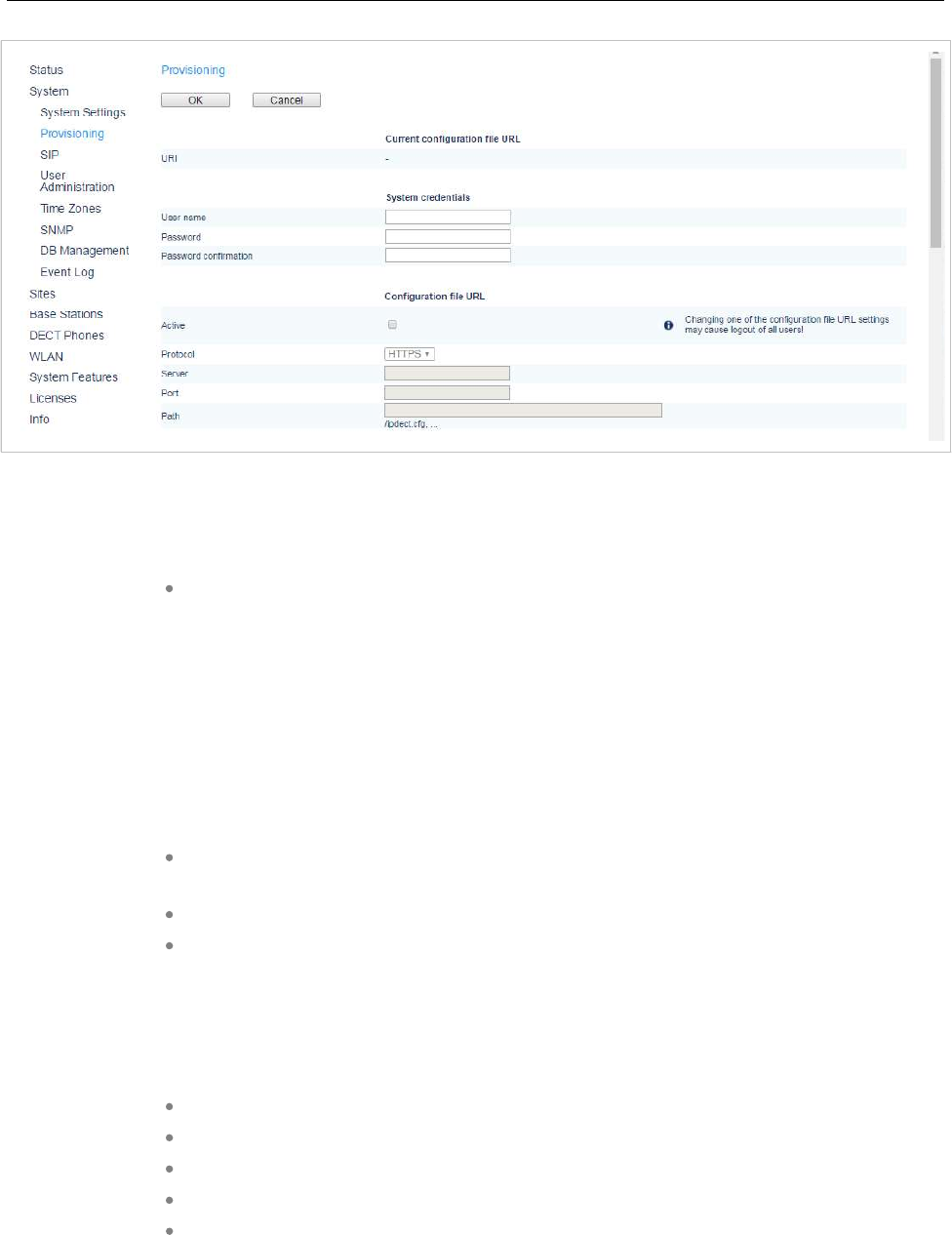
OMM Web Service
69
5.4.2.1Current configuration file URL
Current configuration file URL: URL for the configuration file that is currently
loaded.
5.4.2.2System credentials
System credentials are used to retrieve configuration and resource files from the configured provisioning
server for protocols supporting authentication or servers requesting authentication. For HTTP/HTTPS,
basic and digest authentication are supported. System credentials can also be inherited for specific
URLs, where no user credentials are specified.
User name: Specifies the user name for authentication against the provisioning
server.
Password: Specifies the password for authentication against the provisioning server
Password confirmation: Confirms the password for authentication against the
provisioning server.
5.4.2.3Configuration file URL
Active: Enables or disables the configuration file URL feature.
Protocol: Specifies the protocol to be used to fetch the configuration files.
Server: Specifies the IP address or name of the provisioning server.
Port: Specifies the provisioning server’s port number.
Path: Specifies the path to the configuration and resource files on the provisioning
server.

SIP-DECT OM System Manual
70
5.4.2.4Daily automatic reload of configuration and firmware files
Active: Enables automatic reload of the configuration and resource files on a daily
basis, at the specified time.
Time of day: Time for scheduled reload of configuration and firmware files.
5.4.2.5Autonomous SW update check by OMM
When this is activated, the RFP-OMMs (active, standby) checks autonomous for a new software,
whenever a RFP re-configuration (DHCP renew, OM Configurator, ipdect.cfg, <MAC>.cfg) happens.
5.4.2.6Maximum delay
This parameter specifies the maximum time (in minutes) and the OMM waits past the schedule time
before starting the reload of configuration and firmware files. The Maximum Delay has only an effect,
when “Daily automatic reload of configuration and firmware files” is activated.
5.4.2.7Calculated time of delay
The calculated time for scheduled reload of configuration and firmware files (24h time format). This
parameter is read-only and is calculated by the OMM based on given “Time of Day” and “Maximum
Delay”.
5.4.2.8 Certificates
The OMM uses a trusted certificate chain to validate the server. This is required if the server has no
certificate derived from a trusted CA root certificate, where the OMM uses the Mozilla CA Certificate List.
You can specify the validation methods to be used.
Trusted certificate(s): Read-only; specifies the number of trusted certificates
deployed on the OMM.
Local certificate chain: Read-only; specifies the number of local certificate chains
deployed on the OMM.
Private key: Read-only; specifies whether a private key file is deployed on the
OMM.
Private key password: Specifies a password for the private key file.
Password confirmation: Confirms the password for the private key file.
Delete certificates/key: Allows the user to delete existing certificates and private
key files from the OMM.
SSL version: The SSL protocol version to use for the configuration file server
connection. Available options are: TLS1.0, TLS1.1, TLS1.2 or AUTO, where AUTO
accepts all protocol versions.
Validate certificates: Enables or disables certificate validation. If enabled, the
server certificate is validated against trusted CA’s (signed by a CA from the Mozilla
CA certificate list) and the configured trusted certificates.
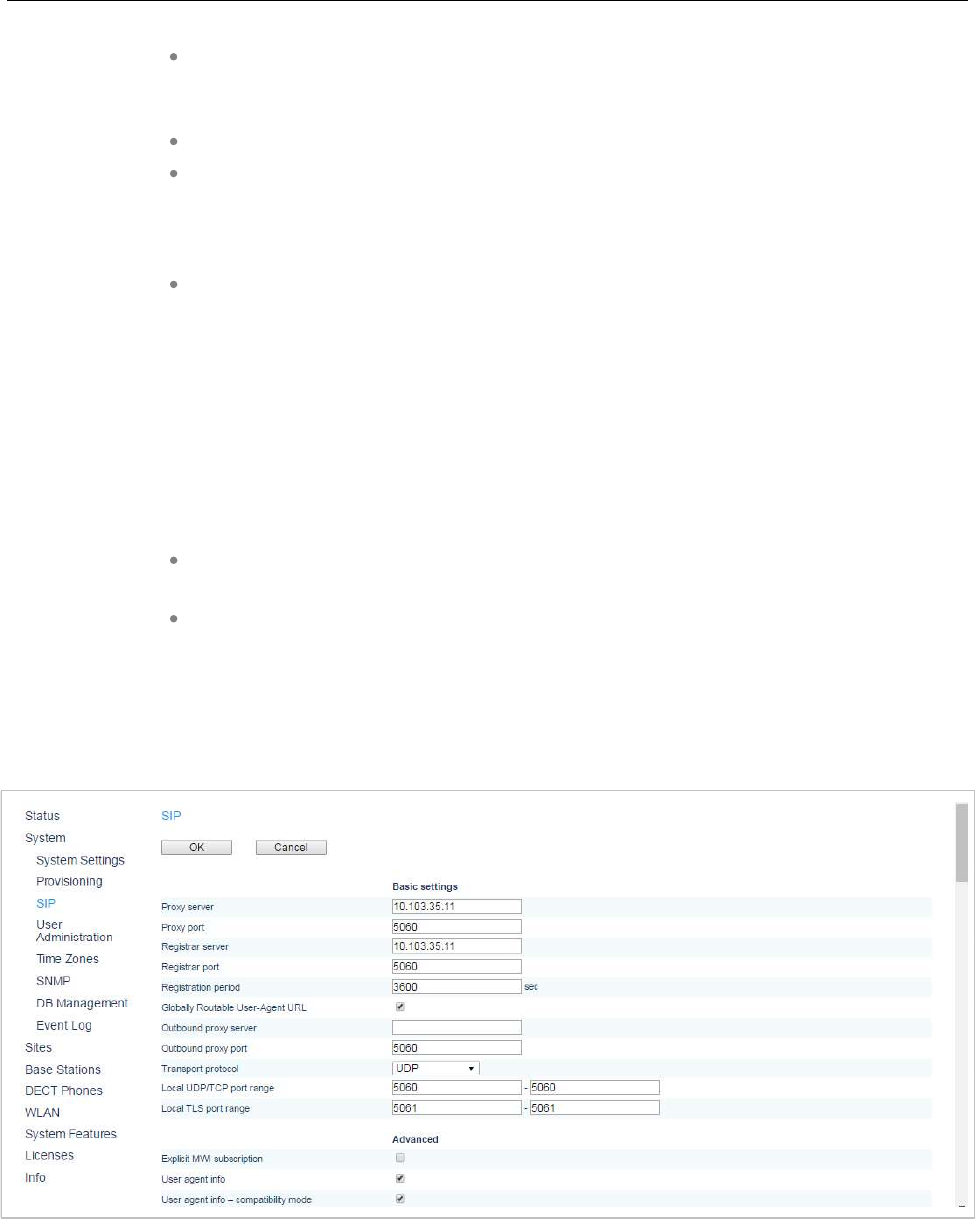
OMM Web Service
71
Validate expires: Enables or disables the validation of certificate expiry. When this
parameter is enabled, the client verifies whether or not a certificate has expired prior
to accepting the certificate.
Validate host name: Enables or disables the validation of hostnames on the OMM.
Allow unconfigured trusted certificates: If enabled, this parameter disables any
server certificate validation as long as no trusted certificate was imported into the
OMM. AXI commands in a received configuration file may import such trusted
certificates into the OMM.
Import certificates with first connection: If enabled (in conjunction with the Allow
unconfigured trusted certificates parameter), the trusted certificate will be imported
from the cert chain delivered in the server response without any validation, as long
as no trusted certificate was imported previously into the OMM.
5.4.2.9 Manual import
You can overwrite the hard coded OMM certificate by importing trusted certificates, a local certificate
chain and a private key file.
Import PEM file with: Specifies the type of file to be imported (trusted certificate,
local certificate, or private key).
Import PEM file: Specifies the location of the file to be imported.
5.4.3 ”SIP” MENU
The SIP settings cover all global settings matching the SIP signaling and the RTP voice streams.
Parameters are grouped under the tabs described below.
5.4.3.1Basic settings
You can set basic SIP settings for the system on the Basic settings menu.

SIP-DECT OM System Manual
72
Proxy server: IP address or name of the SIP proxy server. If a host name and
domain are used for the proxy server parameter, ensure that a DNS server and a
domain are specified for your SIP-DECT system via DHCP or the OM Configurator
tool.
Proxy port: SIP proxy server’s port number. Default is “5060”. To enable DNS SRV
support for proxy lookups, use a value of “0” for the proxy port. In case that TLS is
used, the value shall be changed to “5061”.
Registrar server: IP address or name of the SIP registrar. Enables the DECT
phones to be registered with a registrar. If a host name and domain are used for the
proxy server parameter, ensure that a DNS server and a domain are specified for
your SIP-DECT system via DHCP or the OM Configurator tool.
Registrar port: SIP registrar’s port number. Default is “5060”. To enable DNS SRV
support for registrar lookups, use a value of “0” for the registrar port. In case that
TLS is used, the value shall be changed to “5061”.
Registration period: The requested registration period, in seconds, from the
registrar. Default is “3600”.
Globally Routable User Agent (URL): Enables support for Globally Routable User-
Agent URIs (GRUUs). GRUUs provide a way for anyone on the Internet to route a
call to a specific instance of a SIP User-Agent.
Outbound proxy server: This setting is optional. You can enter the address of the
outbound proxy server in this field. All SIP messages originating from the OMM are
sent to this server. For example, if you have a Session Border Controller in your
network, then you would normally set its address here.
Outbound proxy port: The proxy port on the proxy server to which the OMM sends
all SIP messages. Default is “5060”. In case that TLS is used, the value shall be
changed to “5061”.
Transport protocol: The protocol used by the OMM to send/receive SIP signaling.
Default is “UDP”.
Local UDP/TCP port range: The port range to be used for DECT users when
UDP/TCP is used as the transport protocol. The default is 5060 – 5060.
Local TLS port range: The port range to be used for DECT users when TLS is
used as the transport protocol. The default is 5061 – 5061.
There are certain rules to note when configuring port ranges; see section 2.17 for more information.
5.4.3.2Advanced settings
You can set more advanced SIP settings for the system on the Advanced settings menu.
Explicit MWI subscription: Some SIP Call Managers such as the Asterisk support
Message Waiting Indication (MWI) based on /21/. An MWI icon is displayed on a
DECT phone (Mitel DECT 142 / Mitel 142d, Mitel 600) if the user has received a
voice message on his voice box which is supported by the SIP Call Manager. If
Explicit MWI subscription is enabled, the OMM sends explicit for each DECT
phone an MWI subscription message to the Proxy or Outbound Proxy Server.
Explicit MWI subscription period: The requested duration in seconds, before the
MWI subscription times out. SIP-DECT re-subscribes to MWI before the
subscription period ends.

OMM Web Service
73
User agent info: If this option is enabled, the OMM sends information on his version
inside the SIP headers User-Agent/Server.
Dial terminator: The dial terminator is configurable (up to 2 characters; “0” – “9”, “*”,
“#” or empty). The default dial terminator is “#”. A dial terminator is necessary if digit
treatment shall be applied on outgoing calls and overlapped sending is used.
Registration failed retry timer: Specifies the time, in seconds, that the OMM waits
between registration attempts when the registration is rejected by the registrar.
Default is “1200” seconds.
Registration timeout retry timer: Specifies the time that the OMM waits between
registration attempts when the registration timed out. Default is “180” seconds.
Session timer: The interval, in seconds, between re-INVITE requests sent from the
OMM to keep a SIP session alive. The minimum session timer is 90 seconds and
the maximum is 86400 seconds. The default is 0 (i.e., feature is disabled).
Transaction timer: The time period in milliseconds that the OMM allows a call
server (proxy/registrar) to respond to SIP messages that it sends. If the OMM does
not receive a response in the time period designated for this parameter, the OMM
assumes the message as timed out. In this case the call server is recorded to the
blacklist. Valid values are “4000” to “64000”. Default is “4000” milliseconds.
Blacklist time out: The time period in minutes an unreachable call server stays in
the blacklist. Valid values are “0” to “1440”. Default is “5” minutes.
Incoming call timeout: The time, in seconds, that the OMM waits for a user to
accept an incoming call before rejecting the call automatically. The minimum time is
30 seconds and the maximum is 300 seconds. The default is 180 seconds.
Determine remote party by: You can select the SIP header from which the remote
party information (user id and display name) should be determined. If P-Asserted-
Identity (default value) is selected but no such header is received, a fallback to the
mandatory From / To header will be done. This feature can be configured by
choosing one of the two values.
Note: When SIP-DECT receives a SIP header P-Asserted-Identity in
ringing state during an outgoing call, the included identity
information (e.g. SIP display name and user-id) will be displayed
on Mitel 600 and Mitel 142d phones as new call target. In
addition, the outgoing call log of the Mitel 600 and Mitel 142d
phones will be updated with the new given identity.
Multiple 180 Ringing: If this feature is deactivated, the OMM sends out only one
180 Ringing response for an incoming call if PRACK is not supported. If this feature
is activated, the OMM retransmits multiple times the 180 Ringing response for an
incoming call if PRACK is not supported. This ensures that the calling side receives
a 180 Ringing response in case of packet losses on the network. By default this
feature is active.
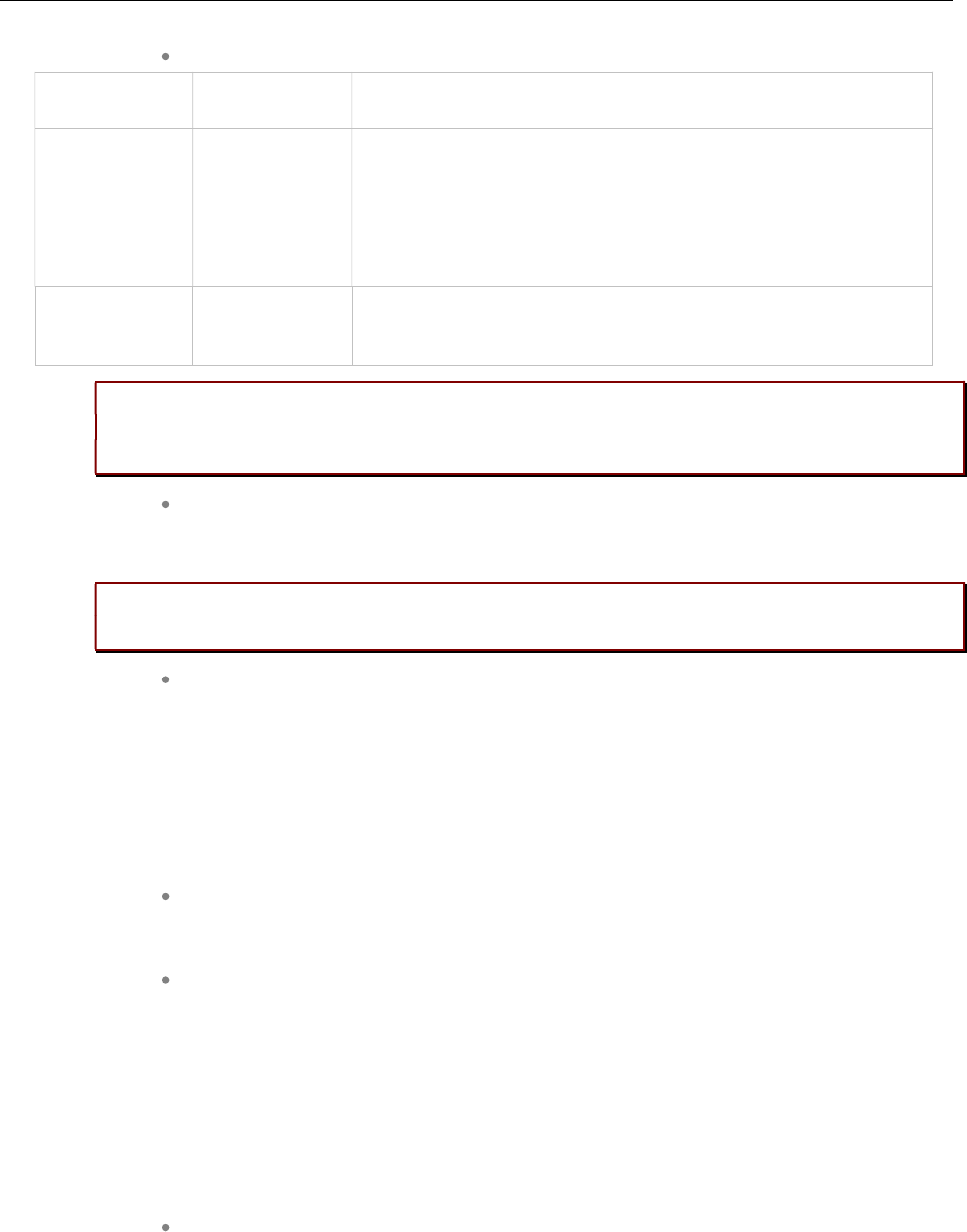
SIP-DECT OM System Manual
74
Semi-attended transfer mode and Refer-to with replaces:
Semi-attended
transfer mode
Refer-to with
replaces
Behavior
Blind No The semi-attended transfer is handled as a blind transfer. The phone
sends CANCEL before REFER for semi-attended transfer.
Blind Yes The semi-attended transfer is handled as a blind transfer. The phone
sends REFER with Replaces for semi-attended transfer and no
CANCEL. This behavior is not SIP compliant but necessary for some
iPBX platforms.
Attended - The semi-attended transfer is handled as an attended transfer. Both
lines of the transferor remain active until the transfer succeeds. This
behavior is compliant to RFC 5589.
Please note: The mode “Semi-attended transfer mode: Blind” with “Refer-to with replaces:
yes” is not SIP compliant and should only be used on iPBX platforms that require this type
of signaling.
Remove route: Enables or disables the addition of the Route header in a SIP
packet. Enable this parameter for outbound proxies that do not support Route
headers.
Please note: When enabled, this breaks all support for SIP routing. So, if some other
devices in the network attempts to add itself to the route, it fails.
SIP contact matching: Specifies the method used by the OMM to match the
Contact header in a SIP response to a REGISTER request. Available options are:
– URI – Match user username, domain name, phone IP and port and transport
– IP only – Match the IP address of the phone only
– Username only – Match the username only
– IP and user name – Match the IP address of the phone and the username
The default is URI.
Call reject state code (user reject): Specifies the SIP state code sent as response
when the user rejects an incoming call by pressing the “Reject” option. Valid values
are “400” to “699”. The default is “486”
Out of range state code (device unreachable): Specifies the SIP state code sent
as response when the incoming call is rejected because the DECT phone is
unreachable (e.g., the DECT phone is out of range or out of battery power). Valid
values are “400” to “699”. The default is 486.
5.4.3.3 RTP settings
You can set RTP parameters in the RTP settings section.
RTP port base: Each RFP needs a continuous port area of 68 UDP ports for RTP
voice streaming. The RTP port base is the start port number of that area. Default is
“16320”.

OMM Web Service
75
Preferred codec 1 – 4: Specifies a customized codec preference list which allows
you to use the preferred codecs. The Codec 1 has the highest and Codec 4 the
lowest priority.
Note: With SIP-DECT Release 3.0 or higher the voice codecs G.722
(wideband), G.711 u-law, G.711 A-law and G.729 A are
supported. The previously supported codec G.723 is no longer
available.
Preferred packet time (10, 20 or 30 msec): Determines the length of voice samples
collected before sending out a new RTP packet. A small setting improves voice
quality at the expense of data transmission overhead. Default is “20” milliseconds.
Silence suppression: Enables automatic silence detection in the RTP voice data
stream to optimize the data transfer volume.
Receiver precedence on CODEC negotiation:
– The ON (option is enabled) setting means:
The CODEC selection for incoming SDP offers based on the own preference
order list. The first entry in the OMM preferred codec list matching an entry in
the incoming SDP offer will be selected.
– The OFF (option is disabled) setting means:
The CODEC selection based on the preference order list of incoming SDP
offer. The first entry in the incoming order list matching an entry of OMM
preferred codec list will be selected. This is the default and is as recommended
in RFC 3264.
Eliminate comfort noise packets: If this feature is activated, then comfort noise
packets are removed from the RTP media stream which causes gaps in the
sequence numbers. This can be used if comfort noise packets e.g. in G.711 media
streams disturb voice calls in certain installations.
Single codec reply in SDP: If this feature is activated, the OMM answers to SDP
offers (included in the SIP signalization) with a single codec in the SDP answer.
5.4.3.4DTMF settings
You can set DTMF parameters in the DTMF section.
Out-of-band: Used to configure whether DTMF Out-of-band is preferred or not.
Method: The OMM supports the following DTMF Out-of-band methods:
– RTP (RFC 2833)
Transmits DTMF as RTP events according to RFC 2833 (/14/) after the
payload type negotiation via SIP/SDP. If the payload type is not negotiated, “in
band” will be used automatically.
– INFO
The SIP INFO method is used to transmit DTMF tones as telephone events
(application/dtmf-relay). This setting should be used if RFC 2833 is not
supported.
– BOTH
DTMF telephones events are send according to RFC 2833 and as well as SIP
INFO method. Note: Possibly, the other party recognizes events twice.

SIP-DECT OM System Manual
76
Payload type: If the Out-of-band option is enabled, this setting specifies the
payload type which is used for sending DTMF events based on section 4.5,
reference /14/.
5.4.3.5Registration traffic shaping
Registration traffic shaping parameters allow you to limit the number of simultaneous SIP registrations at
startup/fail over of the OMM. This feature is always activated because disabling it may overload the
OMM or the call server.
Some providers use a keep-alive mechanism based on SIP registration renewals for remote endpoints
that are behind a Network Address Translator (NAT), as in an IP-Centrex solution. The keep-alive
mechanism keeps the pinhole open and ensures communication between the remote endpoint and the
Session Border Controller (SBC).
The OMM feature that spreads the registration renewals to prevent bottlenecks in large systems is not
compatible with the keep-alive mechanism. With SIP-DECT 6.0 or later, you can disable the spread
mechanism and configure a registration renewal timer to allow support for the NAT feature.
Simultaneous registrations: The maximum number of simultaneously started
registrations.
Waiting time: The waiting time between a registration finish and starting the next
registration in ms (0-1000ms).
Spread registration renewals: If set to ON, the OMM distributes all DECT phone
registration renewals automatically, between half-way through the registration period
and 30 seconds before expiry. This prevents registration renewal bottlenecks.
Default is ON.
Renewal timer: The time, in seconds, during which the OMM renews DECT phone
registrations before expiry (if “Spread registration renewals” is set OFF). The DECT
phone automatically sends registration renewals half-way through the registration
period, unless the half-way point is greater than the threshold value. For example, if
the threshold value is set to 60 seconds and the registration period is 600 seconds,
the phone sends the renewal REGISTER message 60 seconds prior to the
expiration of the registration period. If the registration period is 100 seconds, the
renewal is sent at the half-way point as (100/2) < 60. Valid values are 0 to
2147483647. Default is 15.
5.4.3.6 Supplementary Services
The Supplementary Services section contains various parameters releated to call control.
Call forwarding / Diversion: The DECT phone user can (de)activate call
forwarding/diversion in the OMM via DECT phone menu. In some installations the
implemented call forwarding/diversion feature in the IPBX system is in conflict with
the OMM-based call forwarding/diversion. Thus, the OMM-based call
forwarding/diversion can be deactivated to let the menu on the DECT phone
disappear. This setting becomes active on DECT phones with the next DECT
“Locating Registration” process (can be forced by switching the DECT phone off and
on again). Call forwarding that is already activated is ignored if the call forwarding
feature is deactivated.

OMM Web Service
77
Local line handling: In some installations the implemented multiple line support in
the IPBX system is in conflict with the OMM based multiple line support. Thus, the
OMM based multiple line support can be deactivated. Note, that the OMM based
multiple line support is active by default.
A deactivation of the “Local line handling” flag results in the following implications:
– Only one line is handled for each user (except for an SOS call 0F0F1)
– If a user presses the “R” key or hook-off key in a call active state, a DTMF
event is send to the IPBX via SIP INFO including signal 16 (hook-flash). All
Hook-flash events are sent in every case via SIP INFO, independent of the
configured or negotiated DTMF method during call setup. All other key events
are sent via the configured or negotiated DTMF method.
– The OMM-based call features “Call waiting”, “Call Transfer”, “Brokering” and
“Hold” are no longer supported.
– This setting becomes active on DECT phones with the next DECT “Locating
Registration” process (can be forced by switching the DECT phone off and on
again).
Automatic ringback on hold call: Enables or disables a ringback on the
loudspeaker if the B party of the active line releases the call. The ringing begins
after the call release timeout interval (see description below).
Call transfer by hook on (Mitel 600): Enables call transfer via the hook key on a
Mitel 600 DECT phone (in addition to call transfer via menu).
Call transfer by hook on (Mitel 142): Enables call transfer via the hook key on a
Mitel 142 DECT phone (in addition to call transfer via menu).
Truncate Caller Indication after ‘;’: If the user name info in SIP to-/from-/contact
headers or p-asserted-identity is extended by a suffix, which is separated by a
semicolon, this suffix is truncated before the username is printed to call displays or
DECT phone internal call logs.
SIP reRegister after 2 active OMM failover: Enables SIP re-registration of all
users from the active OMM when the system detects two active OMMs (in a failover
scenario).
Call release timeout: Specifies the time, in seconds, after which an active line is
released if the DECT phone user has not gone on-hook after the B party on an
active call releases the call.
Hold call release timeout: Specifies the time, in seconds, after which the active line
is released if the DECT phone user has not switched to a held line (when the B
party on a held call releases the call).
Failed call release timeout: Specifies the time, in seconds, after which an active
line is released if the called party is busy, or the call is rejected for any reason.
1The OM SOS call feature is unchanged. The initiation of a SOS call in call active state results in the
creation of a new line which handles the SOS call.

SIP-DECT OM System Manual
78
5.4.3.7Intercom Push-to-talk-Outgoing calls/Incoming calls
You can set global auto-answer settings in the Intercom Push-to-talk section. For more information on
this feature, see section 2.31.
Outgoing calls
Initialization prefix for Push-to-talk: String to be entered when initiating an
intercom call. An empty string indicates that the DECT phone cannot initiate an
intercom call.
Incoming calls
Auto answer: Enables or disables auto-answer on incoming calls.
Microphone mute: Enables or disables microphone muting when incoming calls are
automatically answered.
Warning tone: Enables or disables warning tone on incoming call. A short ringtone
is played if there are no active calls. If there is an active call in a “barge in” situation,
the ringing will be in-band.
Allow barge in: Allows/disallows “barge-in” on existing calls.
5.4.3.8 Security
You can set security-specific settings in the Security section.
Persistent TLS keep alive timer active: When enabled and “Persistent TLS” is
selected as transport protocol, the OMM sends out keep alive messages periodically
to keep the TLS connection open.
Persistent TLS keep alive timer timeout: Specifies the time pattern, in seconds, in
which the OMM sends out keep-alive messages. Valid values are “10” to “3600”.
Default is “30” seconds.
Send SIPS over TLS active: When enabled, and “TLS” or “Persistent TLS” is
selected as transport protocol, the OMM uses SIPS URIs in the SIP signaling.
Default is “ON”.
TLS-Authentication: When enabled and “TLS” or “Persistent TLS” is selected as
transport protocol, the OMM validates the authenticity of the remote peer via
exchanged certificates and the configured “Trusted certificates”. Default is “ON”.
TLS-Common-Name-Validation: When enabled and “TLS authentication” is
selected, the OMM validates the “Alternative Name” and “Common Name” of the
remote peer certificate against the configured proxy, registrar and outbound proxy
settings. If there is no match, an established TLS connection will be closed
immediately.
Trusted certificate(s): The number of imported trusted certificates (read-only).
Local certification chain: Indicates the number of imported certificates in the local
certificate chain (read-only).
Private key: Indicates whether the OMM has a private key file (read-only).
Delete certificates/key: Allows deletion of all certificates and the local key.

OMM Web Service
79
5.4.3.9Certificate server
Set the parameters on the Certificate server tab to automatically import Trusted, Local Certificates and a
Private Key files from an external server for SIP signaling.
Active: Enables the feature.
Protocol: Specifies the preferred protocol (FTP, TFTP, FTPS, HTTP, HTTPS,
SFTP)
Server: Specifies the name or IP address of the external file servedr.
User name: Specifies the user name to authenticate against the external file server.
Password: Specifies the password to authenticate against the external file server.
Password confirmation: Confirms the password to authenticate against the
external file server.
Path: Specifies the path on the file server to the certificate files.
Trusted certificate file: Specifies the name of the PEM file on the specified server,
including the trusted certificates.
Local certificate file: Specifies the name of the PEM file on the external server
including the local certificate or a certificate chain.
Private key file: Specifies the name of the PEM file on the external server including
the local key.
Port: Specifies the certificate server’s port number.
Use default port: If selected, the default port associated with the selected protocol
is used.
Use common certificate configuration: Enables the use of the system-wide
certificate validation settings, as configured on the System -> Provisioning ->
Certificates page (see section 5.4.2.8).
5.4.3.10 Manual import
Set the parameters for manual import of certificate keys.
Import PEM file with: Allows selection of the kind of certificate/key to be imported.
Import PEM file: Specifies the file to be imported.
Import: Triggers an import of the file.
5.4.4 “USER ADMINISTRATION” MENU
After initial installation or after removing the configuration file, the OMM Web service is accessible via a
built-in user account with user “omm” and password “omm”.
If the default built-in user account is active, the administrator must change the default account data of the
“Full access” and “Root (SSH only)” account. The meaning of the different account types is described in
section 8.17.1.
Please note: The OMM forces you to change the default account data. As long as the
passwords are unchanged, the OMM will not allow any other configuration.
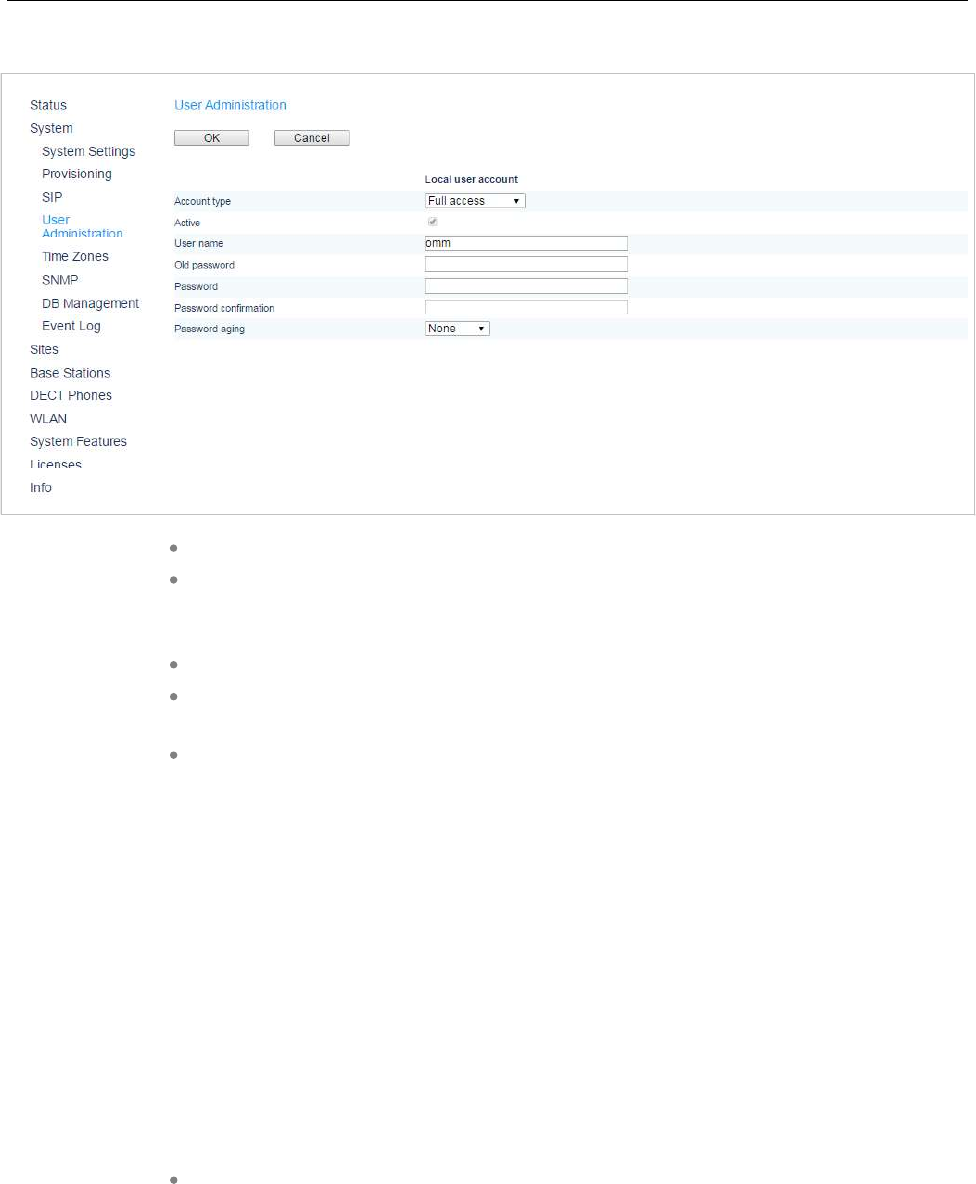
SIP-DECT OM System Manual
80
These settings are case sensitive and can be changed on the User administration web page.
Account type: Select the account type you wish to change.
Active: This setting applies to the Read-only access account. Using this account, a
user is not allowed to configure any item of the OMM installation. The account can
be deactivated.
User name: If desired, enter a new user name.
Old password: Related to the “Full Access Account”, to change the password the
old password must be typed in again.
Password, Password confirmation: Enter the appropriate data in these fields.
The OMM has several rules to check the complexity of the new password. A new password will not be
accepted if:
– the new password is not five or more characters long
– the new password does not contain characters from at least three of the
following groups: lower case, upper case, digits or other characters
– the new password has 50% or more of the same character ('World11111' or
'W1o1r1l1d1')
– the new password contains one of the following items (either upper or lower
case as well as forward or backward):
– account name
– host name (IP address)
– old password
– some adjoining keystrokes (e.g. 'qwert')
Password aging: A timeout for the password can be set. Select the duration, the
password should be valid.
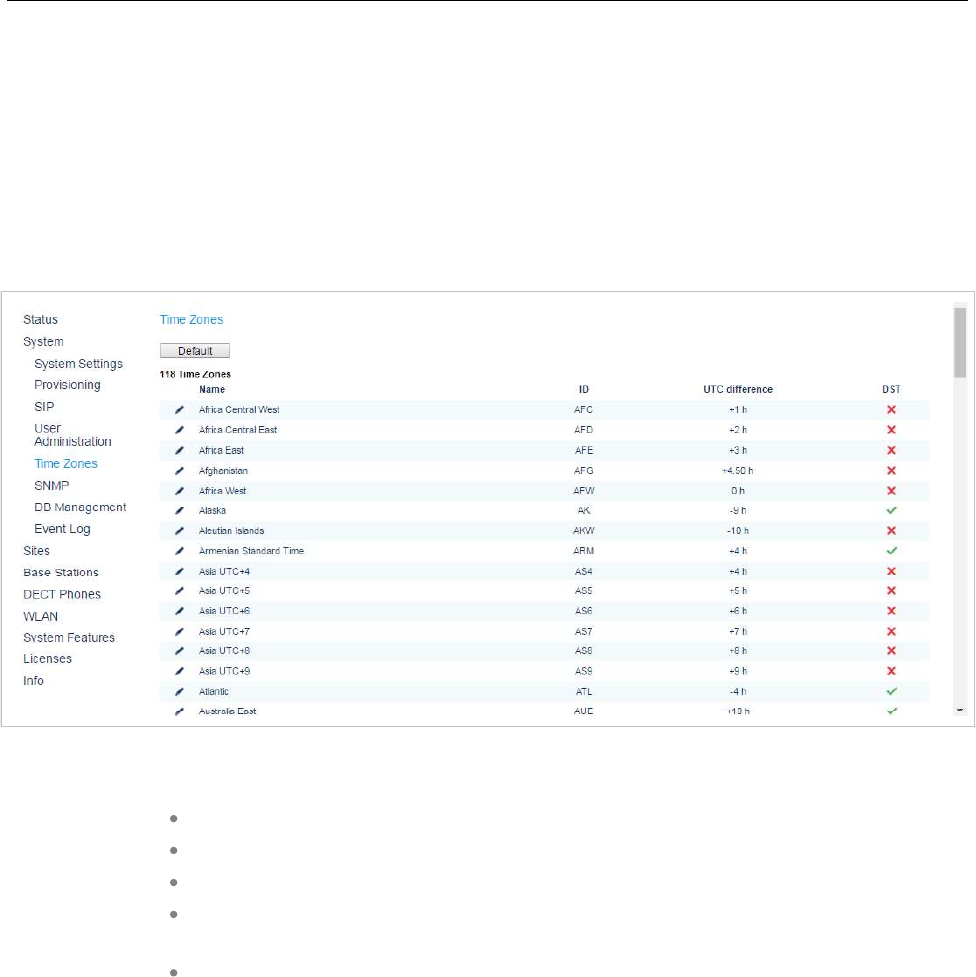
OMM Web Service
81
5.4.5 “TIME ZONES” MENU
Note: This menu is only available if the OMM resides on a DECT base
station.
On the Time zones page, the OMM provides all available time zones. They are set with their known
daylight savings time rules adjusted to the Universal Coordinated Time (UTC) per default. The difference
to the UTC time is shown in the UTC difference column. In case of a configured daylight savings time
rule (DST column) this is also marked for each time zone.
The date and time are provided by the OMM to the Mitel 142 and Mitel 600 DECT phones if the DECT
phone initiates a DECT location registration. This will be done in the following cases:
Subscribing to the OMM
Entering the network again after the DECT signal was lost
Power on
Silent charging feature is active at the phone and the phone is taken out of the
charger
After a specific time to update date and time
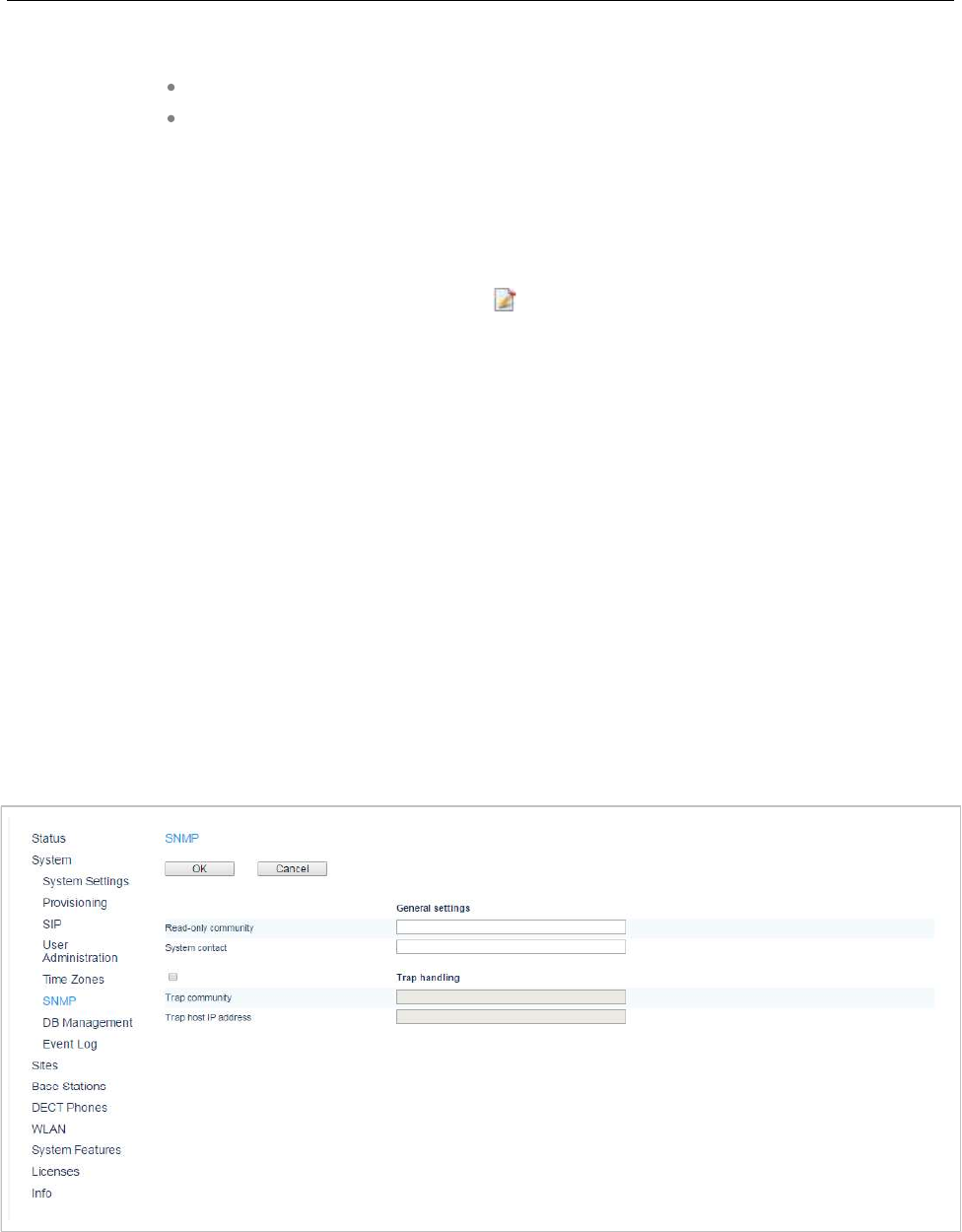
SIP-DECT OM System Manual
82
The following tasks can be performed on the Time zones page:
Changing the time zones (see section 5.4.5.1)
Resetting time zones (see section 5.4.5.2)
5.4.5.1Changing Time Zones
It is possible to change the time zone rules for maximal five time zones. Changed rules are marked with
a bold time zone name in the table. The changes are saved in the configuration file and are restored
after each OpenMobility Manager startup.
1To change the settings of a time zone, click on the icon left behind the time zone entry.
The Configure time zone dialog opens.
2You can change the standard time and the daylight savings time (DST) of a time zone.
If the time zone has no DST, only the UTC difference can be configured.
For the DST both points of time (begin of standard time and begin of daylight savings time) must be
specified exactly. Therefore a certain day in the month or a certain week day in a month can be used.
5.4.5.2Resetting Time Zones
To reset individual time zone settings, press the Default button on the Time zones web page. This sets
all time zones back to the default values and deletes the changed time zone rules in the configuration
file.
5.4.6 “SNMP” MENU
To manage a larger RFP network, an SNMP agent is provided for each RFP. This will give alarm
information and allow an SNMP management system (such as “HP Open View”) to manage this network.
On the SNMP page of the OMM Web service you configure the SNMP service settings.
You can configure the following SNMP parameters using the OMM web service:
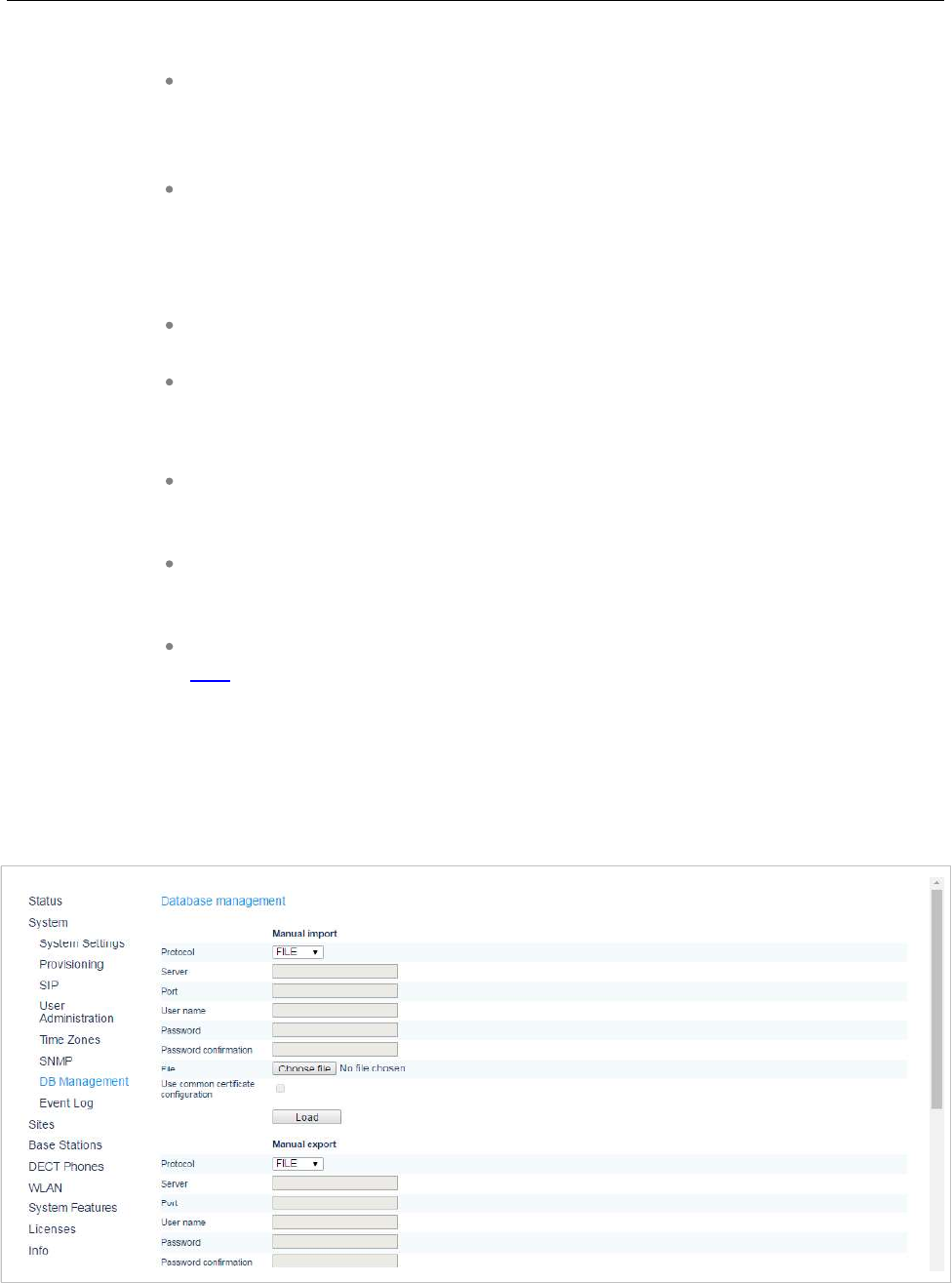
OMM Web Service
83
General settings
Read-only community: The SNMP community string forms a password that is sent
by the SNMP management system when querying devices. The query is answered
only if the SNMP community string matches. You may use “public” as a default
keyword for read-only access.
System contact: Enter a descriptive text that typically is displayed in the SNMP
management software.
Trap handling
Activate the checkbox behind the Trap handling section to enable this feature.
Trap community: This community string is used if the SNMP agent informs the
SNMP management system about events (traps).
Trap host IP address: Enter the IP Address that the SNMP agent uses to send
traps.
Further notes
The RFP needs an initial (one-time) OMM connection to receive its SNMP
configuration. In case of a reset, this configuration does not change. Changing the
SNMP configuration on the OMM forces all agents to be reconfigured.
The agent does not support MIB-II write access, SNMPv2-MIB read/write access,
NET-SNMP-MIB read/write access, NET-SNMP-AGENT-MIB read/write access and
SNMPv3.
For background information on using SNMP with the SIP-DECT system, see section
8.19.
5.4.7 “DB MANAGEMENT” MENU
The database management (DB) menu allows flexible backup and restore management of the OMM
database. The OMM database contains all configuration settings which are configurable via the OMM
Web service interface.

SIP-DECT OM System Manual
84
The OMM database can be:
manually imported from the Web browser’s file system or from an external server
(see section 5.4.7.1),
manually exported to the Web browser’s file system or to an external server (see
section 5.4.7.2),
automatically exported to an external server when configuration modifications are
done (see section 5.4.7.3).
Note: The OMM database is saved in a compressed file in a proprietary
format. Any modification of this file outside the OMM is not
allowed.
The system support the following protocols for the transport to or from an external server: FTP, TFTP,
FTPS, HTTP, HTTPS, SFTP.
5.4.7.1Manual Database Import
Please note: A manual import of a database results in a reset of the OMM.
In the Manual import section of the Database management page enter the following:
1 Protocol:
– To import a database from the Web browser’s file system the protocol FILE
must be selected.
– To import a database from an external server select the preferred protocol (e.g.
HTTP).
2 Server: IP address or the name of the external server.
3 User name,Password (in case of import from an external server): If necessary, enter the account
data of the server.
4 File: Path and file name which include the OMM database. If you have selected the FILE protocol, the
Browse button is displayed and you can to select the file from the file system.
5 Use common certificate configuration: Enables the use of the system-wide certificate validation
settings, as configured on the System -> Provisioning -> Certificates page (see section 5.4.2.8).
6Press the Load button.
Before the OMM accepts the database, a validation check is performed. If the database is verified as
valid, the OMM will be reset to activate the new database.
Please note: After the reset, all configuration in the restored database takes effect with the
exception of the user account settings. The user account settings can be only modified
locally via the OMM Web service and are never restored by a database import.
5.4.7.2Manual Database Export
In the Manual export section of the Database management page enter the following:
1 Protocol: Select the preferred protocol. If you want to export the database to the Web browser’s file
system, select the FILE setting.
2 Server: Enter the IP address or the name of the server.

OMM Web Service
85
3 User name,Password: If necessary, enter the account data of the server.
4 File: Enter the path and filename where the database is to be saved.
5 Use common certificate configuration: Enables the use of the system-wide certificate validation
settings, as configured on the System -> Provisioning -> Certificates page (see section 5.4.2.8).
6Press the Save button.
5.4.7.3 Automatic Database Export
The automatic database export feature allows an automatic database backup to an external server for
each configuration modification. If this feature is activated, the OMM transfers a backup file to a
configured external server any time configuration changes occur (e.g. DECT phone subscription). The
backup file overwrites any existing backup files.
Please note: Synchronization with an NTP server is mandatory for an automatic database
export. For NTP server configuration, see section 8.5.4 and section 8.6.
In the Automatic export section of the Database management page enter the following:
1 Active: Activate this option to enable the automatic export feature.
2 Protocol: Select the preferred protocol.
3 Server: Enter the IP address or the name of the server.
4 Port: Enter the port of the server.
5 User name,Password: If necessary, enter the account data of the server.
6 File: Enter the path and filename where the database is to be saved.
The OMM writes the database into a file on the external server with following name convention:
<yymmdd>_<system_name>_<PARK>_omm_conf.gz
If the system name contains non-standard ASCII character then these character are replaced by “_”.
7 Use common certificate configuration: Enables the use of the system-wide certificate validation
settings, as configured on the System -> Provisioning -> Certificates page (see section 5.4.2.8).
8Press the OK button.
5.4.8 “EVENT LOG” MENU
The Event log page displays important event information on OMM system functions, e.g. security
aspects. A more detailed system log is available by configuring the Syslog function in the System
settings menu (see section 5.4.1.11).
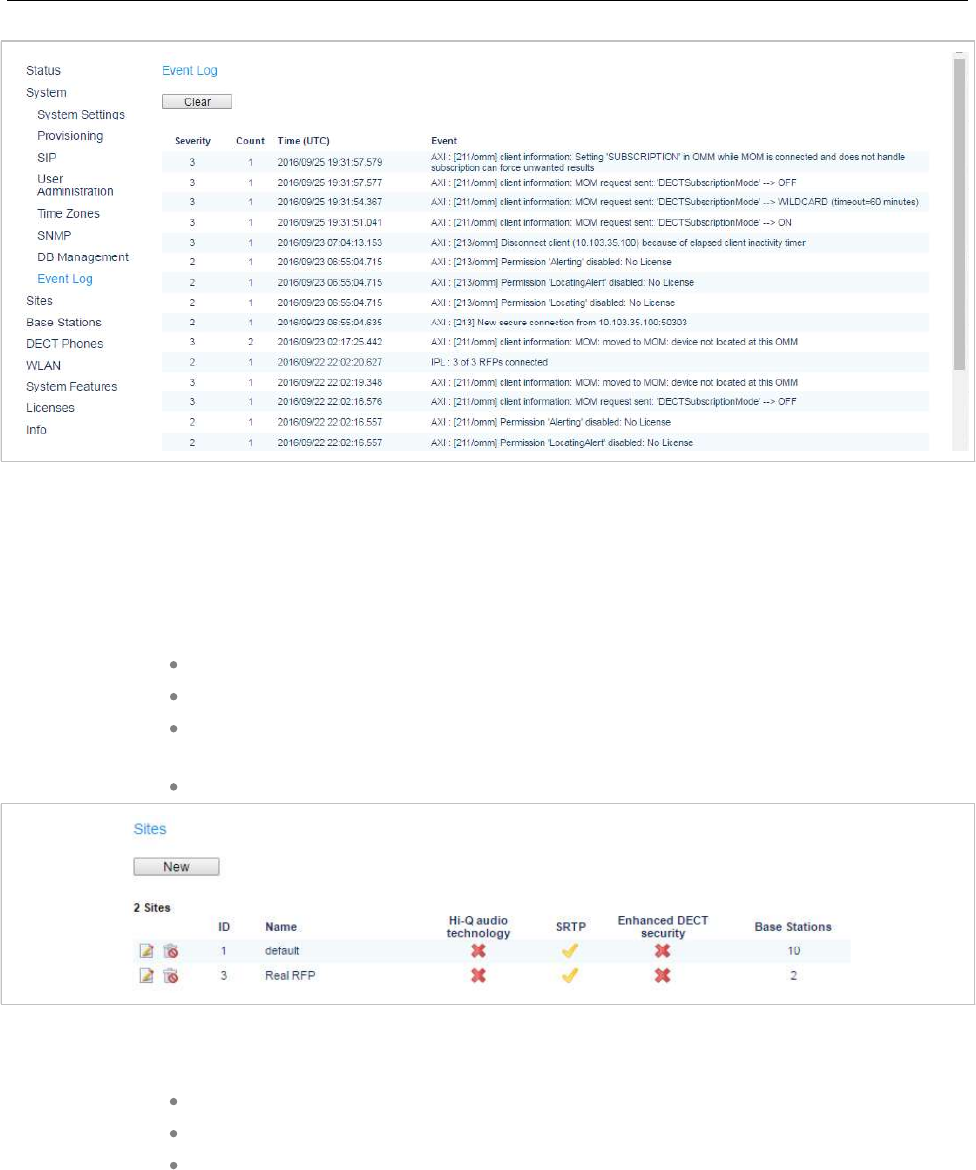
SIP-DECT OM System Manual
86
To clear the display, press the Clear button.
5.5 “SITES” MENU
DECT base stations can be grouped into different sites. A site consists of the following parameters:
ID: Identification number of the site.
Name: The name of the site.
Hi-Q Audio Technology, SRTP, Enhanced DECT Security: Indicates whether
(one of) these features are enabled for the site.
Base stations: The number of base stations assigned to the site.
You can perform the following tasks:
create a new site (see section 5.5.1)
edit a site (see section 5.5.2)
delete a site (see section 5.5.3)
5.5.1 CREATING A NEW SITE
1On the Sites page press the New button.
The Configure site dialog opens.

OMM Web Service
87
2In the Configure site window, specify values for the following parameters:
ID: Enter the identification number of the site. A value between 1 and 250 is
possible. If no value is given, the OMM selects the next free ID.
Name: Enter the name of the site.
Hi-Q audio technology, SRTP, Enhanced DECT security: Enable or disable these
capabilities.
– Only 3rd and 4th generation RFPs are supported where these features are
enabled.
– You can mix new RFP types with older RFP 32/34 and RFP 42 WLAN base
stations where these features are disabled.
3Press the OK button to save your changes.
5.5.2 EDITING A SITE
You can change the name of an existing site:
1On the Sites page click on the icon left behind the site entry.
The Configure site dialog opens.
2Change the site name.
3Press the OK button.
5.5.3 DELETING A SITE
Note: Only sites without assigned base stations can be deleted. At
least one site must remain, so the last site cannot be deleted.
To delete an existing site:
1On the Sites web page click on the icon left behind the site entry.
The Delete site dialog opens.
2Press the Delete button.
5.6 “BASE STATIONS” MENU
All configured base stations are listed on the Base stations page. The base stations are sorted by their
Ethernet (MAC) addresses.
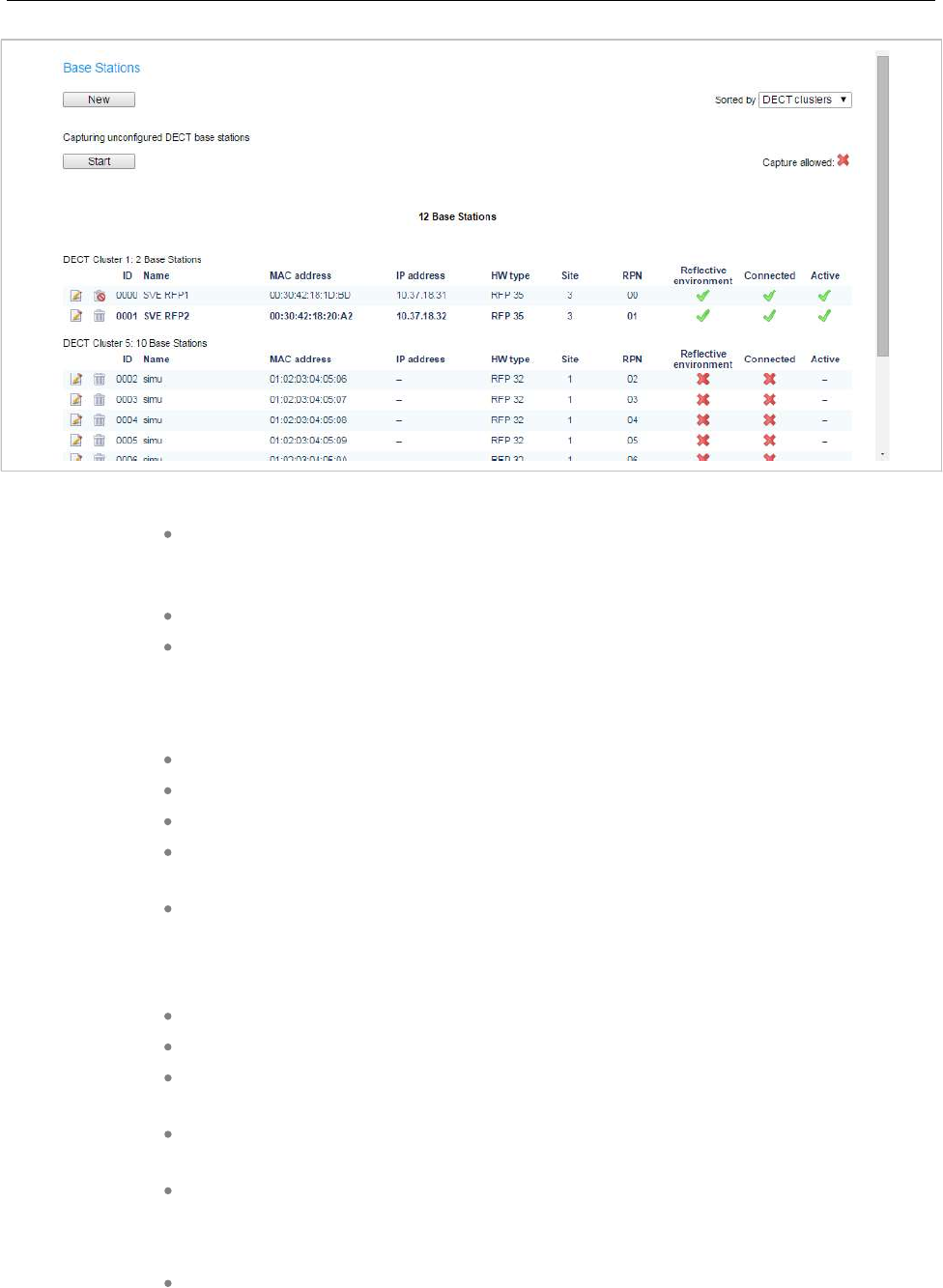
SIP-DECT OM System Manual
88
You can select a sorting criterion for the RFP table. In the Sorted by field, select the criterion:
DECT clusters: The base stations are sorted by clusters. All used clusters are
displayed in the navigation bar on the left side. The OMM base station is marked
with a bold font.
WLAN profiles: The base stations are sorted by WLAN profile (see section 5.8).
Sites: The base stations are sorted by sites (see section 5.5). All used sites are
displayed in the navigation bar on the left side. The OMM base station is marked
with a bold font.
The table provides information on all configured base stations and their status in several columns:
ID: An internal number that is used to manage the base station.
Name: Indicates the base station's name (see section 5.6.3).
MAC address: Indicates the base station's MAC address (see section 5.6.3).
IP address: Shows the current IP address of the RFP. The IP address may change
over time by using dynamic IP assignment on the DHCP server.
HW type: When the base stations connect to the OMM, they submit their hardware
type. The hardware type is displayed in this column. If an error message is indicated
in this column, there is a mismatch between the base station and the OMM software
version (see section 5.6.2).
Site: Indicates the site the base station is assigned to (see section 5.5).
RPN: Shows the Radio Fixed Part Number that is currently used by the RFP.
Reflective environment: Indicates if the base station is operated in a reflective
environment (see section 5.6.3).
Connected: Indicates if the base station is connected to the OMM (see section
5.6.1).
Active: Indicates if the base station is active (see section 5.6.1).
The following tasks can be performed on the Base stations page:
Create and change base stations (see section 5.6.3).
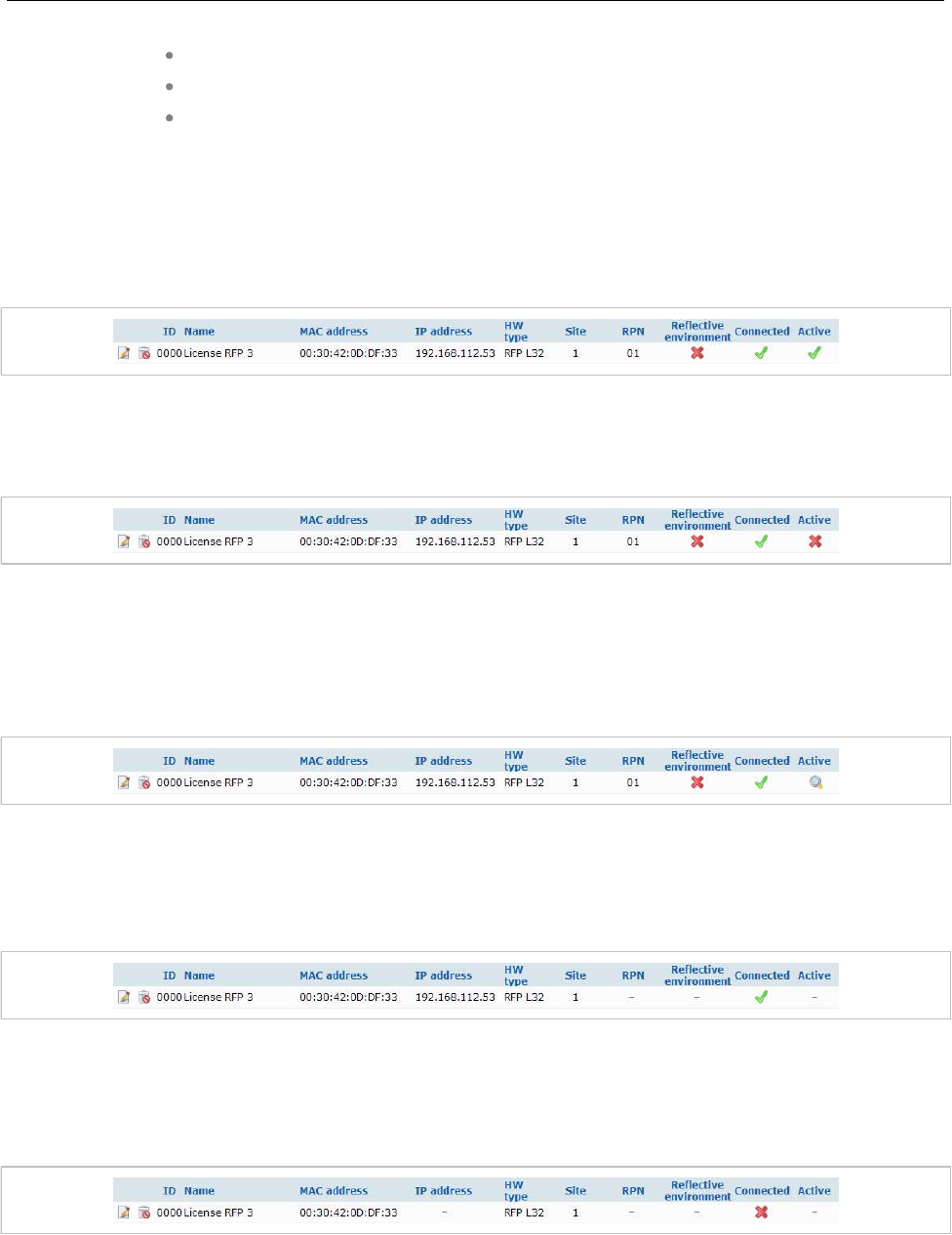
OMM Web Service
89
Capture base stations (see section 5.6.4).
Delete base stations (see section 5.6.5).
Find my SIP-DECT base station (see section 5.6.6).
5.6.1 BASE STATION STATES
For each base station the state of the DECT subsystem is displayed. These states are:
Synchronous
The RFP is up and running. The RFP recognizes and is recognized by other RFPs in its cluster through
its air interface and delivers a synchronous clock signal to the DECT phones.
Asynchronous
The RFP has not been able to synchronize to its neighbors yet. No DECT communication is possible.
But nevertheless the RFP has already been able to connect to the OMM. This phase should usually last
only for a few seconds after starting up the RFP or the OMM. If this state lasts longer this is an indication
for a hardware or network failure.
Searching
The RFP has lost synchronization to its neighbors. No DECT communication is possible. This phase
should usually last only for a few seconds after starting up the RFP or the OMM. If this state lasts longer
or is re-entered after being in a synchronous state this is an indication for a bad location of the RFP.
Inactive
The RFP has connected to the OMM but the air interface has not been switched on yet. For any RFP
with activated DECT functionality this phase should last only for a few seconds after starting up the RFP.
If this state lasts longer this may indicate a hardware failure.
Not connected
The RFP was configured but has not connected to the OMM yet. Therefore the IP address column is
empty.
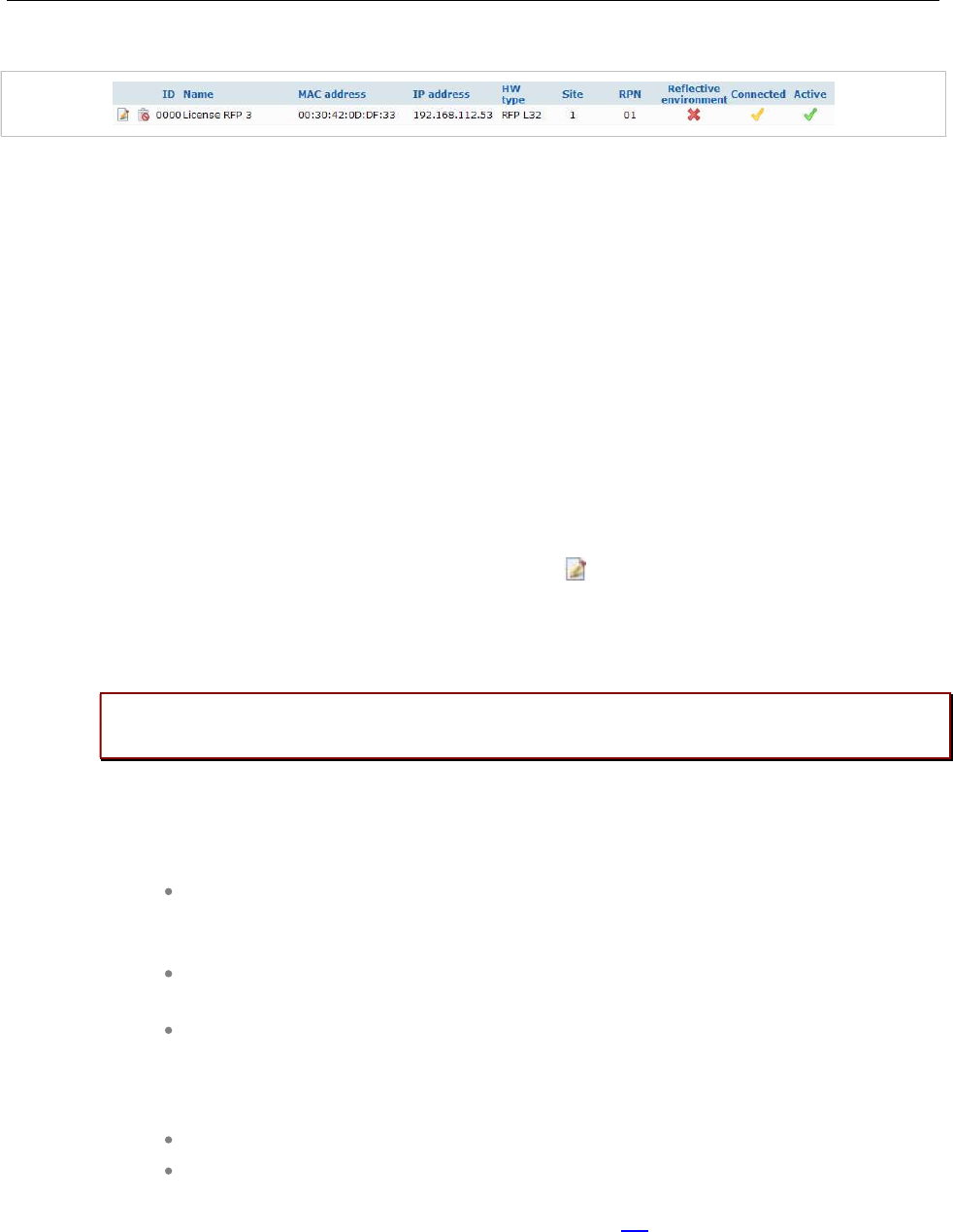
SIP-DECT OM System Manual
90
Software Update available
The RFP is connected to the OMM. The OMM has found new software on the TFTP server. The RFP is
waiting for the OMM to initiate a reboot. In the meantime is the RFP fully operational.
5.6.2 OMM / RFP SOFTWARE VERSION CHECK
When the DECT base stations connect to the OMM, they submit their software version. If this version
differs from the OMM software version and the versions are incompatible, the RFP connection attempt is
rejected. This could happen when using several TFTP servers with different OpenMobility software
versions. In this case, the RFP is marked with an error message. Moreover a global error message is
displayed on the RFP list web page if at least one version mismatch has been found.
5.6.3 CREATING AND CHANGING BASE STATIONS
1To configure a new RFP, click the New button on the Base Stations page.
To change the configuration of an existing RFP click on the icon left beside the base station entry.
The New base station (or the Configure base station) dialog opens.
2Configure the base station (see parameter descriptions below).
3Click OK.
Please note: DECT regulatory domain, WLAN regulatory domain and WLAN profile must be
configured first. Otherwise DECT and/or WLAN cannot be enabled.
The following parameters can be set in the New base station and the Configure base station dialogs:
General settings
MAC address: Each RFP is identified by its unique MAC address (6 bytes hex
format, colon separated). Enter the MAC address (as it appears on the back of the
base station chassis).
Name: For easier administration each RFP can be associated with a location string.
The location string can hold up to 20 characters.
Site: If several sites exist (see section 5.5), select the site the RFP is assigned to.
DECT settings
The DECT functionality for each RFP can be switched on/off.
DECT cluster: If DECT is active the RFP can be assigned to a cluster.
Preferred synchronization source: Activate this checkbox if the RFP should be
used as synchronization source for the other RFPs in the cluster. For background
information on RFP synchronization see section 8.2.

OMM Web Service
91
Reflective environment: Within areas containing lot of reflective surfaces (e.g.
metal or metal coated glass) in an open space environment the voice quality of a
DECT call can be disturbed because of signal reflections which arrive on the DECT
phone or RFP using multipath propagation. Calls may have permanent drop outs
while moving and high error rates on the RFPs and DECT phones.
For such environment, Mitel has developed the DECT XQ enhancement into the RFP base stations
and the Mitel 600 DECT phones family. Using this enhancement by switching the Reflective
environment flag on might reduce drop outs and cracking noise.
As soon as Reflective environment is switched on, the number of calls on an RFP is reduced to
4 calls at the same time.
Please note: The RFPs and DECT phones use more bandwidth on the Air Interfaces if the
“Reflective environment“ attribute is switched on. Therefore this is used when problems
caused by metal reflections are detected.
WLAN settings
The WLAN section applies to RFPs of the type “RFP 42 WLAN”, “RFP 43 WLAN” and “RFP 48 WLAN”
only. For details about WLAN configurations please see section 8.18.
The WLAN RFPs have different WLAN parameters, which are configurable in the RFP configuration
dialog.
Activation check box: Enables or disables the WLAN function for this RFP.
WLAN profile: Select the desired profile from the list. This applies all settings made
in the respective WLAN profile to the current RFP. For information on configuring
WLAN profiles see section 5.8.1.
Please note: WLAN settings are only configurable if the RFP has been connected at least
once to detect the hardware type and a proper WLAN profile is configured (see also
section 5.8.1). WLAN cannot be enabled in the New DECT base station dialog if the
hardware type is unknown.
The following settings are not applied by the WLAN profile. Configure these settings for each DECT base
station individually.
Antenna diversity (RFP 42 WLAN only): This option should generally be activated
so that the AP (Access Point) can automatically select the antenna with the best
transmission and reception characteristics.
Antenna (RFP 42 WLAN only): If Antenna diversity is switched off, this setting
determines the antenna that is used for transmitting or receiving WLAN data.
802.11 channel: Determines the WLAN channel used by the current RFP. The
channel numbers available are determined by the WLAN Regulatory domain
setting on the System settings page.
Output power level (default: “Full”): Determines the signal power level used by the
RFP to send WLAN data. You may limit the power level to minimize interferences
with other WLAN devices. The actual power level is also capped by the WLAN
Regulatory domain setting on the System settings page.

SIP-DECT OM System Manual
92
RFP 43: 300 MBit/s (n) 2x2 MIMO
RFP 48: 450 MBit/s (n) or 600 MBit/s (ac) 3x3 MIMO
5.6.4 CAPTURING DECT BASE STATIONS
Base stations that are assigned to the OMM by DHCP options or OM Configurator settings may connect
to the system.
1On the Base Stations page, press the Start button below the “Capturing unconfigured DECT base
stations” caption.
The page is updated with the MAC addresses of those base stations that attempted to register with
the OMM (unregistered RFPs).
Note: These entries are not actually stored, and are lost after an OMM
reset.
2By clicking on the edit icon of the appropriate base station, you can add further data and store the
base station (see section 5.6.3).
5.6.5 DELETING DECT BASE STATIONS
To delete an existing DECT base station:
1On the Base Stations page, click on the icon left beside the RFP entry.
The Delete base station? dialog opens showing the current configuration of this RFP.
2Click the Delete button.
Please note: The RFPs bound to a license (License RFPs) cannot be deleted. The License
RFPs are displayed in the list with a license icon instead of the trash icon. For further
information on licenses, see section 3.3.2).
5.6.6 FIND MY SIP-DECT BASE STATION
This is a new web page and currently located at http://www.teqdomain.de/RFPsearch/ (to be changed),
which is used to scan the local customer network for RFPs running a SIP-DECT 8.0 SW or higher. This
helps to determine the IP addresses of the base stations assigned by DHCP.
The IP address of the client PC is determined automatically if it is supported by the browser. The search
IP range is initialized automatically. Otherwise, the customer needs to enter the IP range.
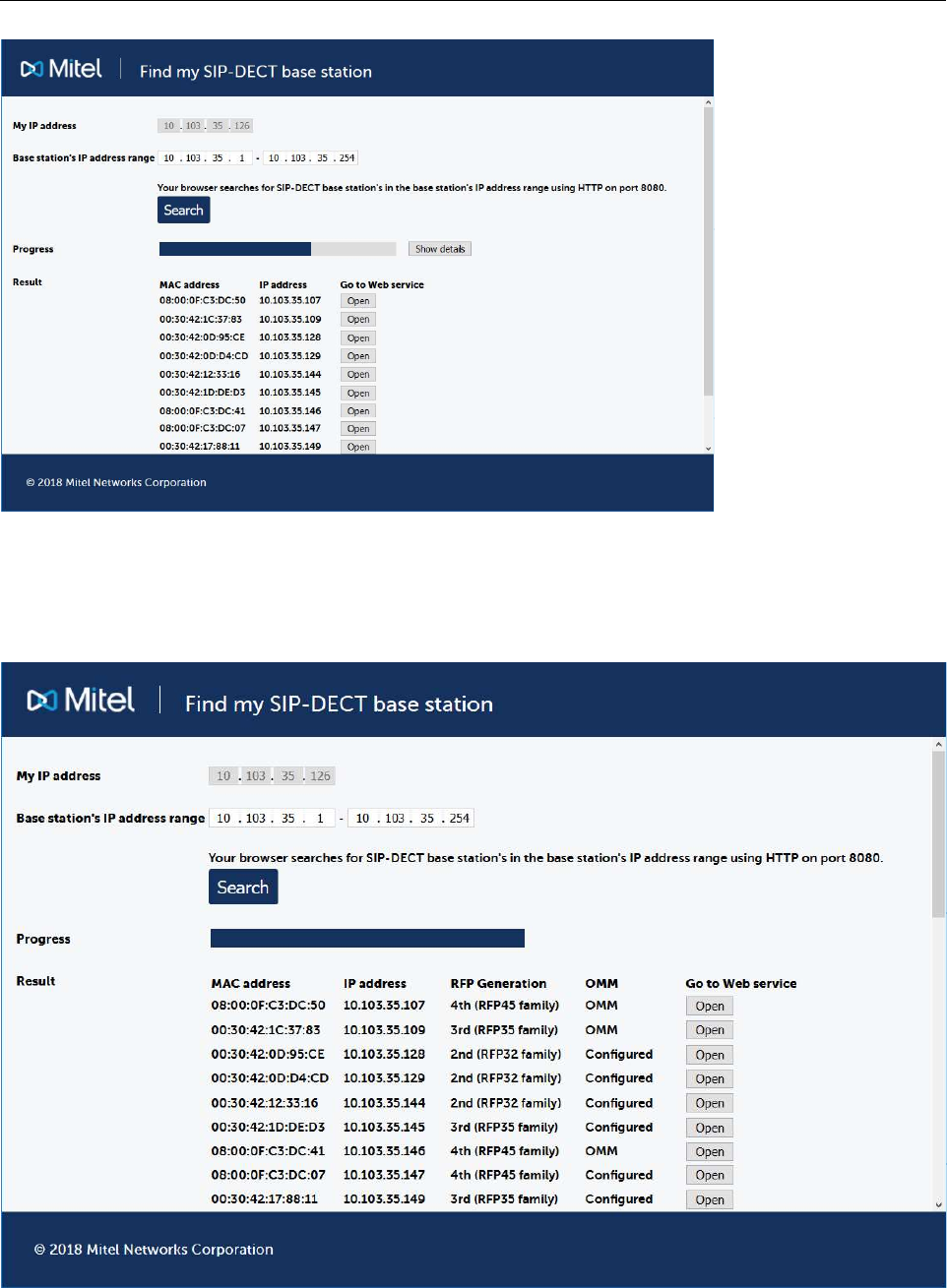
OMM Web Service
93
The results get listed with the base station MAC address, IP address and optionally the RFP generation
and configuration state. The configuration web GUI of the OMM running on the base station or the base
station that is assigned to, can be opened by clicking the Open button of the listed data record.
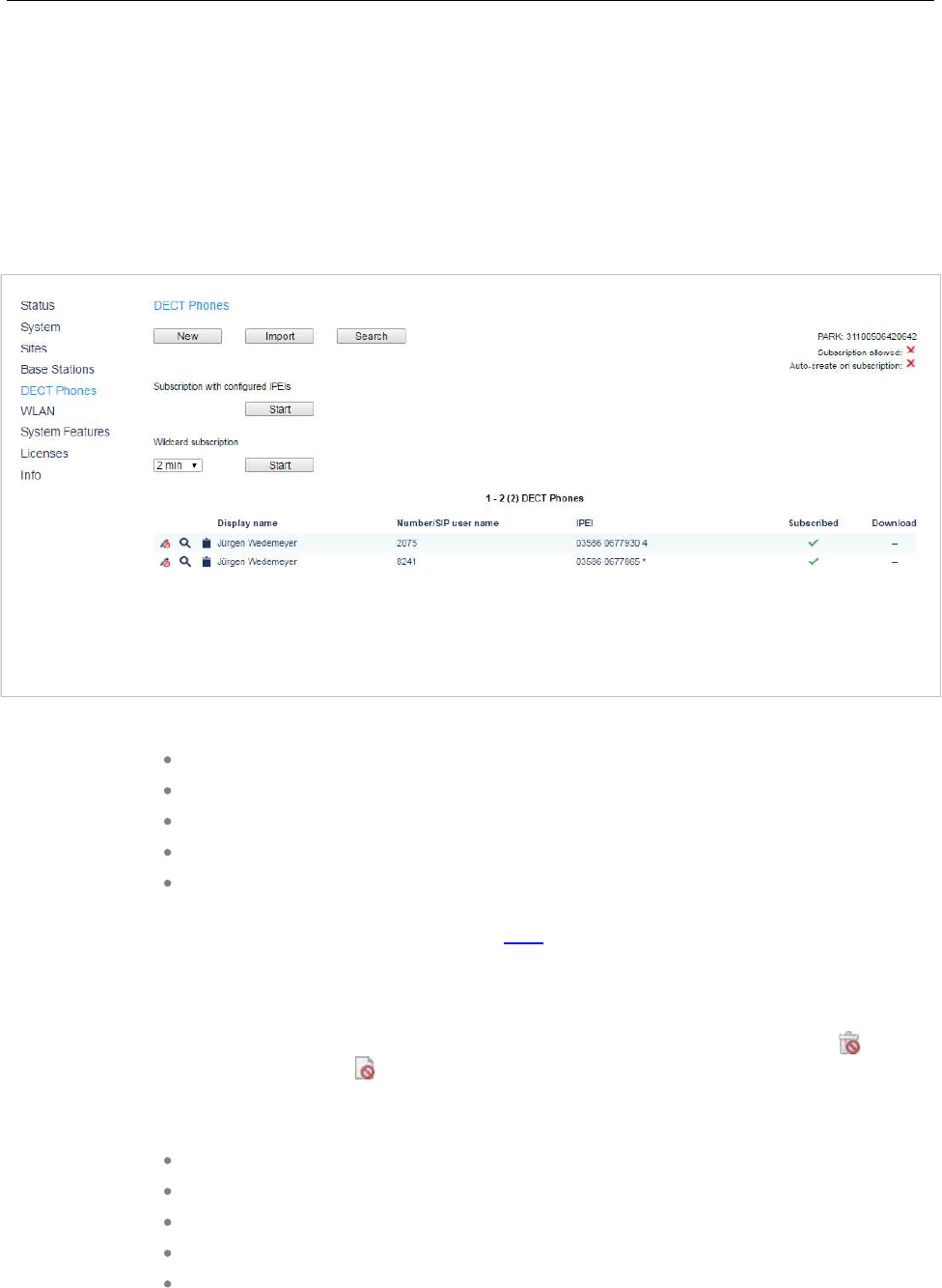
SIP-DECT OM System Manual
94
For Microsoft Edge, the Internet Properties needs to be changed. In the Security tab, for the ‘Local
intranet’ in the Advanced view of the Sites configuration, an entry ‘http://*.teqdomain.de’ (to be changed)
needs to be added.
5.7 “DECT PHONES” MENU
The DECT Phones page provides an overview of all configured DECT phones sorted by their number.
To keep the list concise, the complete list is split up into sub lists containing up to 100 DECT phones.
You can move back and forth in increments of 100 DECT phones.
The table provides information on the DECT phones and their status in several columns:
Display name: Indicates the DECT phone name.
Number/SIP user name: Indicates the internal call number of the DECT phone.
IPEI: Indicates the DECT phone IPEI.
Subscribed: Indicates if the DECT phone is subscribed to the system.
Download: This column is only displayed if the “Download over Air” feature is
started successfully and provides information about the download status of the
DECT phone software (see section 8.22).
Note: All DECT phone data that are configured as unbound (split into
DECT phone and user data) are also listed at the OM Web
service when a user is logged in at the DECT phone, but they
cannot be deleted or changed. This is indicated by the and
icons. Unbound DECT phones where no user is logged in are
not displayed on the DECT phones page.
The following tasks can be performed on the DECT Phones page:
create and change DECT phones (see section 5.7.1)
import DECT phone configuration files (see section 5.7.2),
subscribe DECT phones (see section 5.7.3)
delete DECT phones (see section 5.7.4)
search within the DECT phone list (see section 5.7.5)

OMM Web Service
95
5.7.1 CREATING AND CHANGING DECT PHONES
1To configure a new DECT phone, click the New button on the DECT phones page.
To change the configuration of an existing DECT phone click on the icon left beside the DECT
phones entry.
The New DECT phone or the Configure DECT phone dialog opens.
2Configure the DECT phone (see parameter descriptions below).
3Press the OK button.
The following parameters can be set in the New DECT phone and the Configure DECT phone dialog:
General settings
Display name: The name parameter represents the SIP Display Name field. This
parameter is optional but recommended.
Number/SIP user name: The number is the SIP account number or extension for
the DECT phone.
IPEI: This optional setting is the DECT phone IPEI number. On a Mitel DECT 142 /
Mitel 142d DECT phone, the IPEI can be found via the following path of the DECT
phone menu: Main menu >Phone settings >System. On a Mitel 600 DECT
phone, the IPEI can be found in the System DECT phone menu. Consult the DECT
phone’s user guide for further information.
DECT authentication code: The DECT authentication code is used during initial
DECT subscription as a security option and can be set here for each DECT phone
separately (DECT phone-specific DECT authentication code). This parameter is
optional. If no DECT phone-specific DECT authentication code is set, the system-
wide DECT authentication code is used.
Login/Additional ID: The additional ID can be used as a mean for data search
within wildcard subscription (because of the IPEI is not configured which selects the
data otherwise).
Delete subscription: This option is only available when configuring an existing
DECT phone (in the Configure DECT phone dialog). If this option is selected, the
DECT phone will be unsubscribed.
SOS number,ManDown number: SOS and ManDown are calling numbers which
will be automatically called as soon as an SOS or ManDown event happens. If no
individual SOS or ManDown number is configured for a DECT phone, the number of
the appropriate alarm trigger will be used as a system-wide calling number in case
of a SOS or ManDown event. Please see /31/ for details.
Voice mail number: The voice mail number is the number which will be
automatically called as soon as a voice mail call is initiated on the Mitel 600 DECT
phone. If there is no individual voice mail number configured in this field, then the
system-wide voice mail number is used (see also the System setting menu, section
5.4.1.9). If there is no voice mail number configured (neither the individual nor the
system-wide) or another DECT phone type is used, then the voice mail number
must be configured locally in the DECT phone.
Number used for visibility checks: Provides phone number or SIP user name
used for standby OMM visibility checks.

SIP-DECT OM System Manual
96
SIP authentication
User name: The SIP Authentication user name is optional but recommended. It
represents the name which will be used during SIP registration and authentication. If
no name is given the number will be used by default.
Password, Password confirmation: The password will be used during SIP
registration and authentication. Enter the appropriate data in these fields.
User service
Use SIP user name: Specifies whether the XSI user name is taken from the user's
SIP data. The generated format is <sip user name>@<sip registrar domain>.
Possible values are Global,On, or Off.
Use SIP user authentication: Specifies whether the XSI authentication name and
password are taken from user’s SIP data. The generated format is <sip
authentication name>@<sip registrar domain>. Possible values are Global,On, or
Off.
User name: Specifies the user’s user name for the XSI service (if Use SIP user
name is set to Off). The user name is part of the access url path of a XSI request
(e.g., /com.broadsoft.xsi-actions/v2.0/user/<service user
name>/directories/Enterprise?firstName=A*).
Authentication name: Specifies the name to authenticate the user for XSI services
(if Use SIP user authentication is set to Off).
Password,Password confirmation: Specifies the password to authenticate the
user for XSI services.
Key lock
Active: This enables the Key lock menu under System menu/Administration on the
Mitel 600d DECT phone. To prevent change of the time by the user disable the
feature here.
PIN, PIN confirmation: The DECT phone default PIN is set to 0000. It is the same
default PIN as for the local DECT phone feature. Adjust a new PIN here if the user
had forgotten its PIN.
Timer: The phone is locked automatically after the selected time (in seconds). If the
timer is set to None, the key lock is not automatically activated if the DECT phone is
not used, and the long press of the # key does not activate the key lock with PIN.
5.7.2 IMPORTING DECT PHONE CONFIGURATION FILES
A set of DECT phones can also be configured in a semi-automatic manner by import of a configuration
file.
1On the DECT Phones page press the Import button.
The DECT phone enrolment page opens.
2Select your configuration file and press the Import button. For information on the file layout, see
section 12.2.1.
3A parsing protocol can be read, if you press the referring Log file button. All successfully imported
data records are presented in a list.
4Select the DECT phones you want to add to the OMM database by selecting the appropriate
checkboxes, and click Add.

OMM Web Service
97
All successfully stored records are marked green in the Added column.
Failed records are marked with a red star.
5To read error hints in the referring log file, press the Log file button. Error hints can also be read in a
syslog trace.
6To remove imported data entries, activate the check box next to the desired entries. Press Delete to
remove the selected entries.
5.7.3 SUBSCRIBING DECT PHONES
Preparation by OMM Web service
After adding a DECT phone configuration to the OMM, the DECT phone must be subscribed. The OMM
must first be enabled to allow subscriptions from DECT phones. This is done by pressing the following
buttons on the DECT Phones page.
Start button under the “Subscription with configured IPEI” caption (see section
5.7.3.1). This button enables subscription for the next 24 hours.
Start button and time interval parameter under the “Wildcard subscription” caption.
This button enables wildcard subscription for the selected time. After expiry the
“subscription with configured IPEIs” is still enabled for 24 hours.
Note: To ease the first installation of a DECT system, the subscription
is enabled permanently while at least one DECT phone (with
IPEI) is set up in the database and no DECT phone is
subscribed. After successful subscription of the first DECT phone
the subscription will still be enabled for 24 hours. The time is
further limited if the feature 'Restrict subscription duration' is
active (see chapter 5.4.1.2 DECT settings).
Subscription steps, done by DECT phone
After the DECT phone configuration is complete on the OMM and the OMM is allowing new
subscriptions, each DECT phone must subscribe to the system.
On each DECT phone, the administrator or user must subscribe to the SIP-DECT system through the
System -> Subscriptions menu. The specific PARK code for the SIP-DECT system should be entered
to subscribe to the system.
Please note: The PARK is displayed in the top-right corner of the DECT Phones page.
Each SIP-DECT deployment has a unique PARK code.
If the administrator configured a global or device-specific DECT authentication code, the
administrator/user must enter in the code before the DECT phone subscribes to the system.
For “wildcard subscription”, an additional ID may be configured (see sub section Wildcard Subscription).
5.7.3.1Subscription with Configured IPEI
The DECT phone data to be assigned to the subscribing DECT phone are identified by the IPEI. The
identity of a DECT phone (IPEI) is already known by the system before the DECT phone attempts to
subscribe. Unknown DECT phones are not allowed to subscribe in this mode.

SIP-DECT OM System Manual
98
To enable subscriptions, click the Start button under the section Subscription with configured IPEIs
caption on the DECT Phones page.
The OMM allows a subscription of configured but not subscribed DECT phones during the next 24 hours.
The administrator must press the Subscribe button again to permit more DECT phones to subscribe to
the SIP-DECT system.
Note: Older DECT phones may not offer the possibility to enter an
access code (AC). You should always subscribe these DECT
phones with configured IPEI to maintain security. The time is
further limited if the feature 'Restrict subscription duration' is
active (see chapter 5.4.1.2 DECT settings).
5.7.3.2Wildcard Subscription
To minimize administration effort, subscription is also possible, if the IPEI is not configured. But because
of the loss of further security by IPEI check, this kind of subscription is only allowed within a short default
time interval of 2 minutes.
To enable subscriptions, press the Start button of the section Wildcard subscription on the DECT
phones page. If necessary, increase the time interval (or refresh subscription permission in time).
The OMM will allow a wildcard subscription during the set time interval. In case of timeout the permission
is lost. Only subscription with IPEI remains allowed within the fixed limit of 24 hours.
To achieve a selection of data during subscription (e.g. the user name being assigned to the DECT
phone), the field “additional ID” can be set in OMM data. If the OMM receives a valid “additional ID”
during subscription, the referring data are assigned to the DECT phone.
If the additional ID is requested for a data record, the DECT phone user must type it. “Additional ID” can
be set within the authentication code menu. Please type the R-Key and type the additional ID.
Note: The time is further limited if the feature 'Restrict subscription
duration' is active (see chapter 5.4.1.2 DECT settings).
Please note: The input of the additional ID is only possible with Mitel 142 and Mitel 600
DECT phones. The value is not supported on third party GAP phones. If GAP phones are
going to subscribe wildcard, the first free DECT phone data record without any additional
ID will be assigned.
5.7.4 DELETING DECT PHONES
To delete an existing DECT phone:
1On the DECT phone page click on the icon left beside the DECT phone entry.
The Delete DECT phone? dialog opens showing the current configuration of this DECT phone.
2Press the Delete button.

OMM Web Service
99
5.7.5 SEARCHING THE DECT PHONE LIST
You can use the search function to search for a specific DECT phone in the DECT phone list. The
search function allows you to find a DECT phone by a given number or IPEI.
1On the DECT phones page click on the Search button.
The Search DECT phone dialog opens.
2Enter the DECT phone’s number or IPEI. At least one parameter must be set. The entered number or
IPEI must match exactly with a DECT phone’s number or IPEI. If number and IPEI are given then a
DECT phone must exist in the OMM’s database whose number and IPEI match both otherwise the
search fails.
If a DECT phone with the specified number and/or IPEI was found, a list is displayed with this DECT
phone as the first entry. The search function can also be used to get to the right sub list in one step.
5.7.6 DISPLAYING USER AND DECT PHONE DATA
You can display a summary of user status and DECT phone configuration in a pop-up window on the
DECT Phone page. Click the magnifying glass icon beside a DECT phone entry to view the User/device
status & configuration window.
Note: A configuration and status summary for the DECT phone is also
available on the DECT phone under the Administration menu.
The presentation layout is similar to the OMM Web service
window, but the DECT phone only displays its own data.
The following table describes the parameters in the User/device status & configuration window.
Parameter Description
User status
Registered Current SIP user registration status
Yes = registered
No = not registered
Registrar server type Current SIP registrar: Primary or backup SIP registrar (secondary or tertiary)
Registrar server IP address of the SIP Registrar
Registrar port Port number of the SIP Registrar
Calculated local port SIP user’s automatically determined client port
Silent charging Current silent charging state
Yes = in silent charging mode
No = not in silent charging mode
CoA data loaded COA data sent to DECT phone
Yes = data has been sent
No = no data sent
User configuration data
User Id Internal system identifier for the user
User rel. Type Type of association between the user and DECT phone. Dynamic or fixed.
Name User’s name

SIP-DECT OM System Manual
100
Number SIP user name or number
Description 1 Additional textual description for a user (e.g., department or function)
Description 2 Additional textual description for a user (e.g., department or function)
User lang. Language setting on the DECT phone
SOS number Emergency number to be dialed when the SOS key has been pressed
MD number Emergency number to be dialed when a sensor alarm (Mitel 600 DECT phone) has
been initiated
VM number Voice mail number (dialed by a long press of ‘1’ key on the Mitel 600 DECT phone)
SIP auth. user name SIP authentication user name
SIP auth. password SIP authentication password
Fixed local port SIP user’s configured fixed client port (used for SIP registration)
Login/Add ID ID used for user identification during login procedure at the DECT phone OR
ID used for wildcard subscription during DECT phone subscription procedure
PIN PIN used for user identification during login procedure at the DECT phone
“*******” = a PIN is set,
empty = no PIN is set
External User data provided by an external provisioning server (<user>.cfg)
Yes = user data imported from a server
No = user data only stored internally in the OMM DB
Permanent Indicates whether the user is stored in all OMMs in a Multi-OMM Manager (MOM)
managed system.
Yes = user data is stored in all OMMs in the SIP-DECT system.
No = user data only stored in the local OMM (i.e., where the device is currently
registerd).
VIP To guarantee a minimum blackout for a very important person (e.g. emergency
user) the SIP (re-)registration of such people can be prioritized.
Yes = prioritized
No = not prioritized
Visibility checks The OMM standby feature uses an existing SIP account to check the availability of
the registrar.
Yes = this account is used
No = this account is not used
Hot desking supported Hot desking capability; only available for users with a dynamic association with a
DECT phone.
Yes = user is registered for hot desking on the call server.
No = user is not registered for hot desking on the call server.
Auto logout on charging A user can be logged out of the device automatically when the Mitel 600 DECT
phone is placed in the charger cradle.
Yes = automatic logout when put in charger
No = no automatic logout
Authenticate logout User log out requires authentication.
Yes = user logout with authentication
No = user logout without authentication
Sending messages User’s permissions to send text messages using the Mitel 600 DECT phone
Yes = user is authorized to send text messages
No = user is not authorized to send text messages

OMM Web Service
101
Sending vCards User’s permissions to send vCards using the Mitel 600 DECT phone
Yes = user is authorized to send vCards
No = user is not authorized to vCards
Receiving vCards Indicates whether the user accepts received vCards
Yes = incoming vCards are accepted
No = incoming vCards are not accepted
Video stream perm. User’s permissions to access video using the Mitel 602 DECT phone
Yes = user is authorized to access video
No = user is not authorized to access video
Locate User’s permissions to locate other users using the Mitel 600 DECT phone
Yes = user can locate other users
No = user cannot locate other users
Tracking Tracking forces the Mitel 600 DECT phone to indicate every change of the DECT
base station even in idle state
Yes = tracking is active
No = tracking is inactive
DECT locatable Permission to locate the user (i.e., through the SIP-DECT locating solution)
Yes = locating the user is permitted
No = not permitted
Keep personal dir. The local directory of the Mitel 600 DECT phone is usually the user’s personal
directory and is cleared at logout. If deleting the directory content is not desirable,
this option can be set
Yes = local directory is not cleared
No = local directory is cleared
Forward mode Mode of Call diversion or Call forwarding (Off, Immediately, Busy, No answer, Busy
& no answer)
Forward time Time delay in seconds before the incoming call is redirected.
Forward dest. Destination of the redirected call
Hold ring back time Time in minutes after which the user wants to be reminded of the connection on
hold
0 = Off, no reminder
Call waiting disabled An incoming call is signaled in-band if the user is otherwise engaged (Call waiting).
This feature can be disabled
Yes = call waiting is disabled
No = call waiting feature is active
Auto answer Enables or disables auto-answer on incoming calls. If auto answer is enabled, the
DECT phone plays a tone to alert the user before answering the call. If auto answer
is disabled, the DECT phone treats the incoming call as a normal call.
Microphone mute Enables or disables microphone muting when incoming calls are automatically
answered.
Warning tone Enables or disables a warning tone to play when the DECT phone receives an
incoming call on an active line. A short ringtone is played if there are no active calls.
If there is an active call in a “barge in” situation, the ringing will be in-band.
Allow barge in Allows/disallows how the DECT phone handles incoming calls while the DECT
phone is on an active call. When enabled an incoming call takes precedence over
an active call, by placing the active call on hold and automatically answering the
call. When disabled the DECT phone treats an incoming call like a normal call.
Monitoring mode SIP-DECT supports a “User Monitoring” feature to check the availability of a user to

SIP-DECT OM System Manual
102
receive calls or messages.
On = monitoring feature is active
Off = monitoring feature is not activated
Conference server type User-specific setting of the conference service to be used for three-way
conferencing
None = three-way conferencing is disabled
Global = OMM system setting is used (default)
Integrated = integrated conference server is used
Conference server URI URI for the external conference server
Use CoA profile ID of the CoA (Central DECT phone configuration over air) profile
Use SIP user name Uses SIP user name for XSI directory access
Use SIP user auth. Uses SIP authentication credentials for XSI directory access
User service user name User name for XSI service (if SIP credentials not used for XSI directory access)
User service auth name Authentication name for XSI service (if SIP credentials not used for XSI directory
access)
User service password Password for XSI service (if SIP credentials not used for XSI directory access)
Device status
IPEI International Portable Equipment Identifier (globally unique identifier of the DECT
phone)
HW type Hardware type of 600 DECT phone or 142d otherwise “unknown”
SW version Version of the software on the Mitel 600 DECT phone
Subscribed Subscription status of the DECT phone
Yes = DECT phone is subscribed
No = DECT phone is not subscribed
Encryption DECT encryption status
Yes = Encryption is enabled
No = Encryption is disabled
Capability ”Messaging” Messaging capability of the DECT phone
Yes = DECT phone supports messaging
No = DECT phone does not support messaging
Capability ”Enh.
Locating”
Enhanced locating capability of the DECT phone
Yes = DECT phone supports enhanced locating
No = DECT phone does not support enhanced locating
Capability ”Video” Video capability of the DECT phone
Yes = DECT phone supports video
No = DECT phone does not support video
Capability ”CoA profile” CoA capability (Central DECT phone configuration over air) of the DECT phone
Yes = DECT phone supports CoA
No = DECT phone does not support CoA
Device auto-created Auto-creation occurs when the DECT phone data set is automatically generated in
the OMM’s database at subscription time. No administrative task is required onthe
SIP-DECT system to subscribe a DECT phone in this auto-create mode.
Yes = DECT phone has been subscribed in auto-create mode
No = DECT phone has not been subscribed in auto-create mode

OMM Web Service
103
Default CoA profile
loaded
A default CoA profile (Central DECT phone configuration over air) can be sent to a
600 DECT phone
Yes = a default profile was sent
No = no default profile was sent
Device configuration data
Device ID Internal system identifier for the DECT phone
5.8 “WLAN” MENU
The WLAN menu allows you to manage the wireless LAN function of all WLAN capable RFPs that are
connected to the OMM. You can view and change wireless parameters and security settings to adapt the
WLAN configuration to suit your needs. You can also check how many and which wireless clients are
currently connected. Nevertheless, the WLAN function is only available for base stations of the type
RFP 42 WLAN and RFP 43 WLAN.
Note: You cannot activate the WLAN function for the OMM, even if the
OMM base station is an RFP 42 WLAN.
For a detailed description on WLAN configuration, see the section 8.18.
5.8.1 “WLAN PROFILES” MENU
WLAN settings are grouped in WLAN profiles. You need at least one WLAN profile that can be assigned
to one or more WLAN-RFPs. You can define more than one WLAN profile, to a maximum of 20 WLAN
profiles. You can manage / change the desired WLAN settings for a group of WLAN-RFPs by changing
their assigned WLAN profiles. Moreover, you can manage different settings, for example separate WLAN
profiles for different buildings, a special WLAN profile for temporary use, or WLAN profile for RFPs only
useable by guests.
Note the different WLAN profile types:
RFP type WLAN profile type
RFP 42 WLAN RFP 42
RFP 43 WLAN RFP 43
RFP 48 WLAN RFP 48
HT40 (RFP 43/48 WLAN only): Very high throughout mode with 80 MHz bandwidth
increases data rate up to 1300 MBit/s (3x3 MIMO).
HT80 (RFP 48 WLAN only): Includes the HT40/HT20 bandwidth setting. A channel
with a bandwidth of 80 MHz occupies 4 WLAN channels with a bandwidth of 20
MHz.
The WLAN profiles menu allows configuration and administration of these WLAN profiles.
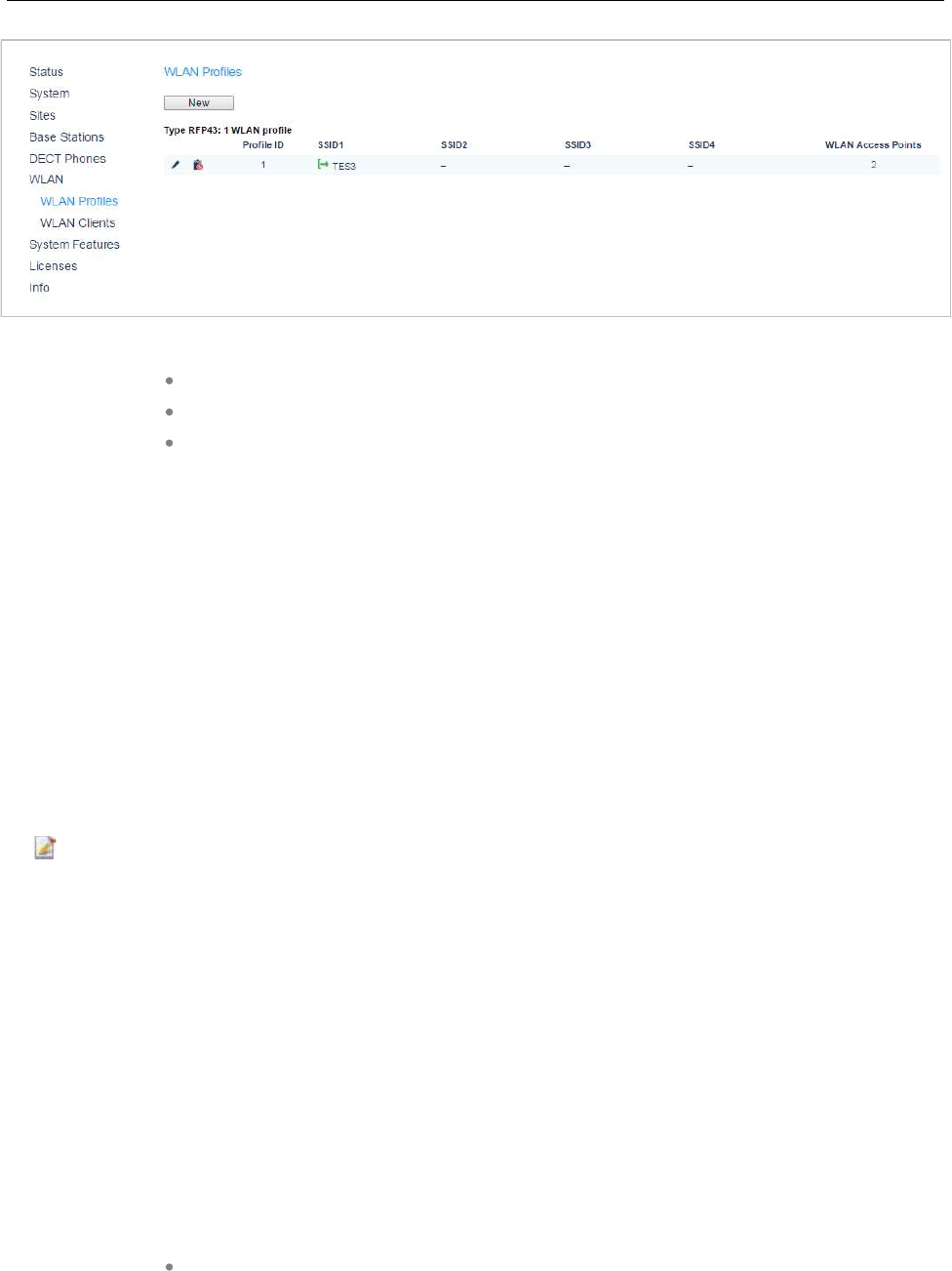
SIP-DECT OM System Manual
104
You can:
create and change WLAN profiles (see section 5.8.1.1)
delete WLAN profiles (see section 5.8.1.2)
export WLAN profiles (see section 5.8.1.3)
The defined WLAN profiles are then assigned to one or more WLAN base stations (see section 5.8.2).
Note, that some device-specific WLAN settings are not part of a WLAN profile, such as the channel and
the antenna configuration. These settings are defined separately for each base station (see section
5.6.3).
5.8.1.1Creating and Changing WLAN Profiles
You need at least one active WLAN profile in order to operate the WLAN function for an
RFP 42/43/48 WLAN device.
1Navigate to the WLAN profiles page. This page shows the number of existing WLAN profiles and a
list of available WLAN profiles.
2If you create a new WLAN profile, configure the RFP type first to get the correct input fields. Select
the appropriate profile (RFP 42, RFP 43 or RFP 48) from the WLAN profile type selection list.
3To add a new WLAN profile, press the New button. To change an existing WLAN profile, click on the
icon available on the left of the WLAN profile entry.
The New WLAN profile page resp. the WLAN profile [Number] page shows the WLAN profile
configuration.
4Change the desired settings of the WLAN profile. You need at last to define the ESSID setting. The
different settings are explained in detail in the sections below.
5Activate the Profile active setting; otherwise the WLAN profile is inactive which de-activates the
WLAN function for base stations that are assigned to this WLAN profile.
6Press the OK button to apply the settings. If you created a new WLAN profile, you can proceed by
assigning the WLAN profile to the desired base stations (see section 5.6.3). If you changed an
existing WLAN profile, the settings are applied to the assigned base stations automatically.
The following parameters are available on the New WLAN profile page and on the WLAN profile
[Number] page:
General settings
Profile active: Activate this checkbox to activate the profile. This in turn activates
the WLAN function for all RFPs that are assigned to the WLAN profile.

OMM Web Service
105
SSID: Enter a descriptive character string to identify the WLAN network (e.g.
“OurCompany”).The service set identifier is broadcasted by the RFP within “WLAN
beacons” in a regularly interval. The SSID identifies the WLAN network and is
visible by all WLAN clients. This is typically used with a scan function, e.g. from a
WLAN client that tries to establish a connection. The SSID should not exceed 32
characters and it is advisable not to use unusual characters that may trigger WLAN
client software bugs.
VLAN tag (number, 1..4094, default: off): You can separate VoIP and client data
traffic (transferred via WLAN) by using different virtual LANs, e.g. to prevent bulk
data transfers to interfere with VoIP. To use a separate VLAN for the client data
traffic, activate the check box and enter the desired VLAN number (see sections
8.18 and 8.12).
Beacon period (milliseconds, 50..65535, default: 100 ms): Determines the WLAN
beacon interval. A higher value can save some WLAN airtime that can be used for
data transfers.
DTIM period (number, 1..255, default: 5): Determines the number of beacons
between DTIM messages. These messages manage the WLAN wakeup/sleep
function e.g. that is critical for battery powered WLAN clients.
RTS threshold (bytes, 0..4096, default: 2346): If a WLAN packet exceeds this
threshold, it will be transferred with RTS/CTS handshake. This may improve transfer
reliability if several WLANs share the same channel. The default of 2346 byte
switches off this function because the IP-MTU is typically only 1500 byte.
Fragmentation threshold (bytes, 0..4096, default: 2346): If a WLAN packet
exceeds this threshold, it will be transferred in chunks. This may improve transfer
reliability for a weak connection. The default of 2346 bytes switches off this function
because the IP-MTU is typically only 1500 byte. This option is now unavailable for
RFP 48.
Maximum rate (list of rates in Mbps, 1..54, default: 54): This setting applies to
RFP 42 WLAN only. Determines the maximum transfer rate used by the RFP. You
can limit the rate to increase the WLAN range, e.g. to prevent WLAN clients in the
vicinity of the RFP to disturb distant WLAN clients.
802.11 mode (RFP 42 WLAN selection list: Mixed / 802.11b only / 802.11g only,
default: Mixed): Both the older and long-ranged B-Mode and the newer and faster
G-Mode are typically supported by WLAN clients. You can change this setting to
prevent problems with very old WLAN clients.
(RFP 43/48 WLAN selection list: 802.11bg /802.11b only / 802.11g only /
802.11abg /802.11n, default: 802.11bg): On the RFP 43/ RFP 48 profile you can
choose additionally 802.11 modes 802.11abg, 802.11n and the mode 802.11ac is
only available for RFP 48 WLAN.
Mode 802.11abg 802.11n/802.11ac
Open yes yes
WEP yes no
WPA v.1 (802.1x + PSK) yes no
WPA v.2 (802.1x + PSK) yes yes

SIP-DECT OM System Manual
106
Hidden SSID mode (on / off, default: off): If switched on, the transmission of the
SSID within beacons is suppressed. This in turn requires a more elaborate and
manual connection procedure for WLAN clients.
Interference avoidance (on / off, default: off): This setting applies to RFP 42 WLAN
only. Enables a WLAN procedure to enhance radio interference avoidance.
Security settings
These settings determine the encryption used for the WLAN connection. Select one of the four modes
(Open, WEP, WPA, or Radius). This will activate / gray-out the necessary additional input fields that
specify further security settings on the WLAN profile page.
Open system: Enable this option to deactivate authentication and encryption (“Hotel
mode”). Note, that all data is transferred un-encrypted in this mode, which can be
easily eavesdropped with any WLAN equipment.
Wired equivalent privacy (WEP): Enable this option to use the older WEP
encryption mode. This mode may be useful, e.g. if your WLAN should support older
WLAN clients that do not implement the recommended WPA encryption.
–Privacy (on / off, default: off): De-activate this setting to use no authentication
(“Open System”) with standard WEP encryption. Activate this setting to use an
additional shared key authentication between the RFP and the WLAN client.
–Number of tx keys (number, 1..4, default: 1): The WEP encryption can use a
single shared key or multiple shared keys (“key rotation”). Select the number of
shared keys, select how to enter a shared key (by default as Text or as Hex
value), and select the Cipher length (see Key settings below).
–Default tx key (number, 1..4, default: 1): If more than one shared keys is used,
you can select the default shared key. You must configure the same default
key on the WLAN client.
–Key #1 –Key #4: Enter one or more shared key. The Cipher length setting
(see Key settings below) determines the length of the required input. If you
selected to enter as Text (see above), input a password with 5, 13, or 29
characters that matches a 64 or 128 bit cipher. If you selected to enter as Hex
value, you can input a hexadecimal number with 10, 26, or 58 characters (0-9,
a-f). Press the Generate button to generate a random shared key that matches
the current settings.
WiFi protected access (WPA): Enable this option to use the recommended WPA
encryption mode.
– (selection, WPA any / WPA v.1 / WPA v.2, default: WPA any): Select the WPA
Type version required for WLAN clients. The WPA any setting allows WPA v.1
and WPA v.2 to be used concurrently. The WPA v.1 setting enforces the use of
the older RC4-based encryption. The WPA v.2 setting enforces the use of the
stronger AES encryption. You can also change the distribution interval (see
Key settings below).
–802.1x (Radius): Select this option if your WLAN should use a RADIUS server
for WLAN client authentication (“Enterprise WPA” with different
username/password combinations per client). You must also specify the (see
below). For details about the RADIUS authentication procedure, using the
public keys, and importing certificates to the WLAN clients see the Radius
settings documentation of your RADIUS server product.

OMM Web Service
107
–Pre-shared key: Select this option to use a single shared key for all WLAN
clients (Value setting below). A WLAN client user needs to enter the shared
key in order to connect.
–Value: You can enter a shared key as Text. Use a longer text sequence with
alphanumeric characters and special characters to enhance the shared key
strength. A text shared key is case sensitive. Alternatively, the shared key can
be entered as Hex value (hexadecimal number, 0-9, a-f). Press the Generate
button to generate a random shared key that matches the current settings.
MAC access filters (on / off, default: off): This setting applies to RFP 43 WLAN
only. You can limit WLAN access for WLAN clients with specified MAC addresses.
Note, that without encryption this should not be used for security reasons. You can
configure a list of MAC addresses that are allowed to connect via the MAC access
filters tab on the WLAN profile page.
BSS isolation (on / off, default: off): In a standard WLAN setup, each WLAN client
can contact other WLAN clients. For special purposes (e.g. “Internet café setup”),
you may switch on this options to protect WLAN clients from eavesdropping on
other WLAN clients.
Key settings
Cipher length (selection, 64 Bits / 128 Bits / 256 Bits (RFP 42 WLAN only), default:
64 Bits): Determines the key length used for the WEP encryption. Larger bit
sequences provide better security but may be unsupported by very old WLAN
clients.
Distribution interval (seconds, 60..86400): Determines how often the WEP
encryption is re-negotiated.
Radius settings
The parameters in this section can only be configured if the 802.1x (Radius) configuration is used.
IP address: Enter the IP address of the RADIUS server.
Port: Enter the port number used to connect to the RADIUS server. Press the
Default button to change to the standard port.
Secret: Enter the character string that is used by the RFP to secure the
communication with the RADIUS server.
QoS settings
WME: (on / off, VLAN or DiffServ (RFP 42 WLAN only), default RFP 42 WLAN:
off/VLAN, default RFP 43 WLAN: off): You can enable the Wireless Media
Extensions to prioritize WLAN traffic. The WLAN traffic priority is determined by
VLAN number or by examining the DiffServ data field of IP packets.
SSID2 – SSID4 Tabs
You can enable up to three additional virtual WLAN networks that are managed by their SSID. This can
be used for example to provide WLAN access for guests that is separated from the company WLAN by
means of VLAN tags and encryption settings. To activate this feature proceed as follows:
1Switch to the appropriate SSID tab, e.g. SSID2. Activate the Active check box to enable the
additional virtual WLAN. The tab provides separate configuration items for the selected SSID.
2Enter at least a new SSID. Also enter a currently unused VLAN tag number.

SIP-DECT OM System Manual
108
3You can specify different authentication/encryption settings for each SSID section. For example, you
can use WPA /Pre-shared key with different passwords.
Note that some configuration combinations are incompatible with multiple SSIDs. For example, the
wireless hardware only manages a single WEP encryption key. Also, some features apply to all defined
SSIDs, including the MAC access filters list.
You can edit the MAC access filters list via the MAC access filters tab on the WLAN profile page.
You can import a prepared list of MAC addresses (*.txt. file, one line per MAC
address) Use the Browse button to select the file from the file system. Afterwards
press the Import button.
To configure single MAC addresses, use the New button in the General settings
section. Enter the address in the following New MAC access filter dialog.
To delete a single MAC address, click on the icon left behind the address entry.
Use the Delete all button to delete the entire list.
Using the Save button you can export the MAC address filter list.
The Associate column indicates for each MAC address if the respective WLAN client is currently
connected to the WLAN.
5.8.1.2 Deleting WLAN Profiles
To delete an existing WLAN profile:
1You cannot remove WLAN profile that is in use. To remove a currently used WLAN profile, you must
select another WLAN profile for all assigned RFPs first (see section 5.6.3).
2On the WLAN profiles page click on the icon next to the profile entry.
The Delete WLAN profile? dialog opens showing a summary of the WLAN profile’s configuration.
3Press the Delete button.
5.8.1.3Exporting WLAN Profiles
To simplify the configuration of wireless devices, you can export SSID configuration to a XML WLAN
profile file. To export the configuration, click on the icon.
On Windows 7 you can use the “netsh wlan add profile filename=xxx” command to import a WLAN
configuration. Many other tools to import WLAN configuration files are available for Windows Vista /
Windows XP systems (for example wlan.exe from Microsoft).
5.8.2 “WLAN CLIENTS” MENU
The WLAN clients page shows the status of all WLAN clients currently connected to the WLAN. This
can be used for example for troubleshooting purposes. The display shows the total number of connected
WLAN clients and a list of RFPs that are part of the WLAN. For each RFP, the WLAN client connected to
the RFP are listed. You can view the MAC address and the current Status of each WLAN client.
5.9 “SYSTEM FEATURES” MENU
The System features menu allows administration of system features concerning call number handling
and directory access.

OMM Web Service
109
5.9.1 “DIGIT TREATMENT” MENU
A number manipulation is provided by the digit treatment feature for corporate directories that handles
both incoming and outgoing calls.
Digit treatment for LDAP directories
A chosen number from an LDAP directory entry is checked against the external prefix pattern and if a
pattern matches, it is replaced by the configured internal prefix pattern. Only the best matching rule will
be applied.
Before a rule is applied, the following characters are automatically removed from the LDAP directory
entry: ‘%’, space, ‘(’ and ‘)’. The result of the conversion is sent to the DECT phone to be displayed e.g.
in the directory entry details and entered in the redial list.
Note: A conversion performed for an LDAP directory entry can be
reversed if the rule is also activated for an outgoing call.
Incoming call
The calling party number of an incoming call is checked against the configured external prefix pattern
and if a pattern matches it will be replaced by the internal prefix pattern. Only the best matching rule will
be applied.
The result of the conversion is sent to the DECT phone to be displayed and entered in the call log1.
Outgoing call
The dialed number of an outgoing call is checked against the configured internal prefix pattern and if a
pattern matches it will be replaced by the external prefix pattern. This applies to en-bloc dialed numbers
and to overlap sending as long as the SIP session has not been initiated.
Note: To support digit treatment and overlap sending, it is necessary to
have a dial terminator configured.
The result of the conversion is not sent to the DECT phone to be displayed or entered in the call log2.
The following tasks can be performed on the Digit treatment page:
creating and changing “Digit treatment” entries (see section 5.9.1.1)
deleting “Digit treatment” entries(see section 5.9.1.2)
5.9.1.1Creating and Changing “Digit treatment” Entries
1To configure a new entry, click the New button on the Digit treatment page.
To change the configuration of an existing entry click on the icon left beside the entry.
The New digit treatment entry or the Configure digit treatment entry dialog opens.
2 External pattern: Enter an external prefix pattern with up to 32 characters that matches an incoming
call number or a number received via a directory entry. The prefix to be substituted for calling party
1For Incoming Call/Calling Party Number: Depending on the capabilities of the DECT phone and the
level of integration.
2For Outgoing Call/Called Number: If the user dials the number from the redial list again, the same
procedure will be applied as for the initial dialing.
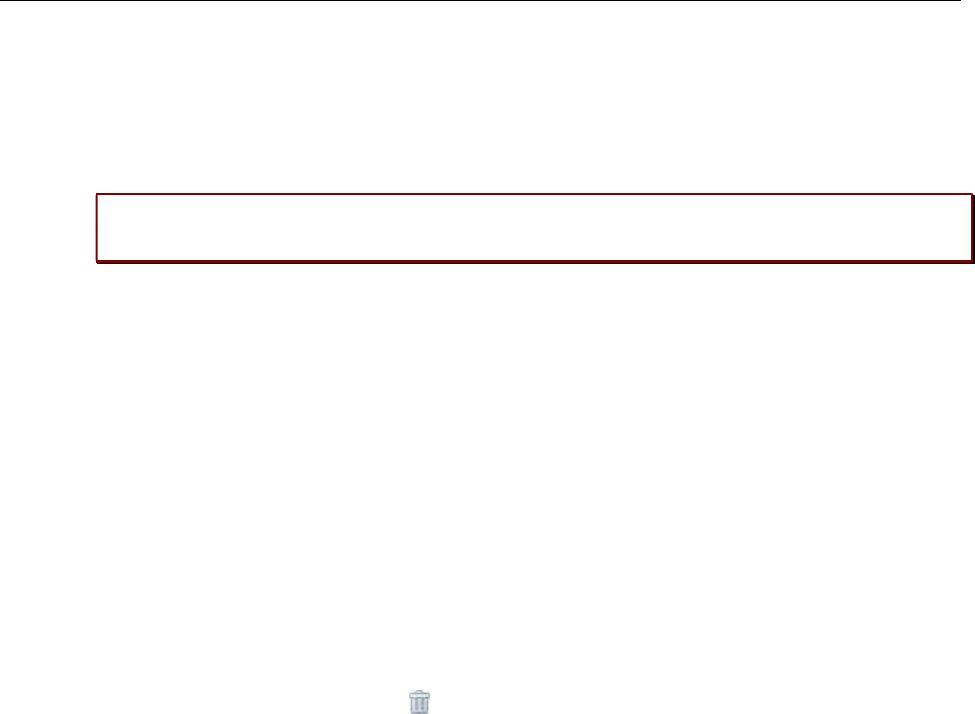
SIP-DECT OM System Manual
110
numbers has the same character set as the user telephone number (e.g., :”+*~#,;.-
_!$%&/()=?09aAzZ”).
3 Internal pattern: Enter an internal prefix pattern with up to 32 characters that replaces the external
pattern for the directory entry / incoming calls or vice versa for outgoing calls. An internal prefix
pattern can be composed of characters “*”, ”#” and “0” – “9”.
Please note: The plus character (“+”) can only be dialed and transferred to a call log with a
Mitel 600 DECT phone.
4 Direction: Select one of the following options:
– “Incoming calls”: Rule applies on incoming calls.
– “Outgoing calls”: Rule applies on outgoing calls.
– “Incoming and outgoing calls”: Rule applies on incoming and outgoing calls.
– “Apply on directory only”: Rule applies to directories only.
5 Directory: This option can be used to specify the rule for incoming and/or outgoing calls. Activate this
option if the rule applies to directories.
6 Sites: Specifies the sites for which a rule is applied e.g. “1, 2” (see section 5.5). If set to “0”, the rule
applies to all sites i.e. the rule will be applied to all calls or corporate directory requests.
7Press the OK button.
5.9.1.2 Deleting “Digit treatment” Entries
To delete an existing entry:
1On the Digit treatment page click on the icon left behind the entry.
The Delete digit treatment entry? dialog opens showing the current configuration of this entry.
2Press the Delete button.
5.9.2 “DIRECTORY” MENU
The Directory menu allows you to manage connections to one or more LDAP, XML or XMI servers to
support central corporate directories. The OMM supports multiple LDAP, XML or XSI servers with
specific parameter settings to support different types of directories (e.g. global corporate directory, group
specific directory, personal directory). XML-based directory services can be implemented using the XML
terminal interface.
If there is more than one directory server configured, all are displayed on the DECT phone interface
when the user invokes the Central Directory function. The user can choose one of the entries in the list.
The name of an entry shown in the list is configured in the OMM when creating the directory server
entry. The OMM determines the display order of the directories in the DECT phone menu by the order
specified by the administrator.
You can configure up to five external directories. If only one directory server is configured, the name
configured in the OMM is ignored, and the directory is accessed directly when the user presses the
System softkey on the DECT phone (>>>) or selects the Central directory option from the menu.

OMM Web Service
111
5.9.2.1Creating and Changing Directory Entries
You can configure directory entries (or change existing entries) from the Directory page (or the
Directory (comp. mode) page for older SIP-DECT systems) in the OMM web interface. Parameters that
require configuration depend on the type of directory you are configuring.
To change the configuration of an existing entry click the Edit icon ( ) beside the entry, and follow the
steps described below to set parameter values.
You can change the order of the directory entries by selecting a directory entry in the list and clicking the
up or down arrows in the right panel (under Tasks). Changing the order of directory entries in the list
changes the order in which they appear on the DECT phone.
To create or edit a directory entry, do the following:
1Select the Directory entry in the System Features menu (left pane).
2Click New on the Directory page, or click the pencil icon beside an existing directory entry in the list.
The New directory entry (or Configure directory entry) dialog opens.
3Specify values for the directory server as described in the following table. Note that only certain
paremters are required, depending on the directory server type.
Parameter Description LDAP XML XSI
Active Enables or disables the directory entry on the DECT phone.
Type Interface type supported by the directory server. Possible values:
LDAP
XML
XSI Enterprise
XSI Enterprise common
XSI Group
XSI Group common
XSI Personal
Name Name to be displayed for the directory (Latin-1 character set is
supported).
Search base Location in the directory from which the search begins (e.g.,
”ou=people, o=my com”).
The configuration is valid for all DECT phones that support the
LDAP directory feature. To make search requests unique for
different users, the search base configuration can include
placeholders that are replaced by user-specific values when
submitting the LDAP request to a server.
The following placeholders are defined:
“<TEL>” (for the user’s telephone number)
“<DESC1>” (for the user’s “Description 1” attribute)
“<DESC2>” (for the user’s “Description 2” attribute)
“SIPProxy” (for the current primary, secondary or tertiary SIP
server address); supported for release 6.1 and later
Search type Attribute on which searches are performed (Surname or Given
name).
Display type Display mode for search results (Surname, First Name or Given
name Surname).
Server search timeout Interval (in seconds) during which the OMM waits for search
results from the LDAP server (1 – 10 seconds).
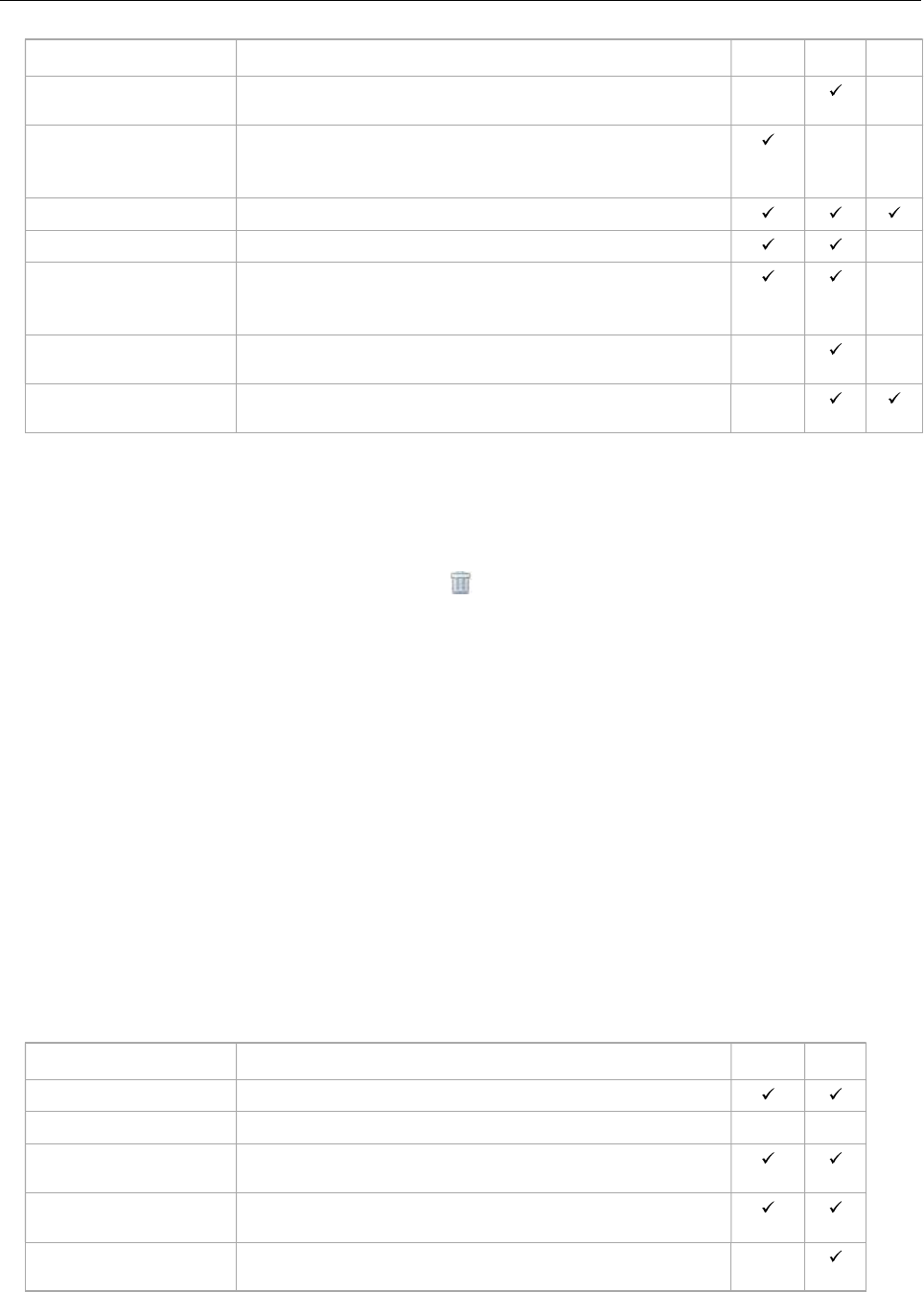
SIP-DECT OM System Manual
112
Parameter Description LDAP XML XSI
Protocol Transfer protocol used to communicate with the XML or XSI
directory server (http or https).
Server port Port for the LDAP directory server (default is 389).
Note: SSL (default port 689) is not supported. Windows Active
Directory Server uses port 3268.
Server IP address or FQDN of the directory server.
User name Name of the account for directory server access, if required.
Password Password for directory server access, if required.
Note: If no user/password is specified, an anonymous bind takes
place. SIP-DECT supports LDAP simple bind.
Path (and parameters) URL (with parameters, if required) to the XML directory on the
XML directory server.
Use common certificate
configuration
Enables or disables use of the system’s certificates (loaded for
provisioning purposes) for HTTPS directory access
4Click OK to save your changes.
5.9.2.2Deleting Directory Entries
1To delete an existing directory entry click on the icon on the left of the entry on the Directory page.
The Delete directory entry dialog opens showing the current configuration of this entry.
2Press the Delete button.
5.9.3 “DIRECTORY (COMP. MODE)” MENU
In SIP-DECT 6.2 and later, the underlying database model for directory support in SIP-DECT has
changed. To support backwards compatibility, the Directory (comp. mode) page provides directory
configuration and maintenance for existing SIP-DECT systems with LDAP or XML directory support.
To create or edit a directory entry using the old database model, do the following:
1Select the Directory (comp. mode) entry in the System Features menu (left pane).
2Click New on the Directory (comp. mode) page, or click the pencil icon beside an existing entry.
The New directory entry (or Configure directory entry) dialog opens.
3In the New directory entry dialog (or the Configure directory entry dialog, for existing entries),
specify values for the directory server as described in the following table. Note that only certain
paremters are required, depending on the directory server type.
Parameter Description LDAP XML
Active Enables or disables the directory entry on the DECT phone.
Order Specify where you want the directory entry to appear in the list.
Type Interface type supported by the directory server. Possible values:
LDAP or XML.
Name Name to be displayed for the directory (Latin-1 character set is
supported).
Protocol Transfer protocol used to communicate with the XML directory
server (HTTP or HTTPS).
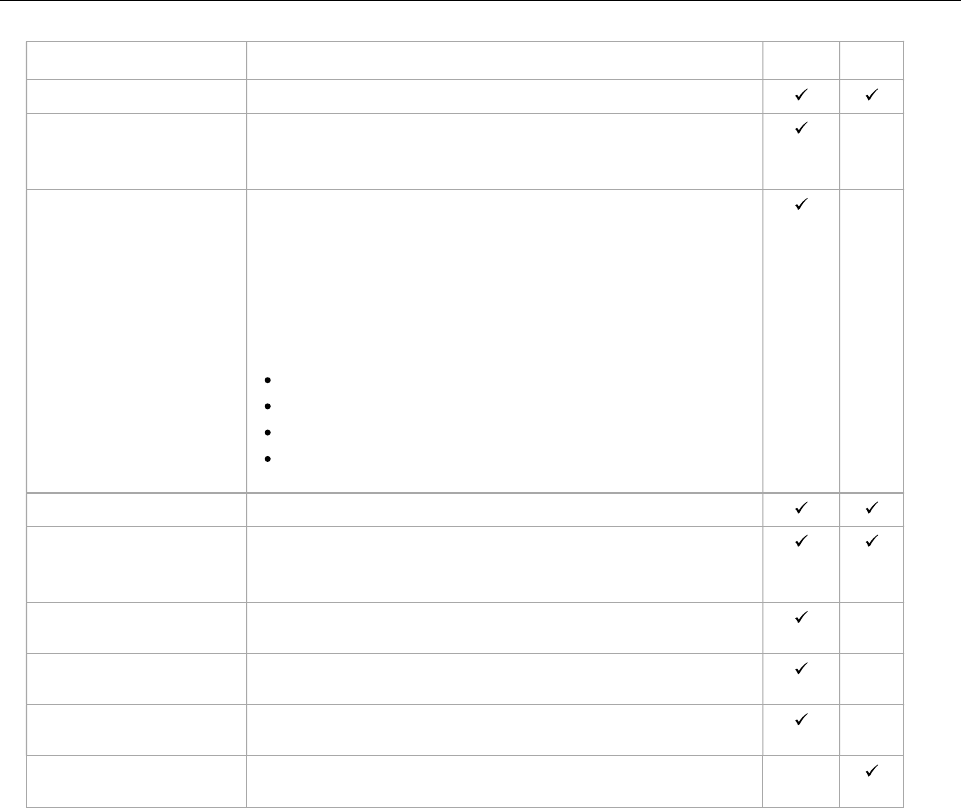
OMM Web Service
113
Parameter Description LDAP XML
Server name IP address or FQDN of the directory server.
Server port Port for the LDAP directory server (default is 389).
Note: SSL (default port 689) is not supported. Windows Active
Directory Server uses port 3268.
Search base Location in the directory from which the search begins (e.g.,
”ou=people, o=my com”).
The configuration is valid for all DECT phones that support the
LDAP directory feature. To make search requests unique for
different users, the search base configuration can include
placeholders that are replaced by user-specific values when
submitting the LDAP request to a server.
The following placeholders are defined:
“<TEL>” (for the user’s telephone number)
“<DESC1>” (for the user’s “Description 1” attribute)
“<DESC2>” (for the user’s “Description 2” attribute)
“SIPProxy” (for the current primary, secondary or tertiary SIP
server address); supported for release 6.1 and later
User name Name of the account for directory server access, if required.
Password Password for directory server access, if required.
Note: If no user/password is specified, an anonymous bind takes
place. SIP-DECT supports LDAP simple bind.
Search type Attribute on which searches are performed (Surname or Given
name).
Display type Display mode for search results (Surname, First Name or Given
name Surname).
Server search timeout Interval (in seconds) during which the OMM waits for search
results from the LDAP server (1 – 10 seconds).
Path (and parameters) URL (with parameters, if required) to the XML directory on the
XML directory server.
4Click OK to save your changes.
5.9.4 “FEATURE ACCESS CODES” MENU
Feature access codes (FAC) allow a DECT phone user to perform specific actions on the OMM from any
subscribed DECT phone.
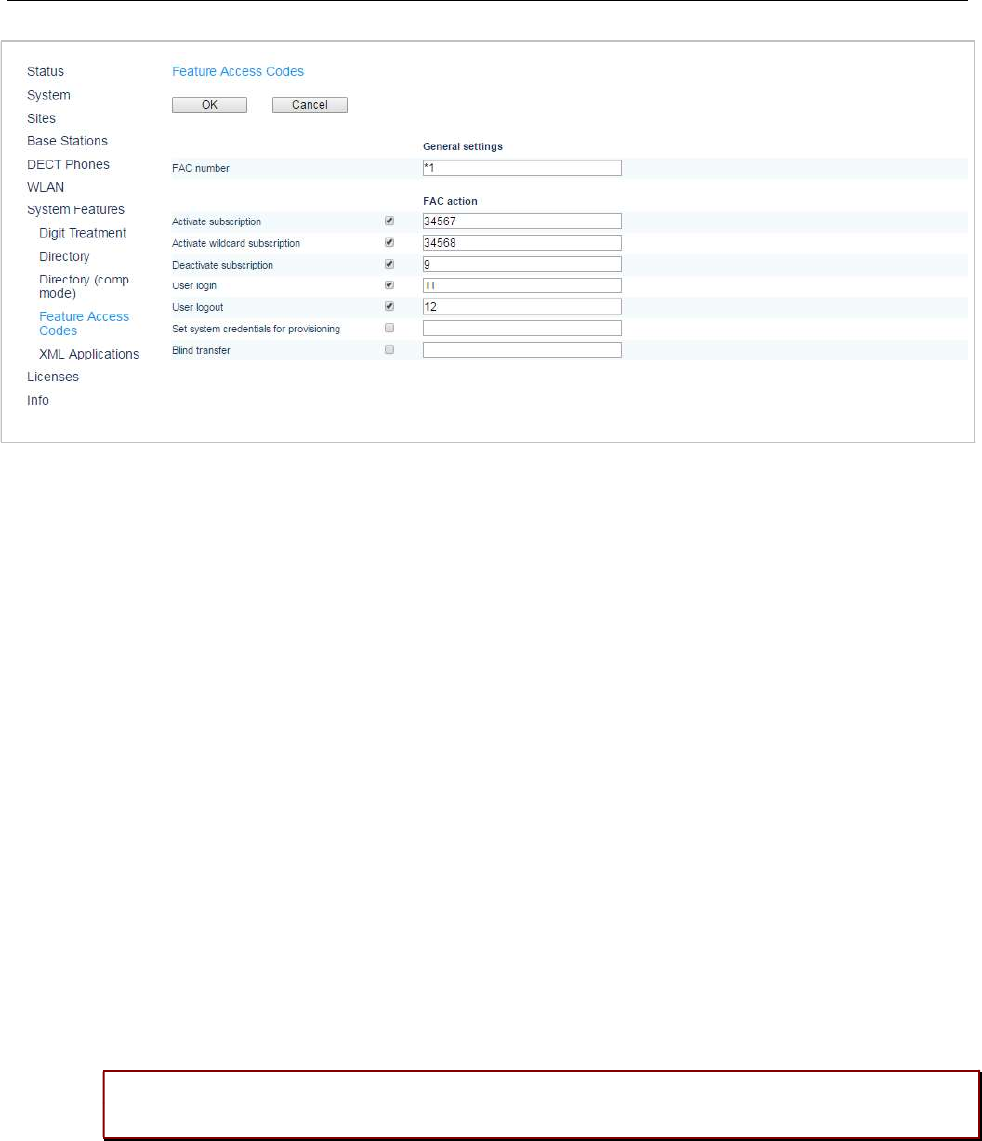
SIP-DECT OM System Manual
114
To configure the FAC feature, do the following:
1 FAC number: Enter a unique FAC number.
2Activate the appropriate checkbox(es) to enable the corresponding FAC feature(s). For each enabled
FAC feature enter an assigned access code.
–Activate subscription: Activate subscription of the DECT phone.
–Activate wildcard subscription: Activate subscription of the DECT phone (if
no IPEI is configured).
–Deactivate subscription: De-activate DECT phone subscription.
–User login: Log the user into the DECT phone.
–User logout: Log the user out of the DECT phone.
–Set system credentials for provisioning: Allow a user to set system
credentials via the Mitel 600 DECT phone.
–Blind transfer: Initiate a blind transfer from the DECT phone. When a user
dials the “Blind transfer” FAC en-bloc (in an active call state) followed by a
target number, SIP-DECT initiates a blind transfer to the given target number.
3Press the OK button.
Users can perform the relevant operations by dialing the “FAC number” followed by the “FAC access
code” en-bloc from any subscribed DECT phone.
In the example above a subscribed user can activate the OMM DECT subscription by dialing “*134567”
en-bloc.
Please note: Overlap sending is not supported for FAC. “FAC number” and “FAC action
code” must be entered en-bloc.
FAC functions will be confirmed by an audible indication to the user (in-band tone signals).
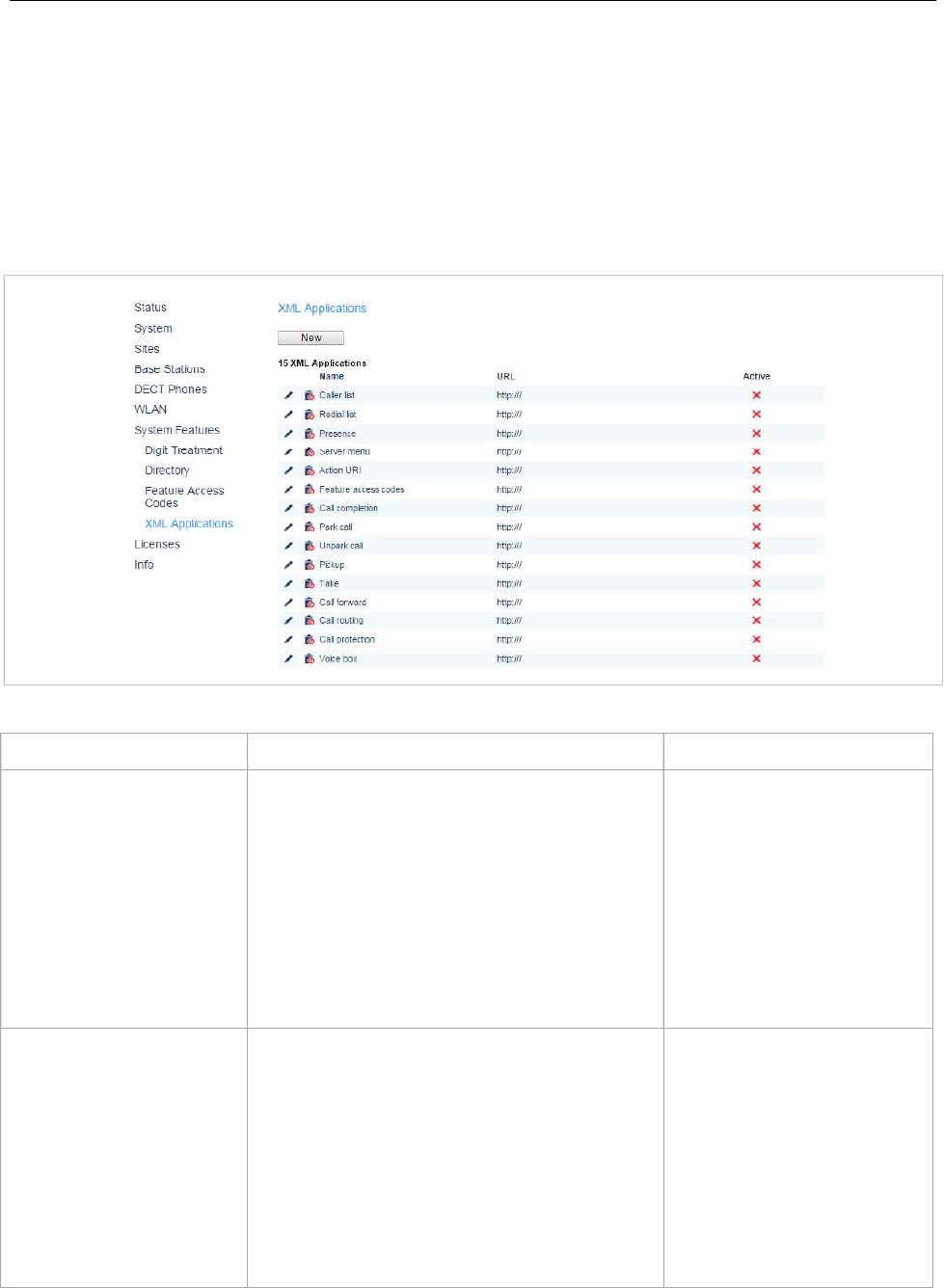
OMM Web Service
115
5.9.5 ”XML APPLICATIONS” MENU
The SIP-DECT XML terminal interface allows external applications to provide content for the user on the
Mitel 600 DECT phone. To make the XML terminal interface applications available for the DECT phone
user, you must configure the appropriate hooks in the XML Applications menu.
When the application hook is enabled in the OMM, Mitel 600 DECT phone users can program a softkey
with the specific hook (or select the relevant menu option) to trigger the associated action. The side keys
on the Mitel 600 DECT phones only display icons in idle state. In an active call state, only the two
softkeys below the display indicate the active feature.
The following table summarizes the predefined XML application hooks:
Hook Description DECT Phone menu
Caller list Hook to replace the local caller list.
You can use this hook to enable the centralized call
log feature (MX-ONE systems only).
”Call log support provided on an external server":
The call logs are located on an external XML server.
Each call log action on the DECT phone is requested
to the external XML server and the server answers this
with XML responses. The content is displayed on the
DECT phone for the user.
The URL-path in the configuration differs from
"CSIntegration?object=history" which is an indication
for the OMM centralized call log feature.
>>> >Info >Caller List
Redial list Hook to replace the local redial list.
You can use this hook to enable the centralized call
log feature (MX-ONE systems only).
"OMM centralized Call log support provided by the
OMM internally":
The call logs are pushed from the PBX (e. g. Mitel MX-
One) to the OMM through SIP and the OMM provides
the call logs for all the DECT phones as an "XML
server".
The URL-path in the configuration be
"CSIntegration?object=history" which is an indication
for the OMM centralized call log feature.
>>> >Info >Redial List

SIP-DECT OM System Manual
116
Hook Description DECT Phone menu
Presence Hook to reach a presence application . >>> >Presence
Server menu Hook to reach a server menu. The OMM system menu
is available as a menu entry in the local main menu of
the DECT phone (>>> softkey). If no user is assigned
to the DECT phone, the server menu is the only
available XML application hook.
>>> >Info >Server
Action URI URI to be called in case of user/device events. The
URI is configured in the OMM via OMP. Content can
be pushed towards the DECT phone via SIP notify.
n/a
Feature access codes Hook to provide Feature Access Codes translation.
Call completion Hook to provide callback option when a user places an
outgoing call and wants to request a callback before
releasing the call.
>>> >Info >Calback
Park call Hook to the Park Call service interface. >>> >Call option >Park call
Unpark call Hook to the Unpark Call service interface. >>> >Unpark call
Pickup Hook to the Pickup Call service interface. >>> >Pickup
Take Hook to Take Call service interface. >>> >Take
Call forward Hook to the Call Forward service interface. >>> >Call forward
Call routing
(Mitel 602 DECT phones only)
Hook to the Personal Call Routing service interface. >>> >Call routing
Call protection
(Mitel 602 DECT phones only)
Hook to the PBX call protection service interface. >>> >Call protection
Voice box Hook to Voice Mail service interface. >>> >Info >Voice box
These hooks can be activated or deactivated but not deleted. You can create up to 10 additional hooks.
Note: The “Call forward” XML hook replaces the “Call forwarding /
diversion” supplementary service. When activated, the “Call
forwarding / diversion” supplementary service is automatically
deactivated and all user-specific settings are removed.
5.9.5.1Creating a New XML Hook
To create a new XML hook, do the following:
1On the XML Applications page, click New.
The New XML application window opens.
2Configure the following parameters for the XML hook:
Active: Activates or deactivates the XML hook.
Name: Name for the XML hook (not applicable for predefined XML hooks)
Protocol: HTTP or HTTPS.
Server: IP address or name of the server which provides the XML content.
SIP-DECT 6.0 and later supports “SIPProxy” placeholders for XML Server
application URLs in systems with SIP redundancy. Where applications are located
on a SIP server, XML applications must be addressed using the current primary,
secondary or tertiary SIP server address. In those cases, the “SIPProxy”
placeholder can be used as server input.
User name: Login user name if an authentication is required by the server.

OMM Web Service
117
Password, Password confirmation: Password if authentication is required by the
server.
Path (and parameter): Path and query of the URI. For “Feature access codes
translation”, the Path settings contains placeholders for the queried translation:
{subsc} = Number, {ppn} = Device ID, {fac} = FAC.
3Click OK to save your changes.
5.9.5.2 Modifying an XML Hook
To change the configuration of an existing XML hook, do the following:
1On the XML Applications page, click on the Edit (pencil) icon beside the XML hook entry.
The Configure XML application window opens.
2Edit the XML application parameters (described above) as necessary. Note that you cannot change
the name of a predefined XML hook.
Note: SIP-DECT 7.0 and later supports centralized call logs for
systems using the MX-ONE call server. To enable this feature,
you must enter ”CSIntegration?object=history" as the value for
the Path parameter. This applies to both the Caller list and
Redial list predefined XML hooks.
3Click OK to save your changes.
5.9.5.3 Deleting an XML Hook
You cannot delete any predefined XML hooks. You can only delete XML hooks that you have created.
To delete an XML hook, do the following:
1On the XML Applications page, click on the Delete (garbage can) icon beside the XML hook entry.
The Delete XML application? window opens.
2Click Delete to confirm deletion of the XML hook.
5.10 “LICENSES” MENU
The Licenses page provides an overview on the currently used license. On this page you can also
import an activation or license file:
1Select the path and file name where the activation or license key is stored.
2Click the Import button.
For a detailed description on the OMM licensing model, see section 3.3.
5.11 “INFO” MENU
The Info page displays the End User License Agreement (EULA).
With the first login to a new SIP-DECT software version, this page is displayed automatically and the
user must accept the EULA by clicking the Accept button.
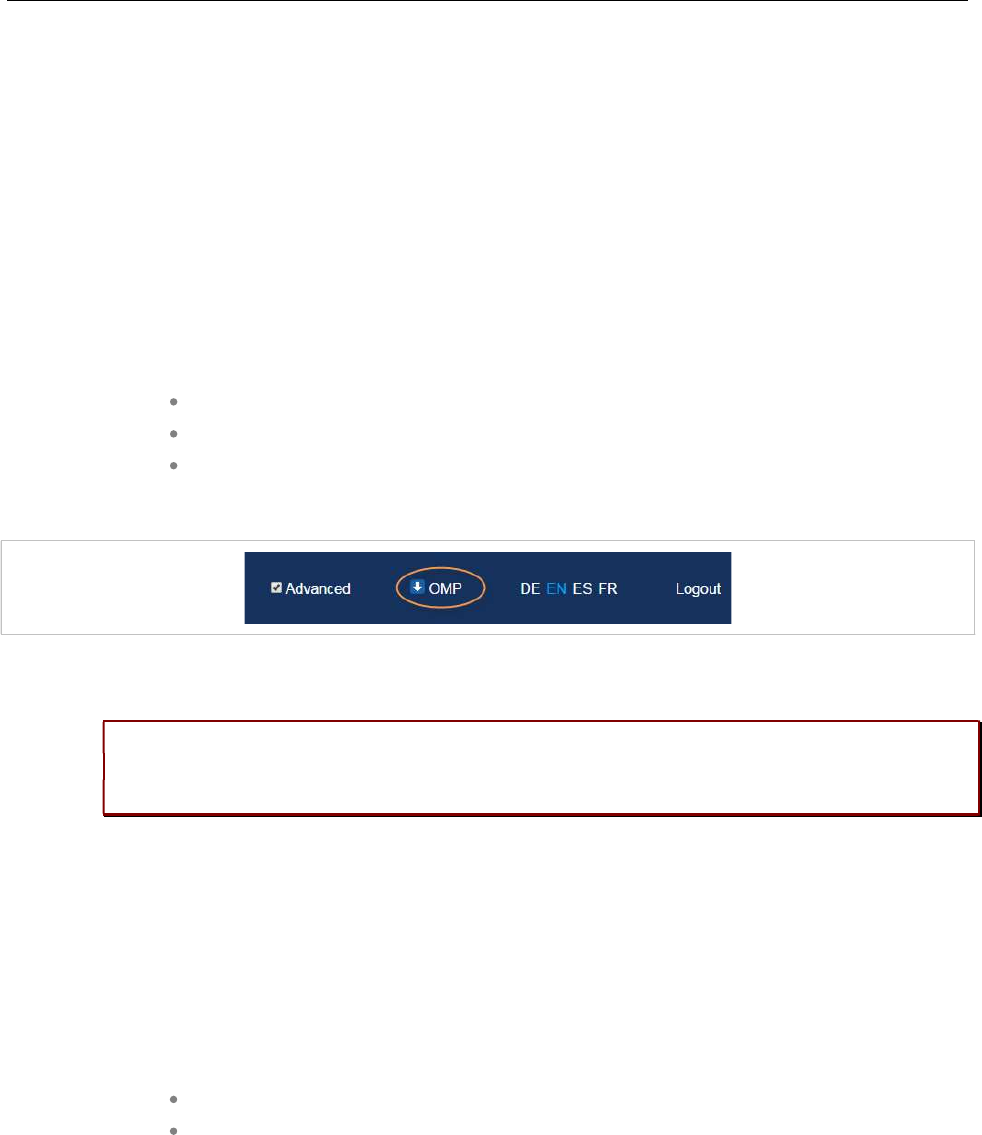
SIP-DECT OM System Manual
118
6 OM MANAGEMENT PORTAL (OMP)
The OM Management Portal (OMP) is a Java tool used to manage the SIP-DECT solution. It can be
used to view and configure OMM system data and has integrated monitoring and other maintenance
features.
SIP-DECT supports Java web start to start the OMP. Java 1.7 is required to run OMP 5.0 or later. By
default, the source for the OMP binary is a Mitel web server (RFP-OMM) or the OMP.jar from the RPM
installation (PC-OMM).
You can also configure a different source (System settings -> OMP web start in the OMM Web service,
or System -> Advanced settings -> Additional services – OMP web start in the OMP). The following
configuration order is used:
GUI-configured OMP web start URL in RFP-OMM installations
Environment variable ‘OM_WebStartUrl’ (e.g. set by ipdect.cfg configuration file)
Mitel web server (RFP-OMM) / from RPM installation (PC-OMM)
You can download the OMP jar file from the OMM Web service by clicking on the OMP link in the top
bar:
Double-click on the downloaded file (OMP.jnlp) and click “Run” in the dialog window. The OM
Management Portal starts and prompts for login credentials.
Please note: Configuration of a non-default source must not contain login credentials
because this is not supported by the Java Web Start mechanism. The HTTP/FTP server
must be configured accordingly.
This section lists all parameters which can be configured and viewed using OMP. All parameters which
are also accessible by the OM Web service are described in the appropriate OM Web service section
(section 5). New parameters which are only accessible via OMP are described in this section.
6.1 LOGIN
The OMM allows more than one user at a time to configure the system.
To log in to the system enter the following data:
IP address of the OMM.
User name,Password: Enter a user name and a password. Both strings are
checked case sensitive.
With initial installation or after removing the configuration file, the OMM Web service is accessible via
a default built-in user account with user “omm” and password “omm”.
The System name is set by the system administrator after first successful login to the OMM, see section
6.5.1.

OM Management Portal (OMP)
119
The system name and the IP address of successful logins are stored in the local OMP preferences and
can be reselected for further logins. Up to 10 different login datasets can be stored.
On a Linux system, preferences are stored in the user’s home directory
“~/.java/.userPrefs/…”.
On a Windows system, preferences are stored in the registry node
“HKEY_CURRENT_USER/Software/JavaSoft/Prefs/…”.
After login the OMP is set to the configuration mode page showing the system status page which
contains health state information of the connected OMM (see section 6.4). If there is a version difference
between the OMP and the OMM, this will also be indicated here. Details can be viewed in the Help:
About AXI menu (see section 6.15).
6.2 LOGOUT
There is no automatic logout for the OMP. The user must log out manually.
To log out from the system:
Click on the Close icon in the upper right corner of the OMP window
Select the Exit entry from the General drop-down menu.
Note: If the OMM link is broken, the OMP asks if you want to reconnect
to the OMM. In that case, you must enter the login data again.
6.3 OMP MAIN WINDOW
The header of the OMP window shows the version of the connected OMM.
“OMP mode” toolbar buttons
The OMP provides different modes: Configuration mode, Monitor mode and Planning mode.
Configuration mode allows changing of parameters. In monitor mode, parameters are only displayed, but
are not changeable. Monitor mode provides additional features, e.g. system and RFP statistics and RFP
synchronization monitoring. Planning mode enables the creation of graphics which can be used with the
OM Locating application to visualize the placement of the RFPs (see also /27/).
To select the desired mode, press the appropriate button in the upper toolbar of the OMP window:
Configuration mode
Monitor mode
Planning mode
Main menus
The OMP provides two main menus which are available in all program situations:
General menu, see section 6.14.
Help menu, see section 6.15.
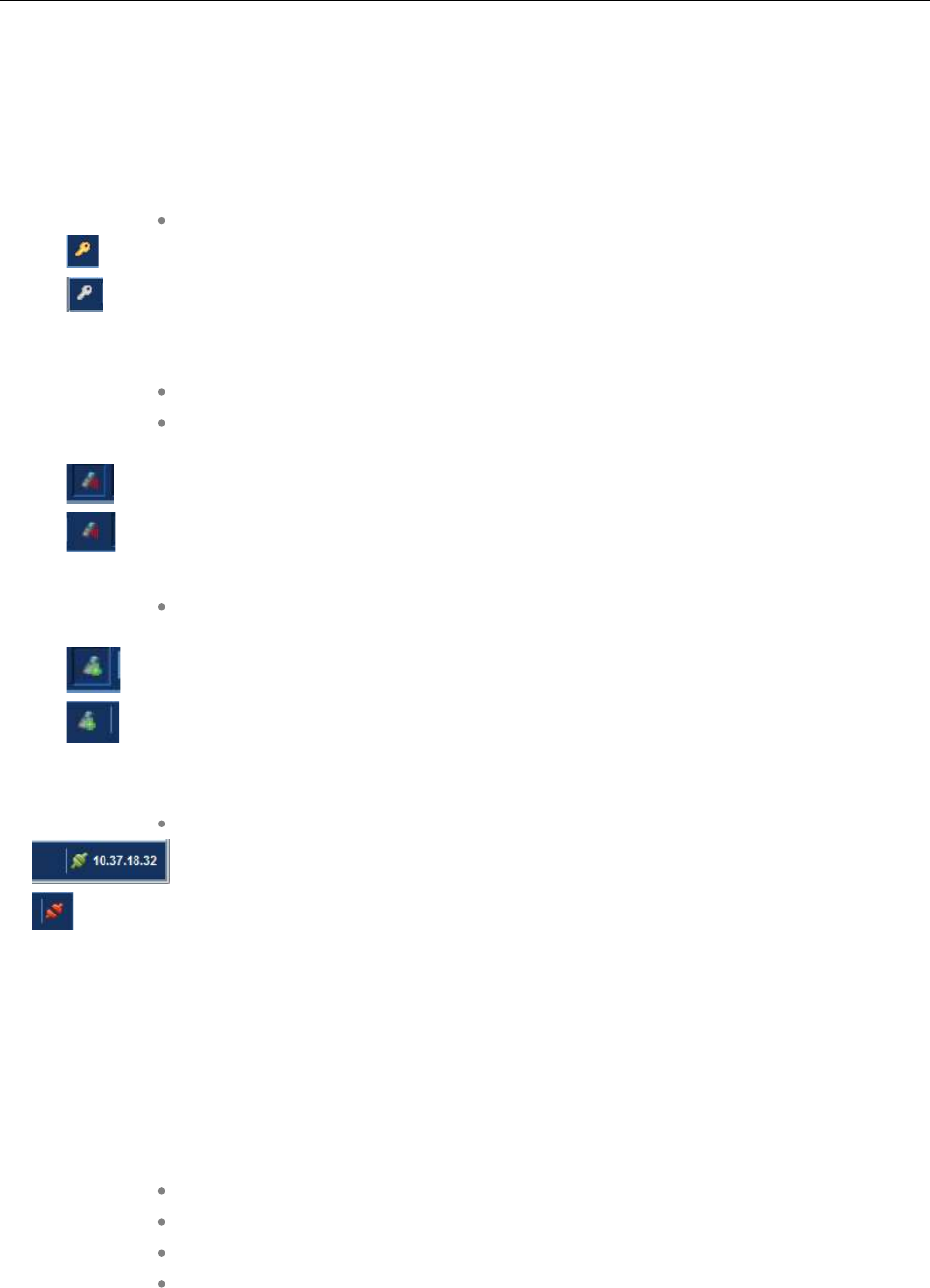
SIP-DECT OM System Manual
120
Navigation panel
Both configuration and monitor mode contain a navigation panel. This panel contains the mode-
dependant menu.
Status bar
The status bar is located at the bottom of the main window. It shows the following items:
Encryption state:
The icon indicates that encryption is enabled.
The icon indicates that encryption is disabled.
This setting can be configured in the DECT tab of the System settings menu (see also section
6.5.1).
PARK,
Subscription state: Clicking on one of the following icons enables / disables
subscription.
The icon indicates that subscription is enabled.
The icon indicates that subscription is disabled.
Subscription can also be enabled / disabled in the DECT phones menu (see also section 6.7.8).
Auto-create on subscription state: Clicking on one of the following icons enables /
disables Auto-create on subscription.
The icon indicates that Auto-create on subscription is enabled.
The icon indicates that Auto-create on subscription is disabled.
This setting can also be configured in the DECT tab of the System settings menu (see also section
6.5.1).
Connection status to the OMM:
If connected to the OMM, the IP address of the OMM is displayed.
OMP is disconnected from the OMM.
Info console
General OMP events are displayed the Info console.
6.4 “STATUS” MENU
The system status is displayed after startup of OMP. The Status panel provides information about the
system health states, and contains the following tabs:
Overview (see section 6.4.1)
DECT base stations (see section 6.4.2)
Users (see section 6.4.3)
Devices (see section 6.4.4)
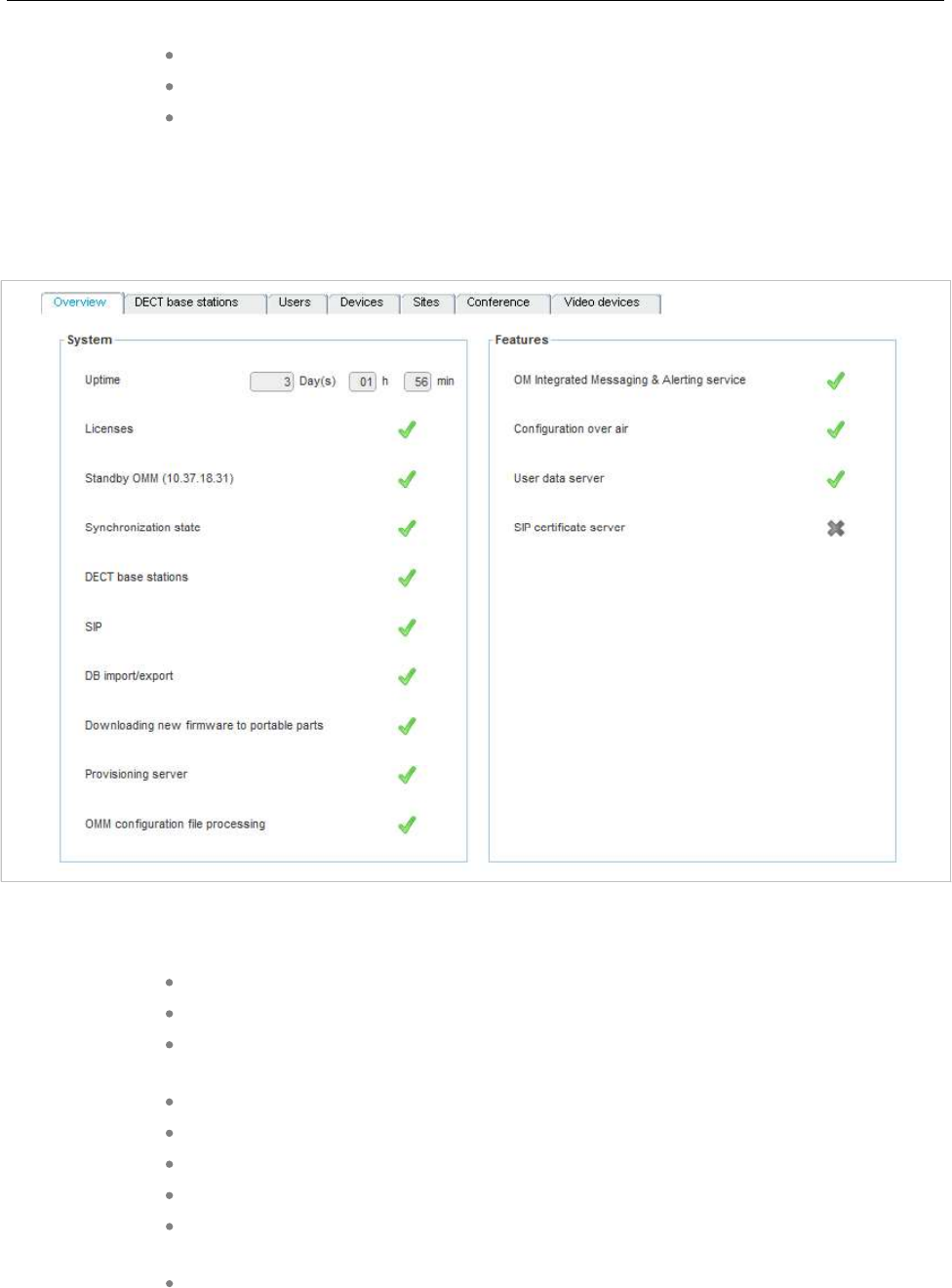
OM Management Portal (OMP)
121
Sites (see section 6.4.5)
Conference (see section 6.4.6)
Video devices (see section 6.4.7)
6.4.1 OVERVIEW
The “Overview” tab consists of a “System” panel providing general system health states information and
a “Features” panel which shows health states of system features. Some of these features are optional;
that means the relevant health state is only shown if the feature is activated in system.
The “Overview” tab shows following system information:
System uptime: Elapsed time since OMM start (in days, hours and minutes)
Licenses: Licenses health state
Standby OMM: Standby OMM IP address and health state of standby configuration
(if no standby OMM is configured a grey cross is shown)
Synchronization state: Synchronization health state
DECT base stations: Base stations health state
SIP: SIP health state
DB import/export: DB import/export health state
Downloading new firmware to portable parts: (Health) state of firmware
download to DECT phones
Provisioning server: Health state of provisioning server health state
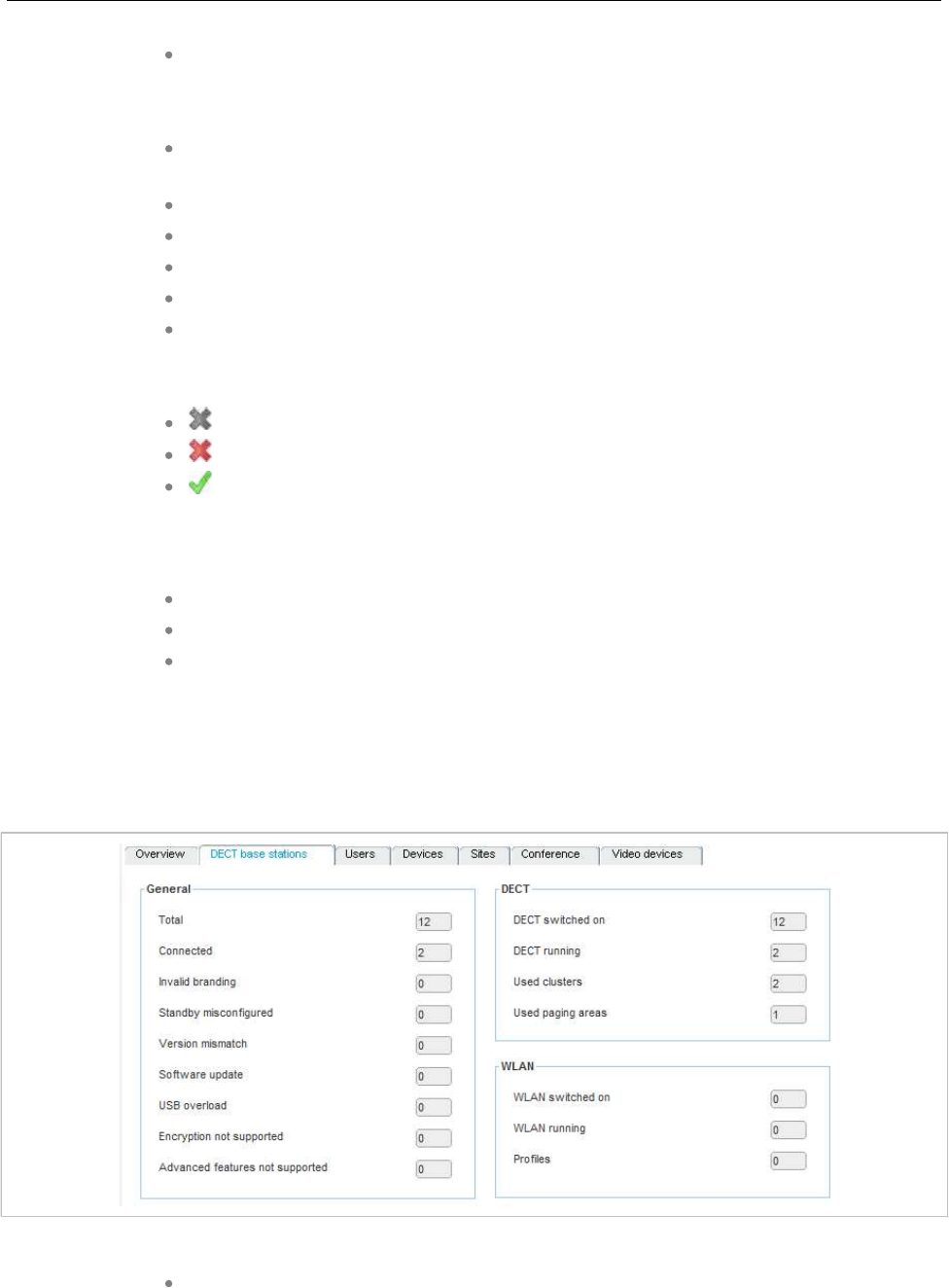
SIP-DECT OM System Manual
122
OMM configuration file processing: Health state of configuration file processing.
Depending on OMM system configuration, the “Features” tab consists of all or a subset of these health
states:
OM Integrated Messaging & Alerting service: Messaging and alerting feature
health state (always active)
SIP certificate server: SIP certificate server health state (always active)
Configuration over Air: Central DECT phone configuration over air state (optional)
User data server: User data server health state (optional)
User monitoring: User monitoring health state (optional)
Video: Video health state (optional)
Health states can have the following values:
– inactive or unknown
– error
– OK
6.4.1.1 OMM Standby Configuration
OMM standby configuration must be built of the same RFP generations. Valid configurations are:
RFP4G <- Standby -> RFP4G
RFP3G <- Standby -> RFP3G
Linux Server/OVA <- Standby -> Linux Server/OVA
In previous releases, OMM standby configuration is not available for SIP-DECT with Cloud-ID, that is, in
SDC mode.
6.4.2 DECT BASE STATIONS
The “DECT base stations” tab contains the following sections: “General”, “DECT” and “WLAN”.
The “General” panel provides counters related to RFP configuration and state:
Total: Total number of RFPs configured

OM Management Portal (OMP)
123
Connected: Number of RFPs connected to OMM
Invalid branding: Number of connected RFPs with invalid branding
Standby misconfigured: Number of connected RFPs with wrong standby
configuration
Version mismatch: Number of connected RFPs running with wrong software
version
Software update: Number of connected RFPs requesting software update
USB overload: Number of connected RFPs detecting overload at their USB port
Encryption not supported: Number of connected RFPs not supporting encryption
Advanced features not supported: Number of connected RFPs not supporting
“Advanced features” which covers “Hi-Q audio technology”, “Terminal video”,
“Enhanced DECT security” and “SRTP”.
The “DECT” panel provides counters related to RFPs DECT configuration and state:
DECT switched on: Number of configured RFPs with DECT switched on
DECT running: Number of connected RFPs with DECT running
Used cluster: Number of configured clusters
Used paging areas: Number of paging areas used by RFPs
The “WLAN” panel provides counters related to RFPs WLAN configuration and state:
WLAN switched on: Number of configured RFPs with WLAN switched on
WLAN running: Number of connected RFPs with WLAN running
Profiles: Number of WLAN profiles used by RFPs
6.4.3 USERS
The “Users” tab provides information about DECT phone users.
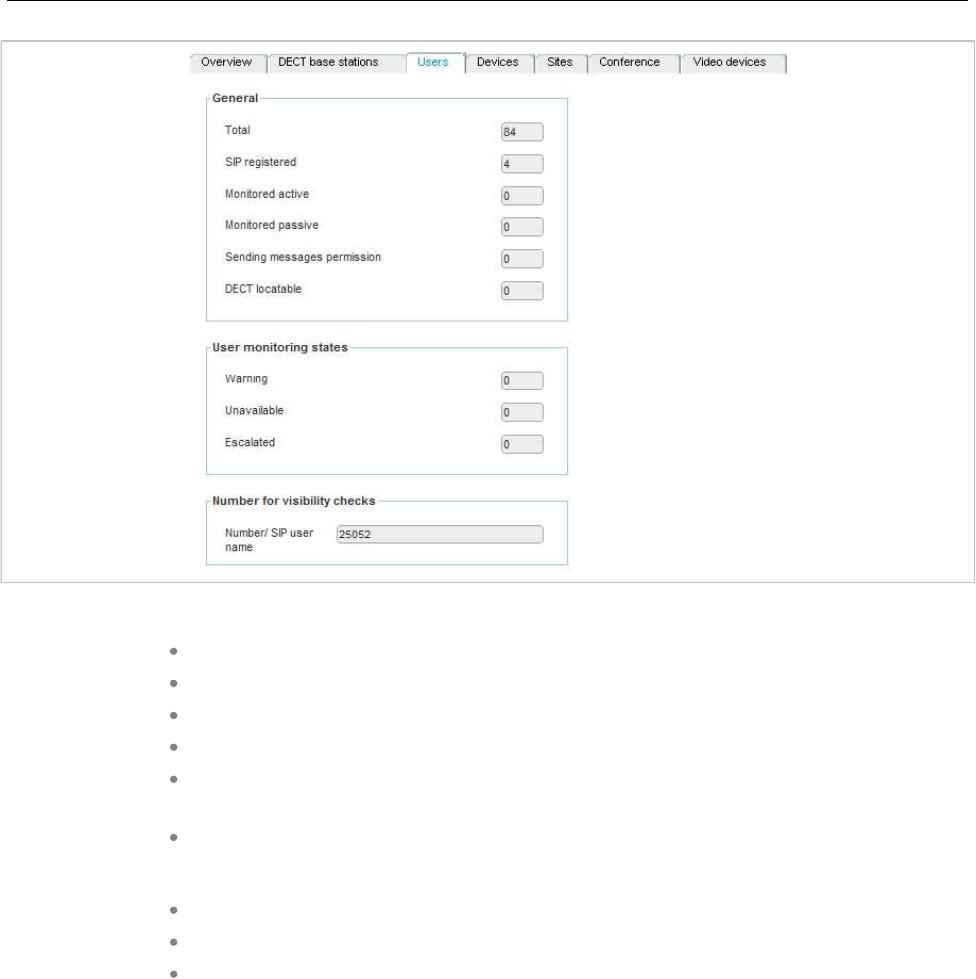
SIP-DECT OM System Manual
124
The “General” panel provides counters concerning DECT phones user configuration and states:
Total: Total number of configured users
SIP registered: Number of configured users registered at SIP server
Monitored active: Number of configured users with active monitoring enabled
Monitored passive: Number of configured users with passive monitoring enabled
Sending messages permission: Number of configured users with message
sending permission enabled
DECT locatable: Number of configured users with DECT locatable enabled
The “User monitoring states” panel provides counters concerning DECT phone user monitoring state
Warning: Number of monitored users in state ‘Warning’
Unavailable: Number of monitored users in state ‘Unavailable’
Escalated: Number of monitored users in state ‘Escalated’
The “Number for visibility checks” panel provides phone number or SIP user name used for standby
OMM visibility checks.
6.4.4 DEVICES
The “Devices” tab provides information about DECT phones.
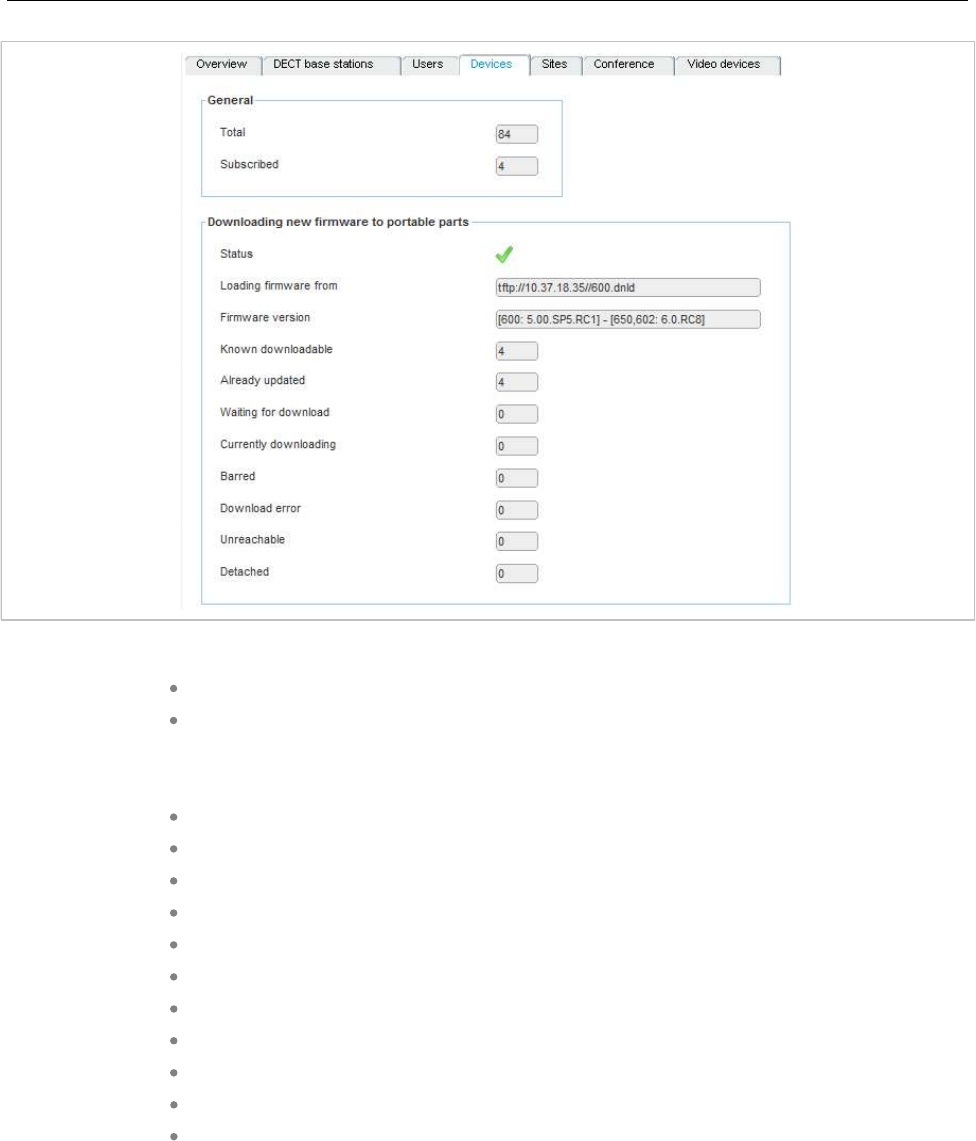
OM Management Portal (OMP)
125
The “General” panel contains counters related to DECT phones:
Total: Total number of configured DECT phones
Subscribed: Number of configured DECT phones which are subscribed to OMM
The “Downloading new firmware to portable parts” panel provides information about state of DECT
phone firmware download:
Status: Status of firmware download
Loading firmware from: URL of firmware download container
Firmware version: Version info of firmware container
Known downloadable: Number of DECT phones known as downloadable
Already updated: Number of DECT phones already updated
Waiting for download: Number of DECT phones waiting for download
Currently downloading: Number of DECT phones currently downloading
Barred: Number of downloadable DECT phones currently barred
Download error: Number of downloadable DECT phones with download error
Unreachable: Number of downloadable DECT phones currently unreachable
Detached: Number downloadable DECT phones currently detached
6.4.5 SITES
The “Sites” tab provides counters concerning site configuration and state:
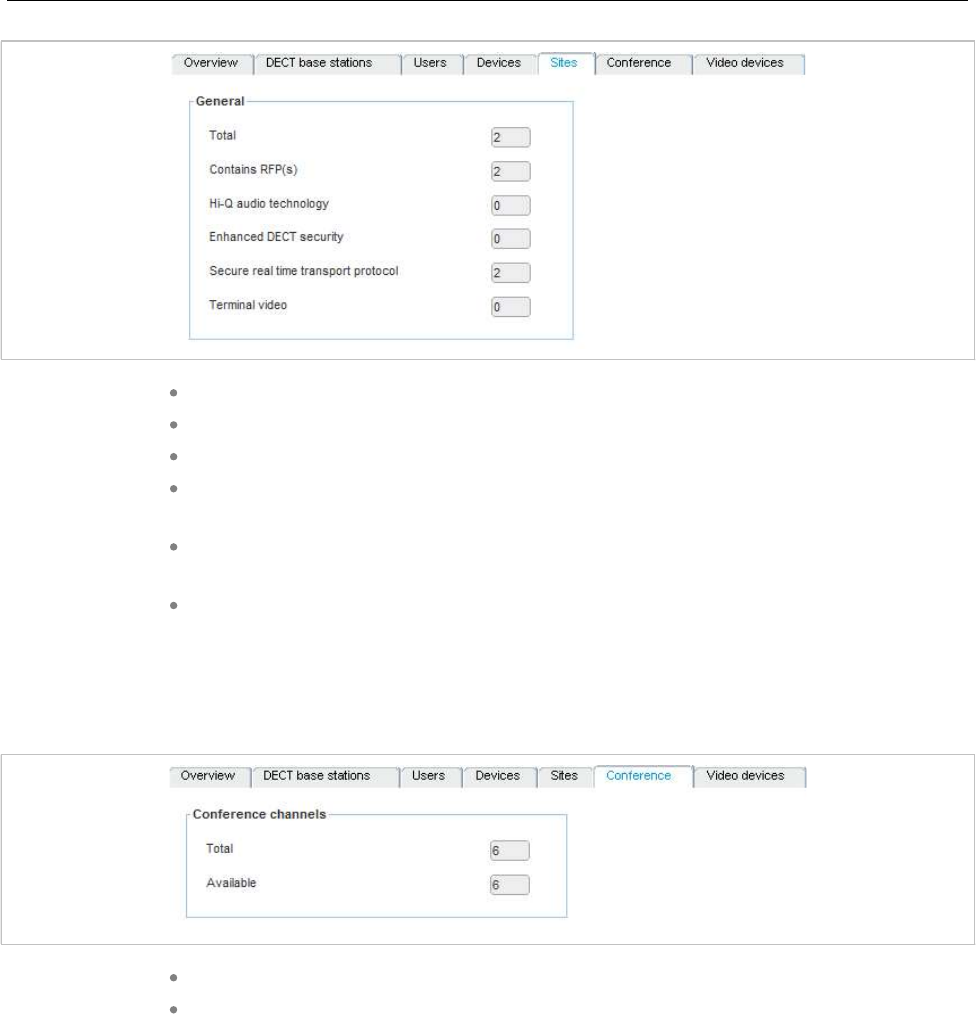
SIP-DECT OM System Manual
126
Total: Total number of configured sites
Contains RFPs: Number of sites with dedicated RFPs
Hi-Q audio technology: Number of sites with Hi-Q audio technology enabled
Enhanced DECT security: Number of sites with “Enhanced DECT security”
enabled
Secure real time transport protocol: Number of sites with “Secure real time
transport protocol” (SRTP) enabled
Terminal video: Number of sites with terminal video enabled
6.4.6 CONFERENCE
The “Conference” tab provides conference channel information:
Total: Total number of conference channels in system
Available: Number of currently available conference channels
6.4.7 VIDEO DEVICES
The “Video devices” tab provides video device state information.
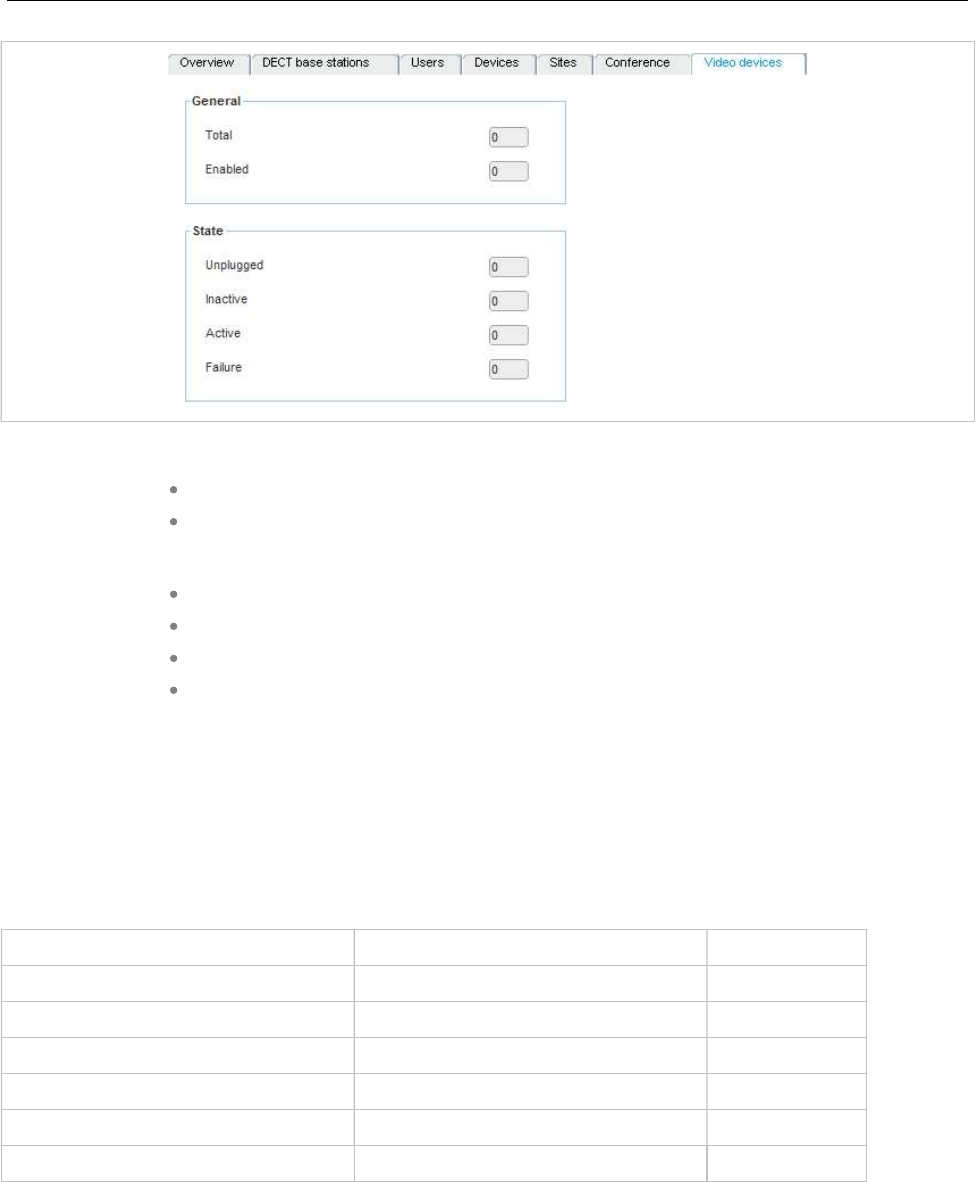
OM Management Portal (OMP)
127
The “General” panel provides video device configuration related counters:
Total: Total number of configured video devices
Checkpoint: Number of video devices enabled
The “State” panel provides video device state related counters:
Unplugged: Number of video devices in state unplugged
Inactive: Number of video devices in state inactive
Active: Number of video devices in state active
Failure: Number of video devices in state failure
6.5 “SYSTEM” MENU
The System menu allows configuration and display of global OMM settings. The system settings are
changeable in configuration mode. Change of some parameters can cause the OMM to be reset. In this
case a new login is required.
The System menu provides the following entries:
Configuration mode Monitor mode See section
Basic settings Basic settings 6.5.1
Advanced settings Advanced settings 6.5.2
Statistics 6.5.3
SIP SIP 6.5.4
User administration User administration 6.5.6
Data management Data management 6.5.7
6.5.1 “BASIC SETTINGS” MENU
The Basic settings menu contains general settings for the OpenMobility Manager.
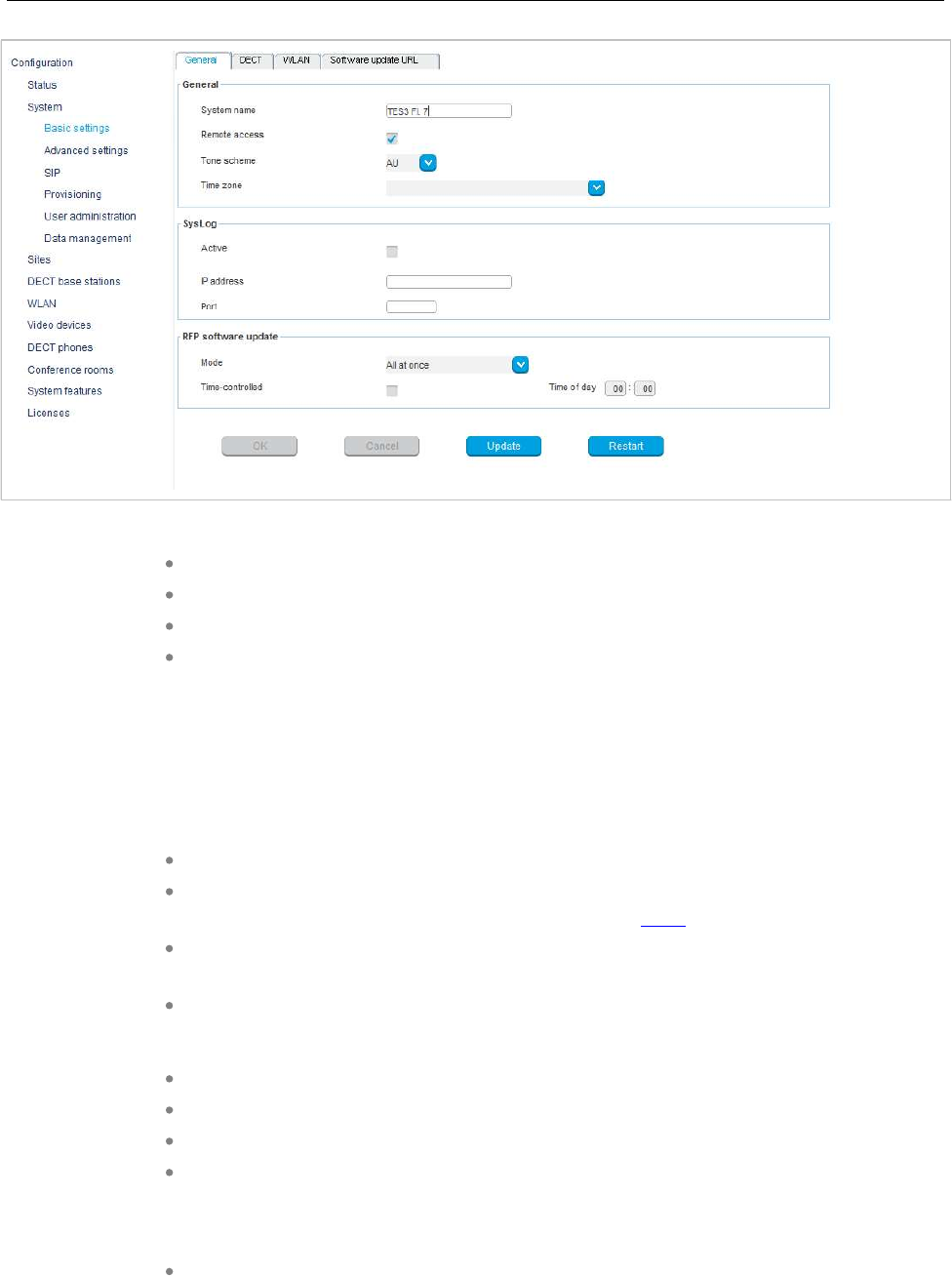
SIP-DECT OM System Manual
128
The Basic settings menu contains the following tabs:
General (see section 6.5.1.1)
DECT (see section 6.5.1.2)
WLAN (see section 6.5.1.3)
Software update URL (only on systems where the OMM is running on a DECT base
station) (see section 6.5.1.4)
6.5.1.1 General settings
You can set the following parameters on the General tab of the “Basic Settings” menu.
General
System name: Name of the SIP-DECT system.
Remote access: Enables or disables SSH access to all RFPs in the DECT system.
For more information on SSH access, see section 9.3.5.
Tone scheme: Specifies the country in which the OMM resides, which enables
country-specific tones (e.g., busy tone, dial tone, etc).
Time zone: Specifies the time zone in which the OMM is operating.
Syslog
Active: Enables propagation of syslog messages by the OMM and RFPs.
IP address: Address of the host that collects the syslog messages.
Port: Port of the host that collects the syslog messages.
Forward OMM Messages to syslog: (Visible only on a PC-hosted OMM system)
Enables/disables forwarding of syslog messages from the PC-hosted OMM.
RFP software update
Mode: RFP update mode. Options are “One by one” (each RFP is updated
separately) or “All at once” (all RFPs are updated in one operation).

OM Management Portal (OMP)
129
Time-controlled: Indicates whether the start of the RFP update is time-controlled.
Time of day: Specifies the time for time-controlled RFP updates.
Note: Updates triggers can be controlled through update intervals
(DHCP, config files) or manually triggered via the Update button.
The “General” tab contains two additional buttons (aside from default buttons):
Update: Requests an immediate update of RFP software.
Restart: Requests an OMM restart.
6.5.1.2DECT settings
For a description of the parameters which can be set in the DECT tab, see the description of the System
settings page of the OMM Web service (see section 5.4.1). The corresponding parameters are
described in the DECT settings and Downloading new firmware to portable parts page sections, with
the exceptions noted below.
The following settings are only available in the OMP.
Regulatory domain: The OMP offers an additional regulatory domain selection
(Radio 1910-1927MHz 250mW) for SIP-DECT operation in some South American
countries. See section 2.12 for more information on this feature.
SARI: Specify the Secondary Access Rights Identifier (SARI) for the Dual Homing
feature. DECT phones subscribe to the SARI (instead of the PARK) to ensure that
user data is synchronized across all OMMs in the system. See section 8.16 for more
information on this feature. You can click the Generate SARI button to generate the
SARI from the system PARK code.
Paging area size: Select the number of paging areas for the SIP-DECT system. A
paging area can consist of up to 256 RFPs (and the smallest group can consist of
16 RFPs). The configuration of the paging areas is done in the Paging areas menu
of the OMP (see section 6.7.2).
Restricted subscription duration: Restricts the time period throughout which a
DECT phone can be subscribed to 2 minutes. Furthermore, the subscription mode
will be disabled immediately after every successful subscription of a DECT phone.
Auto-create on subscription: Activate this option if an unbound subscription of
DECT phones should be allowed. See the OM DECT Phone Sharing and
Provisioning Guide for more information.
6.5.1.3 WLAN settings
For a description of the parameters which can be set in the WLAN tab, see the description of the
System settings page of the OMM Web service. The same parameters are described in the WLAN
settings section (section 5.4.1.3).
6.5.1.4 Software Update URL settings
With SIP-DECT 6.0 or later, DECT base stations in small SIP-DECT systems (~10 RFPs) can obtain
their software image from the RFP OMM, if they have no valid URL from which to load their software. If
the OMM is running on a RFP, the RFP OMM delivers the software to the connected RFPs.
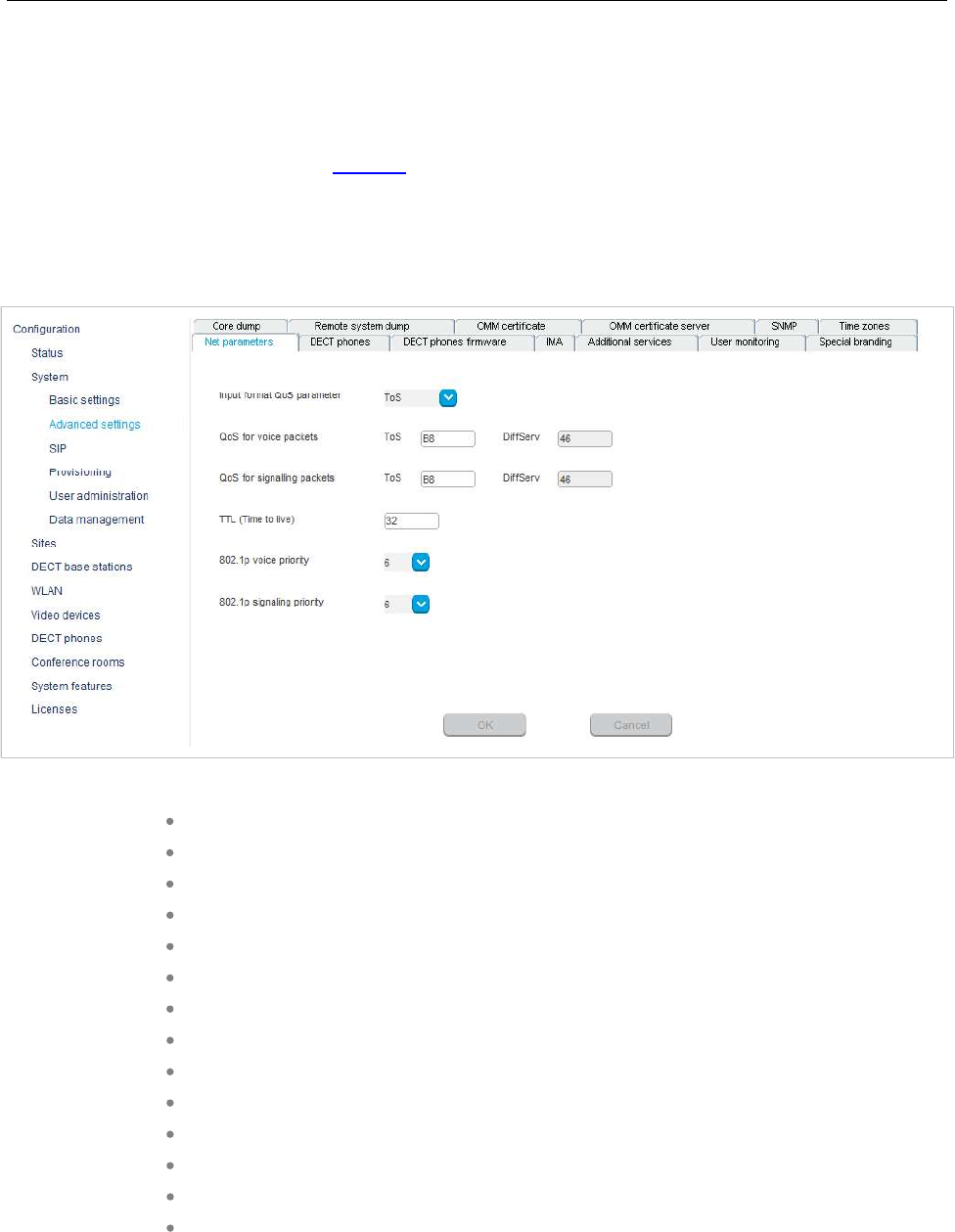
SIP-DECT OM System Manual
130
You configure the URL for the RFP software image (iprfp3G.dnld and iprfp4G.dnld) on this tab. This tab
is only available when the OMM resides on an RFP.
For a description of the parameters that can be set in the Software update URL tab, see the description
of the System settings page of the OMM Web service. The same parameters are described in the
Software update URL (see section 5.4.1.12).
6.5.2 “ADVANCED SETTINGS” MENU
The Advanced settings menu contains additional settings for the OpenMobility Manager.
The Advanced settings menu contains the following tabs:
Net parameters (see section 6.5.2.1)
DECT phones (see section 6.5.2.2)
DECT phone firmware (see section 6.5.2.3)
IMA (see section 6.5.2.4)
Additional services (see section 6.5.2.5)
User monitoring (see section 6.5.2.6)
Special branding (see section 6.5.2.7)
Core dump (see section 6.5.2.8)
Remote system dump (see section 6.5.2.9)
OMM certificate (see section 6.5.2.10)
OMM certificate server (see section 6.5.2.11)
SNMP (see section 6.5.2.12)
Time zones (see section 6.5.2.13)
Pre-Login banner (see section 6.5.2.14)

OM Management Portal (OMP)
131
6.5.2.1Net parameters
For a description of the parameters that can be set in the Net parameters tab, see the description of the
System settings page of the OMM Web service. The same parameters are described in the Net
Parameters section (section 5.4.1.15).
Input format QoS parameter: Format for quality of service parameter. Available
options are ToS or DiffServ.
QoS for voice packets: Specifies the value of the type of service (ToS ) or DiffServ
byte (depending on the QoS input format value) of the IP packet header for all
packets that transport RTP voice streams.
QoS for signalling packets: Specifies the value of the type of service (ToS ) or
DiffServ byte (depending on the QoS input format value) of the IP packet header for
all packets related to VoIP signaling.
TTL (Time to live): Specifies the maximum hop count for all IP packets.
802.1p voice priority: Specifies the VLAN priority tag for RTP packets.
802.1p signaling priority: Specifies the VLAN priority tag for VoIP signaling
packets.
6.5.2.2 DECT Phones
The OMM can set certain start-up text settings on the DECT Phone over the air. For more information on
this feature see section 2.13.5.
Dial editor supports digits only: Enables a digits-only mode for the DECT phone
dial editor. In this mode, the ”*” has the meaning of a digit to be dialed, even if short-
pressed. If the mode is not enabled, a short press of the ”*” key changes the editor
mode to alphanumric.
Set startup window headline: Enables display of the text string specified in the
Startup window headline field.
Startup window headline: Text headine to be displayed in the DECT phone
window at startup. Default value is ”my company”.
Set startup window text: Enables display of the text string specified in the Startup
window text field.
Startup window text: Text string to be displayed in the DECT phone window at
start. Empty by default.
Truncate portable part user name: Enables or disables truncating the name of the
user registered to the DECT phone.

SIP-DECT OM System Manual
132
6.5.2.3DECT phones firmware
The OMM can provide a DECT phone firmware update over the air. If the Activate firmware update
checkbox is enabled, the “Download over Air” feature is activated. For more information on this feature,
see section 8.22.
For a description of the parameters on the DECT Phone firmware tab, see section 5.4.1.8.
6.5.2.4 IMA
The Integrated Message and Alarm (IMA) configuration is stored in the OMM database. You can
configure a specific URL for the OMM to retrieve the IMA configuration file (ima.cfg). The IMA
configuration remains available even if the configured server becomes unavailable.
When you set a specific URL, the OMM uses that URL to load the IMA configuration file during startup. If
no specific IMA configuration file source is configured, the provisioning server settings (ConfigURL) are
used to retrieve the ‘ima.cfg’ file.
For a description of the parameters on the IMA tab, see the description of the System settings page of
the OMM Web service. The same parameters are described in the OM Integrated Messaging &
Alerting service section (section 5.4.1.10).
6.5.2.5Additional services
For a description of the parameters on the Additional services tab, see the description of the System
settings page of the OMM Web service. The same parameters are described in the following sections:
Voice mail (section 5.4.1.9)
OMP web start (section 5.4.1.7)
Date and time (for NTP servers, see section 5.4.1.16)
6.5.2.6User monitoring
The User monitoring tab allows you to configure the system-wide parameters for the user monitoring
feature.
Locating escalation: If this option enabled, the alarm trigger “LOC-ERR-
USERSTATE” will be generated by the OMM. Default setting is “off”.
Start-up delay: The start-up delay defines the period of time the user monitoring
start-up is delayed (between 2 and 15 minutes) after failover or system start-up.
Escalation delay: The escalation delay defines the period of time the user
monitoring will wait before the unavailable status is escalated.
Activity timeout 1: The activity timeout 1 defines the maximum time (between 30
and 1440 minutes) between user activities in passive monitoring mode.
Activity timeout 2: The activity timeout 2 defines the maximum time (between 5
and 60 minutes) between user activities in active monitoring mode.
Battery threshold: The battery threshold defines the minimum battery load
(between 0 and 100% in steps of 5%).

OM Management Portal (OMP)
133
6.5.2.7Special branding
With SIP-DECT 6.0 or later, you can integrate a customer-specific logo into the OMM Web service
interface (displayed beside the Mitel logo in the top bar). The ”Special Branding” tab allows you to
specify the location of the branding image file (customer_image.png) on an external file server.
When you set a specific URL, the OMM uses that URL to load the image file during startup. If no specific
customer logo file source is configured, the provisioning server settings (ConfigURL) are used to retrieve
the image file.
The branding image is stored permanently in the OMM database. The file is deleted automatically when
the branding image URL configuration is disabled. The picture should not be larger than 50 pixels high
and 216 pixels wide.
By special request, you can use specific branding key to lock the OMM; the key must be branded to all
DECT phones before they can be subscribed. See section 8.25 for more information on this feature.
PP Branding key
Active key: Displays the current branding key associated with the DECT phones.
New key: Specifies the new branding key generated through the
DECTSuiteBrandingInstallation.exe utility.
Branding image URL
Active: Enables the specific URL for downloading the customer_image.png file (as
opposed to the ConfigURL, which points to an external file server for all
configuration and resource files).
Protocol: Specifies the protocol used to fetch the image file.
Port: Specifies the port of the external file server.
Server: Specifies the IP address or name of the external file server.
User name: Specifies the user name to authenticate on the external file server.
Password: Specifies the password to authenticate on the external file server.
Password confirmation: Confirms the password to authenticate on the external file
server.
Directory: Specifies the location of the image file on the external file server.
Use common certificate configuration: Enables the use of the same certificate
validation settings for the image file URL as specified for the ConfigURL.
6.5.2.8Core Dump
Fatal software problems may result in memory dumps, in core files. The IP RFP can transfer the core
files to a remote fileserver. With SIP-DECT 6.0 or later, you can configure a specific URL to an external
file server where core dump files should be transferred and stored. The Core dump URL is used by each
RFP connected to the OMM.
Without a configured Core dump URL, whether and where core files are transferred is dependent on
specific RFP settings. Without any special configuration, the files are transferred to the server that is
used to retrieve the system software (i.e., the directory of the boot image).

SIP-DECT OM System Manual
134
For a description of the parameters on the Core Dump tab, refer to the description of the System
settings page of the OMM Web service. The same parameters are described in the Core dump URL
section (section 5.4.1.14).
6.5.2.9Remote system dump
A system dump is a file that holds information about the OpenMobility Manager and all connected RFPs.
With the Remote System Dump feature, a system dump is transferred to a remote server. You can
configure a specific destination, otherwise the system configuration URL is used.
The system dump is generated manually by pressing the dump button or automatically at the configured
time. Please ensure that the used fileserver allows writing or creating system dumps.
For a description of the parameters on the Remote system Dump tab, refer to the description of the
System settings page of the OMM Web service. The same parameters are described in the System
dump section (section 5.4.1.13).
6.5.2.10 OMM Certificate
You can overwrite the hard-coded OMM certificate by importing a local certificate chain and a private key
file which may be password-protected. The OMM certificate will be used for incoming AXI and HTTPS
connections to the OMM services. If the OMM can be reached from the internet by a domain and an
appropriate CA certificate has been imported, no security warnings are displayed in web browsers that
trust the CA root certificate.
For more information on this feature, see section 8.10.
Certificates/key
Private key: Indicates whether the OMM has a private key file (read-only).
Local certificate chain: Indicates the number of local certificate chains deployed on
the OMM (read-only).
Delete certificates/key: Allows you to delete any existing certificate or key files.
PEM file import
Import PEM file with: Indicates the content type of the PEM file being imported.
Available options are “Local certificate chain” or “Private key”.
File: Specifies the location of the PEM file to be imported.
Import: Triggers the import of the specified PEM file.
Private key password
Private key password: Specifies the password to be used for the private key file if
you want the file to be password-protected.
Password confirmation: Confirms the password for the private key file.

OM Management Portal (OMP)
135
6.5.2.11 OMM certificate server
OMM certificates can be updated automatically through configuration of a secure OMM certificate server
URL.
Active: Enables the feature.
Protocol: Specifies the preferred protocol (FTP, TFTP, FTPS, HTTP, HTTPS,
SFTP).
Server: Specifies the name or IP address of the external file server.
Port: Specifies the certificate server’s port number
Use default port: If selected, the default port associated with the selected protocol
is used.
User name: Specifies the user name to authenticate against the external file server.
Password: Specifies the password to authenticate against the external file server.
Password confirmation: Confirms the password to authenticate against the
external file server.
Path without filename: Specifies the path on the file server to the certificate files.
Use common certificate configuration: Enables the use of the system-wide
certificate validation settings, as configured under the System -> Provisioning
menu (see section 6.5.5).
Local certificate file: Specifies the name of the PEM file on the external server
including the local certificate or a certificate chain.
Private key file: Specifies the name of the PEM file on the external server including
the local key.
6.5.2.12 SNMP
To manage a larger RFP network, an SNMP agent is provided for each RFP. The SNMP agent provides
alarm information and allows an SNMP management system (such as “HP Open View”) to manage this
network. The SNMP sub menu of the OMP provides configuration of SNMP service settings.
For a description of the parameters on the SNMP tab, refer to the description of the SNMP menu of the
OMM Web service (see section 5.4.6).
6.5.2.13 Time zones
The OMM provides all available time zones on the Time zones tab. They are set with their known
daylight savings time rules adjusted to the Universal Coordinated Time (UTC) by default. The difference
to the UTC time is shown in the UTC difference field.
In addition, you can configure a new (free) time zone.
The date and time are provided by the OMM to the Mitel 142d and Mitel 600 DECT phones if the DECT
phone initiates a DECT location registration. The DECT phone initiates a DECT location registration
when:
subscribing to the OMM
entering the network again after the DECT signal was lost

SIP-DECT OM System Manual
136
at power on
silent charging feature is active at the phone and the phone is taken out of the
charger
after a specific time to update date and time
You can change the time zone rules for up to five time zones. The changes are saved in the
configuration file and are restored after each OpenMobility Manager startup.
General
Difference local standard time to UTC: The difference (in minutes) between the
local standard time and UTC time.
Daylight savings time: Enables or disables application of Daylight Savings Time
(DST) for the time zone. If disabled, the Standard time and Daylight savings time
tabs are not accessible.
Difference daylight savings time to standard time: The difference (in minutes)
between Daylight Savings Time (DST) and Standard Time for the time zone.
If the Daylight savings time parameter on the General tab is enabled, you can change the standard
time and the daylight savings time (DST) of a time zone in the Standard time and Daylight savings
time tabs. If the time zone has no DST, only the UTC difference can be configured. For the DST both
points of time (begin of standard time and begin of daylight savings time) must be specified exactly.
Therefore a certain day in the month or a certain week day in a month can be used.
The following commands are available to edit time zones:
OK: Confirm the changed time zone settings.
Cancel: Cancels the operation and resets the changed time zone back to the default
setting.
Default: Resets all individual time zone settings to the default values and deletes
the changed time zone rules in the configuration file.
6.5.2.14 Pre-Login banner
There is an optional customer editable banner available, whcih allows to display security notes or similar
on OMP and OMM’s Web interface prior to login.
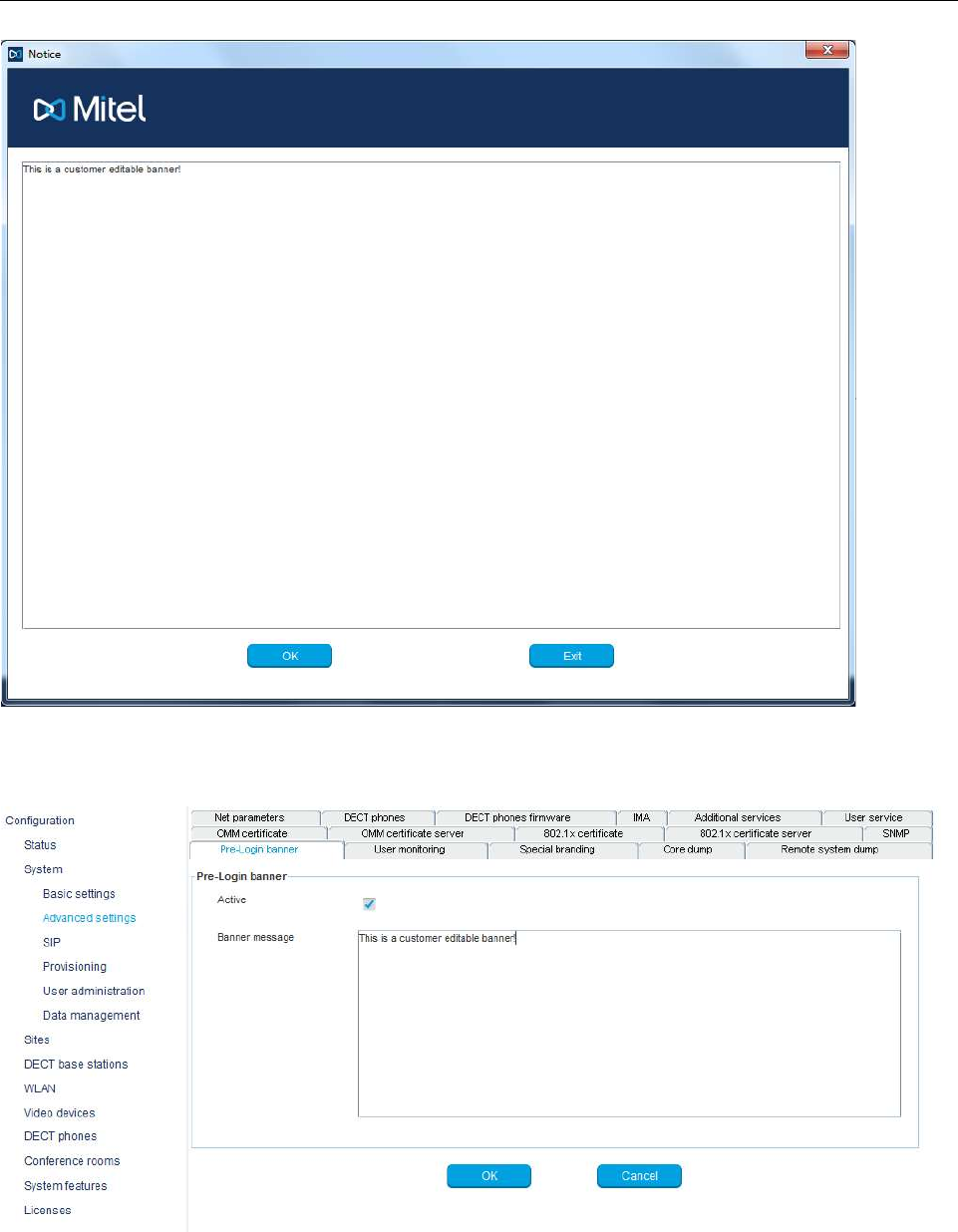
OM Management Portal (OMP)
137
You can modify and activate the banner through OMP.
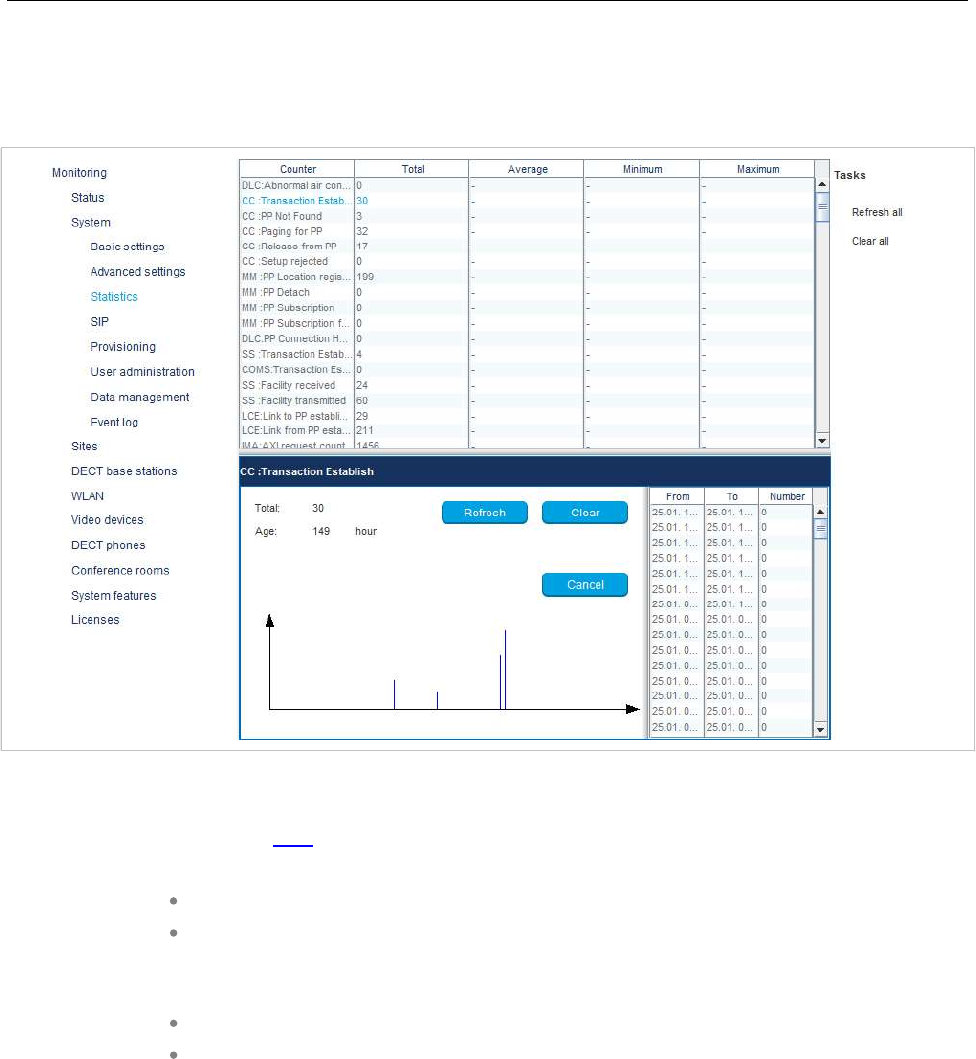
SIP-DECT OM System Manual
138
6.5.3 “STATISTICS” MENU (MONITORING MODE ONLY)
The Statistics page provides system statistics counters which can be used to check system behavior.
The page is only available in Monitor Mode.
Statistic counters beginning with “+” are counters that are taken over by the standby OMM in case of a
failover. All other counters are reset to default values in case of a failover. For more details about the
standby feature, see section 8.15.
You can:
Refresh all: request OMM update for all statistics counters.
Clear all: reset all statistics counters in OMM.
If a statistics counter is selected in the table, it is shown in a detail panel. This detail panel provides all
available information for this statistics counter. You can:
update this single statistics counter by pressing the Refresh button, or
reset this single statistics counter by pressing the Clear button.
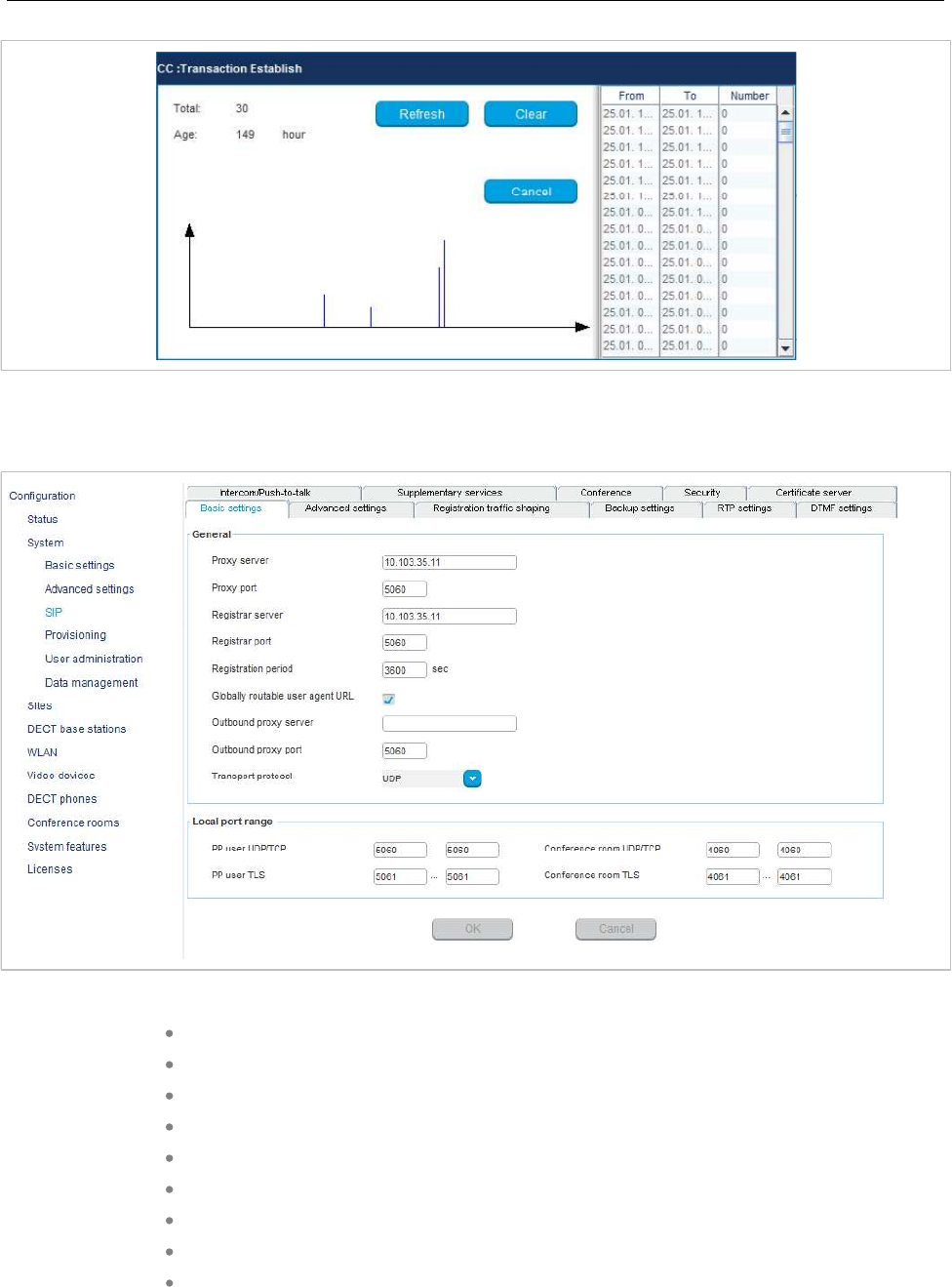
OM Management Portal (OMP)
139
6.5.4 “SIP” MENU
The SIP menu contains global settings for SIP signaling and RTP voice streams.
The SIP menu contains the following tabs:
Basic settings (see section 6.5.4.1)
Advanced settings (see section 6.5.4.2)
Registration traffic shaping (see section 6.5.4.3)
Backup settings (see section 6.5.4.4)
RTP settings (see section 6.5.4.5)
DTMF settings (see section 6.5.4.6)
Intercom Push-to-talk (see section 6.5.4.7)
Supplementary services (see section 6.5.4.8)
Conference (see section 6.5.4.9)

SIP-DECT OM System Manual
140
Security (see section 6.5.4.10)
Certificate server (see section 6.5.4.11)
6.5.4.1 Basic settings
For a description of the parameters on the Basic settings tab, see the description of the System -> SIP
menu of the OMM Web service. The same parameters are described in the Basic settings section
(section 5.4.3.1).
In addition, the following parameters (related to SIP multiport support) are available on the Basic
settings tab:
Local port range
DECT phone user UDP/TCP: The port range to be used for DECT users when
UDP/TCP is used as the transport protocol. The default is 5060 – 5060.
DECT phone user TLS: The port range to be used for DECT users when TLS is
used as the transport protocol. The default is 5061 – 5061.
Conference room UDP/TCP: The port range to be used for Conference Rooms
when UDP/TCP is used as the transport protocol. The default is 4060 – 4060.
Conference room TLS: The port range to be used for DECT users when TLS is
used as the transport protocol. The default is 4061 – 4061.
Note: There are certain rules to note when configuring port ranges, see
section 2.17 for more information.
6.5.4.2Advanced settings
You can set several additional SIP parameters on the Advanced settings tab.
For a description of the parameters on the Advanced settings tab, refer to the description of the
System -> SIP menu of the OMM Web service. The same parameters are described in the Advanced
settings section (section 5.4.3.2).
In addition, the following parameters are available in the OMP only:
X-Aastra-Id info: Enable or disable inclusion of the private X-Aastra-Id header in
each SIP REGISTER message.
User agent info – compatibility mode: If the User agent info option is enabled, the
OMM sends information on his version inside the SIP User-Agent/Server headers;
this parameter ensures backward compatibility with version information used in
older SIP-DECT software releases.
6.5.4.3 Registration traffic shaping
Registration traffic shaping parameters allow you to limit the number of simultaneous SIP registrations at
startup/fail over of the OMM. This feature is always activated because disabling it may overload the
OMM or the call server.

OM Management Portal (OMP)
141
For a description of the parameters on the Registration traffic shaping tab, see the description of the
System -> SIP page of the OMM Web service. The same parameters are described in the Registration
traffic shaping section (section 5.4.3.5).
6.5.4.4 Backup settings
To increase the operational availability of the system in critical environments like hospitals, the OMM
offers a failover redundancy mechanism for the SIP server. In addition to the primary proxy, outbound
proxy and registrar server, you can configure two additional levels of backup servers (secondary and
tertiary servers).
The OMM failover behavior in detail depends on the backup server settings set here. A full description of
the behavior and deployment hints can be found in section 8.20.3.
Secondary proxy server / port,Secondary registrar server / port,Secondary
outbound server / port: Enter the parameters for the secondary server in these
fields.
Tertiary proxy server / port,Tertiary registrar server / port,Tertiary outbound
server / port: Enter the parameters for the tertiary server in these fields.
Note: Server addresses can be configured as IP addresses, names or
a fully qualified domain names. It is possible to configure a
mixture of IP addresses, names or fully qualified domain names
for the different servers. If fully qualified domain names are
configured and the respective port setting is configured to zero
(“0”), DNS SRV queries will be performed to locate a list of
servers in the domain (see 0).
Failover keep alive: The keep-alive mechanism allows transferring all users
registered on a failed server (failover) to secondary/tertiary servers as well as
automatically switching back to primary servers. Otherwise, failover is executed only
single users. Enable this option if you want to use this feature (default: off).
Failover keep alive time: For each registration target, a user could be registered
successful with, a keep alive procedure is started. Enter the time in this field after
which a new keep-alive procedure must be started (1-60 minutes, default 10 min.).
For a detailed description of the keep-alive mechanism see section 8.20.4.
6.5.4.5RTP settings
For a description of the parameters on the RTP settings tab, see the description of the System -> SIP
page of the OMM Web service. The same parameters are described in the RTP settings section
(section 5.4.3.3).
6.5.4.6DTMF settings
For a description of the parameters on the DTMF settings tab, see the description of the System -> SIP
page of the OMM Web service. The same parameters are described in the DTMF settings section
(section 5.4.3.4).

SIP-DECT OM System Manual
142
6.5.4.7Intercom Push-to-talk
You can set global auto-answer settings on the Intercom Push-to-talk tab. For more information on this
feature, see section 2.31.
Incoming calls
Auto answer: Enables or disables auto-answer on incoming calls.
Microphone mute: Enables or disables microphone muting when incoming calls are
automatically answered.
Warning tone: Enables or disables warning tone on incoming call. A short ringtone
is played if there are no active calls. If there is an active call in a “barge in” situation,
the ringing will be in-band.
Allow barge in: Allows/disallows “barge-in” on existing calls.
Outgoing calls
Initialization prefix for push-to-talk: String to be entered when initiating an
intercom call. An empty string indicates that the DECT phone cannot initiate an
intercom call.
6.5.4.8 Supplementary services
For a description of the parameters on the Supplementary services tab, see the description of the
System -> SIP page of the OMM Web service. The same parameters are described in the
Supplementary Services section (section 5.4.3.6).
6.5.4.9 Conference
You can define the conference mode globally for all SIP-DECT users on the Conference tab. For more
information on the Conferencing feature, see section 8.21.
Server type: Specifies the operational mode for the conference server. Available
options are:
-None: Neither external nor internal conference server is used.
-Integrated: The conference server integrated in the SIP-DECT system is used.
-External: An external conference server (e.g., Broadsoft) is used.
-External – Blind Transfer: An external conference server is used (e.g. MiVoice Business). The
initiation of the conference is signaled as a blind transfer to the destination specified in the URL
parameter.
URL: Specifies the URL for the conference server.
6.5.4.10 Security
For a description of the parameters on the Security tab, see the description of the System -> SIP page
of the OMM Web service. The same parameters are described in the Security section (section 5.4.3.8)
and the Manual Import section (section 5.4.3.10).
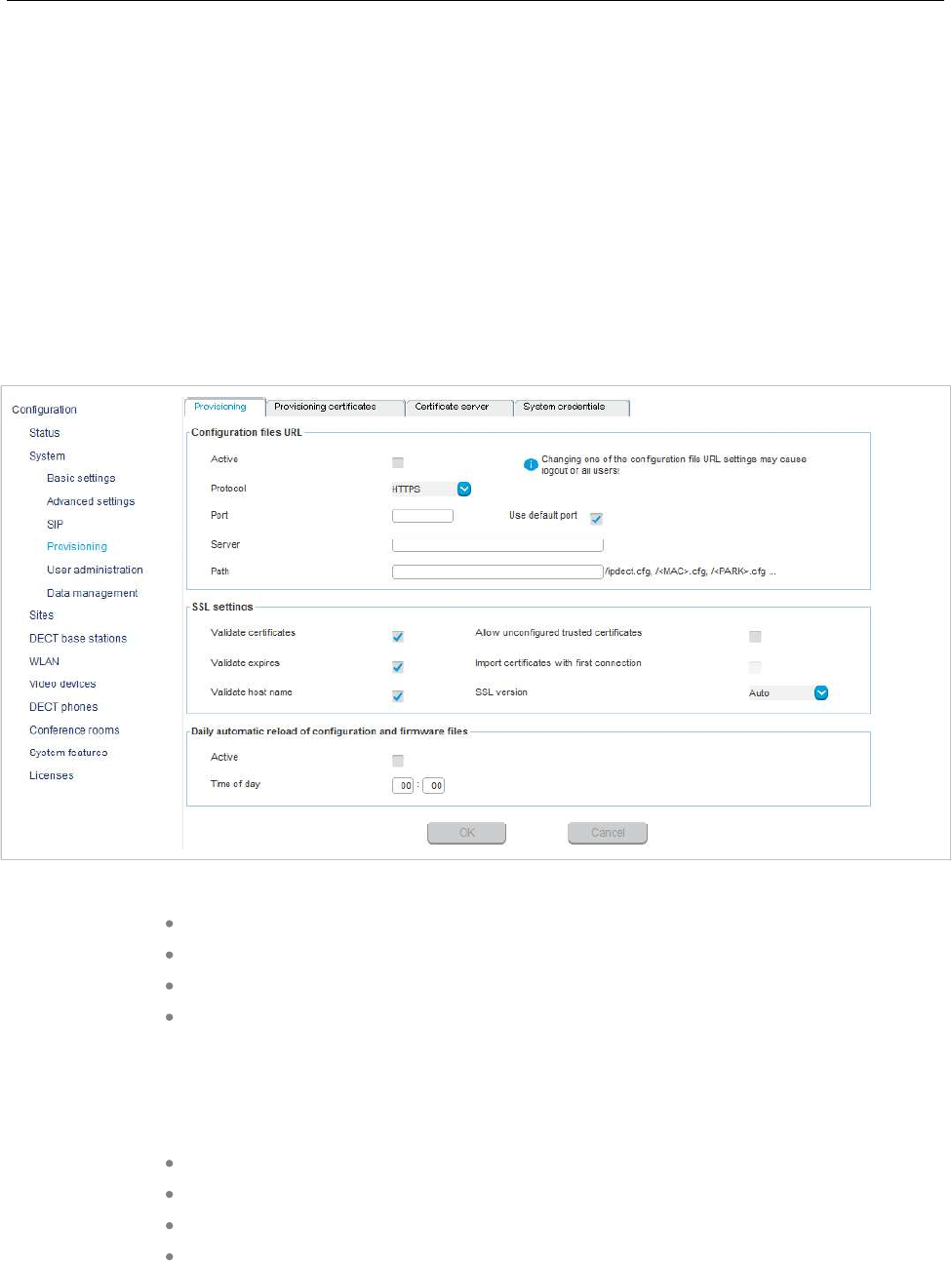
OM Management Portal (OMP)
143
6.5.4.11 Certificate server
For a description of the parameters on the Certificate server tab, see the description of the System ->
SIP page of the OMM Web service. The same parameters are described in the Certificate server
section (section 5.4.3.9).
6.5.5 ”PROVISIONING” MENU
SIP-DECT supports provisioning through external configuration files. With SIP-DECT 6.0 or later, you
can configure a URL for an external file server, from which all configuration files can be downloaded. The
configured provisioning server URL is used for secure connections to the file server to retrieve
configuration or firmware files.
The Provisioning menu contains settings related to the provisioning server.
The Provisioning menu contains the following tabs:
Provisioning (see section 6.5.5.1)
Provisioning certificate (see section 6.5.5.2)
Certificate server (see section 6.5.5.3)
System credentials (see section 6.5.5.4)
6.5.5.1 Provisioning
Configuration files URL
Active: Enable the configuration file URL feature.
Protocol: The protocol to be used to fetch the configuration files.
Port: Provisioning server’s port number.
Use default port: If selected, the default port associated with the selected protocol
is used.

SIP-DECT OM System Manual
144
Server: IP address or name of the provisioning server.
Path: Path to the configuration and resource files on the provisioning server.
SSL settings
Validate certificates: Enables or disables certificate validation. If enabled, the
server certificate is validated against trusted CA’s (signed by a CA from the Mozilla
CA certificate list) and the configured trusted certificates.
Validate expires: Enables or disables the validation of certificate expiry. When this
parameter is enabled, the client verifies whether or not a certificate has expired prior
to accepting the certificate.
Validate host name: Enables or disables the validation of hostnames on the OMM.
Allow unconfigured trusted certificates: If enabled, this parameter disables any
server certificate validation as long as no trusted certificate was imported into the
OMM. AXI commands in a received configuration file may import such trusted
certificates into the OMM.
Import certificates with first connection: If enabled (in conjunction with the Allow
unconfigured trusted certificates parameter), the trusted certificate will be imported
from the cert chain delivered in the server response without any validation, as long
as no trusted certificate was imported previously into the OMM.
SSL version: The SSL protocol version to use for the configuration file server
connection. Available options are: TLS1.0, TLS1.1, TLS1.2 or AUTO, where AUTO
accepts all protocol versions.
Daily automatic reload of configuration and firmware files
Active: Enables automatic reload of the configuration and resource files on a daily
basis, at the specified time.
Time of day: Time for scheduled reload of configuration and firmware files.
6.5.5.2 Provisioning certificates
Provisioning certificates are used for secure connections to configuration or firmware file servers that
support mutual authentication.
A trusted certificate chain is used by the OMM to validate the server. This is required if the server has no
certificate derived from a trusted CA root certificate, where the OMM uses the Mozilla CA Certificate List.
If no server certificate is available, the validation against trusted and CA certificates can be disabled in
the certificate validation options (only encrypted TLS connection).
The local certificate chain plus the private key are provided from the OMM to servers requesting mutual
authentication. The private key file may be password protected.
6.5.5.3 Certificate server
The provisioning certificates can be updated automatically through configuration of a secure provisioning
certificate server URL.
Active: Enable automatic updating of certificates the feature.
Protocol: Specifies the preferred protocol (FTP, TFTP, FTPS, HTTP, HTTPS,
SFTP)
Server: Specifies the name or IP address of the external file server.

OM Management Portal (OMP)
145
Port: Specifies the certificate server’s port number
Use default port: If selected, the default port associated with the selected protocol
is used.
User name: Specifies the user name to authenticate against the external file server.
Password: Specifies the password to authenticate against the external file server.
Password confirmation: Confirms the password to authenticate against the
external file server.
Path without filename: Specifies the path on the file server to the certificate files.
Use common certificate configuration: Enables the use of the system-wide
certificate validation settings, as configured on the System -> Provisioning ->
Provisioning certificates page (see section 6.5.5.2)
Trusted certificate file: Specifies the name of the PEM file on the specified server,
including the trusted certificates.
Local certificate file: Specifies the name of the PEM file on the external server
including the local certificate or a certificate chain.
Private key file: Specifies the name of the PEM file on the external server including
the local key.
6.5.5.4System credentials
System credentials are used to retrieve configuration and resource files from the configured provisioning
server for protocols supporting authentication or servers requesting authentication. For HTTP/HTTPS,
basic and digest authentication are supported.
User name: Specifies the user name for authentication against the provisioning
server.
Password: Specifies the password for authentication against the provisioning server
Password confirmation: Confirms the password for authentication against the
provisioning server.
6.5.6 “USER ADMINISTRATION” MENU
In the User administration menu you configure the OMM user accounts.
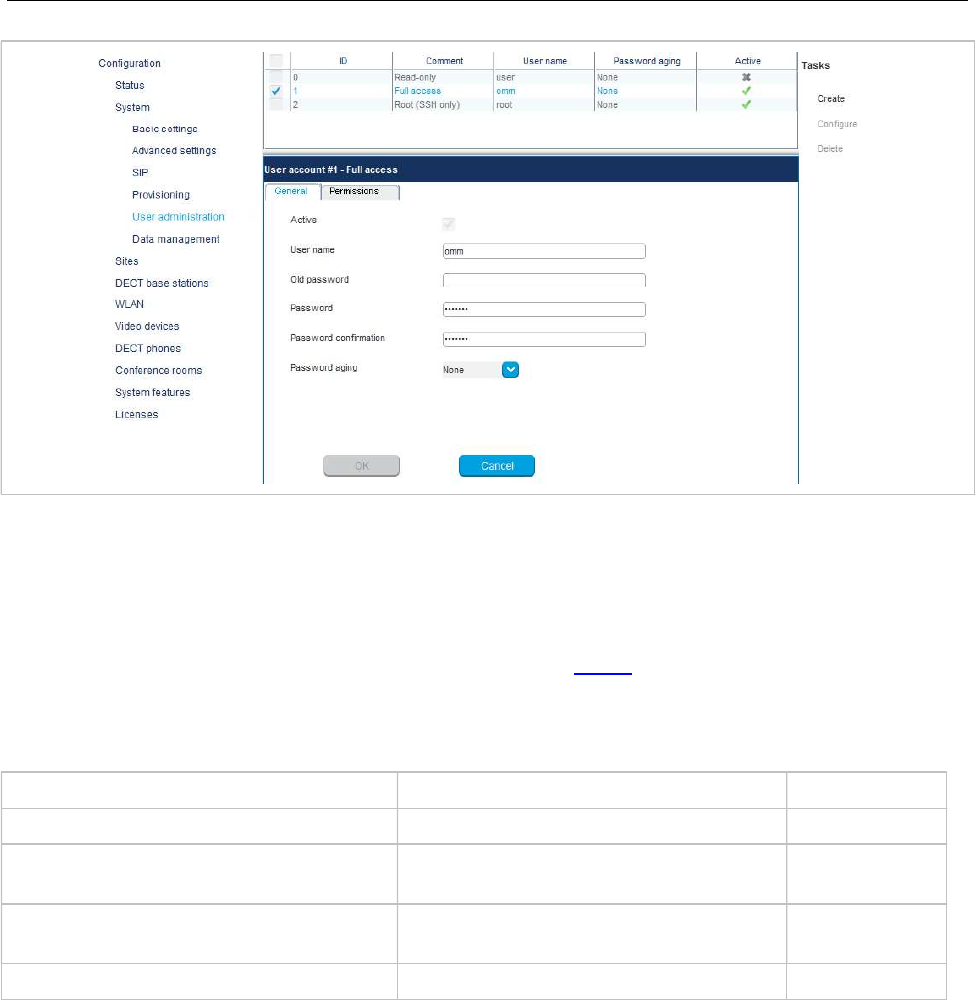
SIP-DECT OM System Manual
146
The three user accounts “Full access”, “Read-only” and “Root (ssh only)” available via the User
administration page of the OMM Web service can also be configured in the OMP. These three
predefined user accounts cannot be removed or renamed. Only the “Read-only” account can be
activated and deactivated. The permissions are fixed. This is consistent with the OMM WEB service. The
meaning of the different account types is described in section 8.17.1. In addition, the OMP allows to
create additional user accounts (login and password) and to assign specific permissions.
The tasks which can be performed are mode-dependant.
Configuration mode Monitor mode See section
Create: Create new user account 6.5.6.1
Configure: Configure selected user
account in detail panel
6.5.6.2
Show details: Shows selected user
account in detail panel
6.5.6.3
Delete: Delete selected user account 6.5.6.4
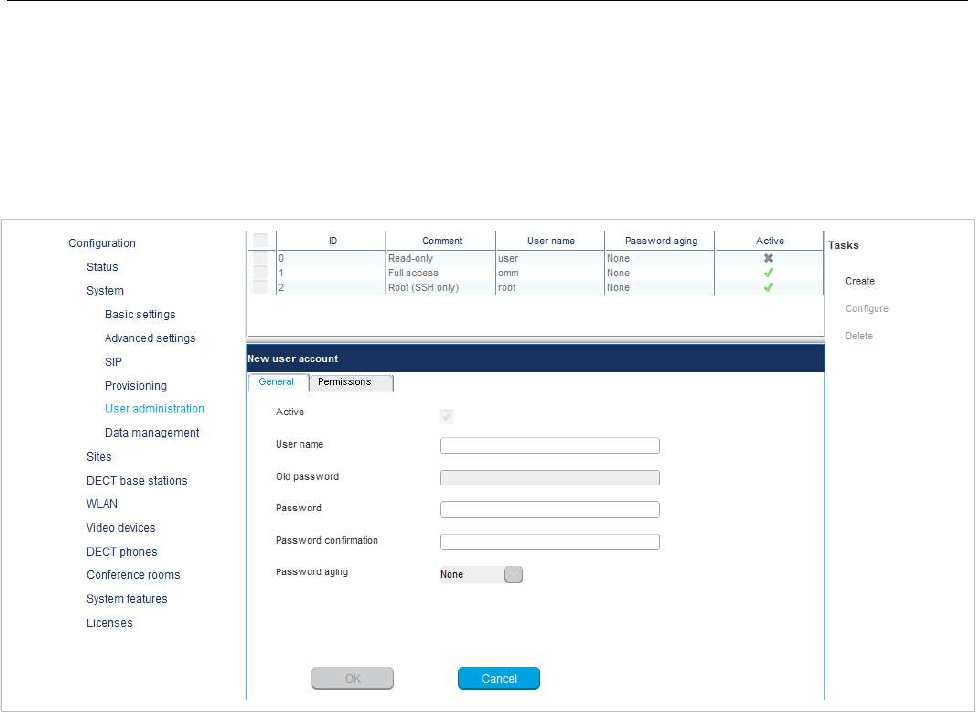
OM Management Portal (OMP)
147
6.5.6.1Creating New User Accounts
It is possible to create additional user accounts (login and password) and to assign specific permissions.
These accounts are mainly designed to have specific login data and permissions for applications which
are using OM AXI to connect with the OMM.
Note: Individual user accounts cannot be used for a login to the OMM
Web service nor SSH.
Adding individual user accounts is only possible in Configuration Mode. To add a user account, do the
following:
1In the Tasks bar click on the Create command.
The New user account panel opens. It provides various tabs where the account data must be
entered.
2Configure the user account, see parameter description below.
3Press the OK button.
The following parameters can be set in the tabs of the New user account panel:
General
For a description of the parameters which can be set in the General tab, see the description of the User
administration page of the OMM Web service (see section 6.5.6.).
Permissions
The permissions for an individual user account can be set independent from any license status even if
some of the permissions can only been used with an appropriate license.
If an application connects with the OMM via OM AXI, then the permissions been sent from the OMM to
the application is the result of the configured permissions for this account and the actual license status.
For more information please see the OM Application XML Interface (OM AXI) specification /31/.
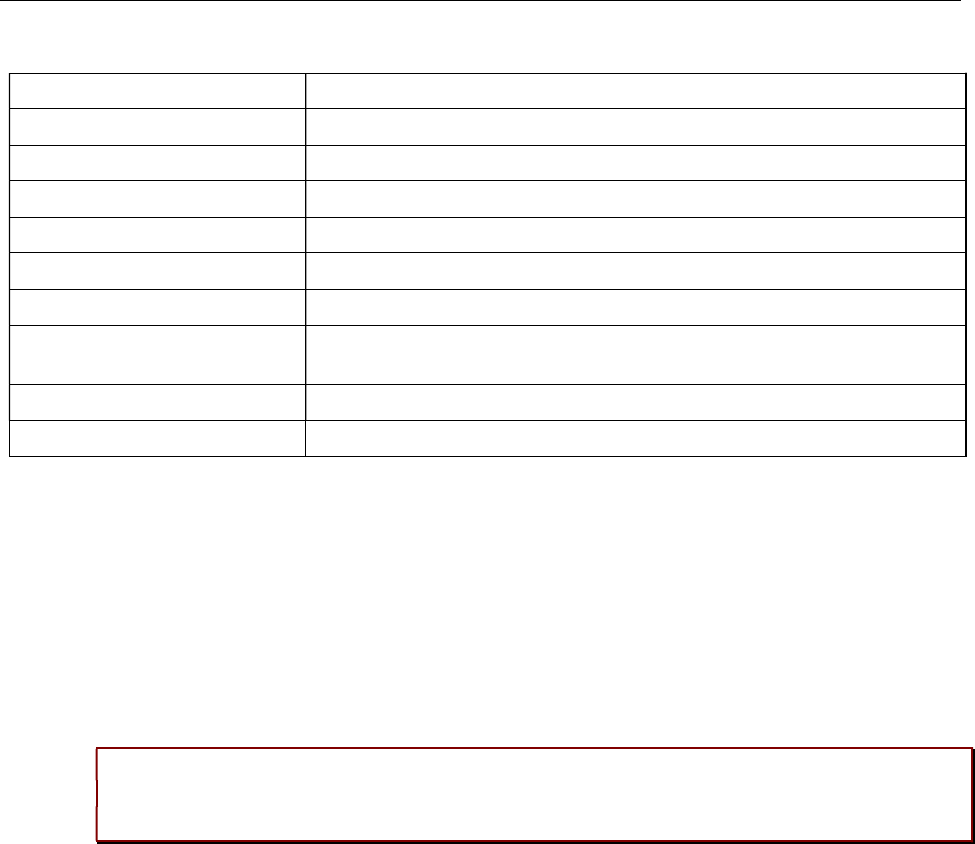
SIP-DECT OM System Manual
148
The permissions have the following meaning:
Permission Description
Read Read OMM data (OM AXI get requests)
Write Set OMM data (OM AXI set requests)
Messaging info Sent messages with priority “Info”
Messaging Sent messages with priority “Low”, “Normal” and “High”
Messaging emergency Sent messages with priority “Emergency”
Messaging locating Sent messages with priority “LocatingAlert”
Locating Permission to query the position of DECT phones and to track DECT
phone positions
Monitoring Permission to monitor various technical aspects of the mobility system
Video Permission for video streaming
6.5.6.2Changing a User Account
Changing user accounts is only possible in configuration mode. To change the configuration of an
existing user account, do the following:
1Select the appropriate user account in the account table.
2In the Tasks bar click on the Configure command.
3Change the user account parameters (see parameter descriptions in section 6.5.6.1).
4Press the OK button.
Please note: The predefined user accounts “Full access”, “Read-only” and “Root (ssh only)”
user accounts cannot be renamed. Also their permissions are fixed and cannot be
changed.
6.5.6.3Viewing User Account Details
You can view the configuration of a user account in monitor mode. Proceed as follows:
1Select the appropriate user account in the table.
2In the Tasks bar click on the Show details command.
The user account data is displayed in the user account detail panel.
3To close the user account detail panel, click the Cancel button.
6.5.6.4Deleting User Accounts
Deleting user accounts is only possible in configuration mode. To delete one or more existing user
accounts proceed as follows:
1Select the appropriate account(s) in the user account table by activating the corresponding
checkbox(es).
2In the Tasks bar click on the Delete command.
3Confirm the displayed prompt with OK.
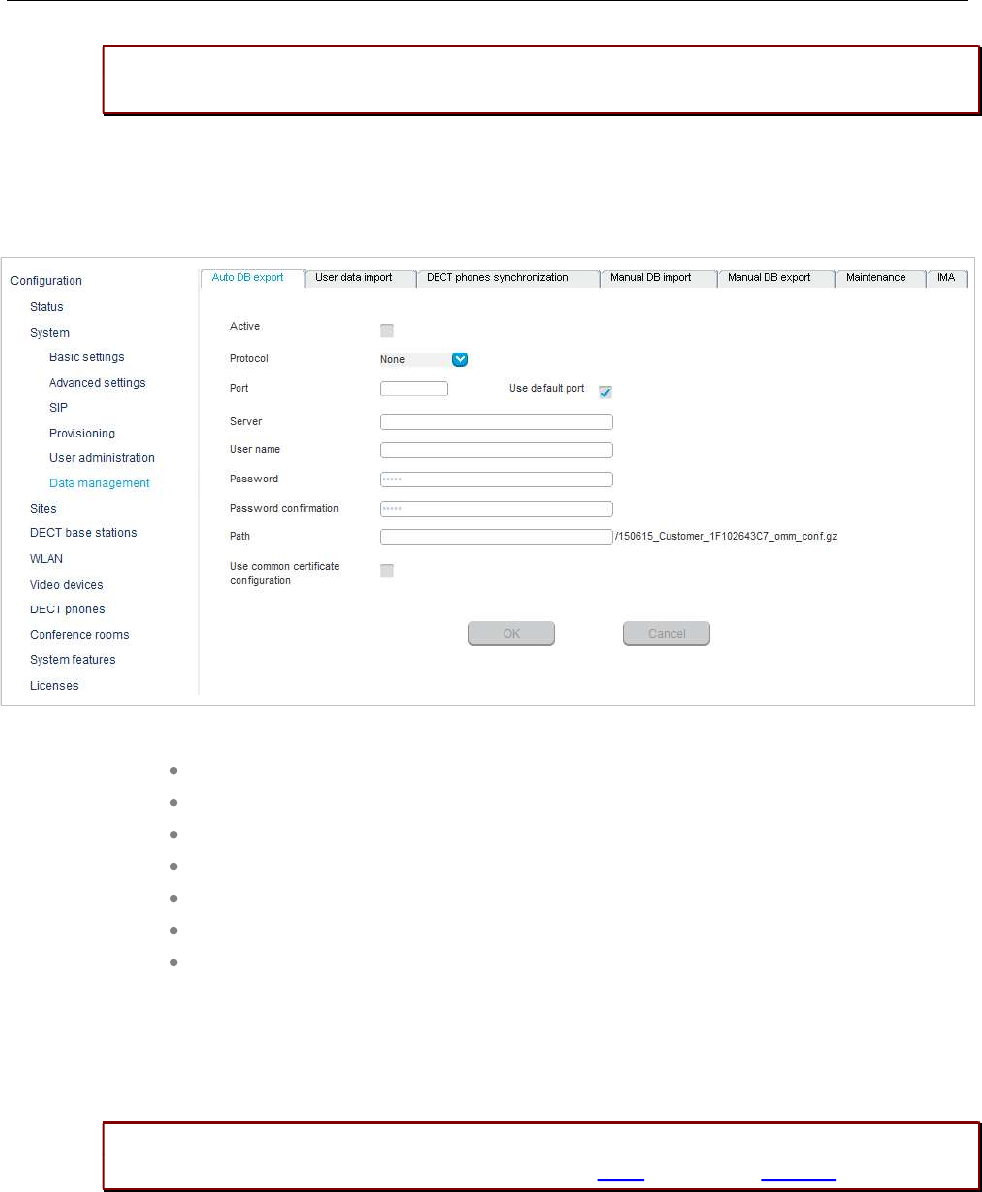
OM Management Portal (OMP)
149
Please note: The predefined user accounts “Full access”, “Read-only” and “Root (ssh only)”
user accounts cannot be removed.
6.5.7 “DATA MANAGEMENT” MENU
The Data management menu provides access to data related to import and export features.
The Data management contains the following tabs:
Auto DB export (see section 6.5.7.1)
User data import (see section 6.5.7.2)
DECT phones synchronization (see section 6.5.7.3)
Manual DB import (see section 6.5.7.4)
Manual DB export (see section 6.5.7.5)
Maintenance (see section 6.5.7.6)
IMA (see section 6.5.7.7)
6.5.7.1 Automatic DB export
The automatic database export feature allows an automatic database backup to an external server for
each configuration modification.
Please note: Synchronization with an NTP server is mandatory for an automatic database
export. For NTP server configuration, see section 8.5.4 and section 5.4.1.16.
For a description of the parameters on the Automatic DB export tab, see the description of the System
-> Data management page of the OMM Web service. The same parameters are described in the
Automatic Database Export section (section 5.4.7.3).

SIP-DECT OM System Manual
150
6.5.7.2User data import
The user data import feature allows the import of user data from an external provisioning server.
Configure specific source: Enables the specific URL to an external file server for
retrieving the user data file.
Protocol: Specifies the preferred protocol.
Port: Specifies the port on the server.
Server: Specifies the IP address or the name of the server.
User name, Password, Password confirmation: Specifies the credentials for the
server.
Path: Specifies the path to the file containing the user data.
Use common certificate configuration: Enables the use of the system-wide
certificate validation settings, as configured on the System -> Provisioning ->
Certificates page (see section 5.4.2.8).
Please note: If no credentials are specified for secure protocols, the system credentials are
automatically used (see section 5.4.2.2). If the system credentials must not be used, the
user name and password must be explicitly set here even for anonymous settings.
For further information on the user data import, see the OM DECT Phone Sharing and Provisioning
Guide.
6.5.7.3DECT phones synchronization
The user data synchronization feature ensures that all user and device database information is
distributed to all OMM instances in the system. Each peripheral OMM must have a connection to the AXI
interface of the central OMM (and the standby central OMM, if configured) to send and receive updated
user data information. Specify the same user credentials used to access the central OMM via the OMP.
For more information on this feature, see section 8.16.
Activate synchronization: Enable user data synchronization for the OMM.
OMM1: Specifies the IP address of the central OMM.
OMM2: Specifies the IP address of a second central OMM, in the case of a standby
configuration.
User name: Specifies the user name required to access the central OMM.
Password: Specifies the password required to access the central OMM.
Password confirmation: Confirms the password required to access the central
OMM.
6.5.7.4Manual DB import
The manual database import feature allows the import of an OMM database.

OM Management Portal (OMP)
151
Please note: A manual import of a database results in a reset of the OMM.
For a description of the parameters on the Manual DB import tab, see the description of the System ->
Data management page of the OMM Web service. The same parameters are described in the Manual
Database Import section (section 5.4.7.1).
6.5.7.5Manual DB export
The manual database export feature allows a manual database backup to an external server.
For a description of the parameters on the Manual DB export tab, see the description of the System ->
Data management page of the OMM Web service. The same parameters are described in the Manual
Database Export section (section 5.4.7.2).
6.5.7.6 Maintenance
In the Maintenance panel, you can perform a system dump, for example, for product support information
purposes. A file “sysdump.txt” is created in the selected directory. Click the Directory button to select
the directory, then click the Download button to start the system dump.
6.5.7.7 IMA
You can upload an IMA configuration file manually. To validate the existing configuration, the IMA
configuration can be also downloaded. An uploaded IMA configuration may be overwritten if a server for
the IMA configuration file is configured or if the ‘ima.cfg’ is available on the provisioning server. The IMA
configuration can be deleted regardless of its source.
Config file import
To upload an IMA configuration file, click the File button to browse to the file, then click Import.
Config file export
To download the current IMA configuration file, click the Directory button to select the destination
directory, then click Export.
Delete config file
To delete the IMA configuration file, click Delete.
6.5.8 “EVENT LOG” MENU
The Event Log menu provides information about system events. The menu is only available in Monitor
Mode.
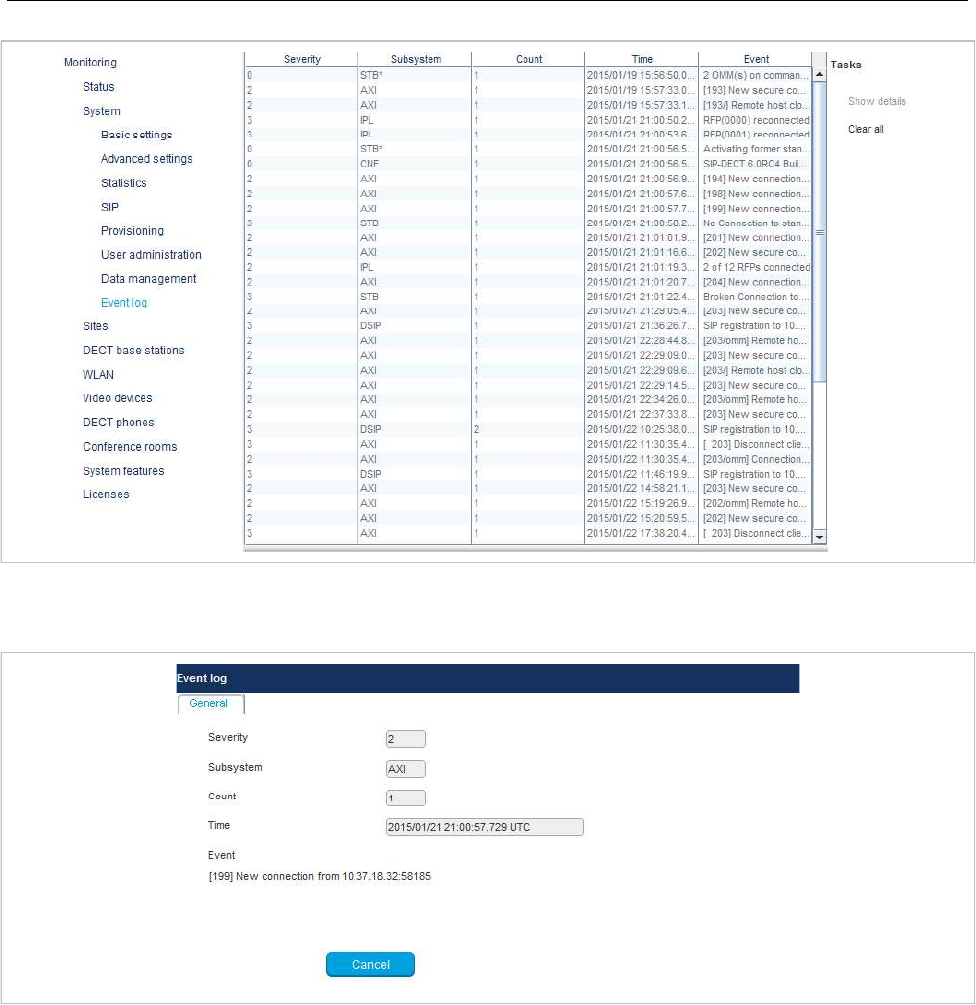
SIP-DECT OM System Manual
152
6.5.8.1Event log detail panel
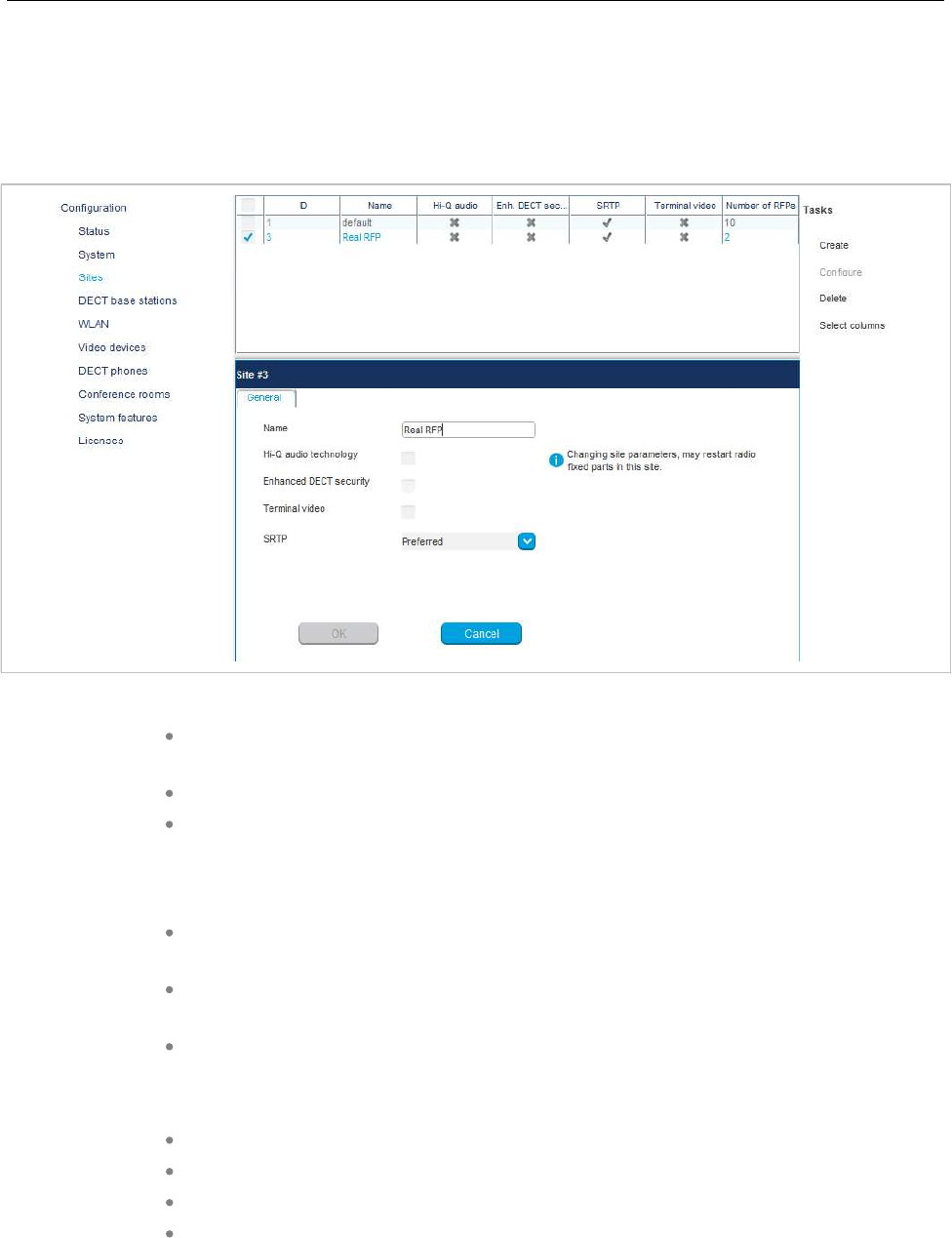
OM Management Portal (OMP)
153
6.6 “SITES” MENU
DECT base stations can be grouped into different sites. The Sites menu allows configuration and display
of configured sites. An empty system has one predefined site (ID: 1) named “default”. The system
requires a minimum of one site.
A site contains the following parameters:
ID: Identification number of the site. A value between 1 and 250 is possible. If no
value is given, the OMM selects the next free ID.
Name: The name of the site.
Hi-Q audio technology /
Enhanced DECT security /
Terminal video /
SRTP: These capabilities must be enabled or disabled specific for every site.
In sites, which are configured to provide this functionality, exclusively 3rd and 4th
generation RFPs are applicable.
In sites without this capability, it is allowed to mix these new RFP types with 2nd
generation RFPs.
Number of RFPs: The number of RFPs which are assigned to this site.
You can perform the following tasks:
Create: Create a new site in the General tab.
Configure: Configure an existing site in the General tab.
Delete: Delete selected sites (only sites without assigned RFPs can be deleted).
Show details (only in Monitor Mode): Shows configuration of a selected site in the
General tab.
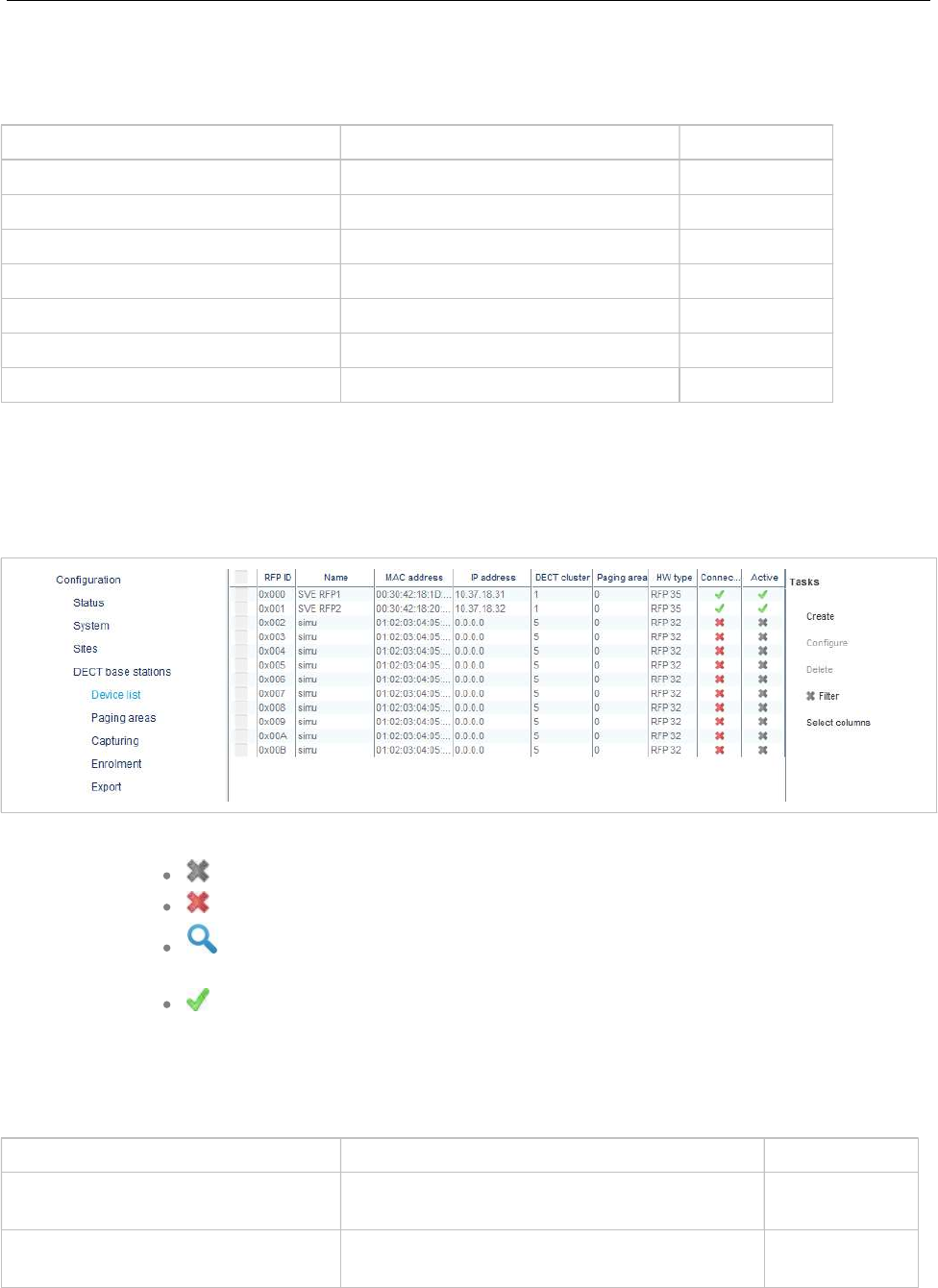
SIP-DECT OM System Manual
154
6.7 “DECT BASE STATIONS” MENU
DECT base stations can be configured and viewed in the DECT base stations menu.
Configuration mode Monitor mode See section
Device list Device list 6.7.1
Paging areas 6.7.2
Capturing 6.7.3
Enrolment 6.7.4
Export 6.7.5
Sync view 6.7.6
Statistics 6.7.7
6.7.1 “DEVICE LIST” MENU
The Device list panel displays all configured DECT base stations in a table. The device list is available
in Configuration Mode and Monitor Mode.
The Active column shows the following states:
– DECT is not enabled and/or RFP not connected.
– DECT is enabled and RFP connected, but DECT has not been activated yet.
– DECT is enabled and RFP is connected, but RFP is not synchronized and
searches for other synchronized RFPs.
– DECT is enabled and RFP is connected and synchronized.
Note: If the Active column is not displayed, you can activate it in the
Select columns dialog, see section 6.7.1.7.
The tasks you can perform are mode-dependant.
Configuration mode Monitor mode See section
Create: Create new base station in
detail panel
6.7.1.2
Configure: Configure selected base
station in detail panel
6.7.1.3
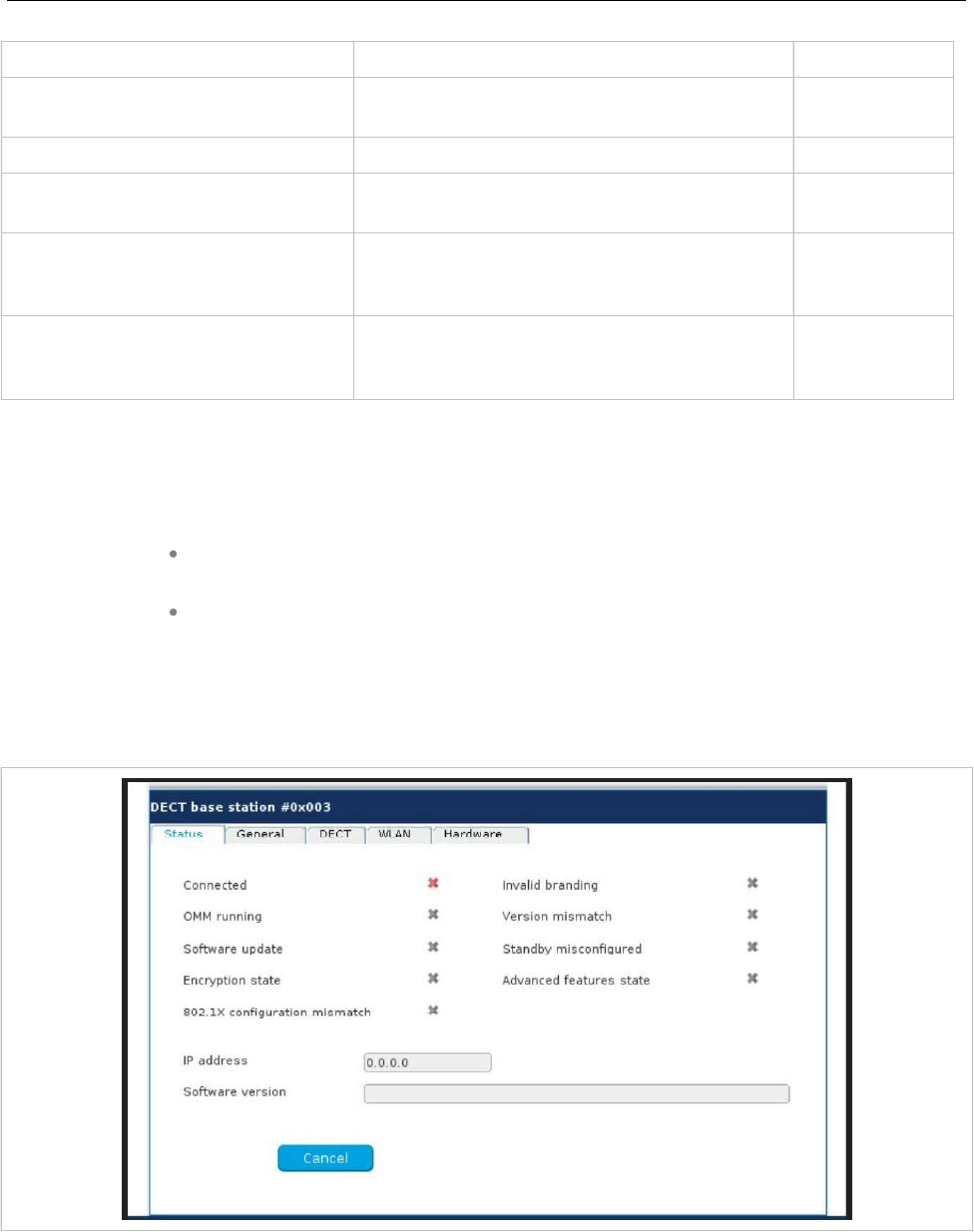
OM Management Portal (OMP)
155
Configuration mode Monitor mode See section
Show details: Show selected base station in
detail panel
6.7.1.4
Delete: Delete selected RFP 6.7.1.5
Show sync. relations: Show synchronization
relation for selected RFPs
6.7.1.6
Select columns: Select
columns/parameters to be shown in
RFP table
Select columns: Select columns/parameters
to be shown in RFP table
6.7.1.7
Filter: Show only RFP datasets in
table which contain a special search
string
Filter: Show only RFP datasets in table which
contain a special search string
6.7.1.8
6.7.1.1DECT Base Station Detail Panel
The DECT base station detail panel is used for configuration/display of RFP settings and creation of new
RFP datasets.
To call up the DECT base station detail panel, do one of the following:
Choose one of the commands in the task bar on the right of the DECT base
stations panel (Create,Configure, or Show details)
Double-click on the appropriate RFP entry in the RFP table.
The DECT base station detail panel contains the following parameter groups sorted in different tabs.
“Status” tab
The Status tab is only available in Monitor Mode, and shows system status information for the selected
DECT base station.
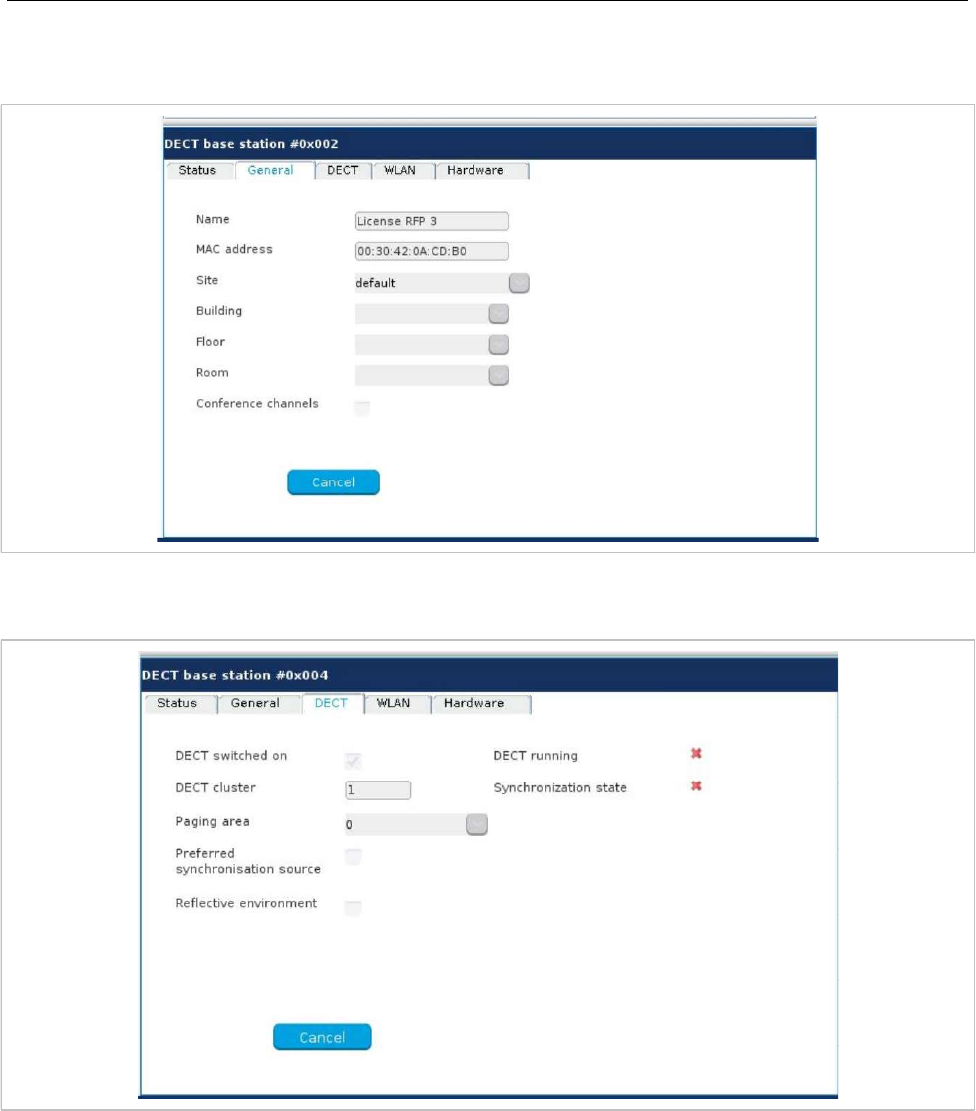
SIP-DECT OM System Manual
156
“General” tab
This tab contains the general DECT base station parameters.
“DECT” tab
This tab contains the DECT base station's DECT parameters.
“WLAN” tab
This tab contains the DECT base station's WLAN parameters. Settings in the WLAN tab apply to
RFP 42/43/48 WLAN base stations only.
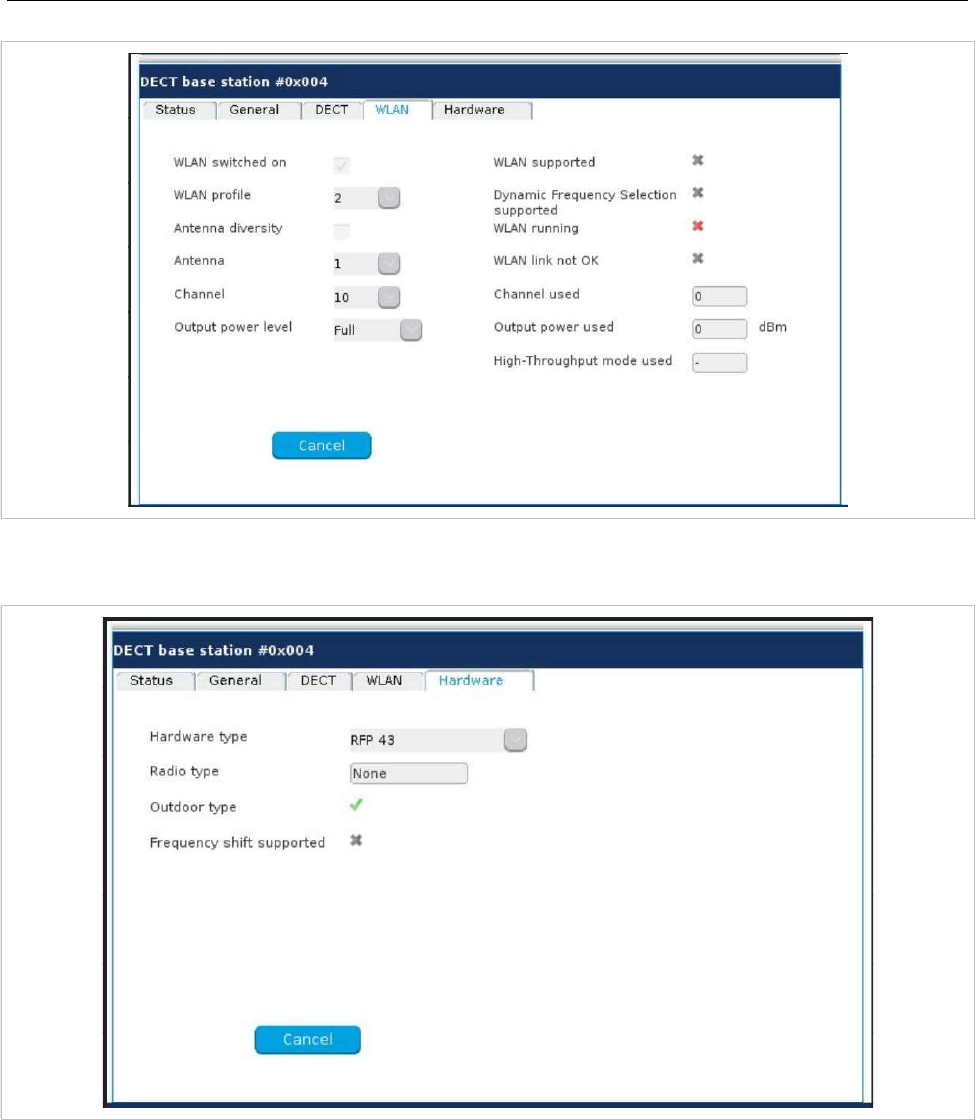
OM Management Portal (OMP)
157
“Hardware” tab
In Monitor Mode, this tab shows hardware information of the selected DECT base station.
In configuration mode, the DECT base station Hardware type can be set if it is connecting to the OMM
for the first time. Once the correct hardware type is received from the DECT base station, you cannot
change it.

SIP-DECT OM System Manual
158
6.7.1.2Adding New DECT Base Stations
You must be in Configuration Mode to add a new DECT base station. To add a DECT base station to
the list of known base stations, do the following:
1Click Create under the Tasks lists on the right side of the DECT base stations window.
The New radio fixed part panel opens.
2Configure the DECT base station (see parameter descriptions below).
3Click OK.
The following parameters can be set in the tabs of the New DECT base station panel:
“General” tab
Name: The name for the RFP.
MAC address: Each RFP is identified by its unique MAC address (6 bytes hex
format, colon separated). Enter the MAC address, it can be found on the back of the
chassis.
Site: If several sites exist, select the site the RFP is assigned to.
Building,Floor,Room: For easier localization of the RFP you can enter data in
these fields.
Conference channels: Activate this option to enable the RFP to provide channels
for 3-way conferencing. This option is available for 3rd or 4th generation RFPs (see
section 8.21.2).
“DECT” tab
DECT switched on: The DECT functionality for each RFP can be switched on/off.
DECT cluster: If DECT is active the RFP can be assigned to a cluster.
Paging area: Enter the paging area, the RFP is assigned to.
Note: The Paging area size is set in the DECT tab of the System
settings menu (see section 6.5.1). The assignment between
RFPs and paging areas can be changed in the Paging areas
menu (see section 6.7.2).
Preferred synchronization source: Activate this checkbox if the RFP should be
used as synchronization source for the other RFPs in the cluster. For background
information on RFP synchronization see section 8.2.
Reflective environment: Within areas containing lot of reflective surfaces (e.g.
metal or metal coated glass) in an open space environment the voice quality of a
DECT call can be disturbed because of signal reflections which arrive on the DECT
phone or RFP using multipath propagation. Calls may have permanent drop outs
while moving and high error rates on the RFPs and DECT phones.
For such environment Mitel has developed the DECT XQ enhancement into base stations and the
Mitel 600 DECT phones family. Using this enhancement by switching the Reflective environment
flag on might reduce drop outs and cracking noise.
As soon as Reflective environment is switched on, the number of calls on an RFP 32/34
respectively. RFP 42 WLAN, RFP 35/36/37 IP resp. RFP 43 WLAN or RFP 44/45/47 respectively.
RFP 48 WLAN is reduced to 4 calls at the same time.

OM Management Portal (OMP)
159
Please note: The RFPs and DECT phones use more bandwidth on the Air Interfaces if the
“Reflective environment“ is switched on. Therefore this shall only be used when problems
sourced by metal reflections are detected.
“WLAN” tab
Settings in the WLAN tab apply to RFPs of the type “RFP 42/43/48 WLAN”, “RFP 43 WLAN” and
“RFP 48 WLAN” only. For details about WLAN configurations please see section 8.18.
Please note: WLAN properties can only be set if the correct hardware type is configured in
the Hardware tab.
WLAN switched on: The WLAN functionality for an RFP 42 WLAN, RFP 43 WLAN
or RFP 48 WLAN can be switched on/off.
For a description of the other parameters which can be set in the WLAN tab, see the
description of the DECT base stations page of the OMM Web service (see section
5.6.3). The corresponding parameters can be found there in the WLAN settings
section.
“Hardware” tab
WLAN properties can only be set if the correct hardware type is configured. This can be done manually
before an RFP connects with the OMM and an automatic detection is possible (Auto setting).
6.7.1.3 Changing DECT base station configuration
Changing RFPs is only possible in configuration mode. To change the configuration of an existing
RFP, do the following:
1Select the appropriate RFP in the RFP table.
2Click Configure under the Tasks lists on the right side of the DECT base stations window.
The DECT base station detail panel opens.
3Change RFP parameters (see descriptions in section 6.7.1.2).
4Click OK.
6.7.1.4Viewing DECT base station Details
You can view the configuration of an RFP in Monitor Mode. Proceed as follows:
1Select the appropriate RFP in the RFP table.
2Click Show details under the Tasks lists on the right side of the DECT base stations window.
The DECT base station detail panel opens.
3To close the RFP detail panel, click Cancel.
6.7.1.5 Deleting DECT base stations
You can only delete DECT base stations in Configuration Mode. To delete a DECT base station, do the
following:
1Select the DECT base station (s) in the table by selecting the corresponding checkbox(es).

SIP-DECT OM System Manual
160
2Click Delete under the Tasks lists on the right side of the DECT base stations window.
The Delete selected DECT base station(s) dialog opens showing a confirmation prompt.
3Click OK to confirm.
Please note: License DECT base stations cannot be deleted.
6.7.1.6Showing Synchronization Relations
You can view the synchronization relations of a DECT base station in Monitor Mode. Do the following:
1Select the appropriate RFPs in the RFP table. At least two RFPs must be selected to show their
synchronization relations.
2Click Show sync. Relations under the Tasks lists on the right side of the DECT base stations
window.
The view switches to the Sync view menu . For further information see section 6.7.6.
6.7.1.7Selecting Columns
You can customize the parameters shown in the DECT base station table:
1Click Select columns under the Tasks lists on the right side of the DECT base stations window.
The Select columns dialog opens.
2Select the columns that shall be shown by activating the appropriate checkboxes.
3Click the OK button.
The DECT base station table is updated accordingly.
6.7.1.8Filtering the DECT base station table
You can filter the list of DECT base station datasets shown in the table by using a filter.
1Click Filter under the Tasks lists on the right side of the DECT base stations window.
The Filter dialog opens.
2Enter the search string that serves as filter criterion. You can enter digits and characters. The search
is case sensitive.
3Click on the Filter button.
The Filter dialog is closed and the table is adjusted accordingly.
4To reset the filter, click on the Filter command in the task bar on the right of the DECT base stations
panel.
5In the Filter dialog click on the Reset button.
6.7.2 “PAGING AREAS” MENU
The Paging area menu shows all configured RFPs in a tree structure consisting of two trees:
The left Unassigned RFPs tree contains all RFPs without an assigned paging area.
The right Paging areas tree shows all configured paging areas with RFPs assigned
to these paging areas.
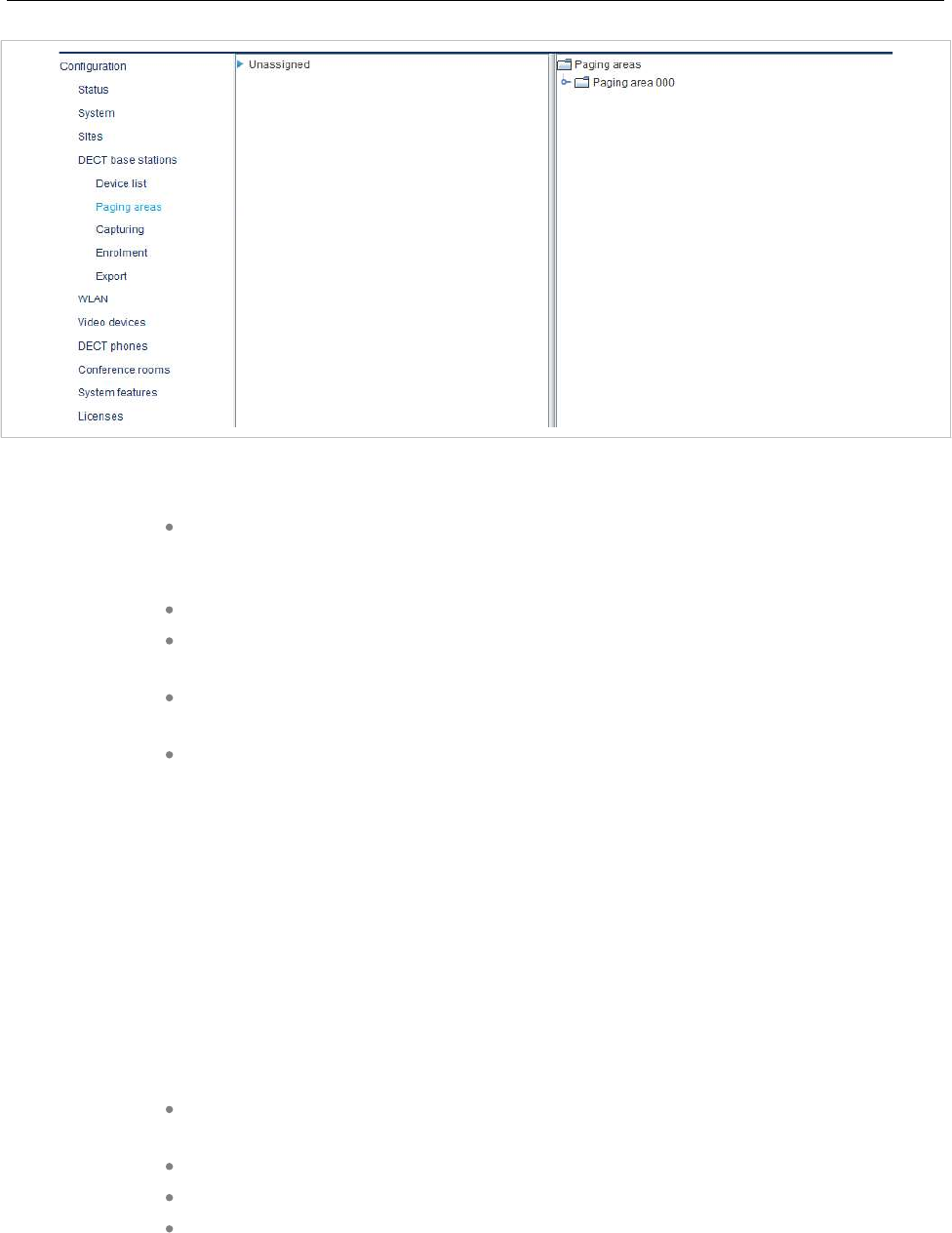
OM Management Portal (OMP)
161
All DECT base stations are shown including their site and optional hierarchy (building, floor, and room)
settings.
DECT base stations can be moved by drag and drop from unassigned tree to paging
area tree and vice versa, as well as between different paging areas inside the
paging area tree.
Only one DECT base station node can be moved at once.
If a site or a hierarchy node is selected, all DECT base stations that are children of
this node are moved.
If a paging area is completely filled with DECT base stations, moving additional
DECT base stations in that paging area is not permitted.
If not all DECT base stations (selected by a site or hierarchy node) can be moved
into a paging area, you are asked if you want to move as many DECT base stations
as possible or if the operation should be cancelled.
Note: The Paging area size is set in the DECT tab of the System
settings menu (see section 6.5.1).
6.7.3 “CAPTURING” MENU
OMP supports the capture of DECT base stations that try to connect to OMM. These DECT base
stations are assigned to OMM by DHCP options or OMM Configurator settings. Capturing is only
accessible in Configuration Mode.
Available tasks:
Capturing: Start/stop capturing (active capturing is indicated with a green check
mark)
Add all: Add all captured DECT base stations to OMM
Add selected: Add selected DECT base stations to OMM
Remove all: Remove selected DECT base stations from list (without adding to
OMM)

SIP-DECT OM System Manual
162
Remove selected: Remove selected DECT base stations from list (without adding
to OMM)
Select columns: Select DECT base station capturing table columns to be shown
6.7.4 “ENROLMENT” MENU
The Enrolment menu allows import of DECT base station datasets using a configuration file. For
information about required configuration file format, see section 12.3.
1Click the File button.
A file system dialog opens in which you can select the configuration file. The configuration file must be
encoded in UTF-8.
2To check the results from reading the configuration file press the Show log file button. In case of file
format errors these errors are listed here.
If reading of configuration file is successful, all DECT base station datasets read are shown in a newly
created table. This table contains, apart from some DECT base station parameters, the Status
column which shows the current import status for every DECT base station dataset:
– Not enrolled yet
– Enrolment failed
– OK (Enrolment successful)
3Start the import by selecting one of the following commands:
Add all: Import all DECT base station datasets into the OMM.
Add selected: Import selected DECT base station datasets to the OMM. For
selection activate the corresponding checkboxes in the DECT base station table.
Remove all: Remove all DECT base station datasets from table. The table will be
hidden.
Remove selected: Remove selected DECT base station datasets from table. If the
table is empty after removing of datasets, the table will be hidden. For selection
activate the corresponding checkboxes in the DECT base station table.
Show status: Show import status of a selected DECT base station dataset. If
enrolment failed for this DECT base station, a message describing the enrolment
error is shown.
Select columns: Select the columns that shall be shown in DECT base station table
(see also 6.7.1.7).
6.7.5 “EXPORT” MENU
The Export menu allows export of all DECT base stations enrolled to the OMM to a “.csv” file. The
generated file can be viewed with a standard spreadsheet application.
All enrolled DECT base stations are shown in a table.
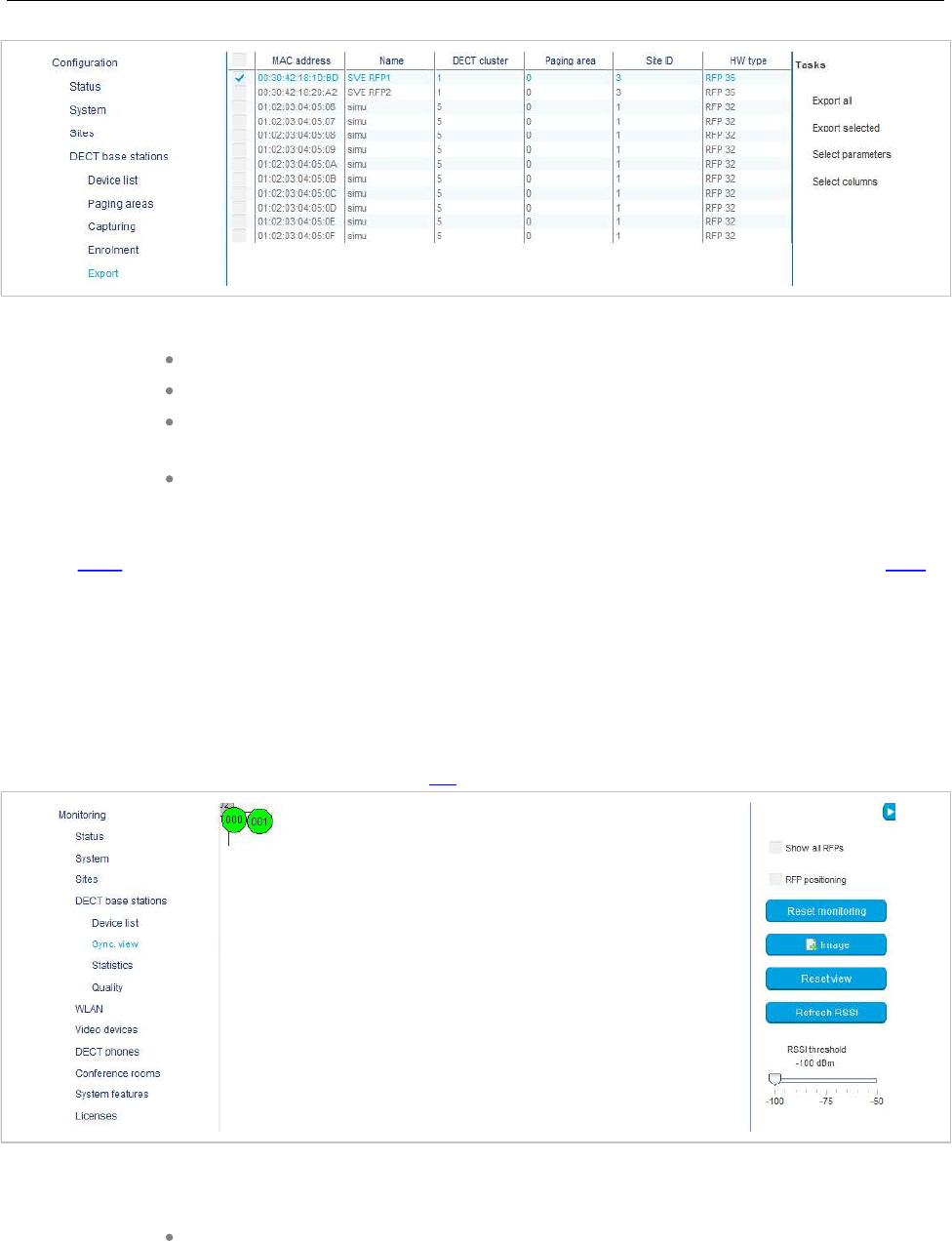
OM Management Portal (OMP)
163
The following tasks can be performed:
Export all: Export all DECT base station datasets.
Export selected: Export selected DECT base station datasets.
Select parameters: Select DECT base station parameters to be written to the .csv
file (select all DECT base station parameters or a subset of these parameters).
Select columns: Select the columns to be written to the .csv file.
When the export begins, a file system dialog opens where you can select the export file name. If all
parameters are selected for export, the export file can be re-imported using the Enrolment function (see
section 6.7.4). For information about DECT base station export file format, see Appendix (section 12.4).
6.7.6 “SYNC VIEW” MENU
The Sync view menu allows verification of the synchronization between DECT base stations in a
graphical manner.
Note: For information on DECT base station synchronization, see
section 8.2.
To open the task panel, click the arrow icon in the upper right corner of the Sync view panel.
The task panel is displayed on the right. The following tasks can be performed:
Show all RFPs: If this checkbox is activated, all configured RFPs are shown in the
sync panel; else only selected RFPs are shown.

SIP-DECT OM System Manual
164
RFP positioning: If this checkbox is activated, RFP positions can be changed; else
RFP positions are fixed.
Reset monitoring: Reset all active sync view monitoring relations.
Image: Select background image for sync panel.
Reset view: Reset selected view (zero coordinates are reset to the left upper corner
of the sync view panel).
Refresh RSSI: Request new RSSI values from OMM for active sync relations.
Viewing sync relations
DECT base stations for which sync relations shall be shown, can be selected as follows:
Select (more than one) DECT base station in device list table.
or
Activate DECT base station mouse menu in sync view: Press the right mouse button
while mouse cursor is on an DECT base station icon and select the Activate
Monitoring command from the context menu.
The color of the DECT base station icon indicates synchronization state of that DECT base station:
Grey: Inactive
Red: Not synchronized
Yellow: Searching
Green: Synchronized
Sync relations between DECT base stations are represented by arrows.
Viewing RSSI values
The color of the arrows between DECT base stations is an indication of the RSSI value of the link:
Red: RSSI < -90 dBm
Orange: -90 dBm <= RSSI <= -70 dBm
Green: RSSI > -70 dBm
If the mouse is moved over a DECT base station with monitoring activated, a tool tip with RSSI values is
displayed.
You can use the RSSI threshold slider to limit the display of values in the tool tip.
6.7.7 “STATISTICS” MENU
The DECT base stations -> Statistics menu provides information about DECT base station statistics
counters. It contains:
an overview panel with all statistics counters (see section 6.7.7.1)
multiple statistics group panels, where related statistics counter types are grouped
together (see section 6.7.7.2).
The menu is only available in Monitor Mode.
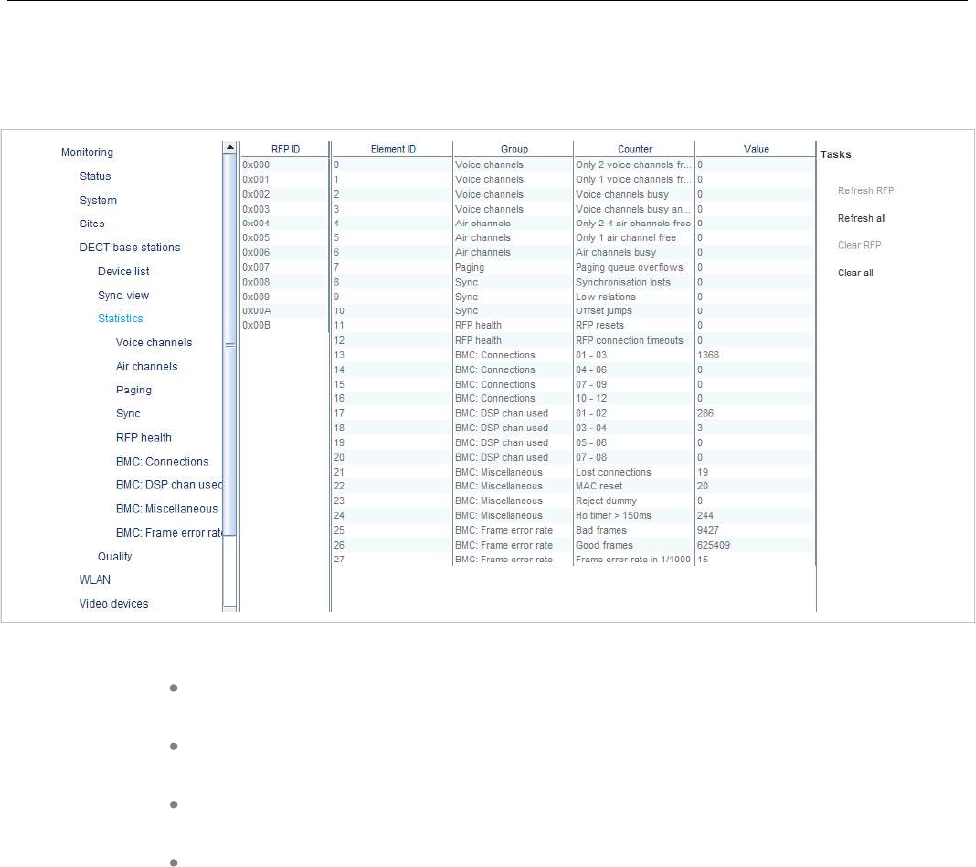
OM Management Portal (OMP)
165
6.7.7.1DECT base station Statistics Overview
The DECT base station statistics overview page contains a list of DECT base stations by ID, and an
overview of all DECT base station statistics counters.
The following tasks can be performed:
Refresh RFP: Request counter update by OMM for selected DECT base station
statistics counters.
Refresh all: Request counter update by OMM for all DECT base station statistics
counters.
Clear RFP: Clear all DECT base station statistics counters on selected DECT base
station.
Clear all: Clear all DECT base station statistics counters.
If a DECT base station is selected (left RFP ID table), the statistics counter table shows counter values
for that DECT base station (right table). When a statistics counter entry is selected, a detail panel opens
which shows more detailed information for that counter.
The detail panel shows values for total occurrence and occurrence in current and last week. You can
clear the selected statistics counter on the selected DECT base station by pressing the Clear button.
6.7.7.2DECT base station Statistics Group Panels
The DECT base station statistics group panels divide DECT base station statistics counters into logical
groups. This allows display of all statistics counters of a special group of all DECT base stations in one
table.
The group panels are listed under the Statistics menu entry in the left panel.
Note that with SIP-DECT 6.0 or later, the statistic data collected by the BMC part of each DECT base
station device (in the DECT MAC layer) are now shown with the DECT base station statistic data
collected by the OMM.
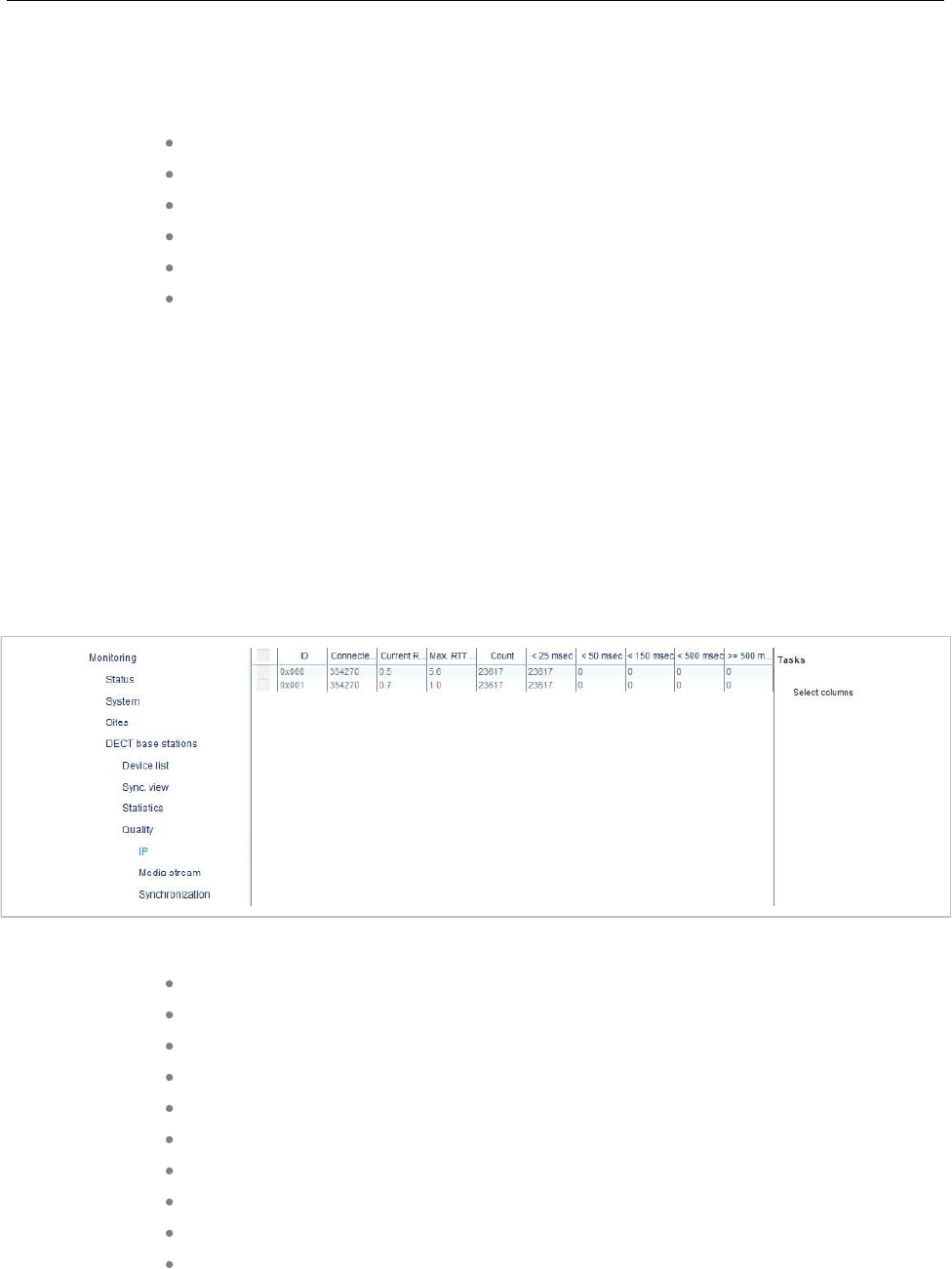
SIP-DECT OM System Manual
166
As an update between OMM and DECT base station usually occurs once every hour, it can take up to
one hour for an event that increments a BMC statistic counter to appear in the OMP.
The following tasks can be performed:
Refresh RFP: Request counter update by OMM for selected DECT base station.
Refresh all: Request counter update by OMM for all counters.
Clear group RFP: Clear counter group of selected DECT base stations.
Clear group: Clear counter group of all DECT base stations.
Clear RFP: Clear all counters of selected DECT base station.
Clear all: Clear all counters of all DECT base stations.
6.7.8 “QUALITY” MENU
OMP provides a monitoring ability for critical IP network parameters. Administrators can check basic
network quality information for all DECT base stations. This includes Voice quality (Jitter, Packet lost)
and OMM to RFP link quality (Roundtrip delay).
The menu is only available in Monitor Mode.
6.7.8.1 IP
IP quality menu provides information about link quality between DECT base stations and OMM.
Displayed parameters:
ID: Radio fixed part identifier
Connected time: Time the RFP is connected to OMM (sec)
Current RTT: Current roundtrip time between RFP and OMM (msec)
Max. RTT: Maximal detected roundtrip time between RFP and OMM
Count: Number of roundtrip time measures
< 25 msec: Number of roundtrip time measures lower than 25 msec
< 50 msec: Number of roundtrip time measures between 25 and 50 msec
< 150 msec: Number of roundtrip time measures between 50 and 150 msec
< 500 msec: Number of roundtrip time measures between 150 and 500 msec
>= 500 msec: Number of roundtrip time measures 500 msec and more
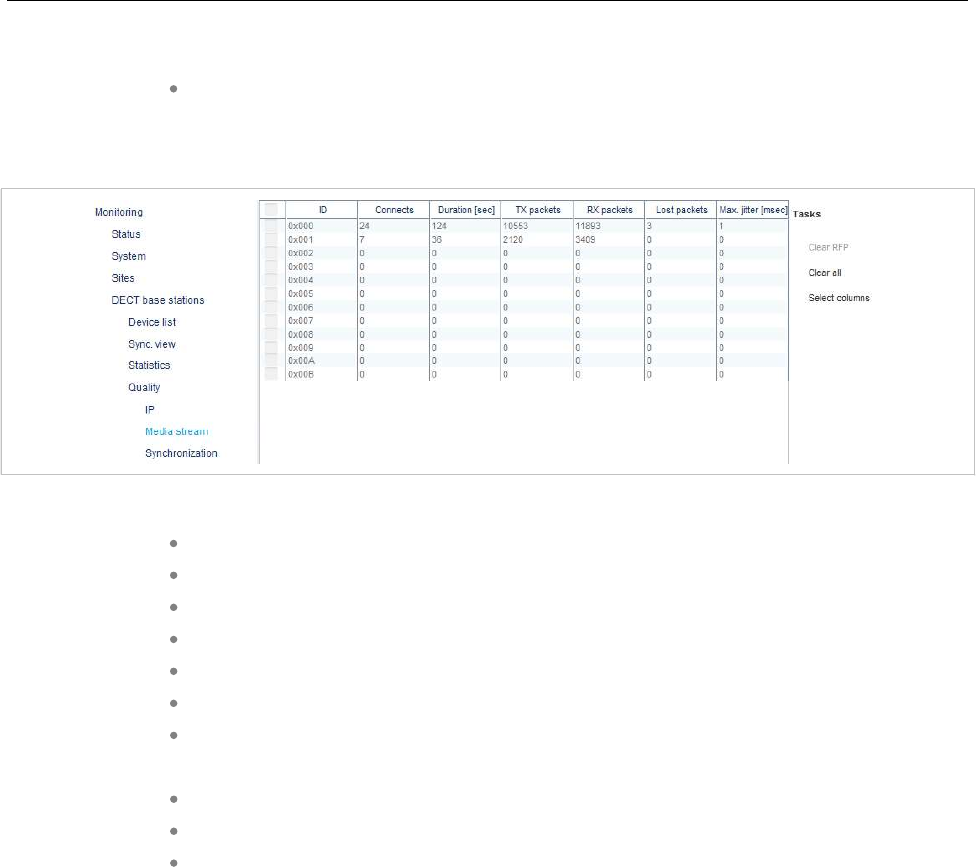
OM Management Portal (OMP)
167
Available tasks:
Select columns: Columns to be shown in IP quality table
6.7.8.2 Media Stream
Media stream panel provides information about voice quality.
Displayed parameters:
ID: Radio fixed part identifier
Connects
Duration (sec)
TX packets
RX packets
Lost packets
Max. jitter(msec)
Available tasks:
Clear RFP: Clear values for selected RFPs
Clear all: Clear values for all RFPs
Select columns: Select media stream quality table columns to be shown
6.7.8.3 Synchronization
Synchronization panel allows checking the synchronization status of RFPs which allows identifying RFPs
with bad synchronization coverage.
Synchronization monitoring can optionally be run in snapshoot mode. If this mode is activated, data
update must be triggered by a user otherwise data were updated automatically anytime if new values
arrive from OMM.
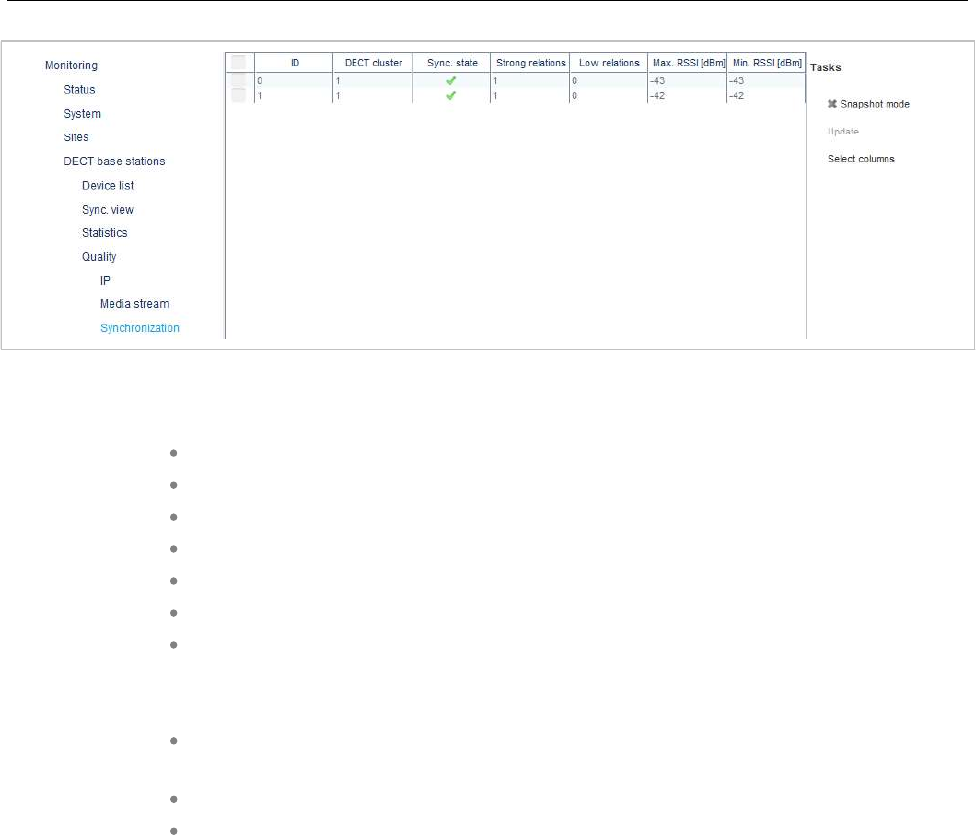
SIP-DECT OM System Manual
168
Available parameters:
ID: Radio fixed part id
DECT cluster: Cluster of the RFP
Sync state: Synchronization state of the RFP
Strong relations
Low relations
Max. RSSI (dBm)
Min. RSSI (dBm)
Available tasks in media synchronization quality table:
Snapshot mode: Enable snapshot mode (green check mark indicates snapshot
mode is on)
Update: Request data update in snapshoot mode
Select columns: Select synchronization quality table columns to be shown
6.8 “WLAN” MENU
OMP supports configuration of WLAN profiles and provides an overview of wireless clients currently
connected.
6.8.1 PROFILES
OMM supports up to 20 WLAN profiles, which can be added, changed and deleted in OMP configuration
mode. Configuration and state of any WLAN profile can be checked in monitoring mode.
6.8.1.1WLAN Profiles - configuration mode
WLAN profile configuration menu provides an overview of all configured WLAN profiles.
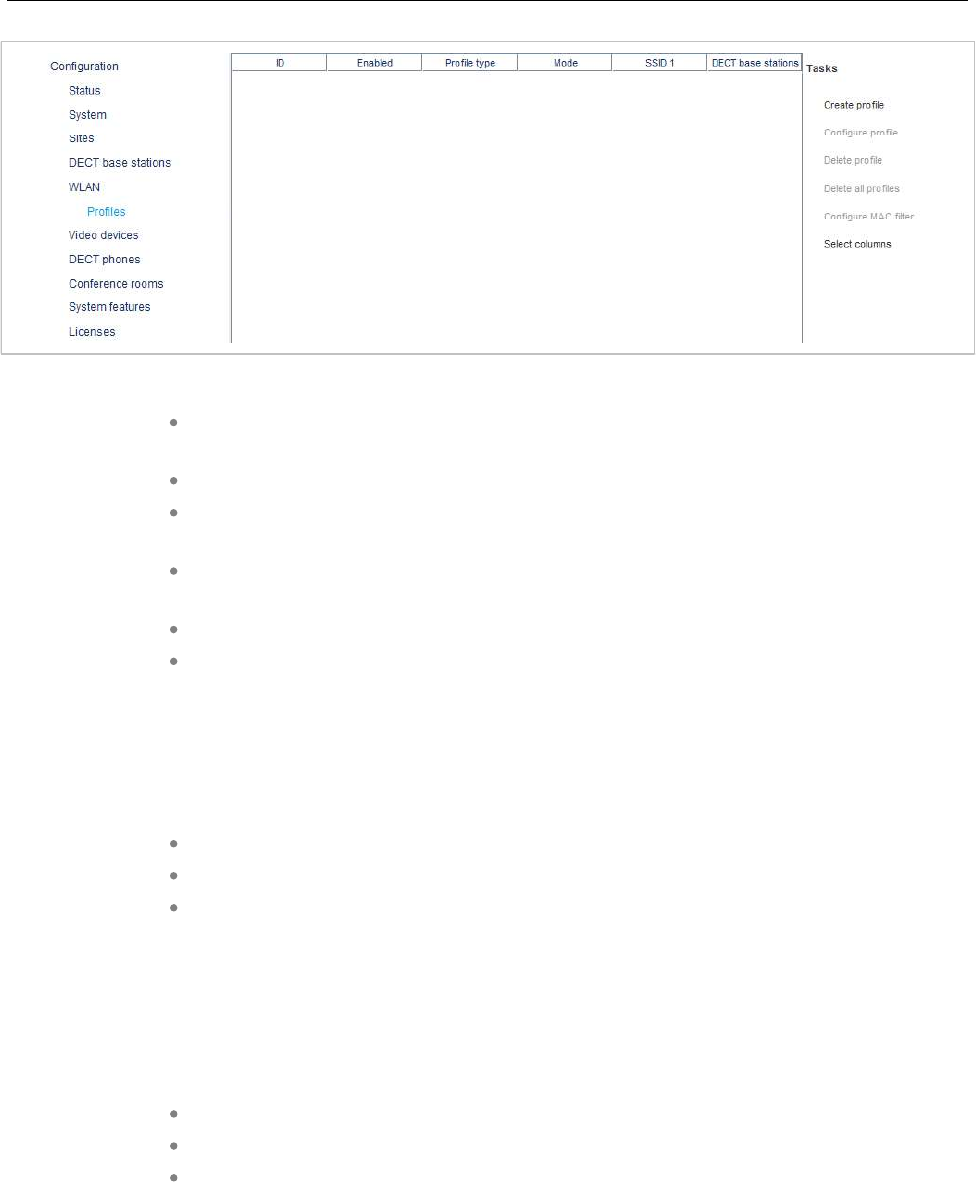
OM Management Portal (OMP)
169
The following tasks are available in this menu:
Create profile: Create a new WLAN profile (available if the maximal number of 10
WLAN profiles is not yet reached)
Configure profile: Reconfigure selected profile
Delete profile: Deletes a selected profile (only available if selected profile is not in
use by any Radio fixed part)
Delete all profiles: Deletes all existing profiles (only available if none of these
profiles is in use by any Radio fixed part)
Configure MAC filter: Add, configure, delete MAC filter for selected profile
Select columns: Select WLAN profile table columns to be shown
6.8.1.2 WLAN Profiles Monitoring Mode
WLAN profile monitoring menu shows all configured WLAN profiles.
The following tasks are available:
Show Profile: Show details of selected WLAN profile
Show MAC filter: Show configured MAC filter of selected WLAN profile
Select columns: Select WLAN profile table columns to be shown
6.8.1.3 WLAN Profile Detail Panel
WLAN profile detail panel is used to create, reconfigure or show a profile. It consists of different tabs
which are used for general settings of WLAN profile, SSID configuration and SSID security settings.
WLAN profile detail panel is opened if one of the following tasks is performed in WLAN profile menu:
Create profile (configuration mode)
Configure profile (configuration mode)
Show profile (monitoring mode)
The “General” tab is always shown and configures/shows general settings of this profile like enabling of
profile and profile type.
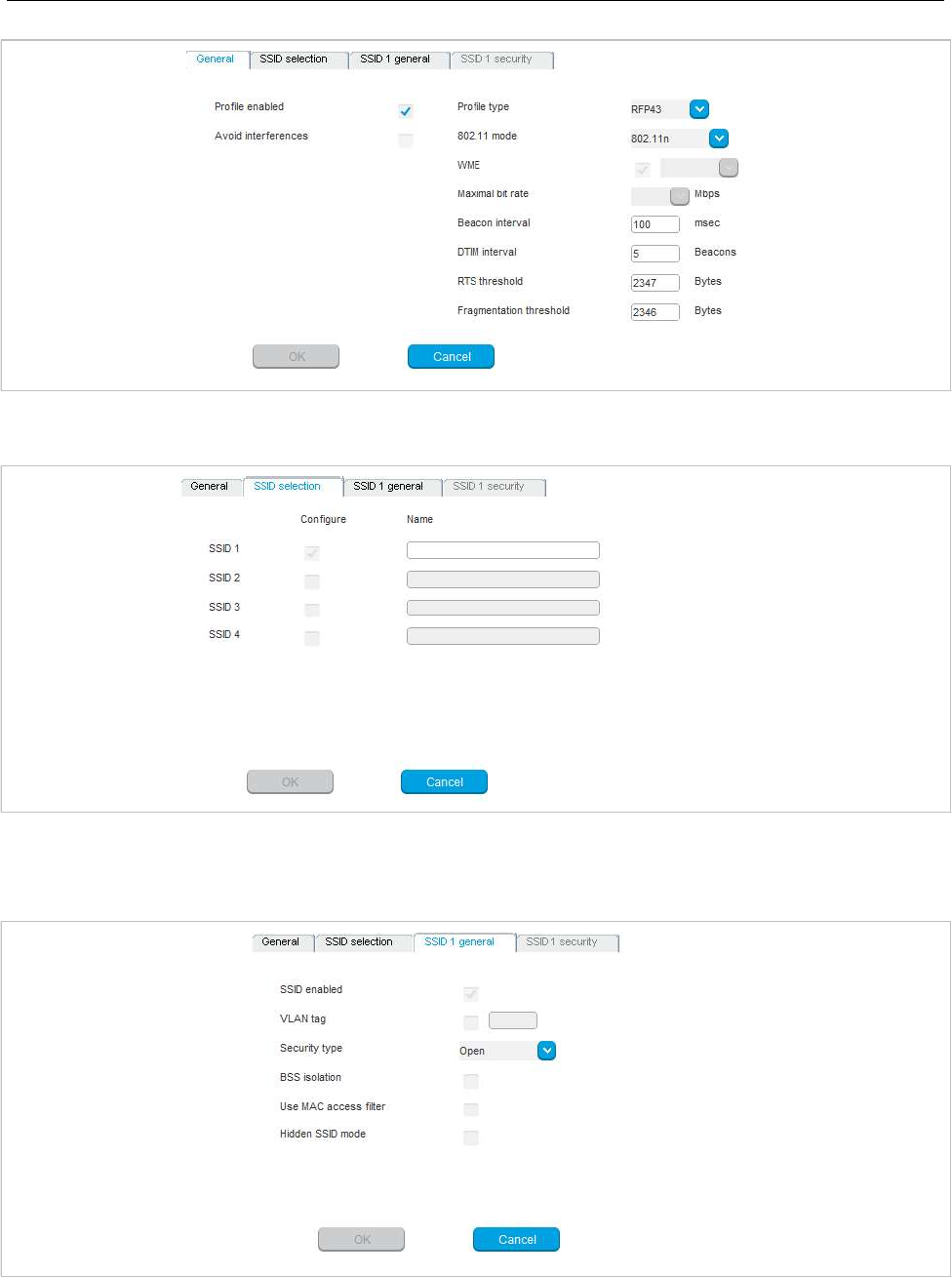
SIP-DECT OM System Manual
170
The ”SSID selection” tab is used for enabling of SSIDs. At least “SSID 1” is always enabled. “SSID 2”,
“SSID 3” and “SSID 4” can be activated optional.
The “SSID x general” tab is shown for any activated SSID. Among other things, you can use it to select
Security type.
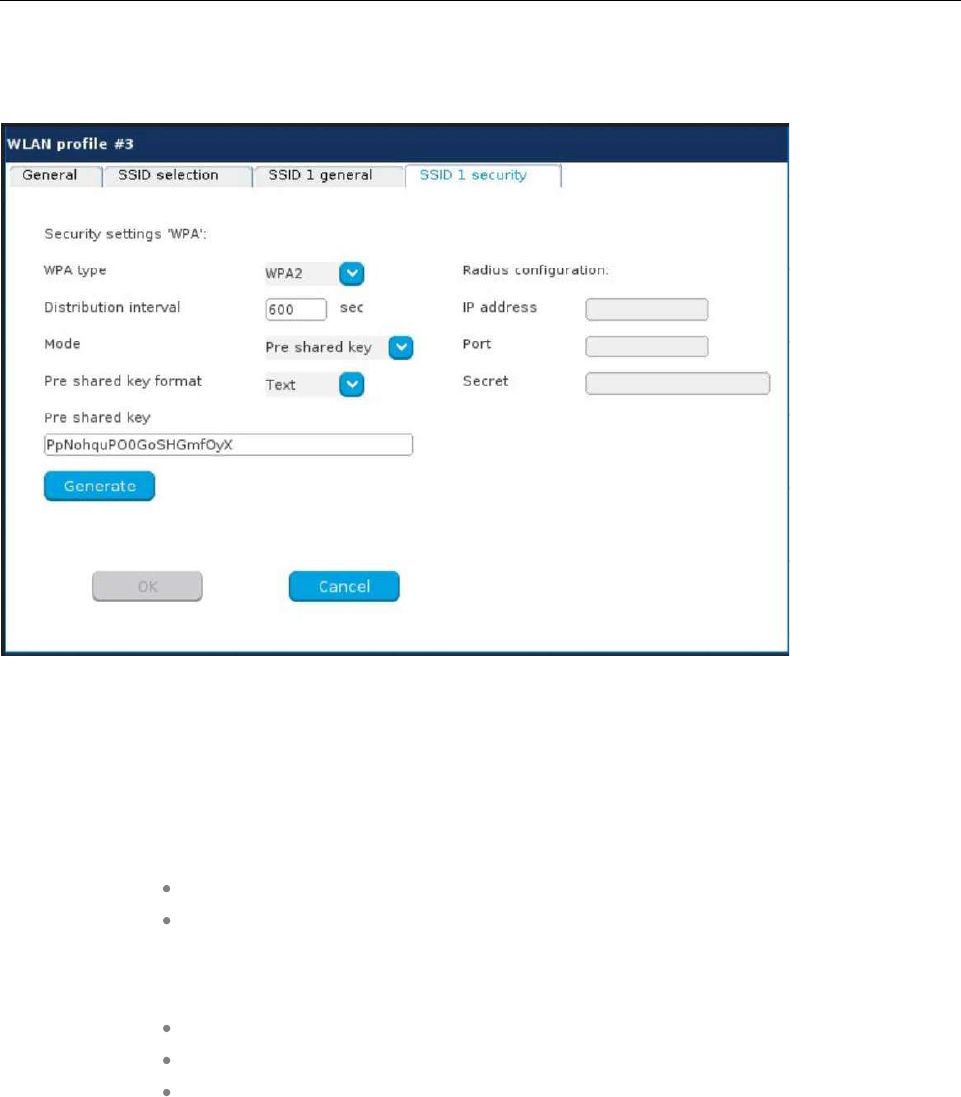
OM Management Portal (OMP)
171
A tab “SSID x security” is shown as well. It is accessible only for SSIDs with security type set to “WEP”
or “WPA”. If security type stays at “Open” this tab is inactive. It allows setting of all necessary security
parameters for this SSID.
6.8.1.4MAC Access Filter Detail Panel
MAC access filter detail panel in configuration mode allows the adding, configuring and deleting of
MAC access filters. File import and export of MAC access filters is supported as well.
Monitoring mode shows all configured MAC access filters only.
MAC access filter detail panel is opened if one of the following tasks is performed in WLAN profile menu:
Configure MAC filter (configuration mode)
Show MAC filter (monitoring mode)
The “General” tab in configuration mode shows all configured MAC access filter.
The following actions are available:
Create: Create new MAC access filter
Configure: Change name of selected MAC access filter
Delete: Delete all selected MAC access filter
The “Import” tab (configuration mode only) provides import of a list of MAC access filter from file.
The “Export” tab (configuration mode only) provides export of all configured MAC access filters to file. If
no MAC access filter is configured, this tab is inactive.
6.8.1.5 Clients
WLAN clients menu which is available in monitoring mode only, shows all currently connected wireless
clients.

SIP-DECT OM System Manual
172
6.9 “VIDEO DEVICES” MENU
The Video devices panel lists all configured video devices. The device list is available in Configuration
Mode as well as in Monitor mode.
New video device entries show up automatically after they are connected to and recognized by a DECT
base station. The Plugged and State columns shows the following states:
/unplugged – Video device is not connected.
/plugged – Video device is connected.
/started – Video device is being watched in the OM Locating application.
/stopped – Video device is connected but disabled in the OMP.
The Tag column shows the USB ID of the connected video device. The USB path column shows the
USB port number to be used, e.g. “1” is a video device connected directly to the RFP while “1.1”
indicates an indirect connection using an USB hub.
The tasks which can be performed are mode-dependant.
Configuration mode Monitor mode See section
Configure: Configure selected video device
in detail panel
6.9.1
Show details: Show selected video
device in detail panel
6.9.2
Delete: Delete selected disconnected video
device
6.9.3
Filter: Show only video device entries in
table which contains a special search string
Filter: Show only video device
entries in table which contains a
special search string
6.9.4
6.9.1 CHANGING VIDEO DEVICES
Changing video devices is only possible in Configuration Mode. To change the configuration of an
existing video device, do the following:
1Select the appropriate video device in the video devices table.
2In the task bar on the right of the Video devices panel click on the Configure command.
The video device detail panel opens.
3Change video device parameters, see description below.
4Press the OK button.
Please note: You cannot change the configuration for a video device that is being watched
in the OM Locating application (State column shows “active”). You must disable the video
device first by deactivating the Active option.
The following parameters can be set in the General tab of the Video devices panel:
Active: Disable this option to switch off the video device. This also switches off the
status LED of the video device immediately (if applicable).
Name: Enter a meaningful name for the video device.

OM Management Portal (OMP)
173
Building, Floor, Room: For easier localization of the video device you can enter
data in these fields.
Resolution: Select a resolution for the video device. Higher resolutions require
more bandwidth when watching the video image in the OM Locating application.
Note, that not all video devices support all available resolutions. Default: “VGA (640
x 480)”.
Frame rate: Select a frame rate (2-10 frames per second). Higher frame rates
require more bandwidth when watching the video image in the OM Locating
application.
6.9.2 VIEWING VIDEO DEVICE DETAILS
You can view the configuration of a video device in monitor mode. Proceed as follows:
1Select the appropriate video device in the video devices table.
2In the task bar on the right of the Video devices panel click on the Show details command.
The video device detail panel opens (see 0).
3Click Cancel to close the video device detail panel.
6.9.3 DELETING VIDEO DEVICES
Deleting video devices is only possible in Configuration Mode. To delete one or more existing video
devices proceed as follows:
1Select the appropriate video device(s) in the video devices table by activating the corresponding
checkbox(es). Note that you can only delete disconnected video devices.
2In the task bar on the right of the Video devices panel click on the Delete command.
The Delete selected video devices(s) dialog opens showing a confirmation prompt.
3Confirm the displayed prompt with OK.
6.9.4 FILTERING VIDEO DEVICE TABLE
You can filter the list of video device entries shown in the video devices table by using a filter.
1In the task bar on the right of the Video devices panel click on the Filter command.
The Filter dialog opens.
2Enter the search string that serves as filter criterion. You can enter digits and characters. The search
is case sensitive.
3Click on the Filter button.
The Filter dialog is closed and the video device table will be adapted accordingly.
4To reset the filter, click on the Filter command in the task bar on the right of the Video devices panel.
5In the Filter dialog click on the Reset button.
6.10 “DECT PHONES” MENU
DECT phone datasets can be configured and viewed in the DECT phones menu. The DECT Phones
menu contains different submenus. Each submenu displays its own table of DECT phone datasets.
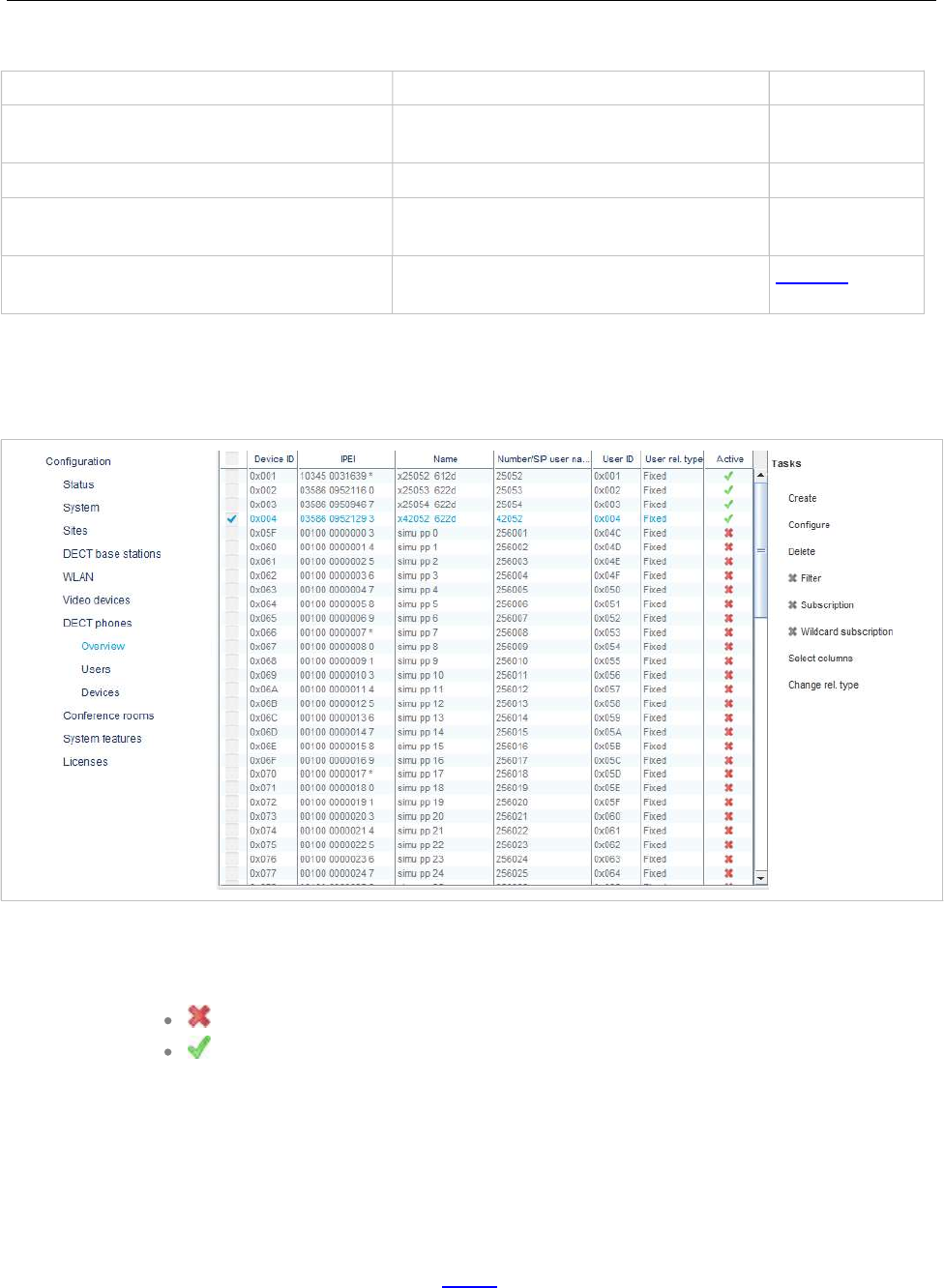
SIP-DECT OM System Manual
174
Configuration mode Monitor mode See section
Overview: Displays all user and device-
related DECT phone data
Overview: Displays all user and device-
related DECT phone data
6.10.1
Users:Displays all DECT phone user data 6.10.2
Devices: Displays all DECT phone device
data
Devices: Displays all DECT phone
device data
6.10.3
User monitoring: Displays the status of
all monitored users
8.29.7.3
6.10.1 ”OVERVIEW” MENU
In the Overview panel, all user-related and device-related DECT phone data are listed in a table. The
overview is available in Configuration Mode and Monitor mode.
In Configuration Mode, the Overview panel allows you to create fixed DECT phones (i.e., user and
device are permanently associated).
The Active column shows the following states:
- DECT phone is not subscribed to the system.
- DECT phone is subscribed to the system.
Note: If the Active column is not displayed, you can activate it in the
Select columns dialog, see section 6.10.9.
To view the user-device-relation, ensure that the User ID and
Device ID columns are also activated.
In monitor mode you can view the registration status of a DECT phone user by activating the
Registered,Registrar server type,Registrar server and Registrar port columns. See section 6.10.9
for information on selecting columns and section 8.20.6 for information on the SIP registration status.
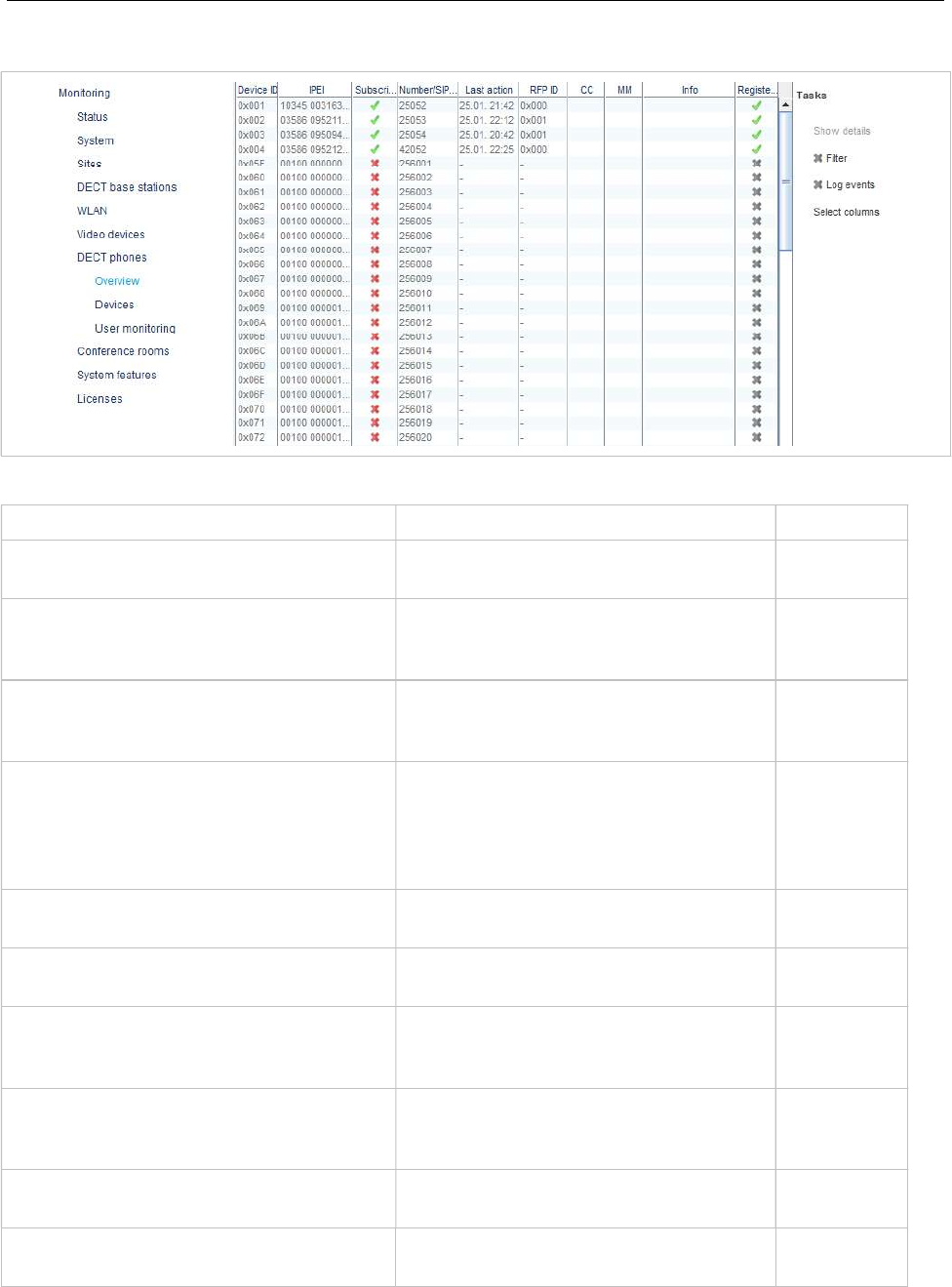
OM Management Portal (OMP)
175
The tasks you can perform are mode-dependant.
Configuration mode Monitor mode See section
Create: Create new fixed DECT phone
dataset in detail panel
6.10.5
Configure: Configure selected DECT
phone user and device dataset in detail
panel
6.10.6
Show details: Show selected DECT
phone user and device dataset in detail
panel
6.10.4
Delete: Delete selected DECT phone user
and device dataset (in case of fixed
relation) or delete DECT phone user and
set device to unbound status (in case of
dynamic relation)
6.10.8
Subscription: Start DECT phone
subscription
6.10.7
Wildcard subscription: Start DECT
phone wildcard subscription
6.10.7
Select columns: Select
columns/parameters to be shown in DECT
phone table
Select columns: Select
columns/parameters to be shown in
DECT phone table
6.10.9
Filter: Show only DECT phone datasets in
table which contain a special search string
Filter: Show only DECT phone datasets
in table which contain a special search
string
6.10.10
Change rel. type: Change the DECT
phone relation type
6.10.11
Log events: Enable/disable DECT
phone event log
6.10.11
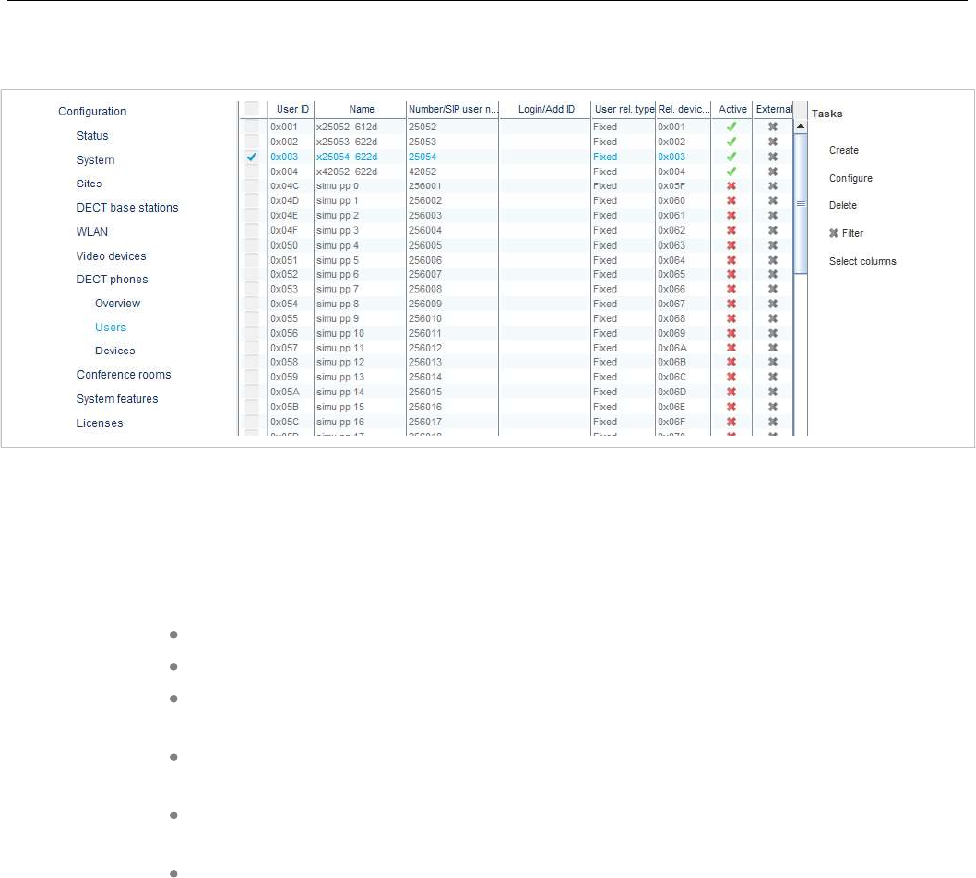
SIP-DECT OM System Manual
176
6.10.2 “USERS” MENU
In the Users panel, all DECT phone user data are listed in a table. The Users panel allows you to create
(unbound) users (which should be able to login and logout at a device).
Note: Use the Select columns dialog (see section 6.10.9) to display
the desired DECT phone user data.
The following tasks can be performed:
Create: Create new unbound DECT Phone user dataset (see section 6.10.5).
Configure: Configure selected DECT Phone user dataset (see section 6.10.6).
Delete: Delete selected DECT Phone user dataset. Also delete device data in case
of a fixed relation (see section 6.10.8).
Select columns: Select parameter columns to be shown in table (see section
6.10.9).
Filter: Filter DECT phone datasets shown in table for string set in filter mask (see
section 6.10.10).
Change rel. type: Change the DECT phone relation type (see section 6.10.11).
6.10.3 “DEVICES” MENU
In the Devices panel, all DECT phone device data are listed in a table. The Device panel allows you to
configure the DECT part of a DECT phone device dataset.
Devices cannot be created separately. They are created automatically during subscription (unbound) or
they are created fixed bound to a user when a user is created in the Overview submenu.
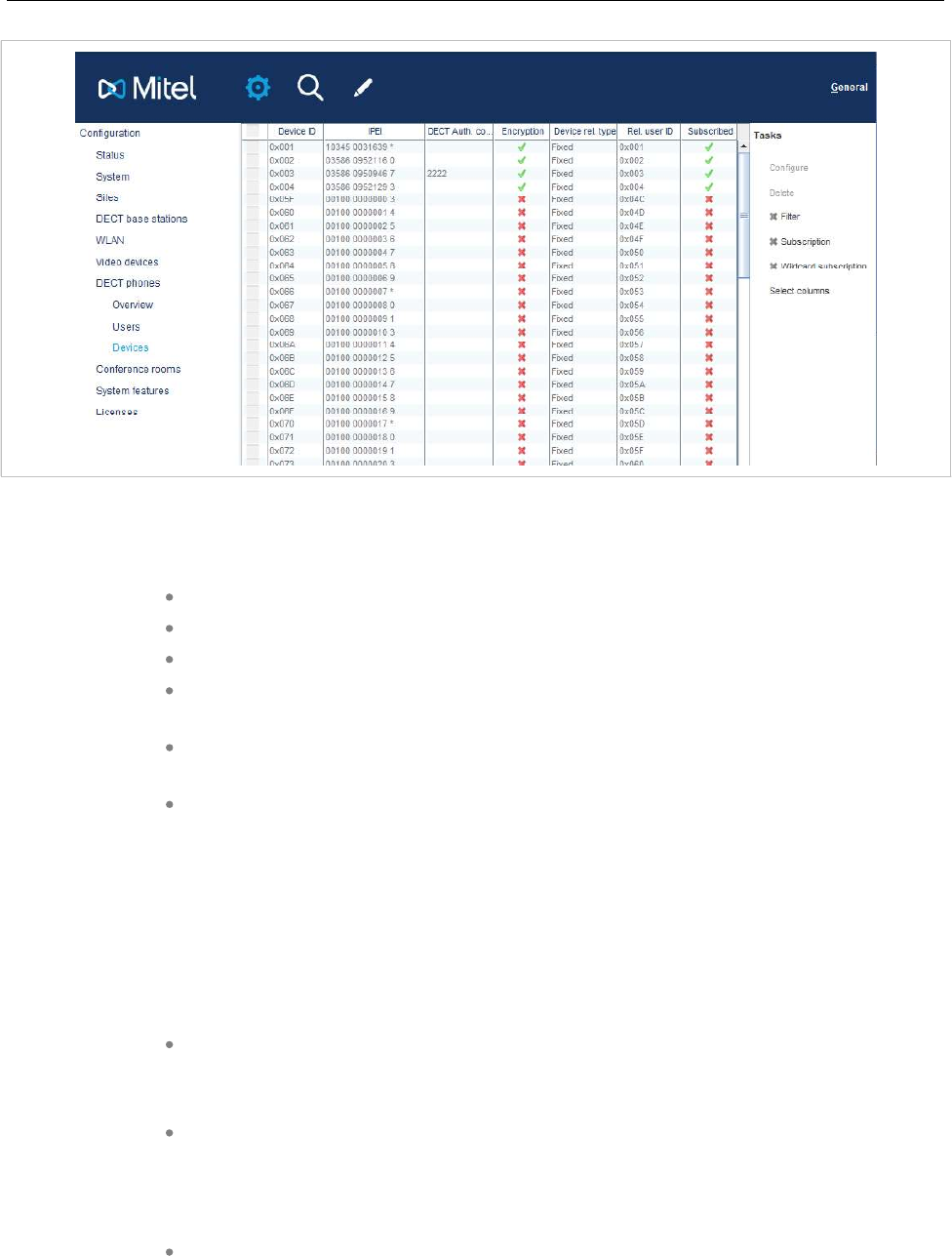
OM Management Portal (OMP)
177
Note: Use the Select columns dialog (see section 6.10.9) to display
the desired DECT phone device data.
The following tasks can be performed:
Configure: Configure selected DECT phone device dataset (see section 6.10.6).
Delete: Delete selected DECT phone device dataset (see section 6.10.8).
Subscription: Start DECT phone subscription (see section 6.10.7).
Wildcard subscription: Start DECT phone wildcard subscription (see section
6.10.7).
Select columns: Select parameter columns to be shown in table (see section
6.10.9).
Filter: Filter DECT phone datasets shown in table for string set in filter mask (see
section 6.10.10).
6.10.4 DEVICE DETAIL PANEL
The Device detail panel is used for configuration/showing of device settings and creation of new DECT
phone datasets.
To open the Device detail panel,
choose one of the commands in the task bar on the right of the DECT Phones panel
(Configure)
or
double-click on the appropriate device entry in the device table
The Device detail panel contains the different parameter groups sorted in tabs. The tabs displayed
depend on the current mode and the panel from which the DECT phone detail panel was invoked.
Overview panel (configuration and monitor mode): The DECT phone detail panel
contains all tabs listed below.

SIP-DECT OM System Manual
178
User panel (configuration mode): The DECT phone detail panel contains all tabs
but not DECT.
Device panel (configuration mode): The DECT phone detail panel contains only
DECT.
6.10.4.1 “General” tab
The General tab contains general settings for the DECT phone dataset.
Name: The DECT phone user name (up to 20 characters).
Number: The DECT phone telephone number, up to 31 characters
(1234567890*#azAz+- _.!$%&/()=?$&). Please be aware that only “*”,”#” and “0” to
“9” can be dialed with a DECT phone.
Description 1 and Description 2: Free text comments with up to16 characters
each.
Login/Additional ID: The additional ID can be used as a mean for data search
within wildcard subscription (because of the IPEI is not configured which selects the
data otherwise).
PIN, PIN confirmation: A user PIN to be entered during user login.
Note: The attempt to set the user PIN to an empty string sets the PIN to
the default value “0000”.
6.10.4.2 “SIP” tab
The SIP contains the SIP authentication parameters for the DECT phone dataset.
Authentication user name: The SIP Authentication user name is optional but
recommended. It represents the name which will be used during SIP registration
and authentication. If no name is given the number will be used by default.
Password, Password confirmation: The password will be used during SIP
registration and authentication. Enter the appropriate data in these fields.
VIP: Enable this option if the registration of this user should be prioritized (default
off). VIP users will be registered first. For more information on prioritized
registration, see section 8.20.5.
Used for visibility checks: Enables the use of this user account to check the
availability of the iPBX (e.g., in fail over situations). See section 8.20.7 for more
information on this feature.
Fixed port: Specifies the port used explicitly for SIP signaling. If set to 0, an
automatically calculated port is used. The default is 0. See section 2.17 for more
information on this feature.
6.10.4.3 ”Incoming calls” tab
The Incoming calls tab allows you to set device-specific settings for auto-answering incoming calls.
Default values for all parameters are inherited from global settings (see section 6.5.4.7).
Auto answer: Enables or disables auto-answer on incoming calls.

OM Management Portal (OMP)
179
Microphone mute: Enables or disables microphone muting when incoming calls are
automatically answered.
Warning tone: Enables or disables warning tone on incoming call. A short ringtone
is played if there are no active calls. If there is an active call in a “barge in” situation,
the ringing will be in-band
Allow barge in: Allows/disallows “barge-in” on existing calls.
6.10.4.4 “Conference” tab
The Conference tab contains parameters for three-way conferencing for the DECT phone dataset.
Server type: Determines the conference service to be used for three-way
conferencing. Possible values are:
–None: Disables 3-way conferencing.
–Global: The OMM system setting is used (default).
–Integrated: The integrated conference server is used.
–External: An external conference server is used.
–External – Blind Transfer: An external conference server is used (e.g., MiVoice
Business). The initiation of the conference is signaled as a blind transfer to the
destination specified in the URL parameter.
URL: Address of an external conference server (field only activated if the server
type is “External”).
For more information see section 8.20.7.
6.10.4.5 “DECT” tab
The DECT tab contains parameters DECT configuration of the DECT phone dataset. When configuring a
device (see 6.10.3), only the DECT tab is shown in the DECT phone detail panel.
IPEI: This optional setting is the DECT phone IPEI number. On a Mitel DECT 142 /
Mitel 142d DECT phone, the IPEI can be found via the following path of the device
menu: Main menu >Phone settings >System. On a Mitel 600 DECT phone, the
IPEI can be found in the System device menu. Consult the DECT phone’s user
guide for further information.
DECT authentication code: The DECT authentication code is used during initial
DECT subscription as a security option and can be set here for each DECT phone
device separately (DECT phone-specific DECT authentication code). If no DECT
phone-specific DECT authentication code is set, the system-wide DECT
authentication code is used.
Encryption: If the encryption feature is enabled for the whole system (in the
System settings menu, see section 6.5.1), you can de-activate the DECT
encryption for this device.
Please note: The DECT phone device must support DECT encryption which is not a
mandatory feature.

SIP-DECT OM System Manual
180
Subscribe to PARI only: Ensures that the DECT phone subscribes to the PARK
code (of a single OMM, within a Dual Homing installation) and not to the SARI. This
option is only available for fixed user device pairs, and must be set before
subscription takes place. For this reason, you should set the parameter immediately
when creating the DECT phone device.
Delete subscription: This option is only available when configuring an existing
DECT phone. If this option is activated, the subscription data will be deleted which
also requires a re-subscription of the DECT phone device.
6.10.4.6 “Messaging” tab
The Messaging tab contains parameters for the OM Integrated Messaging and Alerting service on the
DECT phone dataset.
If a user is created independent of any specific configuration, the Sending messages and Sending
vCards features are enabled by default.
Sending messages permission: If this option is enabled, the DECT phone can
send messages (if this function is supported by the device).
Note: For further information see the document SIP-DECT OM
Integrated Messaging & Alerting Application Installation,
Administration & User Guide.
Sending vCards permission: Allows the user to send personal directory entries as
a vCard message from the DECT phone to other users (if this function is supported
by the device).
Receiving vCards permission: If this option is enabled, all received vCard
messages are automatically processed and written into the personal directory of the
DECT phone (if this function is supported by the device).
6.10.4.7 ”Locating” tab
The Locating tab contains parameters for configuring location parameters for the DECT phone.
Locating permission: This option applies to Mitel 600 DECT phones only. If this
option is enabled, the user is allowed to determine the location of other DECT
phones. The main menu of the Mitel 600 DECT phones provides an extra Locating
menu entry for this function.
Tracking: If this option is enabled, the operator of the OM Locating application is
able to use the constant tracking feature for the DECT phone. Note that this feature
consumes more of the DECT phone’s battery power, because it activates a DECT
base station update if the device roams and is not in communication. You also
cannot enable this feature, if the DECT locatable option is disabled.
DECT locatable: If this option is enabled, the DECT phone is locatable. Either with
the OM Locating application or by querying it’s location from other DECT phones.
6.10.4.8 “Additional services” tab
The Additional services tab contains additional optional parameters for the DECT phone dataset.
SOS number: User-specific SOS number that is dialed automatically if the SOS key
on the DECT phone is pressed.

OM Management Portal (OMP)
181
ManDown number: User specific “Man down” number that is dialed automatically if
a Man down event happens. This event is triggered by the sensor of a Mitel 600
DECT phone.
If no individual SOS or Man down number is configured for a DECT phone, the number of the
appropriate alarm trigger will be used as calling number in case of a SOS or Man down event. Please
see /31/ for details.
Voice mail number: The number that will be automatically called as soon as a
voice mail call is initiated on the Mitel 600 DECT phone. If there is no individual
voice mail number configured in this field, then the system-wide voice mail number
is used (see also the System setting menu, section 6.5.1). If there is no voice mail
number configured (neither the individual nor the system-wide) or another DECT
phone type is used, then the voice mail number must be configured locally in the
DECT phone.
Keep personal directory: Activate this option, to keep the personal directory data
in the DECT phone if the user logs out.
External: A user data set can either be provisioned on an external user data server
or locally in the OMM database. To provide an easy way to change the provisioning
storage of user data sets, the user data sets can be moved from an external user
data server into the local OMM database and vice versa.
Deactivate the External option if you want to move user data sets from an external user data server
into the local OMM database.
External to internal transformation rules: To change a user data set from an external user data
server to an internally provisioned one, the following conditions must be applied to the data set:
– external provisioned on an external user data server
– user data set device relation must not be “fixed”
Internal to external transformation rules: To change a user data set from local OMM database to
an external user data server provisioned one the following conditions must be applied for the data set:
– external provisioned on an external server
– user data set device relation must not be “fixed”
– an external user data server must be available
Video stream permission: Activate this option to allow video streaming on the Mitel
602 DECT phone. See section 8.28 for details on this feature.
Hot desking supported: Enables or disables Hot desking functionality (for SIP-
DECT systems using the MiVoice Business platform). Only available for users with a
dynamic association with a DECT phone. When enabled, the user is registered as a
Hot Desking user on the MiVoice Business call server. See section 2.14 for details
on this feature.
Auto logout on charging: Enables or disables automatic user log out on the DECT
phone when the device is placed in the charger cradle. Only available for users with
a dynamic association with a DECT phone. Note that the Silent charging option
must be enabled on the DECT phone.
Authenticate logout: Enables or disables whether it is necessary for the user to
authenticate in case of logout.

SIP-DECT OM System Manual
182
6.10.4.9 “User monitoring” tab
The User monitoring tab contains parameters to configure the user-specific parameters for the User
Monitoring feature. For a description of the parameters which can be set in the User monitoring tab,
see the description in section 8.29.7.2.
6.10.4.10 “Configuration data” tab
The Configuration data tab allows you to assign a Configuration over Air (CoA) profile to a DECT phone
user. See section 8.23 for more information on this feature.
Profile id: Specifies the CoA configuration profile you want to assign to the DECT
phone user.
Note: When a COA profile is deleted, its profile ID assignment to DECT
phone users remains. If a new CoA profile is created and
acquires this profile ID (the IDs are assigned in sequential order),
any DECT phone users with the old profile ID are automatically
assigned to the new CoA profile.
If you do not want the DECT phone users to automatically inherit
any new CoA profile that has the profile ID, you must remove the
profile ID assignment manually.
6.10.4.11 “User service” tab
The User service tab allows you to specify parameters related to user authentication for XSI services.
Use SIP user name: Specifies whether the XSI user name is taken from the user's
SIP data. The generated format is <sip user name>@<sip registrar domain>.
Possible values are Global,On, or Off.
Use SIP user authentication: Specifies whether the XSI authentication name and
password are taken from user’s SIP data. The generated format is <sip
authentication name>@<sip registrar domain>. Possible values are Global,On, or
Off.
User name: Specifies the user’s user name for the XSI service (if Use SIP user
name is set to Off). The username is part of the access url path of a XSI request
(e.g., /com.broadsoft.xsi-actions/v2.0/user/<service user
name>/directories/Enterprise?firstName=A*).
Authentication name: Specifies the name to authenticate the user for XSI services
(if Use SIP user authentication is set to Off).
Password: Specifies the password to authenticate the user for XSI services.
Password confirmation: confirms the password to authenticate the user for XSI
services.
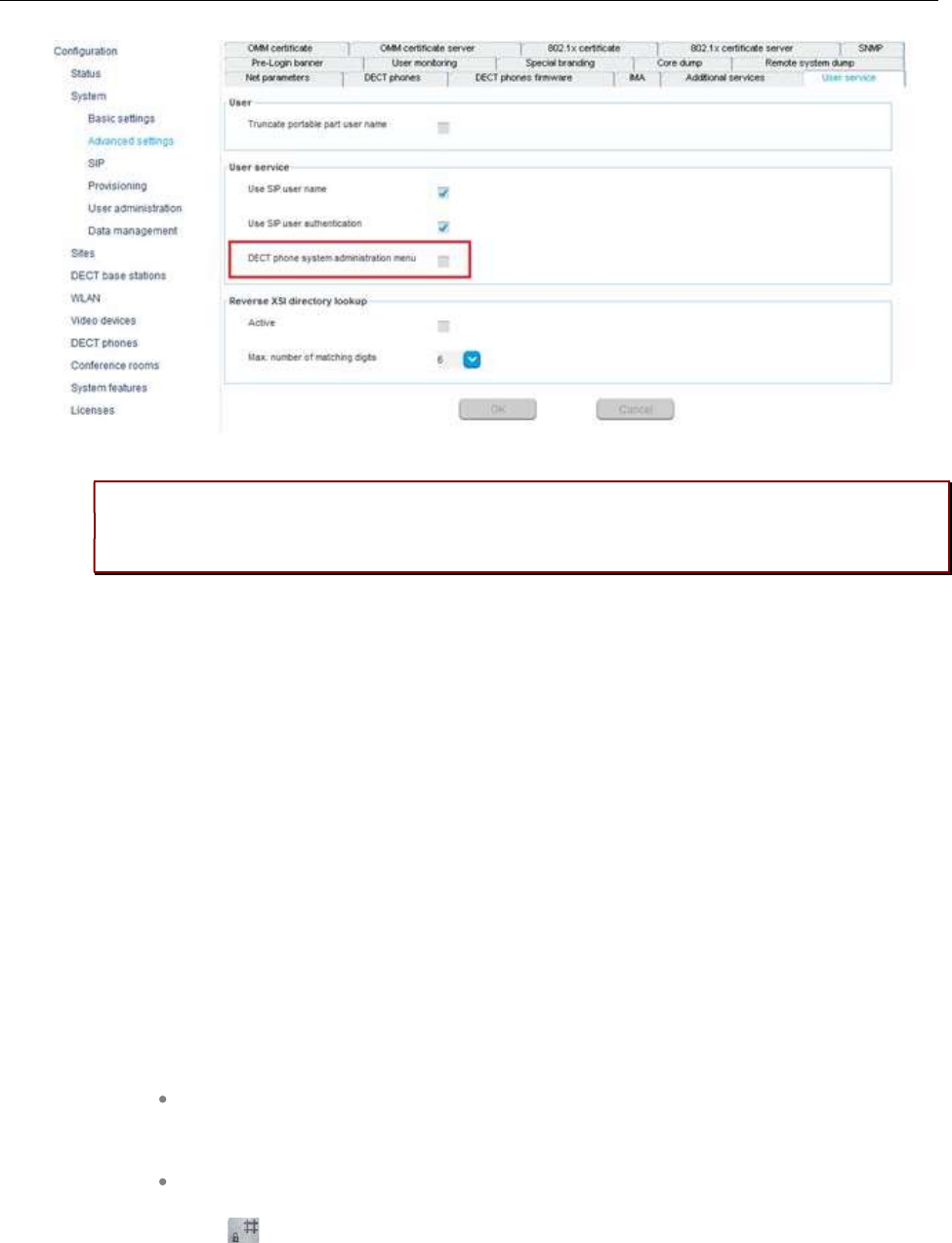
OM Management Portal (OMP)
183
Please note: As of SIP-DECT 8.0, the access to the system configuration through the
DECT phone UI is disabled by default to improve system security. The user can enable
the menus through OMP.
6.10.4.12 “Key lock” tab
The Mitel 600d DECT phone family offers an optional PIN to protect the DECT Phone. For SIP-DECT
8.0 and the DECT phone SW 7.2, the key lock PIN is managed by the OMM to improve the shift worker
support and the roaming between OMMs in a MOM setup.
The local DECT phone key lock PIN settings are suppressed if the DECT phone is subscribed with a
SIP-DECT system.
The key lock with PIN can be managed through OMP, OMM configuration files and by the user through
the DECT phone UI in System menu/ Administration/ Key lock.
Note that this is not possible for external users, that is, users who are provisioned through user.cfg file. If
user data are provisioned through user.cfg files, then the provisioning platform is the data master and
there is no option to update data towards the provisioning platform when changed in the SIP-DECT
system. Therefore, data changes in the SIP-DECT system are prevented.
The following default values apply when creating a new user or when upgrading from the previous
release 7.1-CK14 or older.
Active: The feature is set active. This enables the Key lock menu under System
menu/Administration on the Mitel 600d DECT phone. To prevent change of the time
by the user disable the feature here.
Timer: The timer is set to “None” (“Off” on the DECT phone). The key lock is not
automatically activated if the DECT phone is not used, and the long press of the #
key ( ) does not activate the key lock with PIN.
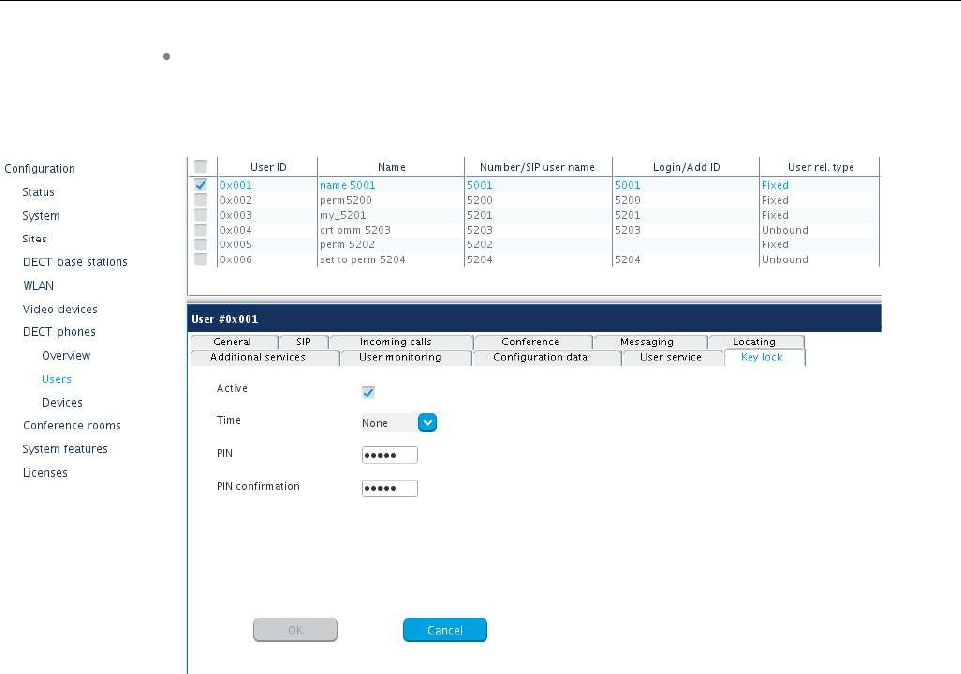
SIP-DECT OM System Manual
184
PIN and PIN confirmation: The DECT phone default PIN is set to 0000. It is the
same default PIN as for the local DECT phone feature. Adjust a new PIN here if the
user had forgotten its PIN.
From the user perspective, the DECT phone key lock with PIN is not active by default but can be
activated through the DECT phone UI. For GDPR compliance activate the timer. The user may set his
individual PIN.
If the active flag is not set, the whole feature is disabled, and the key lock DECT phone menu is removed
from the DECT phone UI. The submenu “Enter new PIN” remains. This is necessary, because the PIN
may be mandatory to open some DECT phone menus like “Security”, or others if configured by COA.
The user shall have the opportunity to change the PIN by himself, even if key lock feature is disabled.
The DECT phone key lock PIN to protect the Mitel 600 DECT phone is reset to default “0000” on user
logout to improve usability in shift worker scenarios. Additionally, user call filter and private caller lists are
removed from the DECT phone.
The PIN for key lock is restored on user login to the DECT phone.
The Mitel 600 DECT Phone USB interface is locked automatically when the phone is locked with a PIN.
6.10.5 CREATING DECT PHONE DATASETS
Creating DECT phone datasets is only possible in Configuration Mode. You can create the fixed DECT
phone dataset or only the DECT phone user data.
To create a DECT phone dataset, do the following:
1Click Create under the Task list on the right-hand side of the DECT Phones window.

OM Management Portal (OMP)
185
– In the Overview submenu you can create a fixed DECT phone dataset (with
combined user and device data).
– In the Users submenu you can create an unbound user. This user can login
and log out on any configured device.
The DECT phone detail panel opens and provides tabs where the DECT phone data must be entered.
2Configure the DECT phone, see parameter description in section 6.10.4.
3Press the OK button.
6.10.6 CONFIGURING DECT PHONE DATASETS
Configuring DECT phone datasets is only possible in Configuration Mode. To configure an existing
DECT phone dataset proceed as follows:
1Select a DECT Phone from the table, and click Configure under the Task list on the right-hand side
of the DECT Phones window.
– In the Overview submenu you can configure the whole DECT phone dataset (user and device
data).
– In the Users submenu you can configure the DECT phone user data.
– In the Device submenu you can configure the DECT phone device data.
The DECT phone detail panel opens.
2Change the DECT phone dataset as desired, see parameter description in section 6.10.4.
3Press the OK button.
6.10.7 SUBSCRIBING DECT PHONE DATASETS
After adding a DECT phone dataset to the OMM, the DECT phone must be subscribed. The OMM must
first be enabled to allow subscriptions from DECT phones. Subscribing DECT phone datasets is possible
in the Overview panel and in the Device panel. To start subscription, press one of the following
commands in the DECT phones menu:
Subscription: Start DECT phone subscription with configured IPEI. For more
information on this see section 5.7.3.1.
Wildcard subscription: Start DECT phone wildcard subscription (without
configured IPEI). In the Wildcard subscription dialog, which is now opened, enter
the Timeout for this subscription method. Press the Start button. For more
information on this see section 5.7.3.2.
6.10.8 DELETING DECT PHONE DATASETS
Deleting DECT phone datasets is only possible in configuration mode. You can delete the fixed DECT
phone dataset (in case of fixed relation) or only the DECT phone user data resp. the DECT phone device
data (in case of dynamic relation).
To delete one or more existing DECT phone datasets proceed as follows:
1Select the appropriate DECT phone dataset(s) in the DECT phone table by activating the
corresponding checkbox(es).
2In the task bar on the right of the DECT phones panel click on the Delete command.

SIP-DECT OM System Manual
186
– In the Overview submenu the whole DECT phone dataset will be deleted.
– In the Users submenu only the DECT phone user data will be deleted.
– In the Devices submenu only the DECT phone device data will be deleted.
The Delete [xxx] dialog opens showing a confirmation prompt.
3Confirm the displayed prompt with OK.
6.10.9 SELECTING COLUMNS
You can adapt the parameters shown in the DECT phone table to your needs:
1Click Select columns under the Task list on the right-hand side of the DECT Phones window.
The Select columns dialog opens.
2Select the columns that shall be shown by activating the appropriate checkboxes.
3Click the OK button.
4The DECT phone table will be adapted accordingly.
6.10.10 FILTERING DECT PHONE TABLE
You can filter the list of DECT phone datasets shown in the DECT phone table by using a filter.
1Click Filter under the Task list on the right-hand side of the DECT Phones window.
The Filter dialog opens.
2Enter the search string that serves as filter criterion. You can enter digits and characters. The search
is case sensitive.
3Click on the Filter button.
The Filter dialog is closed and the DECT phone table will be adapted accordingly.
4To reset the filter, click on the Filter command in the task bar on the right of the DECT phones panel.
5In the Filter dialog click on the Reset button.
6.10.11 CHANGING THE RELATION TYPE
You can change a user data-device relation data set from “fixed” to “dynamic” and vice versa. This
means the login/logout feature can be enabled or disabled for a DECT phone. The user data device
relation can only be changed by the admin user.
To change the relation type of a DECT phone:
1Select the appropriate DECT phone dataset(s) in the DECT phone table by activating the
corresponding checkbox(es).
2Click Change rel. type under the Task list on the right-hand side of the DECT Phones window.
Rules to change the relation from “fixed” to “dynamic”
The DECT phone must be subscribed.
A user login/logout PIN is configured in the user data set.
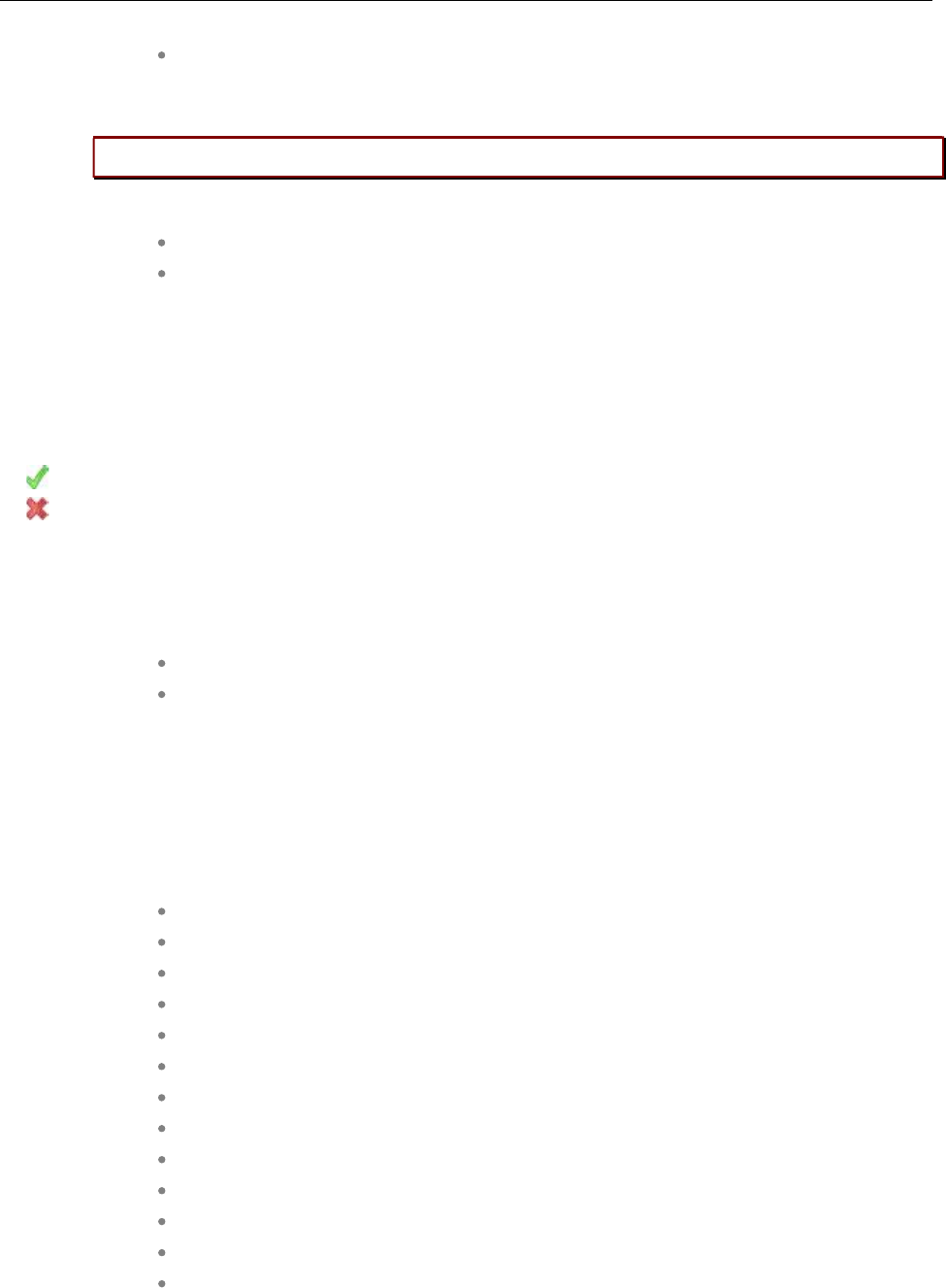
OM Management Portal (OMP)
187
Depending on the DECT phone user login type (“LoginID”), in the DECT tab of the
System settings menu, the Login ID option must be set in the DECT phone user
login type field.
IMPORTANT : If there is no specific PIN configured then “0000” is automatically set.
Rules to change the relation from “dynamic” to “fixed”
The user relation type must be “Dynamic” (not “Unbound”).
The user data set is not retrieved from an external user data server / the user data
set is provisioned locally in the OMM database.
6.10.12 ENABLING / DISABLING DECT PHONE EVENT LOG
You can store a DECT phone event log file in Monitor Mode. Do the following:
1To enable/disable the DECT phone event log, click Log events under the Task list on the right-hand
side of the DECT Phones window:
- DECT phone event log is enabled.
- DECT phone event log is disabled.
2Repeat step 1 to disable/enable the DECT phone event log.
The DECT phone event log will be stored in a file called “pp_event.log“. This file can be found in the
user’s home directory:
On a Linux system it is located under ‘~/.oamp’,
On a windows system under ‘c:/Users/<user>/MyDocuments/.Oamp’.
6.10.13 USER MONITORING
User monitoring menu available in monitoring mode only a list of the DECT Phone users who are
configured for user monitoring.
The following parameters are displayed for each DECT Phone user:
User ID
Name
Number
Related device ID
Mode: User monitoring mode (active or passive)
Combined User Status (CUS)
Handset Assignment Status (HAS) (Dynamic User logged on)
Handset Subscription Status (HSS) (DECT subscribed)
Handset registration status (HRS) (DECT attached)
Handset activity status (HCS) (Handset active within time period)
SIP user registration status (SRS) (SIP user registered)
Silent charging status (SCS) (Silent charging + Charger)
Call diversion status (CDS) (immediate call diversion enabled)
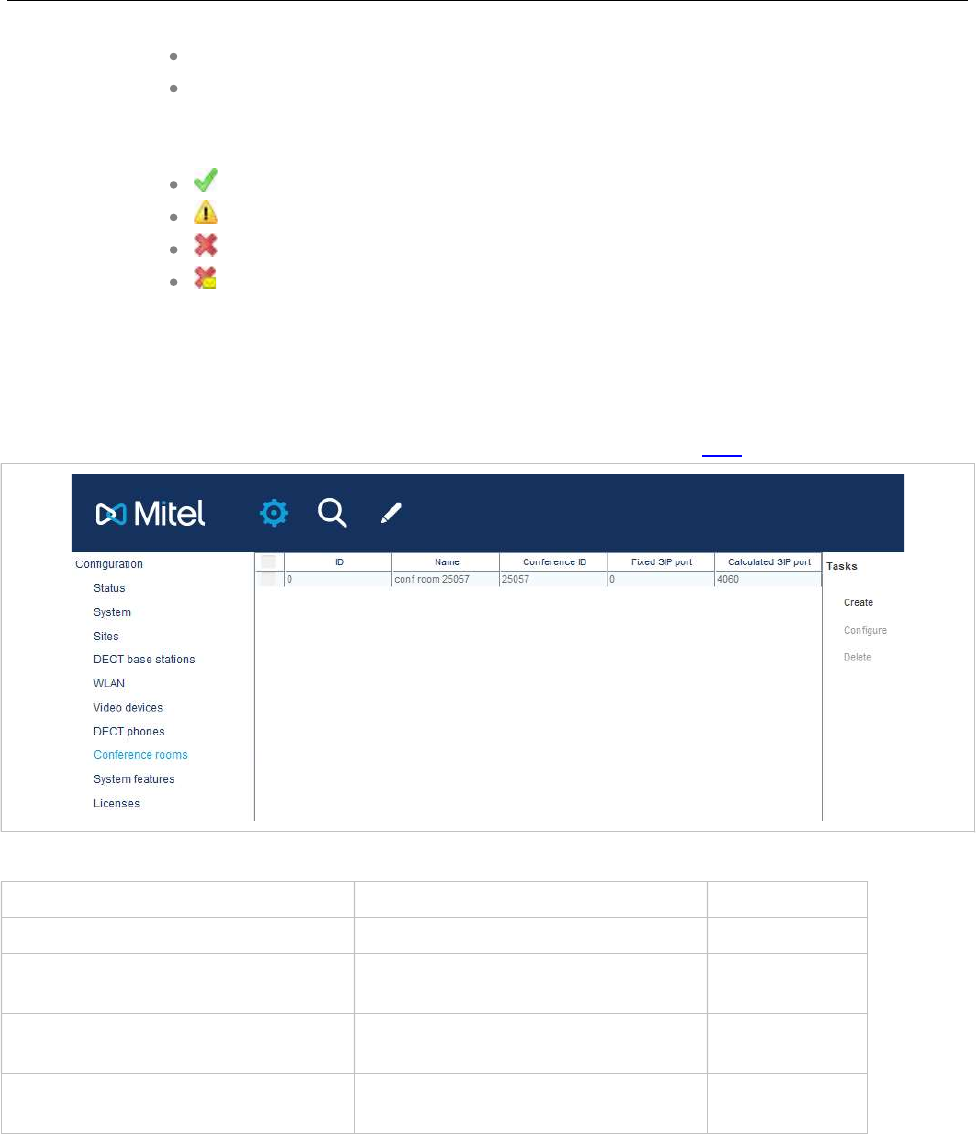
SIP-DECT OM System Manual
188
Handset battery status (HBS) (Battery power above limit, warn only)
Software status (SWS) (minimal required software version, warn only)
Monitoring parameter can have these values:
- Available
- Warning
- Unavailable
- Escalated
6.11 “CONFERENCE ROOMS” MENU
On this menu page you managed individual conference rooms for the Integrated Conference Server
(ICS). For details on how to configure the conferencing feature, see section 8.21.
The tasks which can be performed are mode-dependant.
Configuration mode Monitor mode See section
Create: Create conference room 6.11.1
Configure: Configure selected
conference room
6.11.2
Show details: Show details about a
selected conference room
6.11.4
Delete: Delete selected conference
room
6.11.3
6.11.1 CREATING CONFERENCE ROOMS
In Configuration Mode you can create new conference rooms. Conference rooms will be registered on
the configured SIP registrar, thus you must enter the SIP account data to be used.
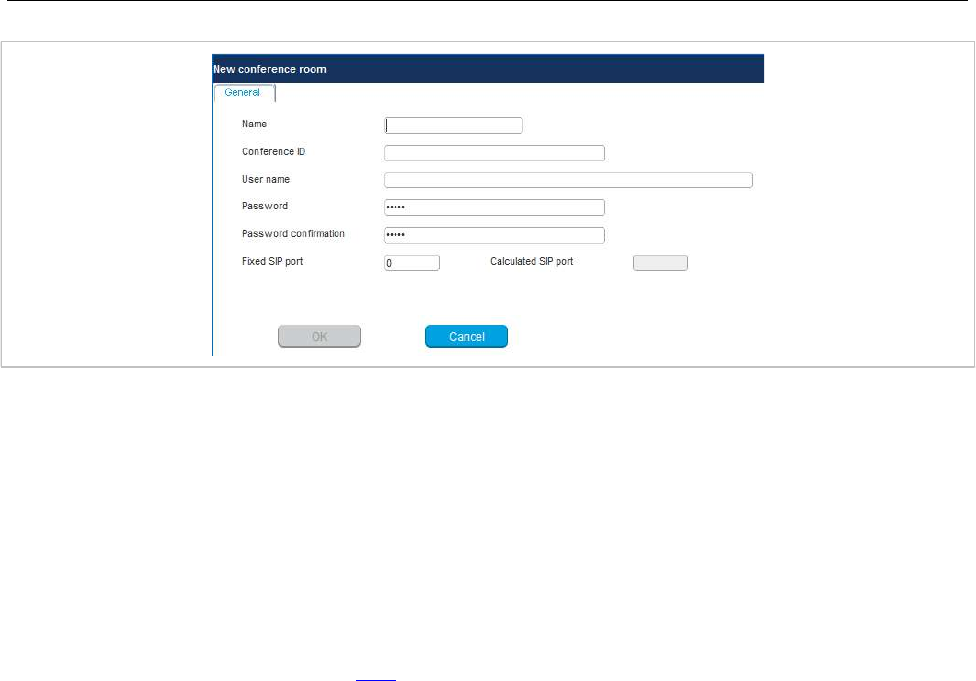
OM Management Portal (OMP)
189
1Click Create in the Tasks menu of the Conference rooms page.
2In the General tab, enter the conference room parameters.
–Name: Enter the SIP display name for the SIP account to be used.
–Conference ID: Enter the SIP user id.
–User name: Enter the SIP authentication name.
–Password, Password confirmation: Enter the password that is required by
the SIP server.
–Fixed SIP port: Enter the port used explicitly for SIP signaling. If set to 0, an
automatically calculated port is used for this conference room. The default is 0.
See section 2.17 for more information on this feature.
3Click OK.
6.11.2 CONFIGURING CONFERENCE ROOMS
In Configuration Mode you can configure an existing conference room.
1Select the appropriate conference room entry in the conference rooms table.
2Click Configure.
The General tab is displayed showing the current conference room configuration.
3Change the conference room parameters as required.
4Click OK.
6.11.3 DELETING CONFERENCE ROOMS
In Configuration Mode, you can delete conference rooms.
1Select one or more conference rooms entries in the conference rooms table.
2Click Delete.
A confirmation dialog appears.
3Click OK to confirm.
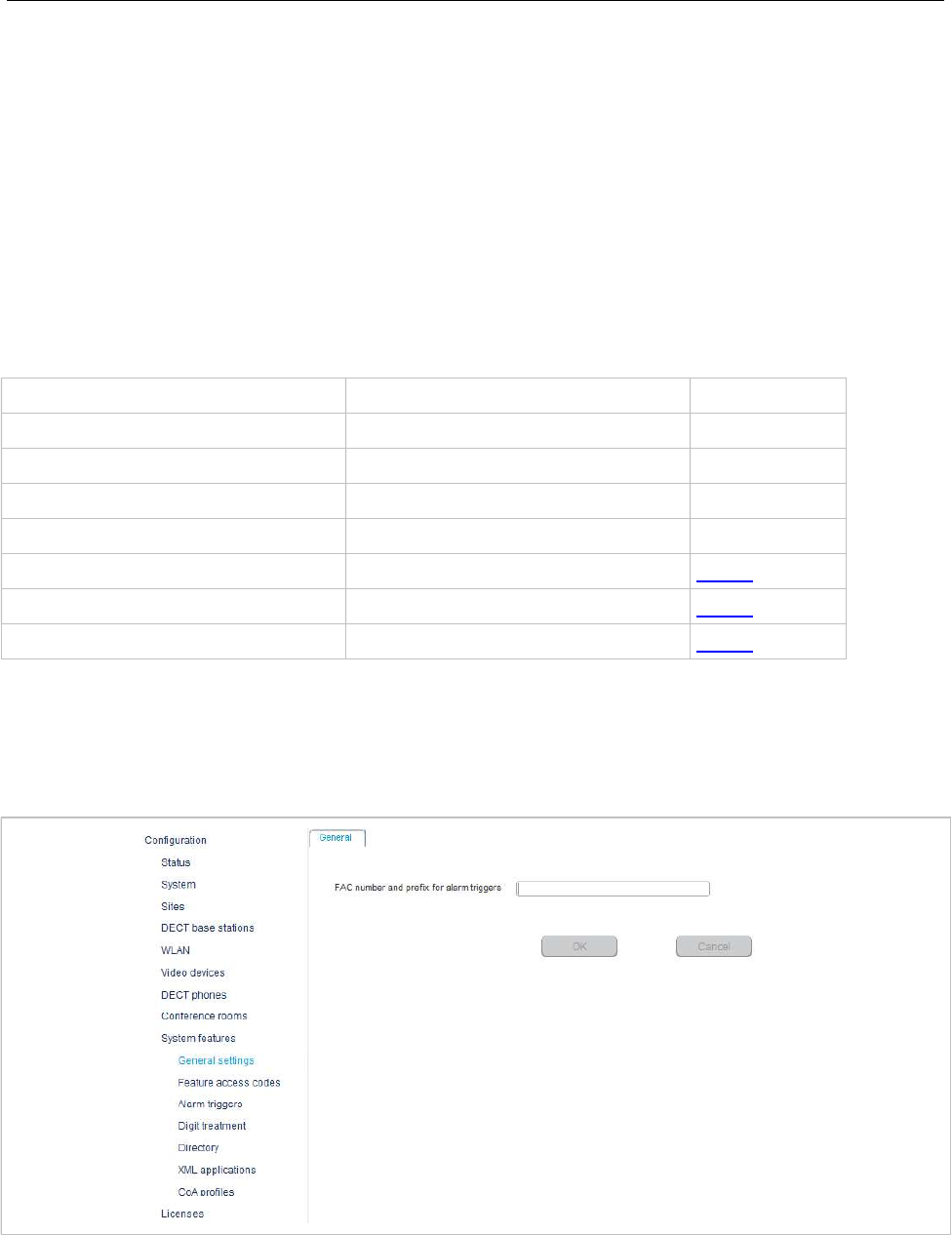
SIP-DECT OM System Manual
190
6.11.4 VIEWING CONFERENCE ROOM DETAILS
In Monitor Mode, you can view the details of a conference room.
1Select the appropriate conference room entry in the conference room table.
2Click Show details.
The General tab is displayed showing the conference room configuration.
3Click Cancel to close the tab.
6.12 “ALARM TRIGGERS” MENU “SYSTEM FEATURES” MENU
The System features menu provides the following entries:
Configuration mode Monitor mode See section
General settings General settings 6.12.1
Feature access codes Feature access codes 6.12.2
Alarm triggers Alarm triggers 6.12.3
Digit treatment Digit treatment 6.12.4
Directory Directory 6.12.5
XML applications XML applications 6.12.8
CoA profiles CoA profiles 6.12.9
6.12.1 “GENERAL SETTINGS” MENU
The General settings menu allows to configure/view the FAC number prefix used for feature access
codes and alarm triggers.
1 FAC number and prefix for alarm triggers: Enter a unique FAC number.
2Press the OK button.
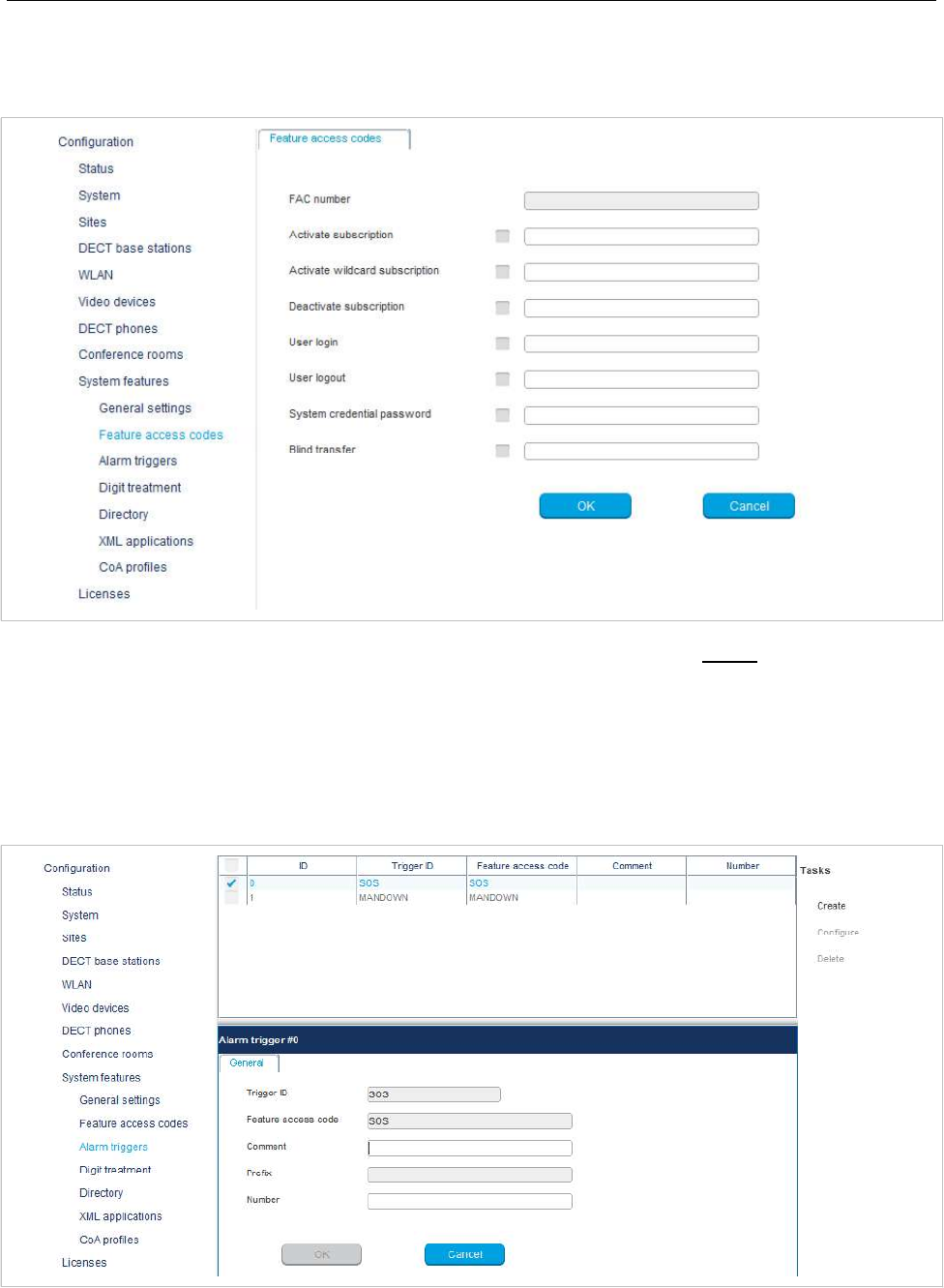
OM Management Portal (OMP)
191
6.12.2 “FEATURE ACCESS CODES” MENU
The Feature access codes menu is used to configure/view the feature access codes parameters.
The FAC number which introduces the feature access code (see also section 6.12.1) is displayed. For a
description of the parameters which can be set in this menu see section 5.9.4.
6.12.3 “ALARM TRIGGERS” MENU
The Alarm triggers menu allows configuration and display of numerous alarm trigger datasets. There
are two predefined alarm triggers (“SOS” and “MANDOWN”) which cannot be deleted.
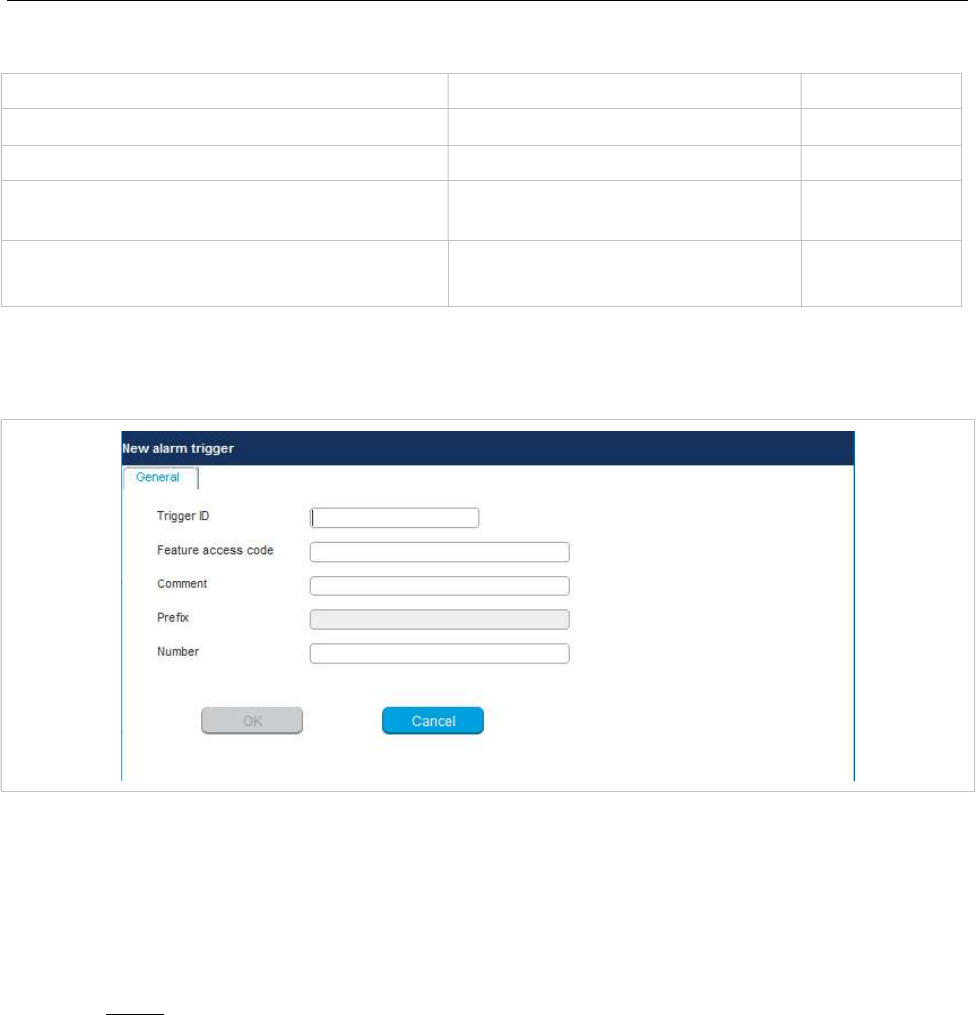
SIP-DECT OM System Manual
192
The tasks which can be performed are mode-dependant.
Configuration mode Monitor mode See section
Create: Create alarm trigger 6.12.3.1
Configure: Configure a selected alarm trigger 6.12.3.2
Show details: Show parameters of
a selected alarm trigger
6.12.3.4
Delete: Delete selected alarm triggers 6.12.3.3
6.12.3.1 Creating “Alarm triggers”
In Configuration Mode you can create new alarm triggers.
1Click Create. In the General tab enter the alarm trigger parameters.
2 Trigger ID: Enter the AlarmTrigger ID that the OMM sends to identify the alarm scenario and the
source that triggers the alarm.
3 Feature access code: Enter the feature access code that the user dials to initiate the alarm.
4 Comment: Enter a comment for the new trigger.
5 Prefix: This field displays the FAC number which introduces the feature access code (see also
section 6.12.1).
6 Number: Enter the number to be called if the user triggers the alarm by dialing the feature access
code. If no number is specified, the call is released.
7Press the OK button.
6.12.3.2 Configuring “Alarm triggers”
In Configuration Mode you can configure an existing alarm trigger.
1In the alarm trigger table click on the appropriate trigger entry.
2Click Configure.
The General tab is displayed showing the current trigger configuration.
3Change the trigger parameters.
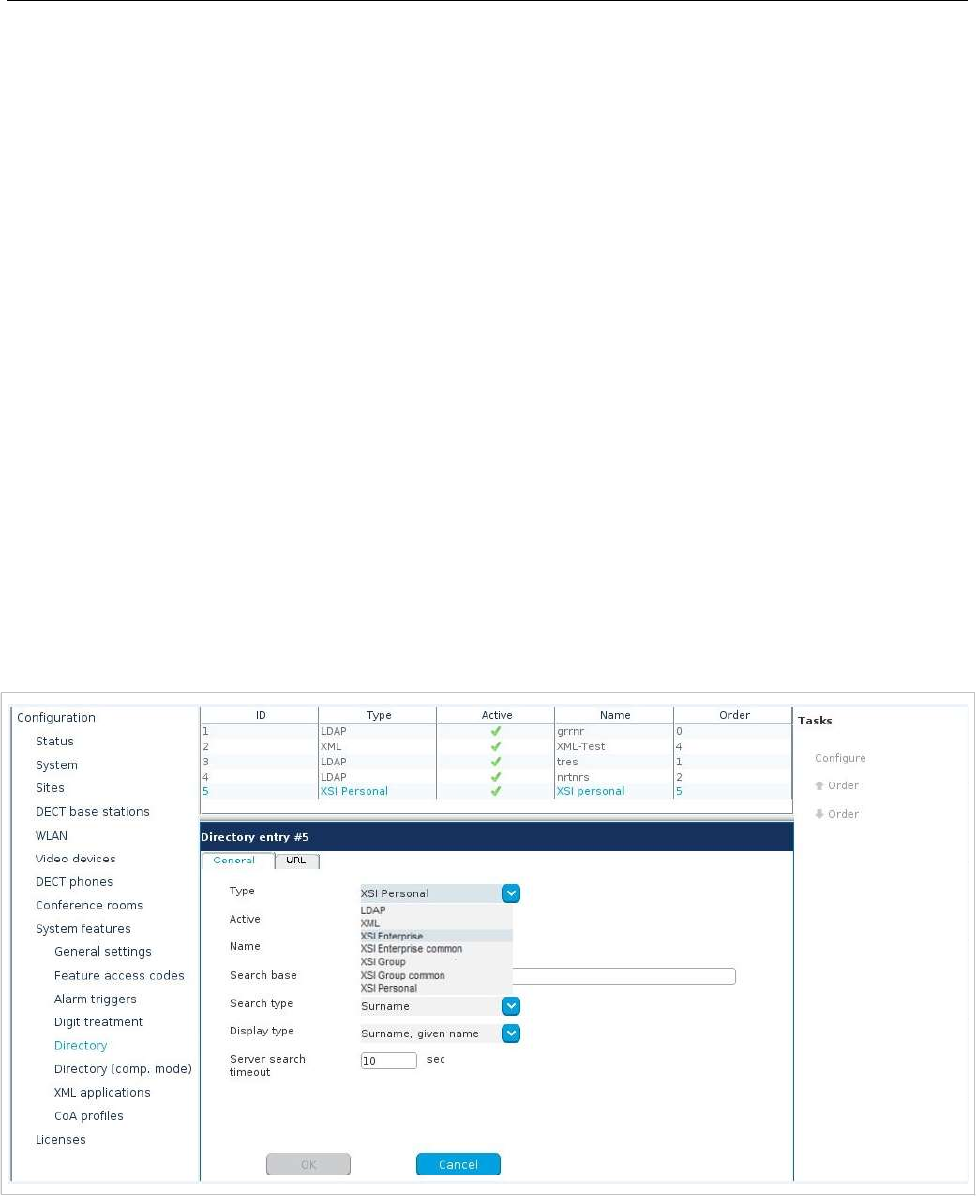
OM Management Portal (OMP)
193
4Press the OK button.
6.12.3.3 Deleting “Alarm triggers”
In Configuration mode you can delete alarm triggers. The predefined alarm triggers (‘SOS and ’Man
down‘) cannot be deleted.
1In the alarm trigger table click on one or more trigger entries.
2Click Delete.
3Confirm the displayed prompt with OK.
6.12.3.4 View “Alarm trigger” Details
In Monitor Mode you can view the details of an alarm trigger.
1In the alarm trigger table click on the appropriate trigger entry.
2Click Show details.
The General tab is displayed showing the trigger configuration.
3Click Cancel to close the tab.
6.12.4 “DIGIT TREATMENT” MENU
The Digit treatment menu allows you to configure the number manipulation that is provided by the digit
treatment feature for LDAP corporate directories.
For a description of tasks and parameters available in this menu, see section 5.9.1.
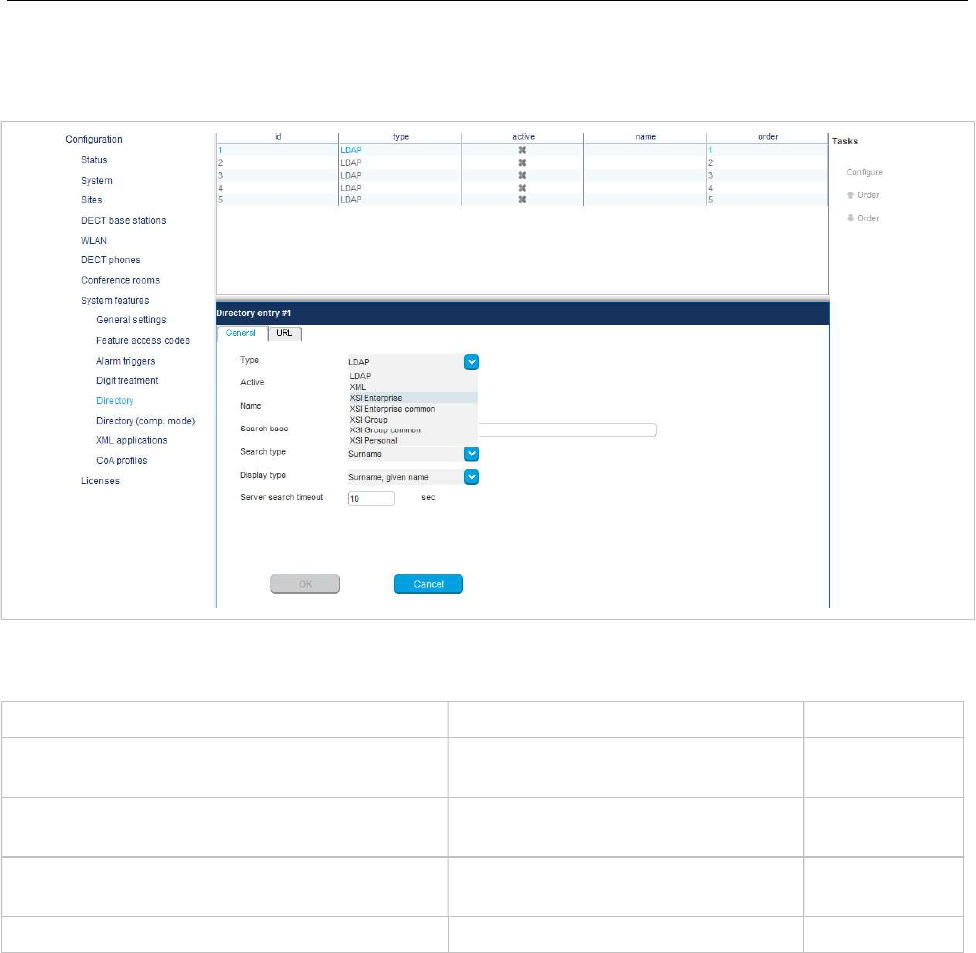
SIP-DECT OM System Manual
194
6.12.5 “DIRECTORY” MENU
The Directory menu allows configuration of LDAP, XML or XSI -based corporate directory services.
The tasks which can be performed are mode-dependant.
Configuration mode Monitor mode See section
Create: Create new directory entry in detail
panel
6.12.5.1
Configure: Configure selected directory entry
in detail panel
6.12.5.2
Show details: Show selected
directory entry in detail panel
6.12.5.3
Delete: Delete selected directory entry/entries 6.12.5.4
6.12.5.1 Creating New Directory Entries
Adding directory entries is only possible in configuration mode. You can configure up to five directory
entries. To add a new entry, do the following:
1In the Tasks panel, click Create.
The New directory entry panel opens and provides various tabs where the directory data must be
entered.
2Configure the directory entry (see parameter descriptions below).
3Click OK to save your changes.
You can specify values for the following parameters in the New directory entry panel:

OM Management Portal (OMP)
195
General tab
The following table describes the parameters on the General tab and to which directory type they apply.
Parameter Description LDAP XML XSI
Type Interface type supported by the directory server. Possible values:
LDAP
XML
XSI Enterprise
XSI Enterprise common
XSI Group
XSI Group common
XSI Personal
Active Enables or disables the directory entry on the DECT phone.
Name Name to be displayed for the directory (Latin-1 character set is
supported).
Note: If there is only one directory entry configured, this value is
ignored when the user searches for a number in the telephone’s
central directory.
SIP-DECT 6.0 and later supports the “SIPProxy” placeholder for a
directory entry name, in place of the current primary, secondary or
tertiary SIP server address.
Search base Location in the LDAP directory from which the search begins
(e.g., ”ou=people, o=my com”).
The configuration is valid for all DECT phones that support the
LDAP directory feature. To make search requests unique for
different users, the search base configuration can include
placeholders that are replaced by user-specific values when
submitting the LDAP request to a server.
The following placeholders are defined:
“<TEL>” (for the user’s telephone number)
“<DESC1>” (for the user’s “Description 1” attribute)
“<DESC2>” (for the user’s “Description 2” attribute)
“SIPProxy” (for the current primary, secondary or tertiary SIP
server address); supported for release 6.1 and later
Search type Attribute on which searches are performed (Surname or Given
name).
Display type Display mode for search results (Surname, First Name or Given
name Surname).
Server search timeout Interval (in seconds) during which the OMM waits for search
results from the LDAP server (1 – 10 seconds).
URL tab
The following table describes the parameters on the URL tab and to which directory type they apply.
Parameter Description LDAP XML XSI
Protocol Transfer protocol used to communicate with the XML or XSI
directory server (http or https).
Port Server port number. Specify a value, or enable the Use default
port flag.
For LDAP, the default is 389. SSL (default port 689) is not
supported. Windows Active Directory Server uses port 3268.
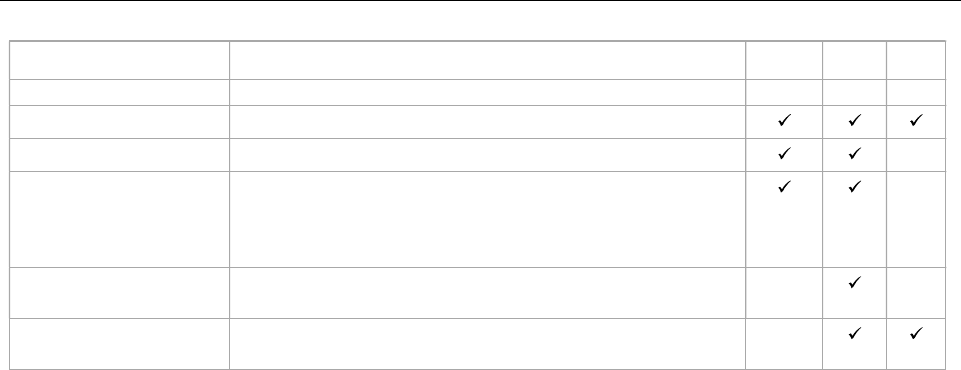
SIP-DECT OM System Manual
196
Parameter Description LDAP XML XSI
For XML or XSI, the default is 80 for HTTP, and 443 for HTTPS.
Server IP address or FQDN of the directory server.
User name Name of the account for directory server access, if required.
Password Password for directory server access, if required. Confirm the
password in the next field.
Note: If no user/password is specified, an anonymous bind takes
place. SIP-DECT supports LDAP simple bind.
Path (and parameters) URL (with parameters, if required) to the XML directory on the
XML directory server.
Use common certificate
configuration
Enables or disables use of the system’s certificates (loaded for
provisioning purposes) for HTTPS directory access.
6.12.5.2 Changing a Directory Entry
Changing directory entry is only possible in configuration mode. To change the configuration of an
existing directory entry, do the following:
1Select the appropriate directory entry in the table.
2Click Configure in the Tasks panel.
3Change the directory entry parameters as required (see parameter descriptions in section 6.12.5.1).
4Click OK.
6.12.5.3 Viewing Directory Entry Details
You can view the configuration of a directory in Monitor Mode. Do the following:
1Select the appropriate directory entry in the table.
2In the Tasks bar click Show details.
The directory entry data is displayed in the detail panel.
3Click Cancel to close the directory entry detail panel.
6.12.5.4 Deleting Directory Entries
Deleting directory entries is only possible in Configuration Mode. To delete one or more existing
entries, do the following:
1Select the appropriate entry/entries in the directory entry table by activating the corresponding
checkbox(es).
2In the Tasks pane, click Delete.
A confirmation dialog opens.
3Click OK to confirm.
6.12.6 EASY MIGRATION FROM CORPORATE DIRECTORY (COMP. MODE) TO NEW
CORPORATE DIRECTORY STRUCTURE
If there is a corporate directory (comp. mode) entry and a new corporate directory structure entry with
identical settings, then the corporate directory (comp. mode) entry gets automatically removed.
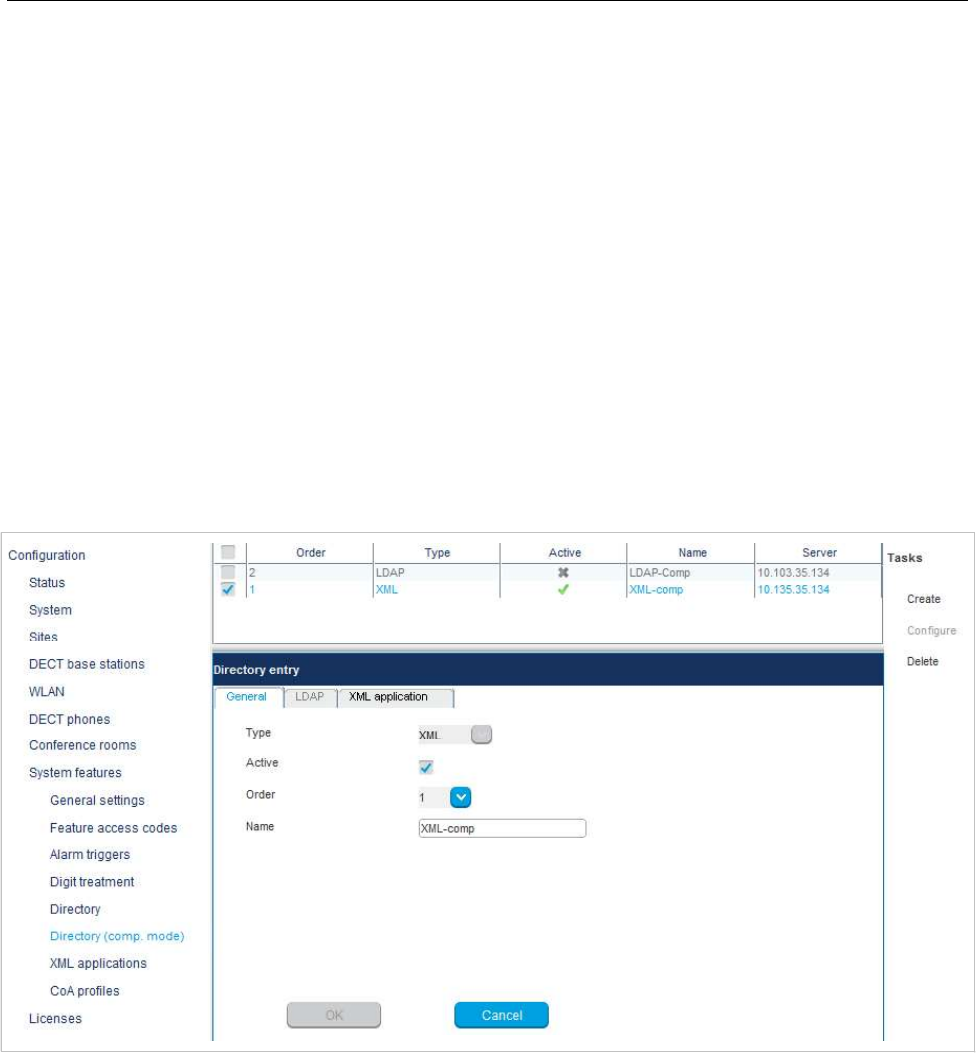
OM Management Portal (OMP)
197
Use case: Migration from old to new structure with provisioning files w/o manual configuration and to
avoid double entries.
The following parameters is considered for comparison:
–Directory type (LDAP, XML)
–Name
–Server
–Path
6.12.7 “DIRECTORY (COMP. MODE)” MENU
With the introduction of XSI directory support in SIP-DECT 6.2, the underlying database model for
directory support in SIP-DECT has changed. To support backwards compatibility, the Directory (comp)
page provides directory configuration and maintenance for existing SIP-DECT systems with LDAP or
XML directory support.
The Directory (comp. mode) menu allows configuration of LDAP or XML corporate directory services.
6.12.7.1 Creating New Directory Entries
Adding directory entries is only possible in configuration mode. You can configure up to five directory
entries. To add a new entry, do the following:
4In the Tasks panel, click Create.
The New directory entry panel opens and provides various tabs where the directory data must be
entered.
5Configure the directory entry (see parameter descriptions below).

SIP-DECT OM System Manual
198
6Click OK to save your changes.
You can specify values for the following parameters in the New directory entry panel:
General tab
The following table describes the parameters on the General tab.
Parameter Description
Type Interface type supported by the directory server. Possible values: LDAP or XML.
Active Enables or disables the directory entry on the DECT phone.
Order Specifies where you want the directory to appear in the list.
Name Name to be displayed for the directory (Latin-1 character set is supported).
Note: If there is only one directory entry configured, this value is ignored when the user
searches for a number in the telephone’s central directory.
SIP-DECT 6.0 and later supports the “SIPProxy” placeholder for a directory entry name, in
place of the current primary, secondary or tertiary SIP server address.
LDAP tab
The following table describes the parameters on the LDAP tab (only available when LDAP is selected as
the directory type).
Parameter Description
Search base Location in the LDAP directory from which the search begins (e.g., ”ou=people, o=my
com”).
The configuration is valid for all DECT phones that support the LDAP directory feature. To
make search requests unique for different users, the search base configuration can include
placeholders that are replaced by user-specific values when submitting the LDAP request
to a server.
The following placeholders are defined:
“<TEL>” (for the user’s telephone number)
“<DESC1>” (for the user’s “Description 1” attribute)
“<DESC2>” (for the user’s “Description 2” attribute)
“SIPProxy” (for the current primary, secondary or tertiary SIP server address);
supported for release 6.1 and later
Search type Attribute on which searches are performed (Surname or Given name).
Display type Display mode for search results (Surname, First Name or Given name Surname).
Server IP address or FQDN of the directory server.
Port Server port number. The default is 389. SSL (default port 689) is not supported. Windows
Active Directory Server uses port 3268.
User name Name of the account for directory server access, if required.
Password Password for directory server access, if required. Confirm in the next field.
Note: If no user/password is specified, an anonymous bind takes place. SIP-DECT
supports LDAP simple bind.
Server search timeout Interval (in seconds) during which the OMM waits for search results from the LDAP server
(1 – 10 seconds).
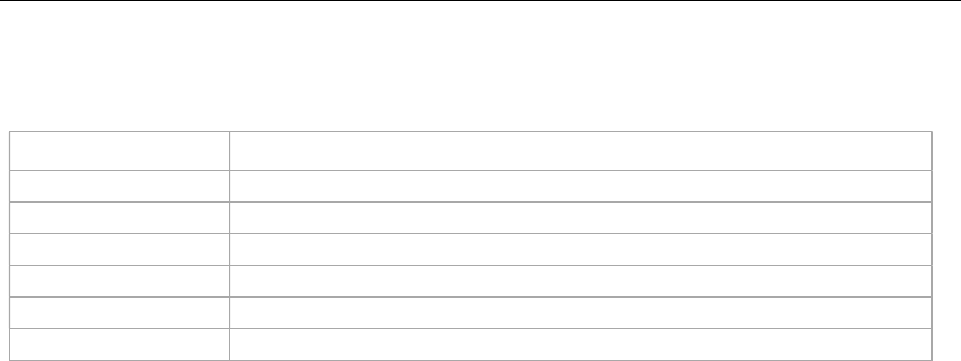
OM Management Portal (OMP)
199
XML application tab
The following table describes the parameters on the XML application tab (only available when XML is
selected as the directory type).
Parameter Description
Protocol Transfer protocol used to communicate with the XML directory server (HTTP or HTTPS).
Port Server port number. Default is 80 for HTTP, and 443 for HTTPS.
Server IP address or FQDN of the directory server.
User name Name of the account for directory server access, if required.
Password Password for directory server access, if required. Confirm the password in the next field.
Path (and parameters) URL (with parameters, if required) to the XML directory on the XML directory server.
6.12.7.2 Changing a Directory Entry
Changing directory entry is only possible in configuration mode. To change the configuration of an
existing directory entry, do the following:
1Select the appropriate directory entry in the table.
2Click Configure in the Tasks panel.
3Change the directory entry parameters as required (see parameter descriptions above).
4Click OK to save your changes.
6.12.7.3 Viewing Directory Entry Details
You can view the configuration of a directory in Monitor Mode. Do the following:
1Select the appropriate directory entry in the table.
2In the Tasks bar click Show details.
The directory entry data is displayed in the detail panel.
3Click Cancel to close the directory entry detail panel.
6.12.7.4 Deleting Directory Entries
Deleting directory entries is only possible in Configuration Mode. To delete one or more existing
entries, do the following:
1Select the appropriate entry/entries in the directory entry table by activating the corresponding
checkbox(es).
2In the Tasks bar click Delete.
A confirmation dialog opens.
3Click OK to confirm.
6.12.8 “XML APPLICATIONS” MENU
The SIP-DECT XML terminal interface allows external applications to provide content for the user on the
Mitel 600 DECT phone display. To make the XML terminal interface applications available to the DECT
phone user, the relevant hooks must be configured in the XML applications menu.
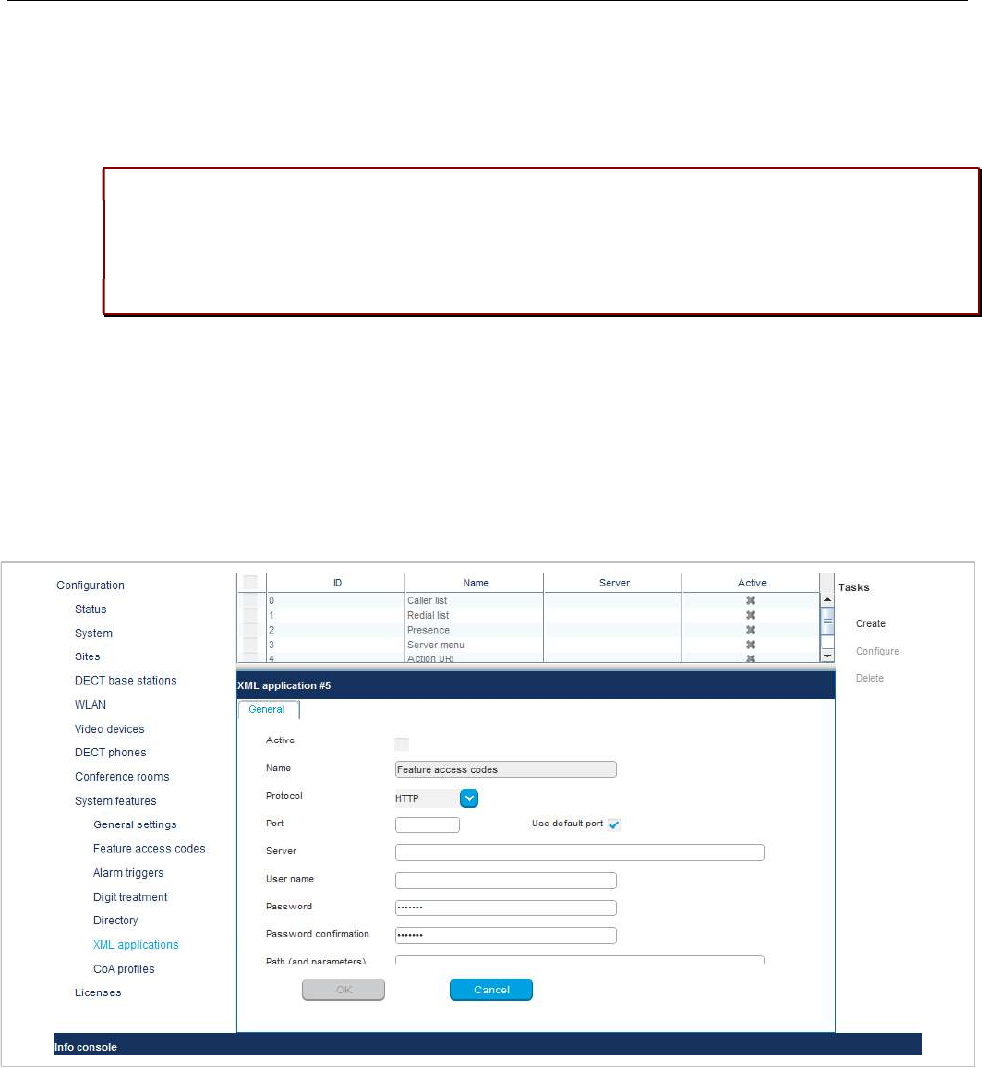
SIP-DECT OM System Manual
200
There are 15 predefined hooks and 10 hooks which can be freely defined. For a full list of the predefined
hooks and their descriptions, see section 5.9.5.
These hooks can be activated or deactivated but not deleted. Up to 10 additional hooks can be created
dynamically.
Please note: “Caller list” and “Redial list” replace the local caller and redial lists of the
Mitel 600 if activated. These XML hooks can also be used to enable the centralized call
log feature (MX-ONE systems only). Additionally the list access must be set to “Automatic”
or “PBX” on the DECT phone in the “Settings > List access” menu. If the list access is set
to “Local”, the local list is used by the DECT phone.
Note: An XML directory entry is also read-only listed in the XML
applications menu. For information on configuring XML
directories please see section 6.12.5.1.
An activated hook becomes available on a DECT phone (including the corresponding menu entry) after
the next DECT location registration of the DECT phone. This can be forced by switching the DECT
phone off and on. The same applies if a hook is deactivated.